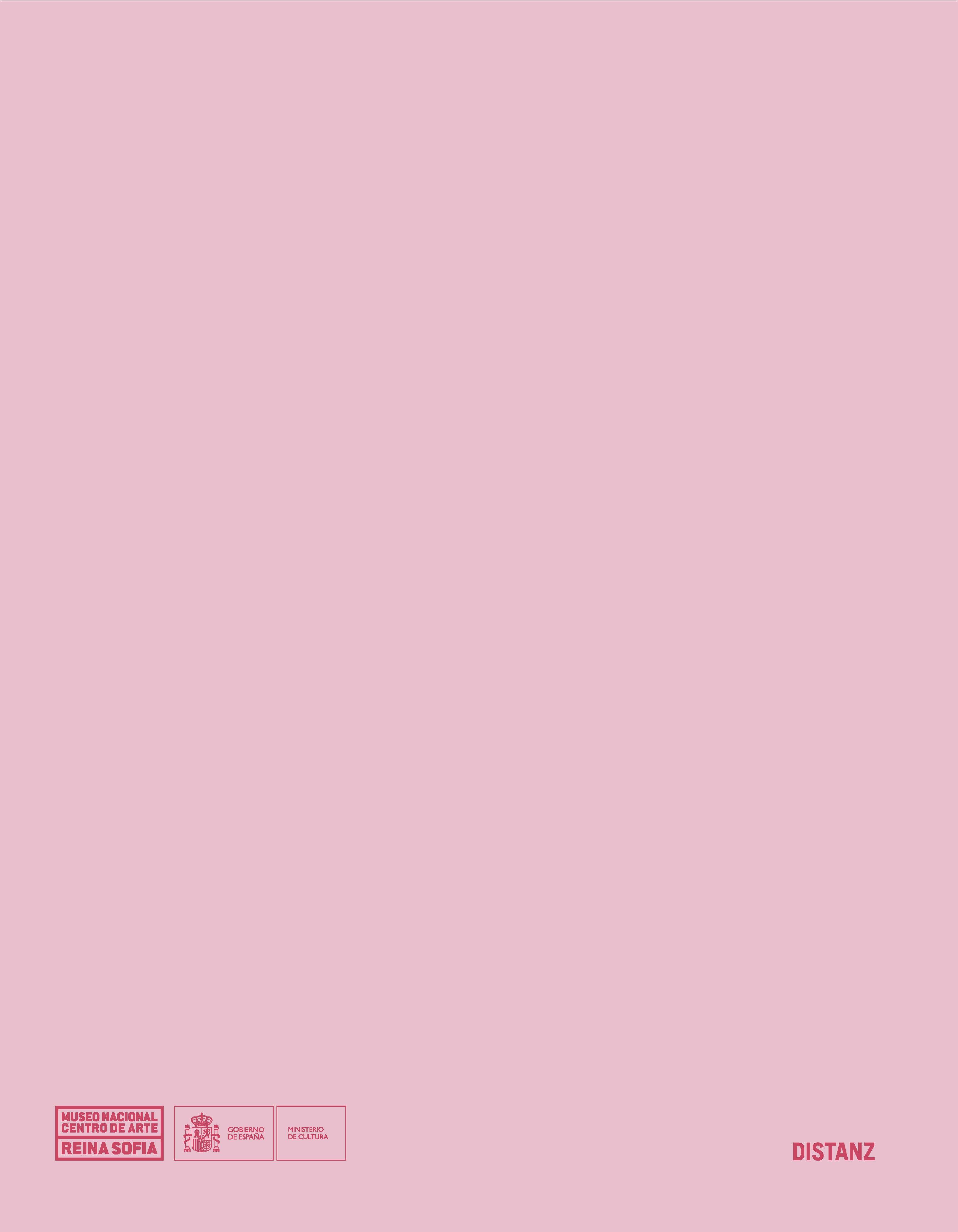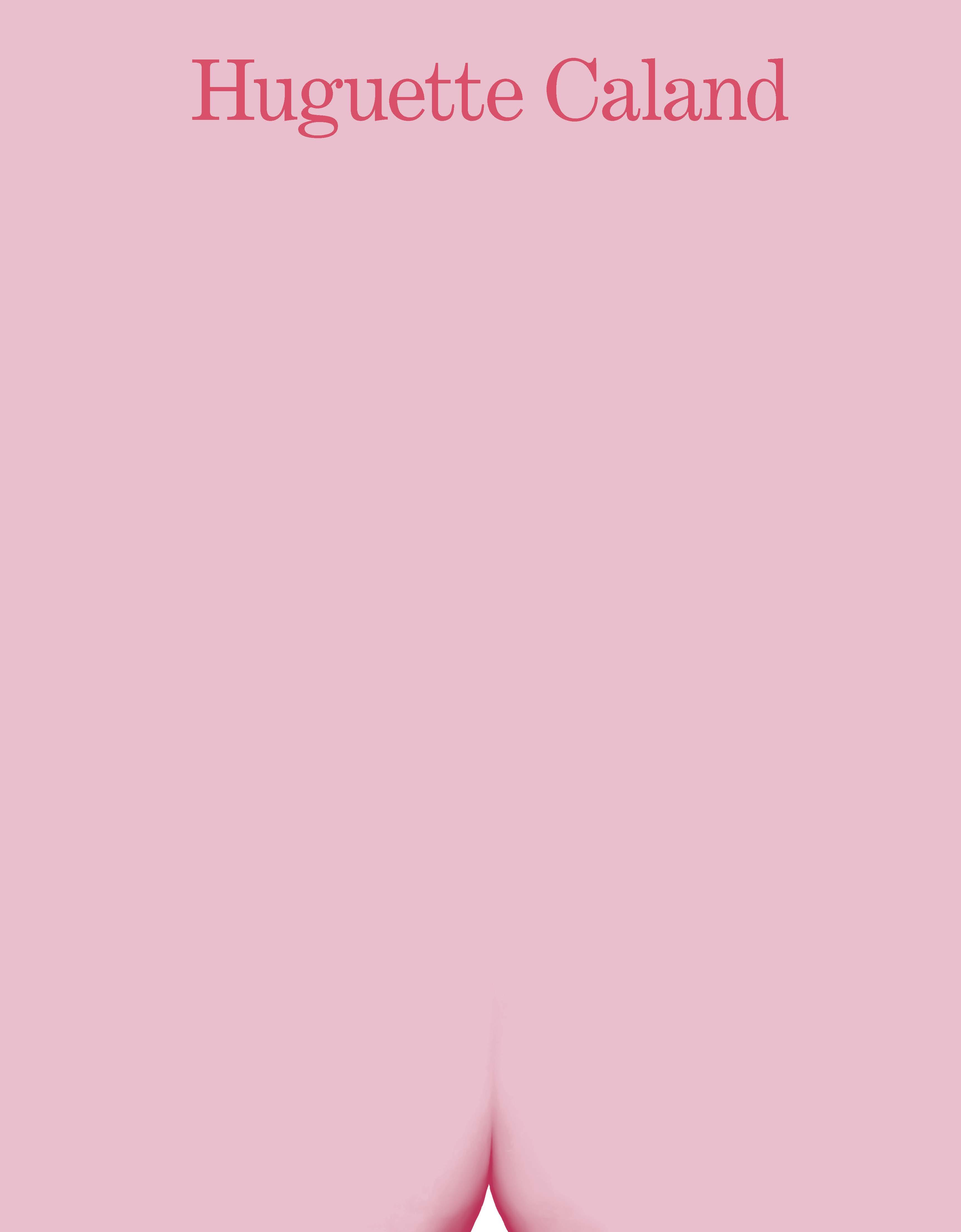

Huguette Caland
Huguette Caland: A
Life in a Few Lines
With an unwavering commitment to aesthetic and personal freedom, the Lebanese artist Huguette Caland (Beirut, 1931–2019) created a heterogeneous, hybrid oeuvre that is nevertheless endowed with undeniable internal coherence. Occupying a central place in it is the body—which she conceives of expansively as a totality with multiple possibilities—together with the use of writing as one of the elements of her visual vocabulary.
The exhibition Huguette Caland: A Life in a Few Lines, whose title is taken from a poem-drawing she made in 1992, is the first retrospective of this artist in Europe. Through an extensive selection of works belonging to the different phases of her career, some never displayed until now, the show seeks to generate a multifaceted and transversal narrative around her legacy. It explores the best-known aspects of her biography and artistic production, such as her heterodox way of living and of representing sexuality and the role that the various places she lived—Beirut, Paris, and California—played in the evolution and creative development of her work. However, the exhibition also focuses on other aspects that have received less attention but are nonetheless fundamental in order to have a comprehensive picture of Caland’s art. These range from her landscape experiments, which explore the relationship between body and space, to the influence of plurilingualism or the steadily growing protagonism of themes like sickness and death in her art.
With an exhaustive and rigorous review of Huguette Caland’s career, both the exhibition and the essays compiled in this catalogue help to reveal the ties and connections between the artist’s different phases, highlighting specific aspects of her practice through artistic, historical, sociopolitical, and economic analyses. We wish to express our gratitude to the authors, and in particular to the curator of the exhibition, Hannah Feldman, for the task they have accomplished. Our thanks also go to the Museo Reina Sofía for offering us the opportunity to enter the thrilling creative universe of an exceptional artist who is still little known in Spain, and our final acknowledgment goes to the Deichtorhallen in Hamburg, Germany, which will host the exhibition after it leaves Madrid, no doubt helping to continue to familiarize audiences in new contexts with this valuable artistic corpus.
Ernest Urtasun Domènech Minister of Culture
With a selection of about two hundred works, some never exhibited until now, Huguette Caland: A Life in a Few Lines is the first major retrospective in Europe to be dedicated to the Lebanese artist Huguette Caland (Beirut, 1931–2019), whose life and art represented a constant challenge to the aesthetic, social, and sexual conventions of her time. Caland’s work is characterized by a multiplicity of both written and visual languages, a constant dialogue between abstraction and figuration, and the interplay of the reflexive and the experiential. This show relates the developments and transformations undergone by her practice to the specific geographical and cultural contexts in which she participated, and it examines the impact on her work of her migratory and multilingual experience, together with her condition as a woman artist and as the daughter of the first president of Lebanon after the country’s independence, Bechara El Khoury. Hannah Feldman, the curator of the exhibition, notes that Caland sought to redefine the limits of what is considered to be one’s intimate or personal life by opening up toward an encounter with otherness without renouncing her subjectivity. In her oeuvre, the “self as individual is subsumed in a shared existence expressed in the form of art.” Hence the centrality acquired by the body—often her own body—in many of her works. This body is not an index of identity but of a series of forms emanating from a broader social or interpretive fabric. In her Self-Portrait in Smock (1982), where she paints herself explicitly as an artist dressed in her characteristic painter’s smock though without offering any detail of her face, she highlights the symbolic value of biography and of reflection on memory and identity, at the same time refuting the expectation that biography or the existence it attests will be directly legible for the viewer.
Together with the articulation of a self as a sum of encounters and experiences, we can say that the disruptive potentiality of Caland’s art stems from her determination to develop a pictorial vocabulary that tenses, questions, and reinvents the functioning of “language” itself, or the way in which it operates under the rules of empirical thought and the patriarchal order that dominates Western modalities of thinking about representation.
Following Feldman’s thesis, in order to explore the relationship between language and the articulation of the self in Caland’s
oeuvre, it is useful to adopt the Moroccan writer Abdelkébir Khatibi’s notion of combinatorium, which serves to orient and guide us through the artist’s practice. The concept of combinatorium is related to the analysis of the calligraphic sign in the Arabic language in terms of its purely visual dimension, its form and position, which breaks the bounds of the systems of meaning devised to contain it. Operating in the same way, Caland’s lines, figures, and graphemes are transferred, mutating and changing their meaning, from one picture surface to another, also inhabiting kaftans and abayas like the ones she produced with the fashion designer Pierre Cardin for the Nour haute couture collection.
It is crucial not to lose sight of this mutating, hybrid, and interstitial character in her work, especially at a time when it seems to have been made legible for viewers and institutions around the world and there is a temptation to try to fix its significance within Eurocentric parameters. For like the calligraphic sign analyzed by Khatibi, Caland’s paintings demand a simultaneous reading of the whole and of its parts, accepting that there is not a guaranteed, univocal understanding of form and referent and that their significance is necessarily and joyously unstable. The multiform volumes of her celebrated Bribes de corps (Body Bits) series, which she produced after moving to Paris in the 1970s, can be interpreted as biomorphic volumes that allow the artist to celebrate the body in its carnality, expanding the experience of the erotic and questioning the binarism of gender and the mandate of a normative sexuality. However, these forms are not exhausted by this reading, as they are not referential per se. They seek not a confirmation of the real but an opening onto the space of the poetic, the space of the imagination, which the artist herself described as her “homeland.”
During the years she spent in Venice, California, from 1987 to 2015, writing converted into pure form acquired a special centrality in Caland’s practice, as reflected by her collage selfportraits of the 1990s, where she combines drawings with fragments of handwritten personal correspondence, or the enigmatic Silent Letters project, with which she abandons biomorphic references in a search for more abstract and self-contained formulations. During this period, she also continued investigating the imbrication of the
biographical and the political, the intimate and collective memory, or, to put it in psychoanalytic terms, between the financial and the libidinal economy. This is reflected, for example, in the series L’argent ne fait pas le bonheur, mais il y contribue largement (Money Doesn’t Buy Happiness, but It Contributes Greatly to It, 1994–1995), which explores the centrality of money on various scales and in realms ranging from the intimate to the collective.
Caland remained artistically active until nearly the end of her life. Before her reencounter with her native city, Beirut, her late artistic phase was marked by her tapestry-paintings like those of the Rossinante series, whose title underscores her identification with Don Quixote’s broken-down steed Rocinante, or Cityscapes, where she reflects on the corporeal experience of the urban environment through cartographies that defy the conventions of landscape representation. Another example is the imposing Le grand bleu (The Great Blue, 2012), where, besides the habitual lines of dots and dashes, we find an unequivocally figurative motif: the Lebanese house with its characteristic pointed red roof.
The exhibition Huguette Caland: A Life in a Few Lines, which is due to move on to the Deichtorhallen in Hamburg after its appearance at the Museo Reina Sofía, not only allows us to become familiar with a large selection of works but also enables us to explore Caland’s various phases and facets. It is moreover an opportunity to discover how this heterodox artist managed to generate an artistic vocabulary of her own, a sort of “corporeal writing,” in Feldman’s words, whose resistance to decoding in linguistic terms, redefining the relationship between form and referent and between body and space, has the ability to move and interpellate us and to engender other articulations and encounters.
Manuel Segade Director of the Museo Nacional Centro de Arte Reina Sofía
Huguette Caland (1931–2019) built her extraordinary artistic career over five decades—shaped by a great zest for life, resilience, rebellion, and a cosmopolitan lifestyle. As the daughter of Bechara El Khoury, the first president of the Lebanese Republic after its independence in 1943, she grew up in an environment molded by politics and by exposure to the public eye. “I grew up with the idea of independence,” she herself said. Yet, as a young woman, her life was shaped by the strict societal norms of the time, which initially delayed her development as an artist. What freedoms could she allow herself, and what could she expect from society and her immediate social environment?
Despite the constraints of her social position, Caland’s longing for self-realization prevailed. She married Paul Caland, whose French origins were considered provocative in 1950s Lebanon, especially for the only daughter of a nationalist politician. She had three children and, at the age of thirty-three, began to seriously dedicate herself to art. She set up her first studio in Kaslik, a suburb of Beirut, in her father’s presidential home. In 1970, she moved to Paris to fully embrace her artistic freedom, and, in 1987, she relocated to Venice Beach, California. By then, Caland had already risen, in her native country, to become one of the prominent figures of Lebanese modernism, whose influence would extend far beyond the Arab world. It is, however, only recently that she has begun to receive the extraordinary attention she deserves; this exhibition is a key component of this new development and to the future understanding of her significance.
Caland’s work emerged from a continuous and intense creative process. It ranges from light, graphic line drawings that develop grotesque, poetic netlike figurations, to powerful color compositions reminiscent of pop art aesthetics. Caland’s art is playful, unrestrained, vital, and political. As she herself stated, art and politics were inseparable. The exhibition at the Deichtorhallen Hamburg, acquired from the Museo Reina Sofía, offers the most comprehensive overview of her work to date. It is divided into thematic and chronological chapters, tracing key stages of her life: her early years in Beirut, the life changes she experienced following her move to Paris, and her years in Los Angeles. A few of Caland’s works were already featured in the 2022 exhibition In the Heart of Another Country at
Deichtorhallen, a collaboration with the Sharjah Art Foundation, which sparked our institution’s interest in her art.
Huguette Caland’s art particularly reflects the ambivalence, exploration, and liberation of the female body and the language used to locate it in a social world. In works like Flirt or Homage to Pubic Hair, she openly and provocatively engages with themes of eroticism and sexuality. Her famous Bribes de corps series from the 1970s, with its abstracted depictions of body parts, including eyes, mouths, and buttocks, exemplifies her engagement with sensuality and the complex perception of the human body. Through precisely placed lines, she creates entire worlds—often using minimal forms, sometimes in the idiom of large, clearly structured gestural abstractions. In other works, what appear to be—even if unwittingly so— Asian influences merge with the serially repeatable format of Arabic calligraphy or Palestinian embroidery to form visual patterns that create their own fascinating reality. Again and again, she refers to her lived experiences, as in works like Kaslik or Beirut, which depict places, cityscapes, or spaces she has inhabited, capturing the mood and atmosphere of those locations. Her multifaceted work invites us to pause in awe at its melancholic beauty.
I would particularly like to thank the family and estate of Huguette Caland, as well as the galleries Mennour in Paris, Stephen Friedman in London, and Janine Rubeiz in Beirut and all the lenders for their generous support of this ambitious project. Special thanks go to the exhibition’s curator, Hannah Feldman, who has thoughtfully reviewed and intelligently organized Caland’s extensive body of work. Through her close connection with the family, particularly Brigitte and Pierre Caland, works have been made available that are exclusively on display in Hamburg in addition to those from the Madrid exhibition. Thanks also to the support of collectors and foundations from Beirut: important pieces have been transported to Hamburg for the exhibition despite the catastrophic situation in Beirut throughout the fall of 2024.
I am deeply grateful to the director of the Museo Reina Sofía, Manuel Segade, and the highly cooperative team at the museum, led by exhibition manager Teresa Velázquez Cortés, whose efforts were crucial in making this exhibition possible in Hamburg as well.
In addition, my heartfelt thanks go to the authors of the catalogue texts for their insightful contributions that illuminate the core of Huguette Caland’s art.
Further thanks go to our partners and sponsors in Hamburg, the Bankhaus Metzler, White Wall, the Hapag Lloyd Foundation, and the Friends of Deichtorhallen under the chairmanship of Julia von Jenisch. A special thanks to the managing director Bert A. Kaufmann, and the entire team at Deichtorhallen, especially Annette Sievert, assisted by France Fürst, Vilja Gunzelmann, and Pauline Sander, who have carefully organized the Hamburg venue of the exhibition. Finally, I would like to thank Lydia Jung, responsible for the transport and art handling team at Deichtorhallen, for her professional work and dedication.
I am pleased that this exhibition, a highlight in this year’s Deichtorhallen program, is traveling from Madrid to Hamburg, and I hope that it will leave a lasting impression on our visitors, allowing them to appreciate the fascinating work of Huguette Caland.
Dirk Luckow General Director Deichtorhallen Hamburg
A Curatorial Note on the Works Exhibited (and Not)
As September 2024 came to a close, and with it the bidding process necessary to arrange for the shipment of artworks from around the world to Madrid for the exhibition that this catalogue accompanies, Israeli forces invaded Lebanese airspace, and eventually ground-space, leading to the displacement of (as of the earliest days of October 2024) over one million people, the death of at least (estimating conservatively) six hundred people, and major disruptions to the daily life of the other four million plus who call Lebanon home. As a result, very last-minute and very abrupt decisions had to be made by the Museo Reina Sofía to cut from the exhibition thirty- three works of art that are held in both institutional and private collections in Lebanon because the works’ safety could not be guaranteed, and no one could anticipate how the situation would unfold or when it would end. This loss is a real shame that has to be acknowledged, especially in this context and for this artist, whose father was, after all, one of those who fought, diplomatically, for the political sovereignty that Lebanon won more than eighty years ago and deserves to enjoy to this day. While the loss of thirty-three artworks is obviously a minor nuisance in the light of the large-scale human catastrophes that have been caused by the wars in and on Gaza, the West Bank, and Lebanon, it also raises real political and exhibitionary concerns, even as some works have been replaced by others from Los Angeles and Spain.
First, the exhibition’s narrative, which took four years, an abundance of research, countless trips—hence time and money, not to mention the expenditure of natural resources—is significantly disrupted. Most worryingly, it is Lebanon’s centrality in this story as the place where Caland was born and where she died that is altered. The works that testify most vividly to this being the place from whence the artist emerged and to which, in her final years, her painted imaginings returned her, even before she herself returned, cannot be shown. I am writing a new narrative, even as I type this, but I cannot ignore the hole at its center. The absence of these thirty- three works has other effects. It means that, once
again, what becomes visible to viewers in Europe is work already located in Europe and in North America. Canons are not natural things; they are forged by economics, power, and, in this case, war. What gets seen is what gets reproduced, written about, and so known. Limited narratives have consequences, and, in this case, the consequence is that works in Lebanon and the social lives they have lived there remain hidden and unknown outside the country. We have tried to reproduce the majority of works in the catalogue, although some could not be photographed because conditions did not allow for primary stakeholders to access their collections. This is true even of the drawing that gives the exhibition its title— Une vie en quelques lignes (1992)—the subtitle of which, “The summary of a great love,” says so much of the spirit in which the work was made, indeed, the spirit in which most of Caland’s work was made: love for her family, her friends, her lovers, and her community.1
Eliding the work located in Lebanon from this exhibition also means that the rich cultural and artistic scene into which Caland was born and in which her work now stands as central cannot be substantiated in the spaces of the exhibition as it should be. Gone is the work titled Dar el Fan / Hiroshima (1970; p. 74), to commemorate its having been shown in Janine Rubeiz’s seminal and extremely important cultural institution of the same name, an institution whose archives were already once erased by the consequences of war in Lebanon in 1975. Gone too are other works that Caland exhibited at Dar el Fan to much critical acclaim or on the walls of her own studio in her father’s home, giving lie to the supposition that Arab cultures refuse images of nudes or other forms of progressive challenge. Further, gone is the evidence of the community that cohered around Caland, buying her artworks at low prices when she was desperate to earn her living while abroad. Local collectors play—or should—a huge role in how artists develop their careers and live their lives, and the exhibition cannot now tell the significance of figures like Leena Saidi, who rescued a beautiful Bribes de corps from the ruins of the restaurant of Caland and her husband Paul,
1 In French, “Un grand amour en résumé.” The English translation of the text in the drawing is reproduced in this publication, pp. 250–263.
Temporel, during the Lebanese Civil War. When Saidi told Caland she and those associated with her had saved it, Caland offered it to her. This kind of generosity and communal care are absent from an exhibition, scarred now, instead, by the kind of violence and disruption that have so long challenged Lebanon and have led, in fact, to the kind of indifference with regard to Lebanese life that allowed the Washington Post to claim that the deaths of “eight Israeli soldiers” were the first fatalities of Israel’s ground campaign, and, worse, a “signal” of the “potentially bloody toll” the Israeli “offensive could take.” 2 What of the deaths of those Lebanese already killed by exploding pagers or bombs in the days prior? Were those not an indication of the “bloody toll” this war would bring? When museums and other institutions in Europe and North America set out, as they should, to “decolonize” their programs and their collections, they are nonetheless met with the staunch colonial realities of a world that still prioritizes some lives over others and deems some cultures to be more worth saving than others. This exhibition cannot show you works collected by important, vibrant institutions in Beirut such as the Dalloul Foundation or the Saradar Collection SAL, or staunch cultural stewards like Brigitte Caland, Abraham Karabajakian, Philippe and Zaza Jabre, Saleh Barakat, and Zeina Raphael, who have, along with others including Richard Haykel and Chirine Habbous, made tremendous efforts to preserve and promote the cultural practices of the Arab world in general, and Lebanon in particular. We cannot fully decolonize our own cultural institutions until we do everything possible to resist and end imperialism and settler colonialism in all its manifestations, everywhere, and immediately so that these institutions and figures can stand alongside us as protected and inviolable.
Herself committed to the preservation of Palestinian culture and lives, and to the value of art as expression toward—as many scholars in this catalogue and elsewhere note—a broader, deeper community, Huguette Caland would certainly have agreed.
2 Loveday Morris, Miriam Berger, and Shira Rubin, “Israeli Military Deaths in Lebanon Raise Questions Over War’s Scope,” Washington Post, October 2, 2024, https://www.washingtonpost.com/world/2024/10/02/ is rael-lebanon-invasion-hezbollah-war/.
Despite living a large part of her life away from Lebanon, it was her home. Its thematic, iconographic, material, and emotional importance to her work must not be underestimated. It is beyond a shame that this, the largest retrospective of her work to date, has had to be reduced in such a way that exactly reproduces the erasures that have for too long kept Caland and other artists from this region— artists whose work does not necessarily combat the circumstances of geopolitics head-on but rather turns to other forms of living, imagining, and making to combat the vicissitudes of violence—from receiving their due.
Hannah Feldman
Huguette Caland: A
Life in a Few Lines
Contents
The Caland Combinatorium; or, A Life in a Few Lines . . . and Dots, Cross-Stitches, and Other Nonrepresentational Forms
Hannah Feldman
p. 21
i
Every Dress a Catastrophe: Caland, the Kaftan, and the Fat Body in 1960s Beirut
Alessandra Amin
p. 59
ii
Bien dans sa peau: Huguette Caland’s Bribes de corps
Rachel Haidu
p. 87
iii
Fashioning Freedom: From the Artist’s Studio to the Paris Atelier
Alex Aubry
p. 137
Silence Is Golden: Huguette Caland’s L’argent ne fait pas le bonheur, mais il y contribue largement Exhausts a Subject and Frees the Artist from It
Kaelen Wilson-Goldie p. 161
Caland in California, Eat the Peel
Aram Moshayedi p. 185
When Anatomy Becomes a Map
Maite Borjabad López-Pastor p. 207
The Role of Writing in Huguette Caland’s Art Practice
Brigitte Caland p. 242
Texts by Huguette Caland p. 245
List of Works p. 267
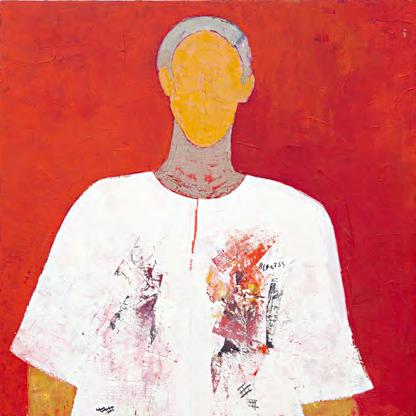
Fig. 1: Self-Portrait in Smock, 1992
The Caland Combinatorium; or, A Life in a Few Lines . . . and Dots, Cross-Stitches, and Other Nonrepresentational Forms*
Hannah Feldman
Life is concrete because we belong to a body. / It is abstract because we know we are dying.
—Huguette Caland, sketchbook, 1990–1991
My language is still waiting for a language to claim her.
—Mirene Arsanios, Notes on Mother Tongues, 2020
I
Self-Portrait of the Artist, as Canvas (Not as Self)
In 1992, some twenty-eight years into her chosen career as an artist, Huguette Caland painted a self-portrait (fig. 1). It was not her first, for sure, and it would not be her last, but it stands out because it is the only portrait she painted of herself explicitly as an artist, clad in a signature painting smock on which a number of thick strokes of pigment—primarily red and purple, but we see lovely glimpses of pink as well—are painted over the artist’s breasts and heart. Below these splotches of color, a few black-lined grids or crisscrossed “hatch marks” stand out as strong graphic marks against the nearly monochromatic white surface of the smock that gives the painting its title, Self-Portrait in Smock. These graphic marks, which will reappear for years to come, had, in fact, already populated her work for years in a slightly different form, even as they never signified any one thing
in particular. There are also a few hastily written numbers, most likely a phone number, indicating the degree to which, for Caland, art and life were mixed and that art happened fast, if not also all the time. The details of daily life were, for her, an essential part of that art, no matter the formal idiom or medium in which it arrived. On this, she was clear, writing in one of her sketchbooks: “The media I used for art is mostly my own life.”1 She further redefines not only traditional accounts of artistic media—painting, drawing, etc.—but also ideas of what counts as one’s life, in her move to expand her own “very, very mixed media” to include not only herself, strictly speaking, but “every human being who crossed my life, for one short moment, to very long periods. / Every single exchange, a look, a smile, a brief encounter.” 2 Of these, she explains, “Every one of them is used consciously to build up the human being I wish / to achieve before dying.”
All other aspects of her life, or, in Caland’s own phrasing, “[e]verything I did in the meantime, painting, drawing, sculpting, etching, / designing, writing, loving or fucking . . . is [sic] only traces that this human being has really existed—Nothing more.” 3 Nothing more, indeed, and thus the self as an individual is subsumed by the fact of a shared existence, articulated as art.
And so Self-Portrait in Smock might be read as nothing more than a simple assertion of Caland’s own existence and its relationship to art making, if not also art being. Never, to my knowledge, exhibited until the artist’s daughter, Brigitte Caland, selected it for the retrospective she curated in Beirut in 2013, the painting presents
1 1990–1991 sketchbook (Sketchbook 2, Caland studio archives), Venice, California, n.d.; English in original. Later in the same sketchbook, Caland writes, “When I spoke of my own life as being the most important part of my work / of art, I mentioned the importance of every single thing happening to me & / my personal ‘digestion’ of it.” She turns to describe the smile of the eleven-month-old “Jade-Angelica,” delivered to her consciously just the day before. The smile, Caland writes, went “straight to her heart.” Such exchanges, of a smile, for example, with an infant, are precisely the kinds of encounters that Caland finds joyful, and which proliferate in the formal connections of shapes and lines in her work. See Sketchbook 2 (1990–1991), December 25, 1990.
2 Sketchbook 2
3 Sketchbook 2. In the sketchbook, “writing” appears above the ellipsis and “loving or fucking” appears beneath.
Hannah Feldman
an artist marked as such not because she is portrayed in the act of making artwork as something else, as many celebrated self-portraits of artists do.4 Instead, by simple virtue of her smock and the signs of her actions as a painter that it brings to the literal surface of her body, this self-portrait shows us Caland making work through the marks and the traces of encounter that constitute her as her own media, her own work.
The background red of Self-Portrait in Smock— a nod to the magnificent 1964 Soleil rouge / Cancer (Red Sun / Cancer), Caland’s inaugural painting made to commemorate the death of her father, the first elected president of the independent Republic of Lebanon doubles down on this provocation (p. 66). 5 To be sure, the background depicted in the 1992 painting is not exactly the same as Caland’s first painting; Caland’s recursive self-references are
4 Retrospective 1964–2012, at the Beirut Exhibition Center, in 2013, and then again at Frieze Masters Spotlight, in 2021, in an exhibition of self-portraits curated by the Kayne Griffin gallery.
5 Caland’s father, Bechara El Khoury, trained as a lawyer, was the first elected president of Lebanon after it achieved its sovereignty from the French mandate, an office he held from September 21, 1943, to September 18, 1952, a short interruption in November 1943 when he was arrested by the French notwithstanding. Previously, he had served two terms as prime minister under the mandate, from May 1927 to August 1928, and again from May to October 1929. He was the founder of the nationalist group that inaugurated the Constitutional Bloc and also a leading figure in drafting what is referred to as the National Pact, which was, until codified as law in the 1989 Taif Agreement that brought about the end of the Lebanese Civil War, a spoken agreement between Christian and Muslim leaders. The division of powers that constituted that arrangement forms the basis of the country’s constitutional structure today. El Khoury’s tenure as president is celebrated for his role in independence, but it is also marked by economic scandal, according to some, and for the financial devastation caused by the 1948 Arab-Israeli War (or the Nakba), which brought the first massive wave of Palestinian migrants to Lebanon. El Khoury married Laure Chiha, who hailed from a presumably Christian family from Iraq (although, according to Pierre Caland, Caland herself liked to tease that it was unknown if the family might also have been Jewish). Chiha’s brother Michel was close with Bechara El Khoury and influenced his political positions. Laure and Bechara’s son (Huguette’s brother) Michel El Khoury would become the director of the Lebanese central bank between 1978 and 1984, and again, after the Lebanese Civil War, between 1991 and 1992. All of this is useful information that contextualizes, but does not determine, the different role that Huguette and her art would come to play in relationship to her family’s central political and economic positions.
too subtle for that. Here, the reds are deeper than in Soleil rouge / Cancer, and, instead of coalescing in the variously hued, hazy concentric circles that led the artist to see that her first painting was also a sun and not, in fact, just a picture of the cancer she’d set out to paint, they lie flat and boxy on the canvas—thick, as if they were scraped on with a palette knife.6 This background figures as prominently on the canvas as the dimensionless contours of the artist’s yellow-skinned body, the neck of which appears as if in a vise. Read literally, this could be a turtleneck, or perhaps, instead, a reminder that Caland is giving us her body not as an index of self, but as a series of shapes or bribes (bits) as she will come to call them, that always issue from a larger social and interpretive fabric. All at once, the painting underscores the signal value of the artist’s biography, the centrality of her body within that biography, and the art she made from it, and it
6 According to Brigitte Caland, her mother titled the painting both Cancer and Soleil rouge, although it is usually published under the latter appellation, and the curator of the 2019 Tate St. Ives exhibition suggests the earlier title was replaced by the latter after its original showing in the Dar el Fan exhibition of 1970 where it appears as Cancer ou point de départ (Cancer or Starting Point). For Brigitte Caland, the painting represents “symbols of transition and the irreversible transformation of a life,” either El Khoury’s passage from life to death, or, as she continues, the transformation reflected by Caland’s own “passage from a public role, to another more private one, motivated by her determined choice to become an artist.” See Anne Barlow, “Introduction,” 5–6, and Brigitte Caland, “Cancer / Soleil rouge,” in Huguette Caland , ed. Anne Barlow, Sara Matson, and Giles Jackson (St. Ives: Tate, 2019), 11. Of Soleil rouge, Caland’s teacher and mentor at the American University of Beirut (AUB), John Carswell, notes in an essay derived from conversations with the artist that the painting was conceived of as one depicting cancer “eating away the flesh,” and, even as the end results were not so morbid, she felt “all the time something eating the canvas.”
See John Carswell, “Huguette Caland: Some Personal Reflections,” Contact , January 1973, n.p. This essay is reprinted, slightly emended, and expanded as “ Huguette” in Huguette Caland: Works, 1964–2012, ed. John Carswell (Beirut: Solidere, 2012), 13–15. In the reprint, Carswell misremembers the date of his earlier piece, indicating it is 1986, when it was in fact published in 1973. It was just around the time of painting
Self- Portrait in Smock that Caland had begun experimenting with a palette knife to apply paint to canvas, a technique she likely learned from the Californian artist Ed Moses, with whom she had a close relationship. It is best on display in any number of the over two hundred portraits she made of her Venice neighbor, including the portrait in the exhibition. See p. 195 in this publication.
Hannah Feldman
does so even as it also refutes the expectation that the biography or the existence to which it attests is static, legible to viewers as such. For such a forceful frontal portrait bound to the significance of her own artistic biography and the traces of her existence, it would otherwise seem strange that the artist has given us no details about her face. Signs or shapes that might suggest eyes, nose, or mouth are absent and, indeed, appear almost as if scratched away. Prioritizing instead the evidence of her making and marking thus pivots the portrait away from any emphasis on the singularity of a self, a self that might be differentiated from others by its particular features. Instead, paint and body are all there is. “Nothing more,” indeed. But, at the same time—and this is important—this move to withhold her features suggests how we might think more broadly about the functions of signs and referents in the artist’s work, which critics are wont to describe as often charting or flirting with an unknown line between abstraction and figuration.7 To be sure, such evaluations and classifications of “abstract” or “figurative” art make some sense, especially if we look at better-known works like the celebrated Bribes de corps series of the 1970s (see some of them on pp. 101–121) or even some of the fantastical landscapes she made in the midto- late 1980s while based in Limousin, France, with her lover and
7 See, for example, Anne Barlow who describes the Bribes de corps as enacting “shifts between abstraction and figuration.” “Introduction,” 7. Or, the writer and curator Omar Kholeif who has done much to bring Caland’s work to the fore and who suggests that Caland’s “massive canvases” are “marked with abstractly sensual figures and lines, as well as with voluminous forms that advanced the formal limits of what abstraction could be through the sense of sensual abandon contained within them.” See Kholeif, “Huguette Caland. A Life Coming into Focus,” Art Papers 42, no. 1 (Spring 2018), https://www.artpapers.org/huguette-caland-a-lifecoming-into-focus/ See also a 2019 interview for Bomb Magazine, in which Kholeif remarks that Caland’s depictions of faces are not “just faces—they blur the line between abstraction and figuration.” “Curating as Storytelling: Omar Kholeif Interviewed, Slowing Down Images and Information,” Bomb Magazine, June 5, 2019, https://bombmagazine.org/ articles/2019/06/05/curating-as-storytelling-omar-kholeif-interviewed/. Marwa and Mirène Arsanios also refer to abstraction in Caland’s work, and Mirène specifies, “Caland’s abstraction dwells on the edge of representation, almost flirtatiously.” “In Conversation: Marwa Arsanios and Mirene Arsanios,” in Huguette Caland: Tête-à-Tête, ed. Joanna Ahlberg (New York: The Drawing Center, 2021), 61.
sometimes collaborator, the Romanian sculptor George Apostu. But, as John Carswell describes the artist as having said in a conversation regarding her work, “Abstraction or figuration are not issues, it depends on the scale you look at things.” 8 She was being literal: a close-up view of lines that make an elbow, for example, will reveal not an elbow but an assembly of bends, bumps, and twists. But, more to the point, Caland’s works themselves propose something else: a painterly language that she would develop over the course of her career in what I will argue was a constant dialogue with languages written and spoken, such that her work also ends up offering us an analysis of how language itself works, or how it might , were it not bound by the rules of empirical thought and patriarchal order that dominate Western modes of thinking about representation. 9 I emphasize here the term language, and not just words, because language and its components, or what I have just called “forms”— be they plastic, material, or otherwise malleable—are far more capacious than attention to words and grammatical structures allows. Of course, all artists develop their own artistic vocabulary. But what Caland’s work does is more than that: she gives us a vocabulary that is meant to pave an avenue to a new way of understanding the relationship of form to reference, of existence to biography and, above all, to dismantle the priority we assign speech as the governing reference of the kinds of communicative acts born of any language. Caland’s critics and biographers often remind us that when the time came for Caland to choose a career, she had to decide between writing—which, apparently, her parents (fig. 2) had wanted her to do—and painting.10 In some accounts, she chose painting because it
8 Carswell, Huguette Caland (1973).
9 Indeed, as the artist’s close friend the writer Dominique Eddé summarizes, Caland’s relationship to and economy with language was very close to that which she maintained with forms and colors. See “L’éléphant et le coquelicot,” (The elephant and the poppy) in Huguette Caland: Works, 1964–2012, 16.
10 See Helen Khal’s interview notes from 1975–1976, as archived in the Helen Khal holdings at MACAM, Lebanon. Khal used a form to record her interviews with and research about female artists in Lebanon, which became the basis of her publication The Woman Artist in Lebanon (Beirut: Institute for Women’s Studies in the Arab World, 1987). With regards to the “attitude” of her parents toward art as a career, Khal’s notes indicate that Caland’s parents had died and that they had wanted her to write.
presented a greater challenge; in others, it was because the physicality of painting, like childbearing, allowed for a different kind of emotion.11 A third account frames matters differently: Raoul-Jean Moulin, the author of the first monograph on the artist, explains that even before her father’s death, Caland had already understood that perhaps the choice was not so distinct. She had taken her first drawing classes at the age of sixteen with Fernando Manetti, an Italian artist working in Beirut as the primary educator at the Lebanese Academy of Fine Arts (Académie Libanaise des Beaux-Arts), having just quit her study of the piano because she was tired of interpreting others and wanted to “compose her own writing.”12 In other words, visual art and independence were already allied, perhaps identical,
11 According to John Carswell, Caland’s teacher and mentor, Caland “was first intended to study and perhaps practice law before an accident in a sports car ended her official schooling. She had no career other than mother until after her father’s death.” Carswell also recounts that when her father died, Caland knew she would be an artist: “She no longer wanted to write; her taste for difficulty indicated painting would be more of a challenge: after all, it was much easier to take a paper and write than prepare a painting.” And so she abandoned the writing practice that he described as “cinematographic” and “without hope.” In Carswell’s account, painting is more physical in its emotions, much like—as Caland describes—bearing children. See Carswell, Huguette Caland (1973). According to Eddé, the artist told her that she chose painting over writing in order to be “incomprehensible” (translation mine). See “L’éléphant,” 16. Another view is presented in an early review of Caland’s work in the Lebanese daily Le Jour, when the author notes Caland’s description of words—as opposed, presumably, to painted forms, which are more “probing”—as things with which you can “cheat.” Marie-Thérèse Arbid, “Huguette Caland: ‘ Huguette Caland: ‘Je prendrais, peut-être à ce genre de strip-tease,’” Le Jour, November 15, 1970, Archive Galerie Janine Rubeiz.
12 Raoul-Jean Moulin, “Géographie du corps memorable,” in Huguette Caland (Paris: Les Presses de la S.M.I, 1986), n.p.
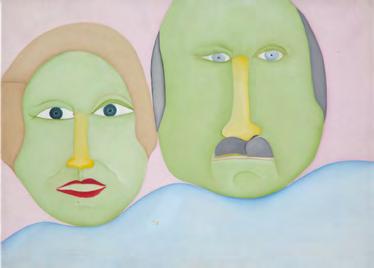
and both equally attached to communication. Caland herself also mentions that the aforementioned Apostu always saw sculpture in her “écriture,” by which he meant her paintings (fig. 3).13 His view into her work—allowing yet another medium to occupy the language she was inventing—helps guide our own. Forms in Caland’s work, Apostu helps us see, are not held by mediums; they exceed such categories as they pertain more to dimensionality and the existence it embodies, reorganized in something of a nonverbal linguistic register. So, if the choice between writing and making art was a false distinction, then, what kind of “writing” is Caland’s painting? What kind of speech does it evoke or refute? Of her own mother tongues, Caland remarked that “I speak, I write, I think Arabic, it is my maternal language, from the time I was in school, I speak, I write, I think French. This isn’t without contradiction because I write Arabic from right to left, even though I draw, like I write in French, from left to right. I have to be a good mixer, because to receive, digest, emit, that’s the triple function of every human being.”14 Language is here connected to human functionality and to mixing, perhaps even moving, which is telling for the migratory existence Caland would eventually assume. Her English was developed later, and the artist’s sketchbooks are replete with references to her fear of its difficulty, even as she deliberately mixed all three tongues throughout her life and spent most of her later decades in the English-speaking environment of Venice, California, where she moved from France in 1987.15 Specific linguistic registers notwithstanding, bits of visual
13 Moulin, “Géographie.”
14 Moulin, “Géographie” (translation mine).
15 Future research on Caland’s significatory systems might also investigate the pictographic forms of the Phoenician alphabet along with the forms
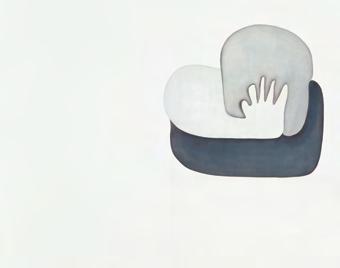
language—painted forms, even those that suggest “bits” of a body— operate exactly like the graphic symbols we find in Caland’s work, not to refer to the external world but rather to enmesh us in the painterly language from which they come.
To take this further, and to chart the path that will bring us to how language relates to Caland’s articulation of a self that is dispersed into the world that constitutes her, I turn to the work of the Moroccan writer Abdelkébir Khatibi, who was born in 1938, just seven years after Caland’s birth and twenty-six years into the French Protectorate in Morocco, which brought, as it did in Lebanon beginning in 1920, yet another language to the already multilingual life of residents there. Khatibi’s writings about how meaning is generated through language and form—or what we call signification—took root in this multilingualism and the variety of experiences it afforded different subjects. But also, it was rooted in the fact that, in Arabic, letters take different shapes depending on where they fall in a word, a flexibility that is only exaggerated in calligraphic renderings. In 1973 Khatibi published a short text called “A Note on the Calligraphic Sign,” in the January issue of the interdisciplinary journal Intégral, founded by the artist Mohamed Melehi and the writer and critic Toni Maraini in 1971.16 The text presents an analysis of how referent and form interrelate in calligraphic art, an analysis that would come to fruition in La blessure du nom propre (The Wound of the Name, 1974), in which Khatibi also presented his findings on Berber tatouage as
and formal patterns of Byzantine art, which she described as being of extreme importance in the Lebanese visual landscape: “We are suffused with Byzantine art in Lebanon . . . You’re not even aware of the influence. It is unconscious.” See Anne-Marie O’Connor, “Her Magical World,” Los Angeles Times, June 19, 2003, F12, Caland studio archive. On English, see, for example, the 1990–1991 sketchbook (Sketchbook 2), which, on the first page, dated November 19, 1990, describes Caland’s process of making Venice her home as deeply entwined with mastering English: “Breathing in English on the silence of a white page, when English is not mine / Gives such big emotions, that my heart is beating so strong . . . / Will I ever be able to use words as well as in French? / Will I adapt to America as well as to France? / My wish is to make Venice my homeland, and my home in Venice.”
16 Abdelkébir Khatibi, “Note sur le sign calligraphique,” Intégral : Revue de creation plastique et littéraire 2, nos. 3–4 (January 1973): 46–47, translated by Teresa Villa-Ignacio as “A Note on the Calligraphic Sign,” in Modern Art in the Arab World: Primary Documents, ed. Anneka Lenssen, Sarah Rogers, and Nada Shabout (New York: MoMA, 2018), 352–54.
significant inspiration for his understanding of how form makes and breaks meaning.17 Although the texts focus on very particular forms of mark making, their broader goal is to articulate Khatibi’s alternatively deconstructive semiology—one that, like Western deconstruction, works away from logocentric semiotics, but that, unlike Western deconstruction, also works forcefully away from the ways these logocentrisms have long bolstered Western ideas of singular and hierarchical, patriarchal, national narratives. Khatibi is invested in more expansive communities and ways of being. Key to his model is the identification of “intersigns,” and, according to his translator Matt Reek, how they work as “countersystematic agents of cultural meaning.”18
In these texts, Khatibi develops the term combinatorium, which, “intersemiotic” on its own terms, encompasses Western linguistics’ models of sign and referent, yet diverges from them in significant ways. In Khatibi’s hands, the combinatorium, or what Reek summarizes in his introductory framing as the “figurative space of a sign where signification’s intersection and imbrication take place,” is like “dark matter.”
19 The combinatorium is, in other words, the space or place that allows for the nearly alchemical process by which a meaning is both made and enmeshed in the very thing that gives rise to it, which is itself everywhere and invisible. In this murky territory, Khatibi finds avenues to consider the written mark as not just a representation of speech, as Euro-American paradigms would have it, but, simply, of form, purely plastic form. In the combinatorium, forms migrate and their references change across, through, and thus against the systems meant to contain them, much as they do in Caland’s work. On her canvases and smocks, dots, shapes, lines, and those graphemes
17 Calligraphy figures along with what Khatibi’s translator Matt Reek describes as an “astonishingly eclectic and penetrating semiotic reading of [other] subjects of Moroccan, North African, and Arab or Arabic popular culture: proverbs, tattoos, [. . .] a medieval sex manual, and oral storytelling.” Abdelkébir Khatibi, “Tattoos: Writing in Dots,” trans. and introduced by Matt Reek, PMLA 137, no. 2 (2022): 295. My deep gratitude to Rebecca Johnson and the students in our 2022 seminar on “Modernism in the Time of Decolonization” for directing me to this text and for helping me understand its great impact for thinking about Caland’s work.
18 Reek, introduction to Khatibi, “Tattoos,” 295.
19 Reek, introduction to Khatibi, “Tattoos,” 296.
Hannah Feldman
I mentioned above—best described as hatch marks—form exactly this kind of combinatorium, building a world of intersigns that, like dark matter, are everywhere, moving from one pictorial surface to another and changing meaning as they go. Perhaps we might be even more precise about those hatch marks, since we’re getting into the particulars of Caland’s frames of reference: these hatch marks work less like the shading and hatching that has emerged through history to endow depth to a two-dimensional representation and more like the crossstitched x ’s that form the building block of tatreez, a particular form of Palestinian embroidery. 20 These marks are perisystemic, meaning they exist alongside or around the system, but not in it. They leap, along with other folds, swells, curves, and points, from one drawing to another, reappear from one painting to another, jump from one decade to another—and even from a painting to a dress, or two, and, by association, to the bodies underneath these dresses—even if they appear precisely when you least expect them to. Even when offered as something that might look like speech, or the words we think represent it, the signs Caland gives us in, for example, a series of collaged selfportraits she made in the 1990s and to which I will return do not refer to the reality of the thing being spoken, at least not the thing being spoken then (figs. 4, 5, and 6). They point elsewhere. In other words, Caland’s combinatorium of forms gives us an x that does not immediately evoke a representation of, a sign for a y. To say that she paints “in reference” to her life or its events is not to say that she represents them, but rather that she paints something that exists and, like dark matter, is already all around us, around her. Her paintings then affirm something like the webbed quality of all things, spaces, people, and qualities. In offering us singular signs, they nonetheless point to the impossibility of such singularity in a world of plurality.
Khatibi begins his 1973 text by asserting that writing is concerned “with the uniqueness of cultures and, more deeply, with the relationship of text to being.” 21 How true for Caland, and how important
20 In her brilliant essay, “Huguette Caland: Everywhere Is a Corner That Could Be Anywhere Else,” Claire Gilman also notes the relation of Caland’s late works to tatreez. See her essay in Huguette Caland: Tête-à-Tête , ed. Joanna Ahlberg (New York: Drawing Center, 2021).
21 Khatibi, “A Note,” 352.
for us to consider as her work enters canons ready to make it “legible” as figuration or abstraction, and as various appetites, markets, and institutions will attempt to lock and fix its meaning as indicative of her Lebaneseness, her Frenchness, her cosmopolitan-ness, her queerness, her femaleness, her foreignness, her coming-from-a-place-of-warness, the presumed significance of her being-the-only- daughter-ofa-historical-anticolonial-president-ness, and so on. 22 All the things that constitute her biography, but not as she chose to author it, and, in fact, all the things she worked against in both her life and work. The calligraphic sign, Khatibi suggests, works through repeated and multiple readings, which, against Western reading practices—other than those demanded by modern poetry—actually destabilize the sign and with it the fixity of meaning. In reading calligraphy, for example, you are confronted with both faces of the sign, simultaneously: the signifier (the writing) and the signified (the meaning of the word or phrase). 23 So, in reading calligraphy, you start, Khatibi suggests, with something you already know. He gives the example of la ilaha illa allah: there is no God but God. 24 You recognize the phrase “la” or “there is no” and, from there, especially if you’re an Arabic reader or a Muslim—you immediately anticipate the rest of the “essential” Quranic phrase, but, in order “to be fruitful,” this reading also requires that you find the words in the calligraphy. 25 It demands that you trace out the combination of letters that make it, make this thing, this meaning that you already apprehended at first glance. 26 This is a
22 See, for example, Colby Chamberlain’s review of the Drawing Center’s Tête-à-Tête in Artforum at https://www.artforum.com/events/colbychamberlain-on-huguette-caland-248866/ for an example of a reading that wants to insist on the particulars of her family’s history as well as Lebanon’s status as a country marked by civil war as crucial heuristics for Caland’s work.
23 Khatibi, “A Note,” 353.
24 This phrase begins the Shahada, or the Islamic declaration of faith, in Arabic. The Shahada, which continues to say that “Muhammed is his Prophet” (or messenger), is considered the most sacred statement in Islam and is vastly reproduced in writing, on mosque architectural adornments, and so forth.
25 Khatibi identifies the phrase as Quranic, but, technically, even as the claim “there is no God but God,” appears in the Quran, the two parts of the Shahada (two in Sunni faiths; in Shia faiths there is a third), don’t come together until the Hadiths.
26 Khatibi, “A Note,” 353–54.
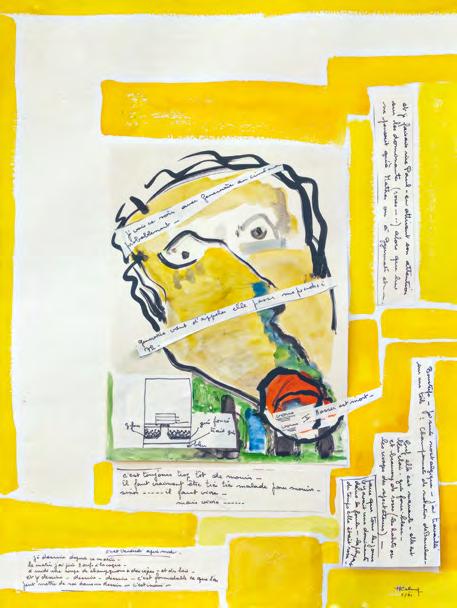
Fig. 4: Untitled (Self-Portrait), 1991
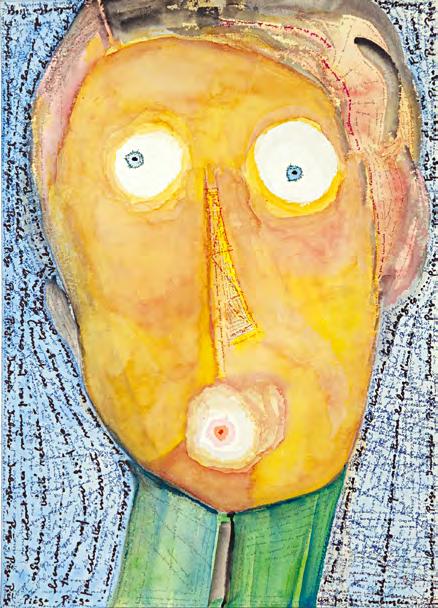
Fig. 5: Untitled (Self-Portrait), 1992
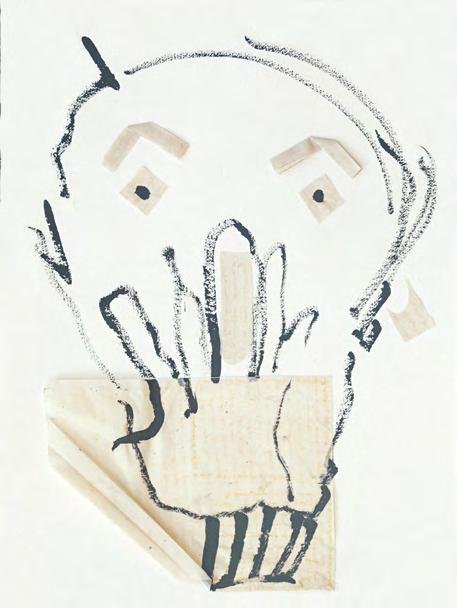
6: Self-Portrait, 1992
Fig.
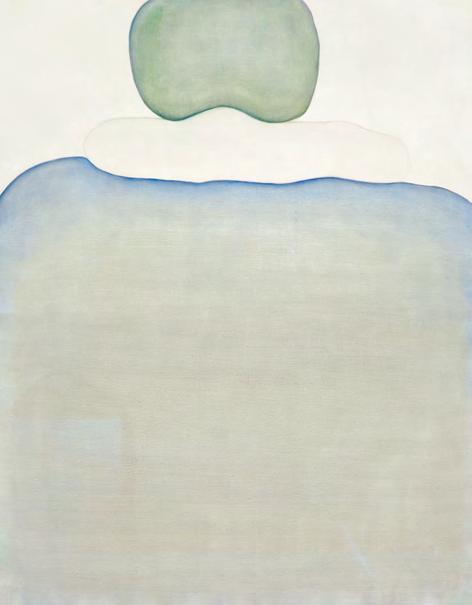
Fig. 7: Self-Portrait (Bribes de corps), 1973
Hannah Feldman
reading of what Khatibi describes as “recognition” and identification, not one of logical development and interpretation. 27 In it, language moves away from confirming the real that exists (“eroding signification”) to lurk instead in the imagination—a place that is equally real, at least in some cosmologies. 28 Caland once identified the imagination, in fact, as her true “homeland.” 29 In this realm, things scramble. Again, Caland herself couldn’t have said it better when she wrote on a scrap of paper now archived in her Venice studio that “the same lines could represent a body, a face, a flower, a landscape.” 30 Form and referent have no guaranteed rapport in the combinatorium we’re coming to face.
To be clear, I by no means here want to suggest that Caland was making calligraphic art, or even Islamic art, about which her aesthetic opinions were divided (a fact that did not stop one of her first instructors, John Carswell, from including her work in his writings on “Contemporary Islamic Art”). 31 Rather, what I want to suggest is that it is this same kind of apprehension, or way of grasping meaning, that underscores the ways you might experience a Bribes de corp painting, or, indeed, any other of her work, even before you can figure out where, or why (or even who or what, as the case may be). You already know what you are seeing, even before you can determine why you know it as such. This is especially true of those Bribes de corps that Caland also titled Self-Portraits (fig. 7). In these too,
27 Khatibi, “A Note,” 353.”
28 Khatibi, “A Note,” 354. Here, it should be noted that Khatibi’s semiotics move language out of the “symbolic” realm, where, for example, Western poststructuralist theory has placed it, and hence also away from the juridical/patriarchal realm associated with that order of representation.
29 Sketchbook 2 (1990–1991), January 12, 1991; English in original.
30 Undated and uncatalogued note in the Caland studio archives. English in original. In her 1990–1991 sketchbook (Sketchbook 2), Caland refers to hands on her body as if making their way through the “landscape,” rising, falling, and so forth.
31 See, for example, John Carswell, “Islamic Art and Contemporary Painting in the Middle East,” in Middle East Forum/Al-Kulliyah (Winter 1972). For Caland’s opinions on “Islamic art,” it is perhaps instructive to consider her own words from her 1990 Paris sketchbook, Sketchbook 13. Here, describing her idea to make a line of clothing and interior decoration for Pierre Cardin using Islamic art, she singled out only the “best level” of this art, noting she would forego the “bad taste” of its excessive use of gold, red, and green, “highlighting” instead its “marvelous and colossal potential.” Sketchbook 13, 1990 (translation mine).
forms are scrubbed—or nearly scrubbed—of the specific signs that would normally make you understand “what” you’re seeing: faces or specific body parts, for instance. And yet you know what they are when you see them. Like calligraphy, as Khatibi has us understand it, these works require that you find the parts in what you knew, at first glance, already. Once you find them, you will find them elsewhere, as will others, and you all will read against a system that tells us what things should be and how they should stay. Indeed, coming to terms with the permanence of instability is one of the ways Caland explained how she approached her own paintings. 32
To be sure, this most famous series celebrates and, for many, eroticizes body parts or bits by emphasizing their capacity to morph, overwhelm, enjoy, spread, rescind, collide, coalesce as they also shift our capacity to say what is foreground and what is background. They move. The parts, or bits, of these bodies are most often soft and supple; when they are pointy or sharp, it is because they are forming things we associate with partitions: lips pursed close in a kiss, or cracks of butts and their inverse or reverse on the front of the body, tenuous openings or points of plying that might yield access (in the imagination) to deeper regions within, despite the flatness of their manifestation on the canvas. These bits have been taken up by art historians in the recent years as signs of Caland’s play with gender and its illogically presumed binaries, with sex, with pleasure, with the distinction between figurative and abstract painting. 33 But they are more than that. In fact, bits, or “autonomous volumes,” as Caland once named them, are all we have in her work. 34 In Caland’s later paintings, the bits of the body are replaced, nominally, by bits of memories in the large format Bribes de l’été (Summer Bits), which give us unstable and shifting glances of childhood summers, and
32 See Moulin, “Géographie.”
33 See, for example, Omar Kholeif, “In the Heart of Another Country,” in In the Heart of Another Country: The Diasporic Imagination in the Sharjah Art Foundation Collection, ed. Omar Kholeif (Hamburg: Deichtorhallen, 2023), 41. Early criticism of her work rarely used this kind of language, tending instead to celebrate the work’s novelty, its graphism, and its pop affinities. See note 44.
34 Undated and uncatalogued note in the Caland studio archive (translation mine).
Hannah Feldman
which were exhibited in Beirut at Nadine Begdache’s Galerie Janine Rubeiz in 2011, under the rubric “Mes jeunes années.” These bits, murky and without specific reference, are again not referential per se even as they are meant to, as she wrote in the exhibition’s dedication to her parents, “hold” the “poetry” of her childhood, the weblike remains of which take form in painted strokes that draw more from the pictorial world of tapestries than from given realities. 35
II
A Biography of One’s Own
I was storytelling my life and the people in my life at that time.
—Huguette Caland, Los Angeles Times, 2003
It is in one of these late paintings that the artist helps us understand why it matters that we see the works made by newly “discovered” or rediscovered women artist from the Middle East in the terms they articulate themselves and not those the market or institution insists upon (p. 229). 36 The title of the painting Maison de Freige (The Home of the Freige Family, 2010) is the only truly concrete referent in the work. 37 It refers to the home of Jean and Alice de Freige, which
35 Huguette Caland: Mes jeunes années, exhibition pamphlet, Galerie Janine Rubeiz, Beirut, January 12–February 12, 2011 (translation mine).
36 Throughout this text, I have used the problematic geographical descriptor of the Middle East, in large part because it maintains currency in art historical accounts of the period, even as its contemporary usefulness is well challenged by those who prefer to speak of a SWANA region (Southwest Asia and North Africa). It was also the terminology that Caland used in her work, and it seems as though, for her, Lebanon was, in some ways, marked by its middle-ness, a quality of in-betweenness and necessary mediation that she enjoyed. The market for art from this region has grown exponentially in recent years, and women have been in especially high demand as is evidenced by the number of exhibitions dedicated to (and rising prices for) figures like Simone Fattal, Etel Adnan, and Saloua Raouda Choucair, to name just a few. We should expect others soon to appear in Western exhibitionary spaces, including, for example, Bibi Zogbé, Juliana Seraphim, and Seta Manoukian, to name just a few that come from (or passed through) Lebanon.
37 Maison de Freige was another one of the thirty-three paintings that had to be cut from the exhibition in September/October 2024.
they shared with the El Khoury family before Bechara became president and where Huguette was born. Don’t search the painting for identifiable faces or even architectures; they are absent. Instead, you’ll find a phantasmagoria of pinks and reds that now and again coalesce into blossoming flowers (there are also a few blue ones). When they do not form flowers, the pinks otherwise remain mostly muted in the background that was forged by dyeing the canvas in a washing machine. It is on top of this surface that Caland gives us, in rough, square-ish patches formed by her having folded the canvas to work on it in sections, a series of tapestry-like dotted and crisscrossed lines in ink: the cross-stitches of tatreez, here brought together in a manner that equally recalls a patchwork quilt. A singular drawn bust emerges in the lower center of the painting, outlined by a line made of blue x ’s and, nearby, a diminutive figure of a girl in braids that merge into similar lines formed with x ’s. Here and there, the artist has written on the canvas. The words, like their pictorial equivalents, give us little data about a life. Rather they contribute to something like the ether in which that life was lived, or to the dark matter of the combinatorium, evidencing the ways in which signification both intersects form and is imbricated from within. The evocation of this childhood home takes us to the mind of a young woman who, we learn, remembers bombs and shards of glass from the period between 1931 and 1937 and wonders why she thought it elegant to hold her head in a certain way. 38 These, however, are not just particular qualities. They are quickly generalized and made plural when the handwritten notes offer the following invective: “Little girls should not speak politics / No politics / Shut up girls shut up” and, nearby, simply, “All the Forbidden things speaking your mind,” though Caland does not actually say what these things might be or even who “you” is, suggesting it is both the viewer and the artist. Now, much has been said about Caland’s father and the family’s social standing, not to mention the pressure it put on an
38 These years were marked by the rise of nationalism, which was met in equal force by the fear that independence would bring an independent Lebanon under Syrian annexation. Lebanon witnessed multiple and significant strikes and other forms of disruption during these years, and this is likely what Caland alludes to. See Fawwaz Traboulsi, A History of Modern Lebanon (London: Pluto Press, 2012), 96–104.
unconventional child who was made to stand in the public’s eye under scrutiny not easily managed by most children. We don’t need to repeat this. 39 In Maison de Freige, we get a direct sense of the gendered impact of living in a political family from a certain class in a country angling to achieve sovereignty: politics were matters for men, not for little girls. “Lebanon was exploding / Shut up,” Caland writes. And this prohibition on speech stretched not only across politics but also to all the other “forbidden things” that, if you adhere to Caland’s odd syntax, “speak” her or “your” mind. These forbidden things could well include the thoughts of sex, thoughts of pleasure, of freedom and independence, of professional ambition that we know Caland and many others had. But, like politics, these too were not for little girls. 40 A painting from the 1990s that Caland hung high above the doorway to her bedroom in the home she built for herself in Venice, California, tells us everything else we need to know about this environment (fig. 8). The Legs of My Aunts Seen from under the Table gives us a child’s view under a table of pink and bulbous calves.
39 Indeed, it is oft cited that the artist left Lebanon for Paris in order to stop being the “wife of, the daughter of, the sister of.” See, for example, O’Connor, “Her Magical World,” and Anne Barlow’s reference to this citation in “Introduction.”
40 Women were not given complete suffrage in Lebanon until 1957 (noting suffrage for men did not exist until 1947); other rights—such as those regarding family, divorce, and inheritance—are determined by personal status laws, which are determined by religious institutions and which, for the most part, treat women as extensions of their husbands, deprived of many of what we call civil rights. See Lamia Rustum Shehadeh, “Gender-Relevant Legal Change in Lebanon,” Feminist Formations 22, no. 3 (Fall 2010): 210–28 and also Maya Mikdashi, Sextarianism: Sovereignty, Secularism, and the State in Lebanon (Palo Alto: Stanford University Press, 2022), esp. 3–10. In a seminal television interview with Hanan al-Shaykh from 1974, translated in Huguette Caland: Everything Becomes the Shape of a Person 1970–78, ed. Aram Moshayedi (Milan: Skira, 2017), Caland asserts that “[e]verything is political, I think, everything done consciously becomes political. And if there is consciousness and talent, then it becomes political and artistic. I don’t think you can separate one thing from another, I mean, art is politics, and politics is an art. There are no borders” (185).
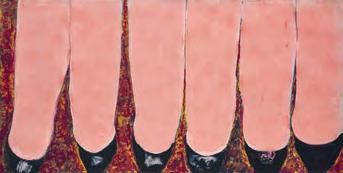
Fig. 8: The Legs of My Aunts Seen from under the Table, 1991
These belong to what the title identifies as Caland’s aunts, but the term also evokes the beyond-literal translation of les tantes —a teasing reference to the middle-aged ladies who represent an imposed class and decorum, oblivious perhaps to the changing nature of the world. The pressure exerted on the bubble gum–pink legs of these aunties by the tight black shoes they’re wedged into suggests the same kind of (en)closure or suffocation that Caland recalls in the simple line: “Shut up.” Their authority represented and perhaps also undermined by the single, almost ridiculous form of the pink oblong shapes, the aunts are reduced from body to bits to painterly shapes let loose in the combinatorium of Caland’s interlinked forms, if you will now join me in calling it that. In other words, in the painting, all forms of signification that link class and gender are stripped of any hold they might have had on the young girl whose politics and sexual drives were still in formation, and the stability of a system both political and linguistic is utterly undone.
Given all this pressure on speech and speaking one’s mind, it is no wonder that Caland would search for ways to articulate herself other than through a language normally coded as speech. Nor is it any wonder that she titled a 1971 painting depicting a mostly linear crowd of figures and forms that culminate, from left to right, in a giant finger stuck into a lipsticked mouth Enlève ton doigt (Remove Your Finger ; p. 78). “Take your finger out of my mouth,” the artist suggests. And yet speech, as it were, was not what she was after in such liberations of the figure’s jaws, or so we come to understand in the monumentally scaled Visages sans bouche, bouches sans visage (Faces without Mouth, Mouths without Face ; fig. 9), from 1970 to 1971, which hung, according to Brigitte Caland, as a banner in La Courneuve, France, during the Fête de l’Humanité in 1971. 41
41 See Brigitte Caland, “Visages sans bouche, bouches sans visage,” in Huguette Caland , ed. Anne Barlow et al., 36. The Fête de l’Humanité is the annual fundraising celebration of the left-leaning French newspaper L’Humanité and has taken place since 1930. It is said to be one of the most attended public festivals in France and often features famous artists and,

Hannah Feldman
This second “departure” painting gives us five penis-nosed women’s faces, all deprived of their poppishly red-hued mouths. These, in turn, appear unmoored, sandwiched between the faces and straddling a background of striated lines of orange, yellow, pink, and blue that also might have walked off of one of the earlier works she made in Kaslik, where she lived and worked out of her family home in the 1960s. In the center of this painting, a face whose hair is cropped in the manner of Caland’s is pictured with only one eye, recalling other works she made to present herself (fig. 10). Here, the unmoored mouths are disconnected from their function as speech organs, and faces represented without them are rendered mute. Suggestive of its thematic import for the artist, the painting is Caland’s largest ever, which is saying something for an artist whose last years produced dozens of four- and five-meter paintings, paintings so large she had to use a walker to traverse the canvas in order to make her first marks with a squeeze bottle of paint. Only then would she sit with the canvases, dyed in her washing machine, folded on her lap or a table in front of her, to write, in ink, all the hatched and dotted lines that mark the surface of these late, so-called tapestry paintings, and to otherwise adorn their surface with additional bands of color, often cohered in the form of flowers.
Of course, Caland did speak against the restrictions imposed upon her in Lebanon, especially in her actions. Forgetting,
increasingly, musical acts. It also features “stands” set up to promote various local organizations and political speeches, political debates, and other activities perceived to be of interest to the French Left.
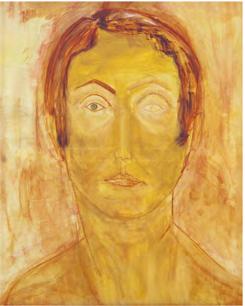
Fig. 9: Visages sans bouche, bouches sans visage, 1970–1971
Fig. 10: Self-Portrait, 1967
because it is well rehearsed elsewhere, her openness about maintaining a lover while married, we can think about other of her political announcements, as it were. For example, to her first solo exhibition, held in 1970 at Dar el Fan, Janine Rubeiz’s innovative platform for art, film, and political events alike, she invited two buses of Palestinian women from the refugee camps at Sabra and Shatila, noting that no one had likely invited them to a cultural manifestation before. 42 The year prior she had cofounded with Sima Tuqan Ghandour and Chermine Ghandour Hneineh an NGO called Inaash to help Palestinian women in the refugee camps earn a living from their embroidery while also keeping their cultural traditions and collective memories alive. 43 While such moves might appear small, or similar
42 Dar el Fan, or Dar el Fan wa el Adeb, “House of Art” or “House of Art and Literature,” was a cultural center, maintained by memberships, that Janine Rubeiz started in 1967 to host art exhibitions and conversations, screenings, and political programming, including, for example, lectures on women’s rights in Islam. In 1976, its physical space and archives were destroyed by fire during the Lebanese Civil War. In 1992, Rubeiz’s daughter, Nadine Begdache opened Galerie Janine Rubeiz in her mother’s honor. Nadine was responsible for promoting many of the most important and exhibited modern artists of the region, including Huguette Caland. On the 1970 exhibition, for which Caland had to hire local firefighters to hang her paintings (a fact noted in local press, including Le Jour), because she wanted them installed high on the walls, and for Caland’s description of having brought a busload of Palestinian woman to her opening, see Huguette Caland, “Peinture et amitie,” in Janine Rubeiz et Dar el Fan: Regard vers un patrimoine culturel (Beirut: Editions Dar an-Nahar, 2003), 80–81. The Daily Star announcement of Caland’s opening also noted that the opening was preceded several days prior by a talk by Bassem Jiar (in French) on the topic of “Revolution—Is it Possible?” and, on the same eve, a film screening of Lebanon—Sketch 1, produced by Radiodiffusion-télévision française and the French journalist (and staunch anti-communist) Pierre Andreu. 43 In “Her Magical World,” Anne-Marie O’Connor notes that in her Venice home, Caland had “needlepoint” made by women from Sabra and Shatila, whom Caland more likely introduced as made by artisans of Inaash. For details on the founding of Inaash, I am grateful to Yildiz Mohamed Selim Zaki, who introduced me to Sima Ghandour and to Nadia Abdelnour, the current president of Inaash, and Ali Jabbar, the general manager, for coordinating an interview with her and other advisors to the board, including Zeina Shahid and Mayya Corm. See also the TRT/TRT Arabi interview with Sima Ghandour, “1948 Nakba Survivor Mrs Sima Ghandour,” posted on Inaash’s Instagram account on March 9, 2023, https://www.instagram. com/reel/C4SDmEAN0al/?utm_source=ig_web_copy_link . See also Pat McDonnell Twair, “Regrets Too Few to Mention,” Middle East , no. 373 (December 2006): 62–63, in which Caland is revealed as disparaging the
to the kinds of charitable outreach we’re accustomed to in contemporary practice, for the daughter of a prominent Christian politician, such actions of solidarity were also a way of speaking without language, and doing so loudly. 44
In 1970 or thereabouts, Caland created a kaftan, Dress 7, Inaash with the Palestinian women who worked with Inaash, taking about twenty small patches of embroidery and applying them to the lower half of the white silk fabric of the dress (p. 154). 45 In the
refugees’ initial attempts at “traditional” embroidery, noting—with pleasure—that their skills improved as they earned money, but not mentioning that they were, in fact, also being trained in these “traditional” forms, thus indicating an important local, if not Christian, investment in the cultural traditionalizing of Palestinian refugees in Lebanon.
44 According to Gérard Khoury, she unveiled the “political hypocrisy” of those who hid from daily life what they didn’t want to threaten their careers: “the injustice done to Palestinians.” See Gérard Khoury, “Shopsticks,” in Huguette Caland: Works, 1962–2012 (2012), 19 (translation mine). As for her celebrated, licentious treatment of the human form, however, it has to be noted that Caland was not the only artist in Beirut in the 1960s who made much of the female body, its appetites, and sensuous embellishments: we have the painted and drawn works of Cici Sursock, Juliana Seraphim, and, more to the point, the ceramics of Dorothy Salhab Kazemi to compare her works to, even if we cannot say she was directly engaged in their practices (despite sometimes being shown alongside them). That her work was always “shocking” or surprising is noted in the early criticism that responded to her 1970s exhibitions in Beirut. There, critics of her early work described it with recourse to terms like neo-nouveau, noting, again and again, its uniqueness, and her singularity—which corresponds with Caland’s own stated interest in painting as a way to explore her “liberty”—often attributed to the strong, graphic style she used to depict not only bodies, but also insects, gardens, and “monsters” of sorts in strong black and whites as well as bold, if not also “psychedelic,” colors. See the text by the poet and art critic Victor Hakim in what I presume to be his column, “La vie artistique et littéraire,” in La Revue du Liban, 1970, as well as Cathy Latta’s English-language review of the Dar el Fan exhibition printed in The Daily Star, November 16, 1970, “Color, Bulk, and Detail Excite the Eye,” that praises the work for being “individual,” and notes that “Huguette thus holds something in common with the imagination which has built the bizarre worlds of neo-nouveau art.” See also D. A., “Huguette Caland : Un peintre diurne,” in Magazine, November 15, 1970, and M. A., “47 toiles de Huguette Caland : Le graphisme à l’état pur” in L’Orient, November 15, 1970, which describes the difficulty of writing about Caland’s work because it is so singular and unlike any other contemporary art.
45 The abaya, or kaftan, had been of interest to Caland since she first began wearing them after her father’s death for reasons detailed elsewhere in this catalogue. The subject was also of interest in her early painted works, as for example, in works exhibited in the 1970 Kaslik studio
45
Palestinian tradition, the patterns and motifs of tatreez, often sewn collectively by women sitting together while each works on her own piece, speak of family stories and histories, even as they never spell them out explicitly. The meaning of the patterns is known to those who know how to read them. When these patterns are brought to the thobe, a traditional Palestinian dress, they become, according to Wafa Ghnaim, ways to tell the maker’s “story in stitches” through color, pattern, and line. 46 While Caland’s appropriation of this material for her own dress can’t be said to similarly tell her own story, it does highlight the value she put on nonrepresentational narrative and its mediation through the form of the body. Perhaps tatreez was to Caland what Berber tatouage was to Khatibi: a way to chart a new means, a new modality, a new tactic to represent.
For sure, the emphasis on pattern and stitching in tatreez would appear in much of Caland’s work, especially in the later years. But, if works like Maison de Freige have also been thought to explicitly draw upon the practice of tatreez in their composition and visual appearance as if they were tapestry, we can also say they drew their visual vocabulary—what would become the warp, so to speak, to the background weft—from her earliest works, those she cultivated during her years auditing classes in the Fine Arts Department of AUB. It was work like this that she hung—with the help of firefighters, no less!—at Dar el Fan and a few months prior, with her friend and teacher Helen Khal at Caland’s own Kaslik studio in an exhibition titled simply Double accrochage (Double Hanging). In these works, erotics were far from the only attribute
exhibition with Helen Khal, where the black-and-white presentation of a decorative motif, presumably from the neckline of an abaya, earned the description “decorative, almost documentary,” in the aforementioned text by Victor Hakim published in the days immediately after the Kaslik opening. Years before her death, Caland again collaborated with the Inaash artisans; they made an embroidered dress based on the drawn patterns on one of her smocks, bringing the collaboration full circle and underscoring the significance of the marks on Caland’s daily wear.
46 Wafa Ghnaim, “ Tatreez in Time: The Memory, Meaning, and Makers of Palestinian Embroidery,” Met Museum , July 26, 2024, https://www. metmuseum.org/perspectives/articles/2024/07/tatreez-in-time . See also Rachel Dedman, At the Seams. A Political History of Palestinian Embroidery (Birzeit: The Palestinian Museum, 2016).
assigned to bodies, bodies that instead often act as surrogates for spatial experiences, indicating the ways in which the environment shapes, forms, and, indeed marks them. Consider Exit (1970) the title of which thematizes Caland’s decision to leave Beirut. Here, crammed into a circular form squashed into a nearly perfect square frame are stuffed ten or so almost caricature-like faces. Some, such as Moustafa Ariss, Caland’s lover, are identifiable through their facial features, and other faces bear known expressions: a grimace here, a pouty smile there (p. 77). 47 And, because Caland’s vocabulary did not entirely shirk representational form even as it would come to undermine its conventions, you can also discern some body parts, male and female, but they are hardly erotic. Instead, they appear entirely secondary. What is most striking, however, and useful for our analysis here, is how the forms—the circles that form the curls of one woman’s hair, or the pattern of Moustafa’s shirt—shed their referential status in other works of the same period where these same forms come not to suggest other things, but simply to exist as forms unto themselves, forms that might, for instance, and without any actual reference, animate the surface of what we take to be buildings, as for example in an untitled work from 1968 (fig. 11). Here, quasi-architectural forms are contained by the bulbous shapes that
47 For more on Moustafa, see Tarek El-Ariss, “Huguette Caland: Body Politics,” in Huguette Caland: Faces and Places, ed. Mohammed Al-Thani, (New York: IAIA Publication, forthcoming). In his text, El-Ariss uses the spelling “Moustapha.” Of special note in this essay is El-Ariss’s discussion of Caland as, in her own words, a jin , which El-Ariss tells us means, in Arabic “genus” or type, but also “race,” “gender,” and “sex” “all at the same time.” From this he develops an understanding of Caland’s philosophy of community that both challenges dominant norms and is based in love, grounding the body and its pleasures at the “heart of any liberation movement no matter how painful or long it might be.”
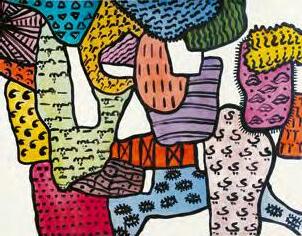
have signaled buildings in other paintings, but they do not fit into a demarcated sense of place. What is especially interesting is the roster of Arabic letters that float on their surfaces, untethered, signifying—like the question marks, squiggly lines and hatch-marks— nothing and never coming together to generate words. We begin to see, instead, the artist cultivating what Moulin would later suggest was, in fact, her own proper écriture, here one that eventually held on to only one feature of the Arabic she subsequently and almost completely abandoned in her painted repertoire: the nuqta, or dot, that appears above or below the Arabic letter to distinguish one curve or one line from another. In Caland’s work, these dots, Caland’s graphic intersign par excellence, will proliferate and multiply, sometimes appearing as empty spheres and sometimes as fully colored dots, always freed from the constraints of having to differentiate anything from anything else at all. We might consider them, for example, in Caland’s portrait of her teacher and close friend, Helen Khal. Helen shows us a paired, black-lined legs and breasts, pressed into a tight V, as if by the multiplying forms of black-outlined circles that fill the rest of the frame, circles that seem anxious to push beyond the rectilinear constraints of the canvas (fig. 12). In these early works, Caland’s biography is torn from representations of her life, just as literal aspects of language are transformed into the kind of pictorial representation that builds the narratives of tatreez.
III
Migrating Forms, Dots, and Letters: Shapes and Colors in Four Languages
Put language everywhere, because that’s love too.
—Alex Dimitrov and Dorothea Lasky, aka Astro Poets, July 2024
Sometimes, Arabic calls tattooing “writing in dots.” This kind of writing directly on the body is different, to be sure, from Caland’s acts of painting and writing on her smocks. But they are also structurally similar, knotted together perhaps not by the question of skin or canvas but by the dot that etches a design into either surface. Arabic in general is sometimes described as the language of the dot
(al nuqta), but Khatibi’s focus depends more upon the circulation— what he calls the migration—of dots that characterize Berber tatouage, which move from the skin of bodies, for example, to carpets, and then to interior wall decorations without hierarchical order to each placement. There is no originary “dot,” so its meaning is not fixed; it is the prime example of what Khatibi calls an intersign. In such a representational scenario, mark making opens onto new and speculative dynamics of relationality that can emerge, change, retreat, and reemerge to form new combinatoria, that “dark matter” made up of relations between forms, and with them new communities of viewers and readers, although recognizers might be a better term, and perhaps even listeners if we can allow that listening and hearing don’t depend upon orality.
Let’s look more closely at how some of the dots and x ’s migrate onto the body only to drift back to the canvas where they undo systematic assumptions about the primacy of figure and ground or the distinction between abstraction and figuration. Caland explores those dots, circles, x ’s (that she herself called “cross-stitches” in reference to tatreez and to the embroidery she learned from her mother), and other ovoid structures in The First (Dress 1) (p. 139), a kaftan of Caland’s own design that she herself wore to the opening of Sixteen Lebanese Painters in Rome in 1972 (p. 58). 48 There, her
48 An extraordinary film clip (and review) of the opening of this exhibition can be seen at https://patrimonio.archivioluce.com/luce-web/detail/ IL5000043092/2/. Notable in this clip are images of works by Cici Sursock and Juliana Seraphim, which focus far more explicitly on the body than Caland’s own contribution that instead represents the kinds of graphic dot-and-line forms she primarily exhibited in her Kaslik and Dar el Fan exhibitions of 1970. It also demonstrates that a catalogue of this exhibition was produced. Photographs of Caland wearing this dress in front of the paintings shown here are often misattributed to her 1970 openings

own work resembling the kaftan she was wearing was on display on the wall behind her. Indeed, both the top and bottom of the dress are embroidered with colorful versions of the same amorphous forms— lozenges, circles, wedges, all versions of dots—that appeared in so many of the early works the artist exhibited at Dar el Fan. The bodice is left entirely blank, and, because of a long, snaking, vertical line up its center as well as down both sleeves, it looks almost as if a sleeveless cloak has been draped over the embroidered sections, reinvigorating the idea that the body is a painted form beneath the wrapping. In fact, the same dress was made fifteen years later to animate the corporeality lurking in a wooden mannequin that Caland designed for an installation entitled La mille et unième nuit de Shéhérazade, which was featured at the Cultural Center in Boulogne-Billancourt in 1985 as part of a multi-sited and multimedia exhibition celebrating the famous collection of stories called 1001 Nights, in English, or sometimes, The Arabian Nights.49 Wearing Caland’s dress, the mannequin is transformed into a surrogate for the artist’s own body. The artist as mannequin, a “storyteller” like her namesake, Scheherazade, becomes the mark maker and progenitor of her own system, just as Scheherazade had been.
In Espace blanc 1 and 2 ( White Space 1 and 2 ; pp. 130 and 131), two paintings assumed to have been exhibited—alongside a companion painting entitled Shéhérazade —in the 1001 Nights exhibition but recently proven not to have been, this system is revealed in full force. 50 Two magisterial paintings of two hundred
in Beirut and should be corrected as photographic documentation from those exhibitions, as they indicate different manners of hanging and show Caland in different attire.
49 The exhibition was entitled, after the book it celebrated, Les mille et une nuits, and, according to the illustrated pamphlet produced to celebrate the event, it ran between January 25 and March 17, 1985, as a collaboration with the city of Boulogne-Billancourt, the Institut du Monde Arabe, the Bibliothèque Nationale, and the Musée du Louvre. Caland appeared in the section dedicated to “Les artistes contemporains et Les mille et une nuits ” alongside, for example, Chafic Abboud, Dia Al-Azzawi, Erró, and Adam Henein, to name just a few of the dozen plus artist named in the exhibition pamphlet. It should be noted that Caland’s name is misspelled, missing, as it is, the final d
50 My thanks to Léo Rivaud Chevaillier for sharing his excellent research on this exhibition with me.
Hannah Feldman
square centimeters, these works bring back, in microcosm, all the forms and motifs from the Bribes de corps along with some of the patterns and motifs of her 1960s work. In both Espace blanc paintings, the titular white space is indeed prioritized over the molded bends of color. The “white space” thereby suggests the white of pages or perhaps of muslin dress bodices, while the bands of colored forms—more like the Bribes de corps than the graphemes from the early work—careen across the canvas like written lines, a stitchedtogether lexicon of letters or signs that we can recognize from earlier works and motifs. As with calligraphy, you recognize these forms but have to search to find them in this new articulation, making their relationship to any external referent unstable, subject to new identifications and recognitions. In this new scale, and new palette, the bits of bodies that had been so erotic in the Bribes de corps now no longer seem quite so. The combinatorium we are left with exceeds any concrete interpretation or logical rubric of reference, so we are in the land of abstraction and yet also the land of realism as these forms represent other actual things, or at least other actual forms. In a published epistolary exchange with her cousin, the writer Mirene Arsanios, the artist Marwa Arsanios has suggested that Caland’s aesthetic abstractions might be read as ways of “melt[ing] hegemonic social abstractions (i.e., the nation- state and its economic and political institutions), to make them liquid.” 51 Indeed, such is the power of a countersystematic system of signification. It topples hierarchies. As countersystematic agents, these intersigns in Caland’s practice, her own invented alphabet of curves, slits, bulges, dimples, protrusions, sucking holes, and so forth, invite her viewers to abandon the rational rules of signification and to locate other ones, new ones, in a kind of corporeal writing that is both in and on the body, hers alone, but also ours, and tethered to us both. It strikes me that love for all, but especially the other, is what underlies Caland’s effort to redefine systems of communication to include communities otherwise not counted. New languages deserve new readers and speakers.
51 Arsanios, “In Conversation,” 66.
Here I might return for a moment to the 1990s in order to touch on those other self-portraits I mentioned, in which Caland gives us fragments of actual texts, some of which are made to appear as if enunciations. And yet, they do not speak. They cannot, and they are presented as such. The majority of these self-portraits are mixed-media works on paper, in which the artist combined drawings with torn shards of correspondence and, it would seem, now and again, other discarded drawings. 52 They are not all easy to look at, as they often evince a woman usually at a far remove from the mostly joyful mounds of color and line that dominate the Bribes de corps, the Espace blanc paintings, the dresses, and so much of the rest of her work until the late 1990s. The letters—and now and again we see the bits of stationery that mark at least some letters as her own, sent some near thirty years prior from her house in Kaslik—are no longer legible. What might have been glimpsed after they were cut, torn, sliced, rolled, folded, and pasted, is fading—even still—as the pigments in the ink disappear into history. 53 Sometimes, in the self-portraits, what should represent, look like a mouth, is covered
52 In her 1990–1990 sketchbook (Sketchbook 2), Caland writes and draws over a written page, suggesting the genesis of the Silent Letters to come. In the margins of this drawing-text, she speaks of wanting pages and pages, but notea she will use recycled paper, a phrase she repeats. At the bottom of this page, she makes the declaration that “life is not punishment,” but then comes back to ask, “or is it?” A few pages later, she frames her worries about paper (and linen) as connected to finances and her fatigue from not having money. However, it is more likely that money was not the primary reason she began using her own archive of letters in her work, as the titles of her works such as Nude Letters, made entirely of ripped and collaged letter fragments, would suggest. This work makes explicit with the choice of the word nude that the letters, representing a kind of interiority or, at the very least, an index of her emotions, stand in for the form of the naked body, “nude,” in art practice. Her own writing suggests that putting words to paper is a kind of “exorcism” that has a “purifying effect on the spirit.” She then explains that a written thing, “unless you destroy it,” is compremettant, stating her preference for the French word, which she uses, instead of the English, “compromising.” The logic would be that if you destroy the written thing, such as she does with the self- portraits, for example, it stops becoming “revealing,” and the emotions that might be communicated are controlled, restored to privacy, which, she recounts in these same pages, is of paramount importance.
53 In “Her Magical World,” O’Connor reports Caland said a lover—presumably Moustafa—gave her all her letters back for safekeeping during the Lebanese Civil War.
over, entirely, and sometimes it serves as nothing more than a hole from which fragments of torn letters or newly written lines of text emerge soundlessly. Or it seems these same fragments are stuffed into the mouths, turned into yet one more guarantee of silence. Silence, Caland would come to say, is the best form of communication, but that might have been one way of making peace with a world that did not have room enough to hear her speech for and as what it was. 54 Silence also, however, might have been a way to step outside the limits of language, especially Western language, or Western pictorial language and all the chauvinistic histories it bears.
Eventually, having depleted her archive of personal correspondence, Caland would come to paint a series that she called Silent Letters (see some examples, pp. 195–204). Here, the writing becomes pure form, and yet it is still full of content, the recognition of which is also immediate: it lives in the pathos and the patience of all those deftly hewn lines, stretched across pages and canvases left to right and up and down, and sometimes diagonally. We know the letters are present, as if ghosts, since sketches indicate that the Silent Letters emerged from crossing out pages of written notes addressed to actual people in an epistolary manner. These “silent” letters no longer need these concrete signs to communicate what they need to those who were meant to receive them. In these works, the thick black lines that we saw delineating Helen’s knee and breast in 1967 unfurl into softer, purer brushstrokes, like those of Silent Letters from 2004 (p. 203), which delineate no form except their own. The quiet reference to language that had coursed through Caland’s early works is now, ironically, quite loud as the lines proliferate in patterns that mimic not only the titular “letters” that frame the epistolary series, but also pages of books. In the most reduced form possible, they too tell the story of a life in a few lines.
54 See for example, the 1990–1991 sketchbook (Sketchbook 2), in which, on November 29, 1990, instead of reporting fully on Jimmy [presumably James] Hayward’s opening at Ace Gallery (which she very much enjoyed), and Ed Moses’s presence there, that she might later comment on, she corrects herself to say, “Actually, silence is best.” Earlier in the same sketchbook, she wrote “I have nothing against words . . . on the contrary. But how to conciliate [sic] with same strength visual and intellectual communication. For me the ultimate communication is silence.”
After We Belong to a Body
Nothing more—
—Huguette Caland, 1990
With these two words, Caland introduces the binaries with which I began this essay: life’s concreteness being bound to the idea of belonging to a body and its abstractness being attached to the fact of death. The quotation stems from a 1990–1991 sketchbook, the same one in which she identified her own life as her primary media. Written as she set about assuming a new life in Venice, at the prime age of sixty, they reveal an artist who was thinking about death, even at this early moment. The preoccupation is not so surprising given the subject of her first painting and her own pronounced preoccupation with being. Near the end of her productive life, an injured knee brought her to the masterful series of Rossinante paintings, so named to underscore her clear identification with Don Quixote’s injured horse, Rocinante (see some examples, pp. 225, 236, and 237). Apart from these drawings and delicate rice paper sculptures that we could understand to be surreptitious self-portraits, Caland produced only a few self-portraits in her later years. One, Ageless Self-Portrait (2011), gives us a purely round face, which one might also see as a dot expanded and emptied of its center, entirely mapped onto a gingerly gridded surface of lines interrupted by the smaller dots, circles, small squares, and various changes of color that emerged in her early work. As in Maison de Freige, such painterly interactions assume a lighter, almost wispy, nostalgic tone. They appear washed out, as the artist might have felt. Both of the eyes in the self-portrait are wide-open and round, and what might be a yellow stripe of nose ends abruptly in a black set of lips. The diminutively scaled portrait— it is barely bigger than a single square foot—of the artist is now completely merged with the surface of the work. Indeed, it would seem as if the face is now submerged behind the lines, the x ’s, the o’s, and the hatched grids, which proliferate over it. The purely pigmented warp and weft is an illusion, however, as these works pile pen and ink marks onto flat canvas surfaces, all the while creating the texture of a life written into the cloth. Again, as tatreez and its makers would have it.
Hannah Feldman
The next year, Caland would paint her final major work, Le grand bleu (The Great Blue; pp. 238–239), which gives us a massive sea of Mediterranean blue, throughout which are scattered not only the dotted lines that mark most of the late, tapestry-like work but also other forms that draw us back to the Espace blanc period, giving us something like a miniaturized conglomerate of Bribes de corps in a central, fishlike, amorphous body. There is no writing, which is unusual for the very late works, where notes and comments often appear penned onto the surface in the same hand that, once strong, chose instead to mark them on the smocks that covered her body while she worked, which was all the time according to her family. What’s more, we see the total incorporation of a very figurative motif: the Lebanese house, marked by a characteristic little red pitched roof. We have seen this motif before as Caland painted it into many late works and also made many late works that picture nothing but. In Le grand bleu , this little red-roofed Lebanese house is pictured, as Brigitte Caland has noted, both above and below the blue horizon line. 55 Here it is upright, and there it floats on its side, and yet again, over there, it appears completely upended. Boats too appear both right side up and turned over, as the artist’s imagination turns toward a world now at a far remove from the gravities and realities of ours, at least as we experience it materially. As I remarked above, Caland, who also said she had no need for roots, only wings, once wrote that the imagination was her only home. Here then, she is in it, in the imaginary space that is her home, even as it is also unmistakably the sea, and the land back in Lebanon. For a while, the painting hung above her fireplace in the high-ceilinged chamber of her living room where the artist could see it while sitting at her dining room table or resting on a divan. In this painting, the artist ends her career by forsaking the vibrant reds with which she began, turning instead, nostalgically, to a Mediterranean blue. Her body and the forms that once marked it—those dots, dashes, bulges, and cross-stitches—spread, disperse, finally and completely, across the surface of the massive canvas.
55 My gratitude to Brigitte Caland for sharing with me her unpublished essay, “Les motifs architecturaux et urbains (ville, maison, place, jardin, etc.) dans l’œuvre de Huguette Caland,” and for her astute observations about these floating houses.
* A Life in a Few Lines, the words that give this exhibition its title, come from the title of a text-based drawing, Une vie en quelques lignes (Paul’s 6th Birthday), made by Caland in 1992. As this catalogue was going to press, this work had to be removed from the exhibition checklist, along with thirty-two other works because the Israeli invasion of Lebanon had made the situation too dangerous to remove artworks from this, Caland’s natal country. See pp. 250–263 for a transliteration and translation of the text, provided by Brigitte Caland and edited by myself. For her invaluable suggestions on an earlier draft of this essay, I am forever grateful to Rachel Haidu. I wish also to thank Brigitte Caland for her generosity and for sharing so many insights into her mother’s work, and the same goes for the extraordinary team at Huguette Caland’s Venice studio, including, again, Brigitte Caland, Malado Baldwin, Ric Flaata, Karim Fazulzianov, and Ron Griffin, as well as, in Beirut, Lana Maksoud. Gratitude of the same order and for the same things is also due Caland’s other children and their partners: Pierre Caland and Amira Sohl, and Philippe Caland and Betsy Clark. Without the generous assistance of all of these people, this exhibition, this catalogue, and my thinking about Caland’s work, as presented here and elsewhere, would not be possible. Conversations with Nadine Begdache, Dominique Eddé, Fouad Elkoury, Maryse Ebely, Afaf Zurayk, Sheikh Bechara El Khoury, Tarek El-Ariss, and Saleh Barakat have also proven invaluable, and I am grateful to these figures and the many others, including Claire Gilman, Kirsten Scheid, and Omar Kholeif, who shared their time (and often their homes) with me to remember Huguette Caland and/or to think about her life and her work. A final thanks to the editorial team at the Reina Sofía, Marta Alonso-Buenaposada del Hoyo, Alicia Pinteño Granado, and Tess C. Rankin. Without their generous, wise, and astute eyes and minds, this catalogue could never have been, and the essays in it certainly would not have been as strong. My own text is dedicated to Huguette, whom I met at a time when words had finally and completely abandoned her; she squeezed my hand, sparkled her eyes my way, and nothing more needed to have been said.
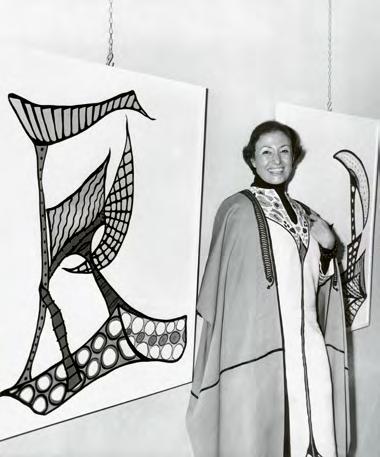
Unknown, Huguette Caland at the opening of 16 pittori libanesi a Roma, Delta Gallery, Rome, Italy, 1972
Every Dress a Catastrophe: Caland, the Kaftan, and the Fat Body in 1960s Beirut
Alessandra Amin
In 1943, Bechara El Khoury became the first president of an independent Lebanon. Like all powerful statesmen, he had paved the way to his historic position by setting various civic accomplishments into the subtler mortar of political success: social favor. His house was always full, a revolving door through which Lebanon’s upper crust breezed to mix and mingle, see and be seen. El Khoury’s only daughter, who was twelve years old at the time of his appointment, spent her whole youth as both a beneficiary of this vibrant social scene and an object of its Cerberean gaze. Growing up at the center of Beirut’s Maronite Catholic elite, Huguette was naturally subject to the scrutiny that pins every daughter of a highly visible family to her place on the cultural map. She was also fat. “When I was twelve years old, my weight was frightening,” she recalls. “I could not walk in the street without hearing: ‘What a pity, she is so fat, why doesn’t she lose weight?’”1
The girl who would become the artist Huguette Caland did lose weight, and gain it back, and so on and so forth in the Sisyphean pursuit of thinness that remains a ritual of modern culture and the backbone of a global weight loss industry worth over $198 billion. 2
1 Huguette Caland, in conversation with Hanan al-Shaykh, translated from Arabic by Brigitte Caland and Louise Gallorini and edited from a conversation that aired on Télé-Liban in October 1974, in Huguette Caland: Everything Takes the Shape of a Person, 1970–78 (Milan: Skira, 2018), 180.
2 Amount in USD is equivalent to approximately €183 billion at time of writing. This number reflects the average of the highest and lowest valuations publicly available from reputable market research firms, whose reports vary in methodology and definition of the “weight loss” or “weight
Her designation as a fat woman endured throughout, becoming a fixture in even cursory biographical accounts as implicit (or, sometimes, explicit) proof of a ravenous hunger for all of life’s pleasures. Known as a bonne vivante and oft depicted as perennially cheerful, Caland was also open about her extramarital affairs, famously providing her lover with a room in the home she still shared with her husband, Paul. Desired though she was, she remained “extremely self-conscious” about her body, wearing long, flowing kaftans of her own design to conceal its unruly curves. 3 Indeed, Caland’s public image embodied both edges of the conflicting expectations with which society burdens fat, femme-coded people: humorous and self-effacing on the one hand, and on the other, possessed of a sexuality at the brink of obscenity. Her creative output, too, juggles these demands. In some of her best-known paintings, a vast color field gives way to what might be termed a “surprise butt,” pink cheeks emerging at the edge of the canvas to the delight of a chuckling viewer (p. 113). Others are effervescently erotic and openly depict partners other than Paul, whom she never legally divorced, in joyful defiance of sociosexual taboos. More than a biographical detail, then, Caland’s weight is a shifting set of conditions that shaped her work and its reception. The fly in the ointment of this assessment, perhaps invisible to the very thin, is the fact of Caland’s middling fatness. Descriptors like “extremely fat,” “massive,” and “very overweight” present a carnivalesque image of the artist’s size in virtually every article written about her, but she was, at her largest, in the borderlands of what today’s fat activists would call “small fat.”4 Much writing about
management” industries. Data analysts at San Francisco, CA–based firm Grand View Research report that the global weight management market size was valued at $142.58 billion in 2022. “Weight Management Market Size, Share & Trends Analysis Report by Function, by Region, and Segment Forecasts, 2023–2030,” report code GVR-1-68038-410-9, 2023. Data analysts at the Wellesley, MA, firm BCC Research report that the global market for weight loss products and services was worth $254.9 billion in 2021 “Global Weight Loss Products and Services Market,” report code FOD027D, August 2021.
3 John Carswell, “Huguette,” in Huguette Caland: Works, 1964–2012 (Beirut: Solidere, 2012), 13.
4 The three descriptors listed here were taken respectively from Kaelen Wilson-Goldie, “‘Liberated, Rebellious and Historically Consequential’: Remembering Huguette Caland (1931–2019),” Frieze, September 27, 2019;
Alessandra Amin
Caland—including some obituaries—mentions with lupine fascination that she once reached a staggering two hundred pounds, meaning that at her highest weight she was all of forty pounds heavier than the average middle-aged Lebanese woman. 5 Nevertheless, Caland lived, as we live now, in a world that prefers its women portably, breakably petite, and her life was indelibly marked by her deviation from an impossible standard of beauty. The extent to which her size defined her, even in the valleys of her fluctuating weight, is an indictment not of her body but of society’s (literally) narrow allowances for women’s very existence, of the small, ungenerous plots of space we can acceptably take up.
Renowned as a champion of abundance, Caland had also to grapple with this meagerness. This essay will explore some of the ways in which she did so, looking at the underexamined years before the artist’s famed departure for Paris in 1970. During the difficult but generative 1960s, Caland embarked on a career as a painter, coestablished the Inaash organization to preserve traditional Palestinian embroidery techniques while creating employment opportunities for refugee women, and remade herself in pursuit of authenticity while grieving the loss of her father. At the center of all of these projects was her sudden and total embrace of the kaftan. Her love for the loose garment is often trivialized as a fun quirk of hers, attributed to a need to hide her body or, less frequently, to a desire to reclaim Arabness. I understand the kaftan as a lynchpin in
an oft reprinted comment from Afaf Zurayk quoted in Jason Farago’s February 14, 2018, New York Times review of Caland’s 2018 survey show at the Institute of Arab and Islamic Art; and Carswell, “Huguette.” The “fat spectrum” to which the term “small fat” belongs is a tool used by members of the fat acceptance movement to distinguish among general body sizes in order to better address their differing experiences of social privilege and stigma.
5 For an example of such obituaries, see Katharine Q. Seelye, “Huguette Caland, 88, Dies; Celebrated Freedom in Art and Life,” September 30, 2019, New York Times . According to a peer-reviewed study published in 2012 by researchers at the American University of Beirut (AUB), the average weight of a Lebanese woman between forty and fifty-nine years old from 1997 to 2009 was 72.82 kg / 160.54 lb. with a confidence interval of 15.09 kg / 33.27 lb. Lara Nasreddine et al., “Trends in Overweight and Obesity in Lebanon: Evidence from Two National Cross-Sectional Surveys (1997 and 2009).” BMC Public Health, September 17, 2012.
Caland’s negotiation of social and physical constraints, bound up in her exploration of the relationships between the corporeal and its immediate environment. Having grown up in a body for which “every dress was a catastrophe,” Caland well understood the multifaceted roles that clothing plays in mediating these relationships, and the 1960s witnessed the artist’s fascination with fashion seep into every genre of her creative output. 6
The 1960s were also, of course, the golden hour that preceded a long, dark night in the “Paris of the Middle East.” This popular, problematic conceptualization of midcentury Beirut emphasizes its dazzling cosmopolitanism, the liberal efflorescence of vibrant, overlapping microcultures to which people from all walks of life could purportedly stake claim. As a fat, wealthy, Christian woman attending elite university classes in a flowing abaya, Huguette Caland simultaneously exemplified the incongruities at the heart of Beirut’s cosmopolitanism and found herself straining against its limits. Indeed, Beirut was not a neutral backdrop for the artist’s reflections on the body in the world but an active participant in shaping them, saddling Caland’s weight and sartorial choices with the particular baggage of its postcolonial politics. The artist herself alludes to Beirut’s classed and religiously coded relationships with women’s bodies in charting her own experiences of corporeality through the coordinates of its sectarian cartography. “In the Muslim area, they blessed my body,” she recalls. “In the Christian area, I was fat.” 7
Caland’s offhand comment opens onto the long history of colonial entanglements and internecine conflicts that created Lebanon’s infamous sectarian divisions, ultimately fueling fifteen years of civil war. This history is far too complex to adequately unpack here, but a basic understanding of the differing relationships of Christians and Muslims to “Westernness” and its emissaries sheds light on the unexpected depths of Caland’s observation. Broadly speaking, Christians, and especially Maronites, have historically allied themselves with Western interests in the region, while Muslims have coalesced
6 Caland, in conversation with al-Shaykh, 181.
7 Quoted in Anne-Marie O’Connor, “Her Magical World,” Los Angeles Times, June 19, 2003, F10.
Alessandra Amin
around an Arabist, anti-imperial sociopolitical orientation. This dynamic, fostered and exploited by the French, enabled Christians to amass disproportionate political and economic influence that endures to this day. It also engendered a cultural affiliation that exceeds the bounds of political expediency. In its most extreme form, Maronite affinity with the West rejects Arabness altogether. “Phoenicianism,” like Mussolini’s romanità, anchors a conservative political platform in the celebration of a mythical, ancient heritage; it also asserts that the “true” (i.e., Christian) Lebanese descend directly from Europeans. Notwithstanding its dubious genealogical claims, the phenomenon of Phoenicianism points to a broader tendency among Maronites to define themselves as culturally, if not ethnically, distinct from their Muslim neighbors in ways that align with Western notions of “civility” and “modernity.”
Such fraught notions are integral to the intersection between Lebanon’s colonial past and Caland’s experience of weight stigma. Historian Christopher E. Forth argues that imperialist narratives in nineteenth-century Britain and France plotted fatness “along a temporal curve from ‘primitive’ corpulence to ‘civilized’ moderation,” and that by the early twentieth century an entrenched disdain for fat bodies was buoyed in the West by the belief that their acceptance was an inherently “savage” civilizational trait. 8 American studies scholar Athia N. Choudhury points out that this framework has continued to color the way we understand the history of fatness as a social phenomenon: the general Western trend away from valuing fatness (as a marker of vitality and wealth) toward valuing thinness (as an emblem of moral fortitude and logically minded restraint) becomes a map of evolutionary progress against which other cultures are measured. 9 In other words, imperial ideology insists that both being thin and desiring thinness are attributes of an upstanding modern subject, while possessing and/or desiring “excess” fat denotes moral and intellectual backwardness.
8 Christopher E. Forth, “Fat, Desire, and Disgust in the Colonial Imagination,” History Workshop Journal, no. 73 (Spring 2012): 215.
9 Athia N. Choudhury, “The Making of the American Calorie and the Metabolic Metrics of Empire,” Journal of Transnational American Studies 13, no. 1 (2022): 15–44.
In many ways, the relationship thus constituted between fatness and thinness mirrors that between “East” and “West” in the colonial imagination. Thinness, here, is associated with Western modernity and its attendant values of discipline, industriousness, and rationality, while its inverse becomes a symbol of the indolence, decadence, and unchecked sensuality that supposedly mires the East in the Middle Ages. Across the Islamic world, the same imperial logic forced a sharp division between Western dress and such traditional garments as the hijab and the abaya, assigning the former to the realm of the rational while condemning the latter as paradigmatic of a retrograde worldview.10 In postindependence Lebanon, Muslims faced the legacy of a colonial enterprise that pointedly denigrated their customs, inclusive of religious dress; Maronites, perched since the nineteenth century at the threshold of Europeanness, were naturally more receptive to the beauty standards imported by their erstwhile colonizers—and the moralizing discourses that came along with them. Fad diets and formfitting clothing were de rigueur for Caland’s family’s milieu, a ruling class that derived its legitimacy, in part, from its proximity to Europe.
In such a charged context, it is little wonder that the artist characterizes her decision to begin wearing abayas and kaftans as one that she “knew would change [her] whole life.” 11 She made this decision in 1964, just as the miniskirt was becoming a frequent fixture on the streets of London and Paris, during the immediate aftermath of her father’s death. Though Caland had been close to
10 Discourse that presents traditional women’s clothing, especially the hijab, as antithetical to “modernity” has traversed the region since the late nineteenth century; an early, influential example is The Liberation of Women (1899) by Egyptian jurist and philosopher Qasim Amin. Frantz Fanon’s “Algeria Unveiled” (in A Dying Colonialism , 1959) famously examines the role of this attitude in French colonial oppression of Algeria, as well as its exploitation by Algerian women working for the resistance. One particularly potent object of this discourse in Lebanon was women’s higher education; as noted by Betty S. Anderson in The American University of Beirut: Arab Nationalism and Liberal Education (Austin: University of Texas Press, 2011), administrators in the 1930s and 1940s described the “evolution” or “modernization” of AUB’s first classes of female students according to a decline in veiling (see 99–107).
11 Caland, in conversation with al-Shaykh, 181. She reiterates this point almost verbatim in O’Connor, “Her Magical World.”
Alessandra Amin
him and was grief-stricken at his loss, she also understood his death as the end of an era and felt more “free to live [her] life” in the wake of his passing than ever before.12 In one fell swoop, she got rid of her constrictive Western clothing and replaced it with the robes that would soon become her trademark. The artist, who was thirty-three years old at the time, also started school at the American University of Beirut, where her new look sparked friction with her peers. “At the American University [. . .] I suffered, the first year,” she laments, noting that her abaya was alienating. “There were no hippies, no one had broken the rules of fashion.”
The fact that hippies, not conservative Muslim women, constitute Caland’s point of reference in discussing the abaya indicates the limited scope of her social circles but also her perception of her change in style as a countercultural act that defied the “rules of fashion.” Indeed, this period of Caland’s life was in many ways one of defiance, or rather of shedding the strictures that had molded it while her parents were alive. As part of this rebirth, she turned to painting. Though she had shown a talent for the visual arts as a child and had taken lessons as a hobbyist, it was not until her father died that she felt able to pursue it professionally. Less than a month after the funeral, she expressed her grief with hypnotic intensity in the massive Soleil rouge / Cancer (Red Sun / Cancer, fig. 1), which she initially envisioned as a depiction of the cancer that had killed the former president but which evolved as she painted into a mesmerizing crimson solar flare.
In an untitled oil painting from 1968 (p. 72), a kaleidoscopic patchwork of colors and textures surrounds a blank white shape. The colored forms, each bordered in thick black outlines, appear to grow larger toward the edges of the canvas, giving viewers a disoriented, shifting sense of perspective. Are they radiating out from the white at the center, or closing in on it? Are we looking down into a tunnel or up through an opening at the crown of a domed, tentlike structure, watching the sky recede from our view? This vacillation creates a sense of almost psychedelic claustrophobia; we’re Alice down the rabbit hole, unsure of whether the light is moving toward
12 Caland, in conversation with al-Shaykh, 181.
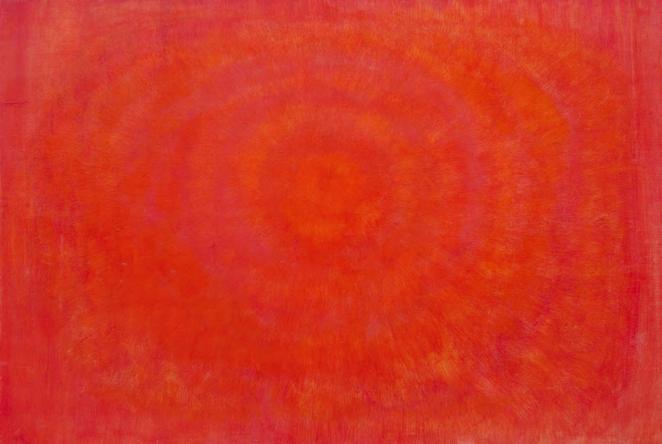
Fig. 1: Soleil rouge / Cancer, 1964
Alessandra Amin
us or away from us, not knowing if our surroundings will expand or contract. The patches themselves vibrate with different colors and patterns, lime greens and fuchsias vying against diamonds, stripes, and polka dots for primacy in the crowded composition. They evoke scraps of fabric, especially as many are “stitched” together with roughly even horizontal lines, as though the bold borders that separate one from another are seams that have started to split.
The white of the ground peeks out from between these stitches, taking on a marshmallowy softness against the patches’ intense hues and the buzz of ornamentation. It’s unclear whether the snowy surface does this in the spirit of willful defiance or blinking exposure, but in either case, it appears in opposition to the colorful “fabric.” The soft white strains against that which seeks to contain or obscure it, while the patchwork envelops and imposes, sharp corners poking into the white and pinching its central form into a narrow, angular shape. We see the same antagonistic dynamic in a painting of nearly identical dimensions, which Caland also created in 1968. Kaslik (p. 73), named after the coastal town near Jbeil where Caland maintained a studio in a family home, is in some ways the inverse of the untitled work. Its colorful patches are even more evocative of fabric, with vertical strips echoing black lace trim and neat rows of circles conjuring grommets, but they are grouped in the center of the composition, nearly surrounded by white. As in the untitled painting, there is palpable tension between the positive and negative space of the composition, but this time it is the cloudlike, billowing white that threatens to engulf the busy prints and vibrant colors of the center.
Caland’s 1968 paintings are enchanting works of nonrepresentational art, and it is perhaps a bit pedestrian to interpret them as staging a battle between fabric and flesh. The idea is, in any case, tenacious: one begins to imagine the pressure of a garment stretching reluctantly against one’s skin, the dig of a belt at one’s waist, the overflow of a body too large and too soft for a given container. Of course, such sensations lend themselves eagerly to metaphor, but to vault immediately over the corporeal in pursuit of the theoretical is the luxury of a body that always fits where it’s supposed to. Huguette Caland’s body did not always fit where it was
supposed to, and her experience of outgrowing the space allotted to it by such metrics as ready-to-wear clothing was clearly a formative one. Being overweight “created a problem between me and society because I was rejected at a time when fashion was about skinny and tall girls,” the artist recalls. “It was difficult for sure. I never used to find something that fit, [. . .] every time I went shopping with or without my mother, I suffered.”13
As Caland coveted beautiful garments that would not zip or button, the discomfort of ill-fitting clothing became synonymous with the social alienation it entailed. The extent of this alienation should not be underestimated; today, in a market that has drastically improved since the artist’s girlhood shopping trips, women who wear straight sizes can have access to roughly forty-three times the number of fashion choices available to their plus-size friends.14 Even with the formidable muscle of Beirut’s best tailors at her service, Caland faced serious obstacles to sartorial self-expression. Yet the “fabric” in Kaslik and its counterpart is lovingly rendered, joyful in a way that contradicts its role as the body’s opponent; in it, we see the signature of a woman who continued to “dream of dresses” despite—or, perhaps, because of—the many barriers to her pursuit of fashion. “Being a fat teen meant becoming a fashion alchemist,” notes author Aubrey Gordon, “a miracle-worker who made something out of nothing.”15 Though reflecting on her own experience of buying clothing as an adolescent in late 1990s America, Gordon’s formulation resonates here. In the kaftan, Caland drew from an alchemical fusion of local abayas, international counterculture, and her own troubled history with clothing to make space for herself where none previously existed.
This act of space making seems integral to the kaftan, at least as it figured in Caland’s life, but is often overshadowed by the garment’s vaunted modesty. Surely, this modesty has its benefits, as any item of clothing that hides the shape of a fat person’s body
13 Caland, in conversation with al-Shaykh, 181.
14 See Hilary George-Parkin’s feature “Size, by the Numbers” in Racked (now The Goods by Vox), published online June 5, 2018.
15 Aubrey Gordon (writing under the pseudonym Your Fat Friend), “When Clothing Is More Than Fashion,” Medium , January 29, 2020.
Alessandra Amin
becomes a “kind of armor” that protects the wearer from “an endless stream of unwelcome editorializing.”16 Caland herself expressed her appreciation for its ability to “conceal the body.” Still, I contend that the focus on concealment is a thin person’s way of thinking about a loose garment. A thin person fits into public space—and the clothing intended to be worn therein—without physical constriction, without feeling her flesh resist the bounds of its environment, without feeling the hostility of that environment pressed tight against her skin. Clothing that skims the body rather than wrestling it out of its natural shape is a type of freedom insofar as it asks nothing of the body except to exist. It does not even suggest the necessity of change, which for a fat person, and a fat woman especially, is a rare mercy. The pitying gaze of a nosy neighbor, the reddening dig of a stretching waistband, the intrusion of an unyielding armrest at the theater— everywhere she feels, the fat woman finds a demand to shrink herself. In a kaftan, the wearer sidesteps the intrusions of the environment upon a body for whom it is never designed, able at last to expand unencumbered into whatever space she needs.
If the vastness of the kaftan is at odds with the tension Caland expresses in the works we have seen so far, we find it echoed in a self-portrait she also created in 1968 (fig. 2). In this self-portrait, the artist renders her own face in bold, inky lines of black and ochre oil paint on a bright white background. The image is a basic outline
16 Gordon, “When Clothing.”
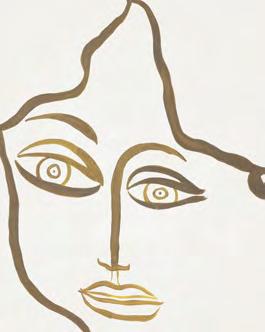
of a mouth, nose, eyes, and eyebrows, framed by a hairline and jaw that extend beyond the bounds of the canvas. It is a gestural, twodimensional painting composed with ample negative space in a very limited color palette, but despite its simplicity it cannot be called sparse. Caland’s linework is loose and lush, its gently fluctuating width and variegated hue adding to the liquidity of the diluted paint. The facial features take on a fluid quality of their own, with lips parted by undulating lines and giant eyes whose heavy lids show subtle, pooling layers of wash. At a modest 91 × 73 cm, the painting is somehow larger than life: the lines contouring Caland’s face spill over the edges of the canvas like rivers reaching the borders of a map, gesturing to their own unfathomable extension. The work, like the kaftan, is a space of expansion and flow, a gloriously unstructured home for a body to which the viewer’s access is limited. It is a portrait of a woman who is finally able, if only momentarily, to be soft and immense in all imaginable ways.
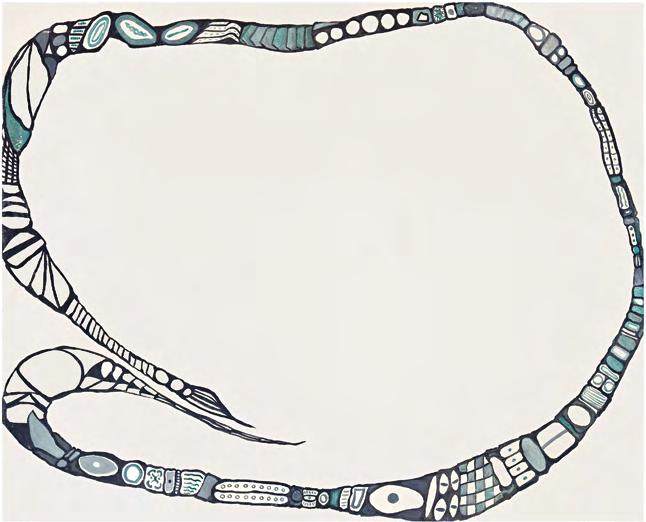
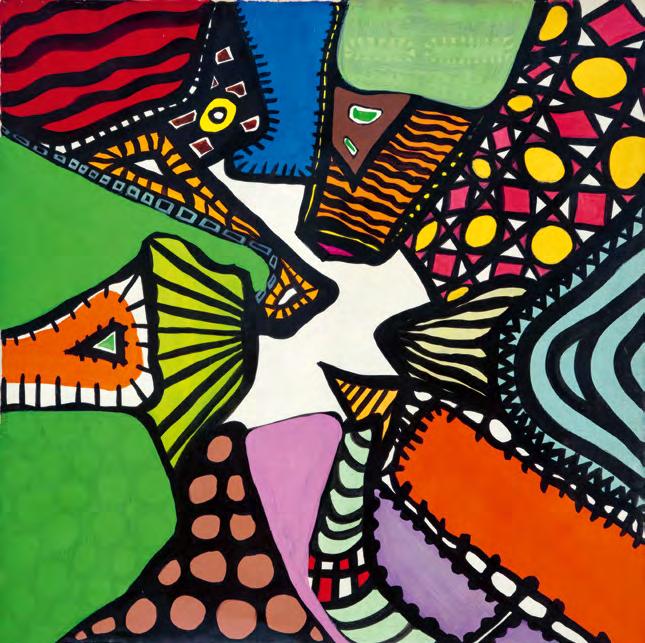
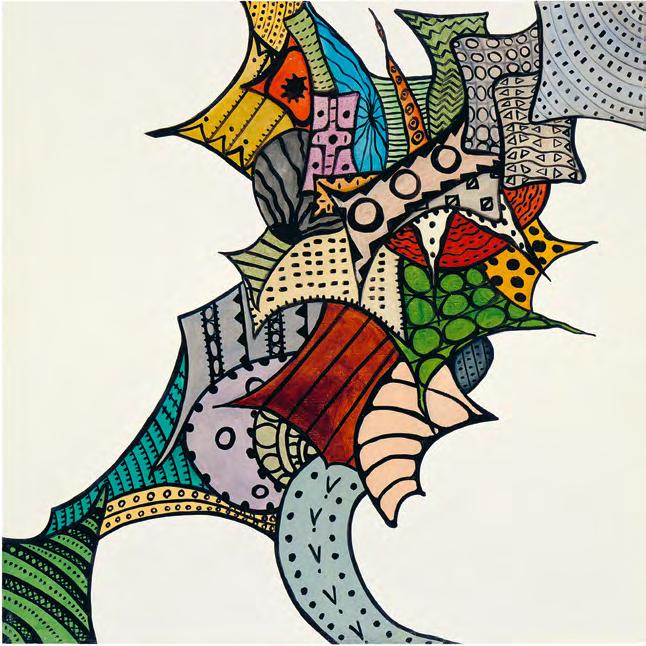
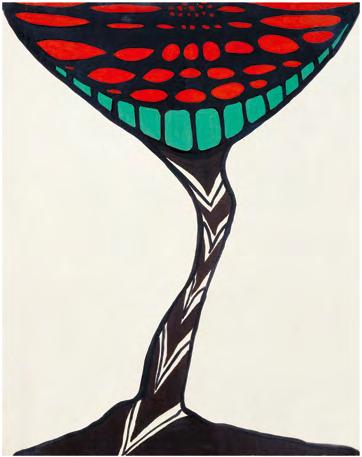
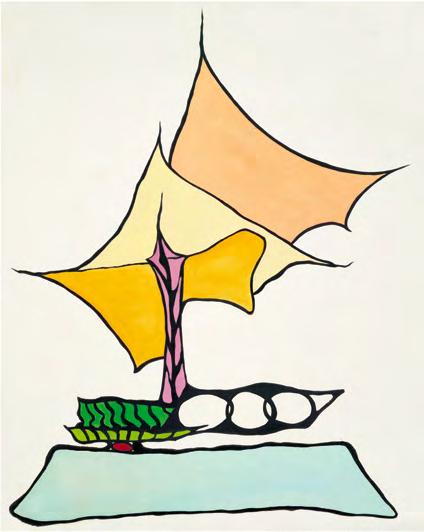
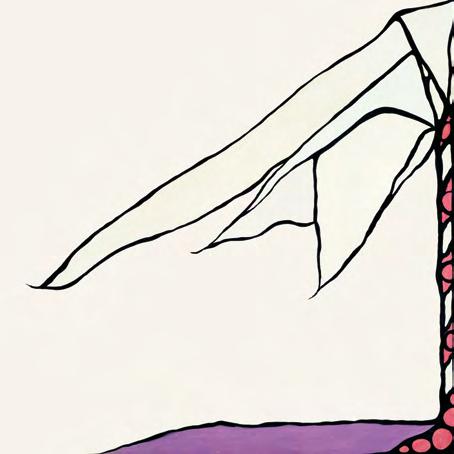
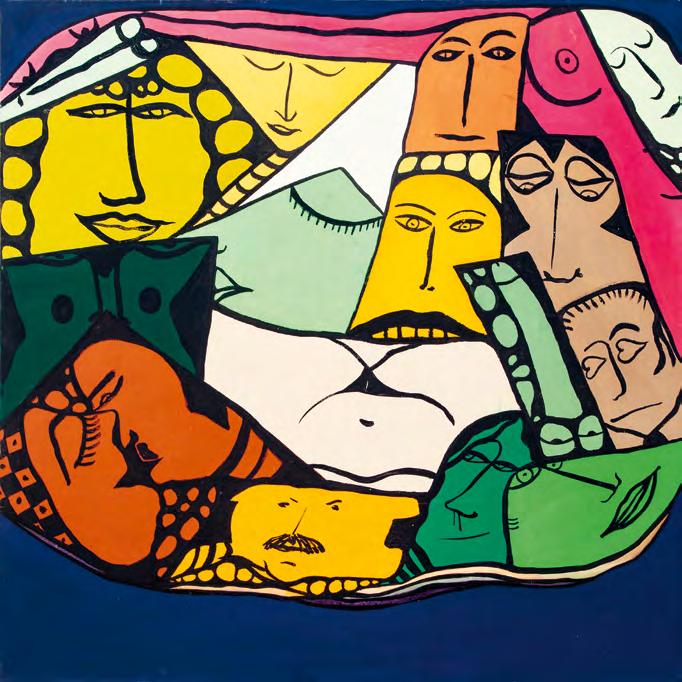
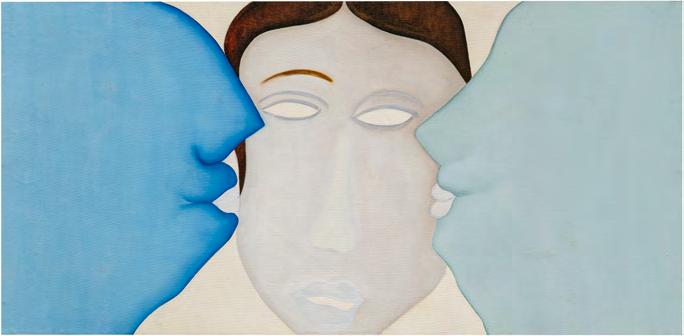
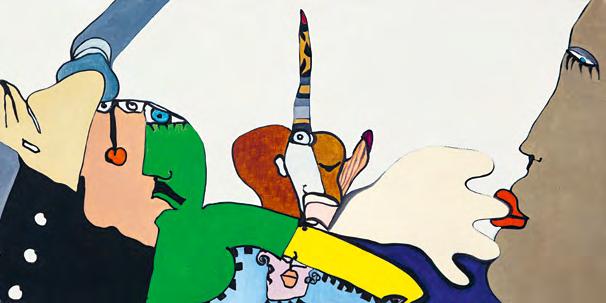
Moi, Moustafa et Paul, 1970 Enlève ton doigt, 1971
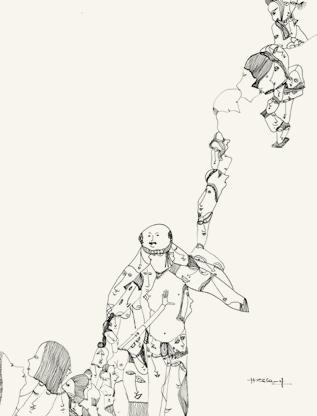
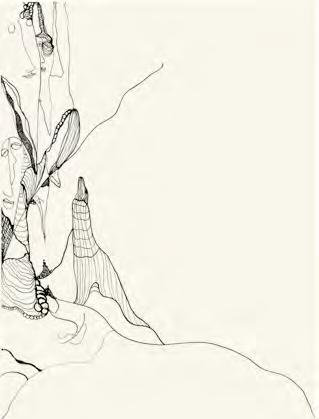
Moustafa, poids et haltères, 1970
Sur la musique de François Bayle, 1971
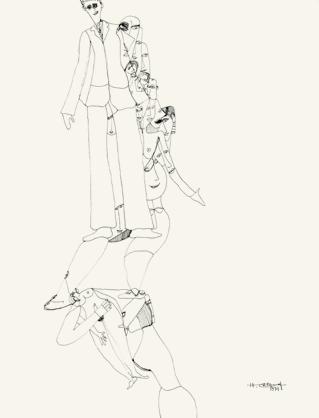
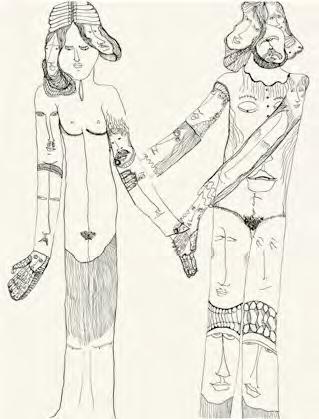
Paul, 1971
1er dessin, encre de Chine, hiver, 1973 Alpinisme, 1973
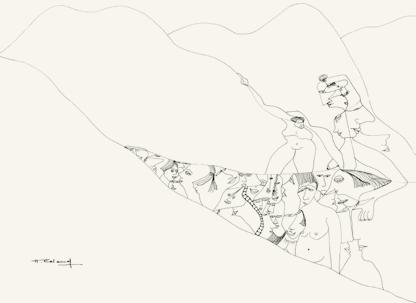
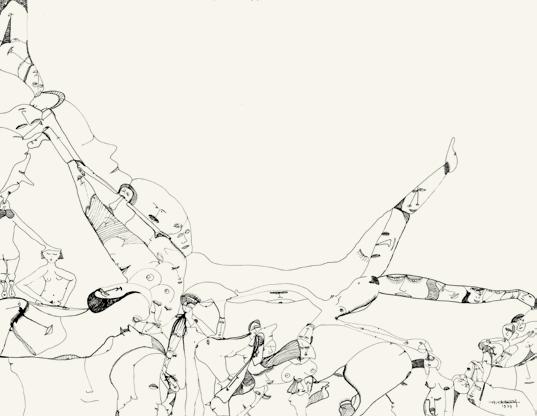
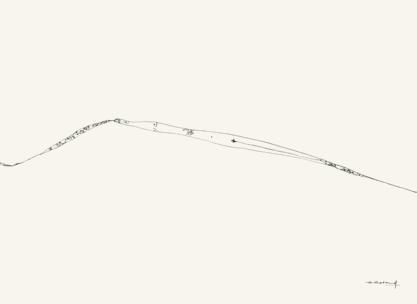
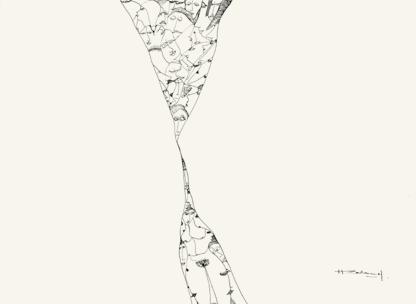
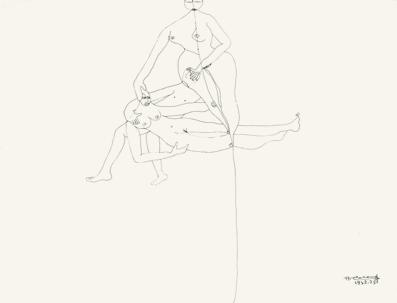
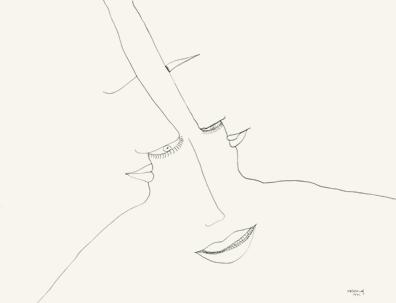
raide, 1971
Corde
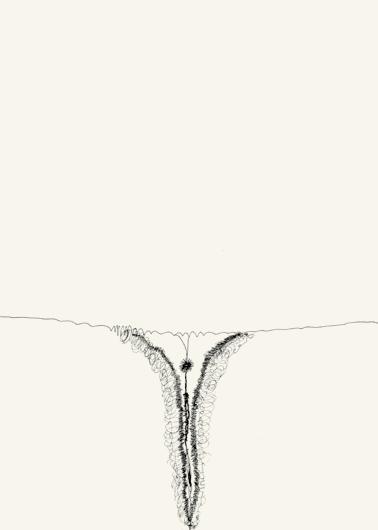
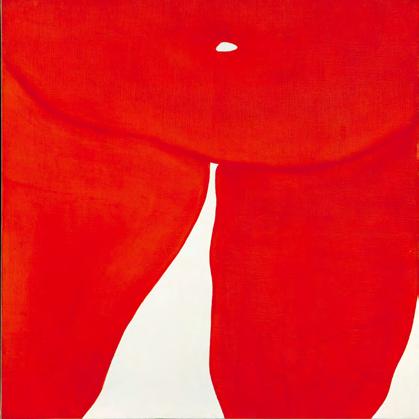
Fig. 1: Red II, 1974
Bien dans sa peau: Huguette Caland’s Bribes de corps
Rachel Haidu
Thus, the structural paradox on which Gauguin’s brand of primitivism depends is that one leaves home to discover one’s real self; the journey out, as writers such as Conrad have insisted, is, in fact, always a journey in.1
—Abigail Solomon-Godeau
[This painting] belongs to that aspect of the present age that will dominate the future. It is not a tri-dimensional space, it is the space of a sphere, a volume seen from the inside, because the further “out” we will go, the further “in” we will find ourselves. 2
—Etel Adnan
These two epigraphs point to a problem that characterizes the whole of modernism. To journey “out”—to move away from one’s place of origin—appears to be the only path to self-discovery. So often, that path participates in the grooving of colonial trajectories. 3 Propelled
1 Abigail Solomon-Godeau, “Going Native: Paul Gauguin and the Invention of Primitivist Modernism,” in Modern Art and Society: An Anthology of Social and Multicultural Readings, ed. Maurice Berger (New York: HarperCollins, 1994), 75. First published in Art in America 77 (July 1989): 118–29.
2 Etel Adnan, “Journey to Mount Tamalpais” (1986), in To Look at the Sea Is to Become What One Is: An Etel Adnan Reader, ed. Thom Donovan and Brandon Shimoda (Brooklyn, NY: Nightboat Books, 2014), 1:335.
3 The art historian Stephen Eisenman further clarifies the terms of Gauguin’s voyage, quoting from the painter himself: “In Tahiti, Gauguin sought to indulge fully his primitivist longing to ‘go back, far back . . . as far back as the dada from my childhood, the good old wooden horse.’” Stephen Eisenman, “Gauguin and Symbolism in Tahiti,” in Nineteenth Century Art: A Critical History, ed. Stephen Eisenman (New York: Thames and Hudson, 1994), 329.
first to the remote, distinctly fetishized shores of Brittany, and then to Tahiti, Gauguin knew he was in search of an artistic modernism that Paris, with its surfeit of painters and poets, was too suffocating to promote. And he was right. Yet, notoriously, his “journey out” that was meant to be a “journey in” could not escape imperial realities and literally illustrated the extractivist, misogynist, and racist premises of early twentieth-century thought.
By the midcentury, however, the scientific reinvention of space-time had opened up new possibilities. Thus, when the painter and writer Etel Adnan, born in Beirut the year after Lebanon won its independence, writes about a recent painting by her friend Ann O’Hanlon, she sketches a potential response to Gauguin’s trite (if generative) notion of escape. Her idea of “volume seen from the inside” reimagines space itself in a manner that permits a new idea of self-discovery, one outside the conventional three dimensions. And, notably, outside of both the individuated self and the (imperialist) archives that record its movements.
For in her reimagination of a “journey out,” Adnan names a “we”: “The “further ‘out’ we go, the further ‘in’ we will find ourselves.” That “we,” that collective self, effects an assertion regarding historical time: in O’Hanlon’s painting, Adnan claims, one could perceive “that aspect of the present age that will dominate the future.” Perhaps we can see these novel aspects of Adnan’s thought as being conjoined. The journey “out” no longer takes place inside a simple Euclidian space, and the self initiating that journey is no longer individuated. Moreover, as becomes clear when we understand that Adnan’s reflections regard the intimate conversation between an oil painting and a black granite sculpture (made by O’Hanlon’s husband), whereas previously, such journeys out/in seem destined to take place on the allegedly human scale of geopolitical history, Adnan perceives their alternatives taking place on another scale altogether. 4
4 In the lines just before this quotation, Adnan refers to a large work in black granite that O’Hanlon’s husband, Dick, had just installed: “A few days before the night at Walnut Creek, I had the occasion of looking carefully at one of Ann’s latest paintings: it is a large canvas on which Ann created the new space we live in. She did the counterpart of the granite work: hers also belong to that aspect of the present age that will dominate the future.” Adnan, To Look, 1:335.
Rachel Haidu
The “present age that will dominate the future,” which sees past three dimensions, takes a decidedly decolonial turn when we emphasize Adnan’s reflections, elsewhere, on her place of origin. 5 These other temporalities that lie between, around, and below histories of human migration are the ones that allow what Ann Laura Stoler describes as imperial “duress” to perdure: “the hardened, tenacious qualities of colonial effects; their extended protracted temporalities, and not least, their durable, if sometimes intangible constraints and confinements.”6 But perhaps they also hold—at least for the painter of Mount Tamalpais—the escape paths of precisely such colonial effects. In other words, perhaps the time of black granite and oil paint is the time of escape. Still, one might ask: Where and how do such temporalities intervene in how we consider the journey out/in? And where, past the aesthetic conversation to which Adnan has borne witness, can they be made visible? How do they take aesthetic form?
Huguette Caland, born in 1931 in Beirut, would finish her life in her home city, but only after decades of journeying “out.” Living and working primarily in Paris and California, the daughter of Lebanon’s first postindependence president maintained the kinds of intricate relationships to places, languages, and identification systems that are common to many émigrés. To start with: to be given the name “Huguette El Khoury” was to be born, she claimed, a paradox.7 In its conventional (if unusual, and hyperfeminine) Frenchness, it indexed her parents’ cosmopolitan desires. 8 As Caland herself explains,
5 Note, for example, these lines from “Jebu”: “Jebu shall return to distribute the land / to the land / to conquer the moon / with no armor / to pull the sun out / of its orbit / and transform the ecliptic / of the human race [. . .] Jebu: [. . .] You are coming back / after the latest of the last—Christ and / Mohammad-astronaut—carried by the antennas / of our radios.” Adnan, “Jebu,” in To Look, 24–25.
6 Ann Laura Stoler, Duress: Imperial Durabilities in Our Times (Durham, NC: Duke University Press, 2016), 7.
7 “Toute ma vie a é été paradoxale, et le nom inclus” (My entire life has been paradoxical, and that includes my name). Huguette Caland, in Lettres à Huguette, directed by Fouad Elkoury (2021).
8 “Cosmopolitanism dates at least to the Cynics of the fourth century BC, who first coined the expression cosmopolitan, ‘citizen of the cosmos.’ The
however, her given name could not even be written in Arabic. 9 That is, her own name made her literally illegible in her home country’s official language. Rather than reject or change that name, however, Huguette’s first steps once she reached the age of majority amended her identity as if to “match” or make sense of it.10 Her marriage to Paul Caland initiated the first of many routes “out” of the paradox into which she was named.
And yet. As she must have known already, when she married at the ripe age of twenty, the act of nomenclature is a surreally primordial act, even more so in a colonial or formerly colonial territory. It gives birth not only to a person but to an identity that cannot be divorced from empire and its relentless empiricisms. This is only infinitely truer in the Lebanese system that was coming into being just as Caland was.11 The anthropologist Maya Mikdashi describes how, in the Lebanese state (which currently comprises eighteen Muslim, Christian, and Jewish sects), “sex and sect [become] themselves biopolitical categories.”12 Women especially find their identities part of a political system that not only controls their rights and lives, but
formulation was meant to be paradoxical, and reflected the general Cynic skepticism toward custom and tradition. A citizen—a politeˉs —belonged to a particular polis, a city to which he or she owed loyalty. The cosmos referred to the world, not in the sense of the earth, but in the sense of the universe.” Kwame Anthony Appiah, Cosmopolitanism: Ethics in a World of Strangers (New York: Norton, 2007), xiv.
9 “On m’a appelé Huguette El Khoury. Il n’y a pas moyen d’écrire Huguette en Arabe” (I was called Huguette El Khoury. There is no way of writing Huguette in Arabic). Caland, in Lettres à Huguette.
10 “Je ris, parce que je dis que épouser Paul Caland, ça était pour me . . . pour assortir mon nom au prénom. Ce n’est pas vrai, mais en fait c’état la réalité. Il valait mieux pour Huguette être Huguette Caland que Huguette El Khoury à vie, tu es d’accord, non ?” (I laugh because I say that for me, marrying Paul Caland was . . . a way of matching my surname to my first name. That isn’t true, but in fact it was the reality. It was better for Huguette to be Huguette Caland than Huguette El Khoury for the rest of her life, don’t you think?). Caland, in Lettres à Huguette
11 “Lebanese state sovereignty came into view as a bounded entity through asserting jurisdiction over personal status courts and over the ability to define public order.” Maya Mikdashi, Sextarianism: Sovereignty, Secularism, and the State in Lebanon (Stanford: Stanford University Press, 2022), 18.
12 Mikdashi, Sextarianism , 28. Though she recognizes that sex, like gender, can be a far more complex subject, Mikdashi primarily focuses on the intersections of what we would call gender, marital status, and fixed sexual identities. Thus, “biological sex” profoundly determines individual freedoms and social structures in Lebanon.
that builds its sovereignty on and through these acts of identitarian difference.13 Thus, there is not only Huguette Caland qua Huguette Caland, but a being who is from the start subjected to the very particular Lebanese enmeshment of the sexual with the sectarian.
One of the projects one can perceive Caland—designer of kaftans and painter of her hometown coastline undertaking is the creation of a formal language that somehow refuses to leave the poles and polarities of empire intact.14 That is: while scholars like Mikdashi make us understand coloniality and gender as inextricably linked, artists such as Caland and Adnan dismantle not only the magnetism between colonizer and colonized, but even the very categories— male/female, hetero-/homosexual, fertile/infertile—that support such polarities.15 Caland might have begun her majority by addressing the illegibility or unwritability of her name, but as soon as she began to truly explore new, painterly languages, she advanced to a new set of questions. These would include how the temporalities of identity might themselves be remade. How, in other words, the temporalities of the body—that of breaths, of embraces—with which she initiates her drawing and painting practices might eventually melt into another, one that might match the durability of black granite, providing a refuge for bodies beyond her own.
Even without fully abandoning the biomorphic formal language that she developed concurrently through her drawings and kaftans, sculptures and paintings, Caland presents a time for living other than that given by the body. A fuchsia skin stretches over an inverted quatrefoil shape (Bribes de corps [Body Bits], 1973; p. 111),
13 “The recognition of religious difference is an act that both performs and amplifies secular state sovereignty.” Mikdashi, Sextarianism , 9.
14 Regarding Caland’s paintings of Lebanon’s shoreline and its relation to her ideas of the body, see Hannah Feldman, “Drawing the Routes and Roots of a Body as a City and a City as It Moves across Space and Time,” in Huguette Caland: Tête-à-Tête, ed. Joanna Ahlberg (New York: The Drawing Center, 2021), 32–53.
15 Mikdashi’s work enters a longstanding discourse that begins with Frantz Fanon and includes such key (and diverse) decolonial thinkers as Gayatri Spivak, Saidiya Hartman, Hortense Spillers, Françoise Vergès, and María Lugones. In pointing to the “fertile/infertile” pairing that might seem unexpected in this list, I am thinking not only of the extraordinary productivity that both Adnan and Caland shared in their last decades, but of how it might correspond to the notions of fertility (that would characterize land, women, and entire populations) underpinning colonial fantasies of (re)productivity.
losing the sense of hips and ass with which it started; a bone-like orb rises into a yellow sky, its hard-edged curve—not that of an earth or a retina, but perhaps a mix of both—opening an unpredicted slit (Bribes de corps, 1973; p. 106). Here we find the hardest edges delineating the most exquisitely soft inclines, cloudlike horizons and floating loads becoming interchangeable. These new aesthetic logics disrupt familiar polarities. In their place, we begin to understand how one (literally, the one Huguette Caland ) might exit the colonialist orbit. And then, using Adnan’s sliding pronouns—in which the singular viewer of a painting becomes part of an intergenerational collective refusing the terms on which we are constrained to imagine space— we begin to think of how we might exit the world of conventional weights and measures, the forces of gravity and orbital pressures that seem so indistinct from nature itself, but which so relentlessly return us to the colonial map and its archives.
Across a series of paintings in oil on linen, board, or canvas that she sometimes entitled Bribes de corps and executed in Paris from about 1973 through 1980, Caland often bisected her chosen surface directly down the middle. This bisection carries with it a biomorphic aspect, one that translates across many scales and formats. For some of these paintings are large—as large as two hundred square centimeters, or 6.5 square feet—and some are tiny, no more than 3 × 5 in., or 7.6 × 12.7 cm. Occasionally, as with the majestic Madame (Madam, 1980; p. 119)—one of several paintings entitled Madame, coupled with a Monsieur (Sir, 1980; p. 118), and accomplished at the end of her series of Bribes —the work is bisected laterally and vertically, creating symmetries and pseudosymmetries between both top and bottom, left and right. These remain, as Madame ’s title suggests, utterly humanoid, but also something else.
Others have termed the Bribes “erotic,” and not without reason. For example, a work that lets symmetry fall between a pair of legs: in Untitled, Bribes de corps (1980), an azure-blue pair of thighs opens the smallest, off-center, most devastating curved space. And indeed, Kaelen Wilson-Goldie, art critic and historian, asks: “Was it necessary for Caland to leave Lebanon and move to Paris, alone,
in order to make the work of her erotic period, which began in 1970 and became most intense in the years between 1973 and 1979?”16 Or, as writer and publisher Negar Azimi asks: “But are Caland’s works actually erotic?”—a question I agree needs to be posed.17 By way of an answer, one might go back to the beginning, a painting made as if to announce Caland’s arrival in Paris: Enlève ton doigt (Remove Your Finger, 1971; p. 78), sealing her investment in the erotic. A lipsticked mouth on the far right sucks at a kind of tan-colored, liquid, fingerlike shape; a similar suction forms in the upper left, where a blue, phallic tube disgorges/engorges a similarly tan-colored shape. Such a painting outlines two ways that we see erotics in painting: one, in the nameable parts (lips, phallus, etc.) that make up this curious landscape, about which more below; and two, in their narrated interactions (sucking, kissing, extending, stiffening, etc.).
But erotics are not the only way to understand these works, and one senses that “erotics” also names a reflex reaction to a body of work so apparently tied to the body of its maker. Instead, I think, what quickly overtakes Caland’s Bribes is a degree of abstraction away from these dynamics we have identified as erotic. What most dramatically takes the place of such erotic, part-by-part dynamics that participate in the bodily rhythms (of breath, for example) is the way that Caland spreads out a single unified shape: the near-monochrome hue of blue spread across those thighs, for example. As thighs, as monochrome shapes “like” thighs, these have many corollaries: the light-yellow pair done in acrylic in the first year of the Bribes (1973; fig. 2); a red pair, attached to a belly, in Red II (fig. 1). Yet, throughout
16 Kaelen Wilson-Goldie, “When the Line Is Left to Live on Its Own,” in Huguette Caland: Everything Takes the Shape of a Person, 1970–78, ed. Aram Moshayedi (Milan: Skira, 2017), 13.
17 Negar Azimi asks this question and begins to answer: “Undoubtedly. And yet they demystify eroticism by embracing a remarkably diverse array of bodies.” In Azimi, “Going to Pieces,” in Huguette Caland: Everything, 18.
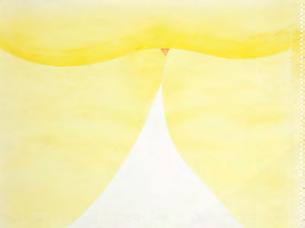
these works, Caland removes the part-by-part logic of erotics by showing a biomorphic shape as all one: all one color, sometimes with only the barest shading at an edge here or there.18 (The belly button in Red II is almost the key to the whole painting, anchoring and identifying a pair of legs and a torso.) In this, her Bribes are perhaps less invested in the “parts” that are suggested by their generic title than in the possibility of a whole, an experience of the body whose folds and masses locate the self otherwise.
Caland’s Bribes, their focus on extension and spreading, call up what the French psychoanalyst and author Didier Anzieu, who happened to be teaching and writing in Paris at the same time that Caland was painting there, called the “skin-ego”: an “experience of the surface of the body” that supports the psychical ego, models it to itself.19 For if the psyche can be said to have contents (as Freud among others argued, locating the unconscious as the most hidden germ of those contents), it must also be contained, housed; Anzieu’s argument is that that housing—the epidermis itself—is not only where we see so many neuroses and pathologies play out (he notes, for example, habits of self-mutilation that fetishize the skin). It is also a way of understanding the body that shows to the self the very idea of containment, of modulation, of relating to the outside world that the self reaches for. As “a psychical surface which links together sensations
18 “The child’s love for the mother now develops through the logic of difference Freud calls object-choice, a metonymic relation that involves substituting like objects for the originary relation of plenitude—an adult desire for women’s breasts, for example, substitutes for the infant’s desire for milk.” Lauren Berlant, Desire/Love (New York: Punctum Books, 2012), 30–31. It is the metonymic—“part for whole”—relation that I am emphasizing here, despite how complex metonymy can become. (See, for example, Constance Penley, “Introduction to ‘Metaphor/Metonymy, or the Imaginary Referent,’” Camera Obscura 3, no. 1 (Spring 1981): 6–29.
19 The philosopher Gayle Salamon, who quotes this phrase (from the translation of The Skin-Ego by Chris Turner [New Haven, CT: Yale University Press, 1989]), also expands on it helpfully: “Anzieu’s text like Freud’s, frustrates an attempt to separate body and psyche into distinct and separate registers. Instead of viewing the skin as a metaphor for the psyche, he occasionally inverts this metaphor and suggests—in a somewhat startling formulation—that the psyche itself is a metaphor for the skin. ‘What if thought were as much an affair of the skin as of the brain?’ he asks, and goes on to assert that the skin is indeed an ‘underlying base of human thought.’” Salamon, Assuming a Body: Transgender and Rhetorics of Materiality (New York: Columbia University Press, 2010), 26.
Rachel Haidu
of various kinds and makes them stand out as figures against the original background of the tactile wrapping,” the skin-ego produces a sense of itself, both as wrapping and as surface. 20 If we see the self as interactive, as a being that has both interiority and contact and exchange with a world beyond it, then we reach for models, Anzieu suggests, that function exactly as the skin does—as porous membrane, as transmitter of signals and moderator of effects.
What Anzieu’s model offers Caland’s painting is a way to understand how she moves away from logics of “the erotic” that depend on nameable, separate parts that interact with other parts. Across her Bribes we find shapes that are on the far side of the nameable: two boulder-like parts meeting en grisaille, in stony near- symmetry (Bribes de corps, 1973; p. 105). In other works, such as the famous Self-Portrait (p. 112) from 1973 that features a tiny, pinkish ass crack in one corner, this tendency to stretch a monochrome expanse over nearly an entire surface retains a winking sense of erotic humor. But ultimately, what the Bribes accomplish is most legible in some of the smaller drawings, such as an untitled work from 1973 (fig. 3). Here, symmetry is set on a diagonal, and what is magnetized is nothing more than a series of folds or bulges. They do appear drawn together, the folds’ sizes and inclines suggesting an energetic pull to the central, diagonal line. 21 Such an arrangement begs the question: What are these “parts”?
20 Didier Anzieu, The Skin-Ego, trans. Naomi Segal (London: Routledge, 2016), 112.
21 Melanie Klein coins the term “part object” to describes the parts of a body to which the infant attaches in the “pregenital” stage, according to the partial drives as described by Freud in note 22. For the value of the part object in understanding especially postwar art from Europe
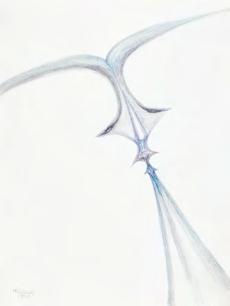
Do they even have such distinct status? After all, there is no face, no pinkish chroma delineating lips; though one might sense a kissing dynamic, one sees mere fleshly folds, mysteriously drawn together. That is, in place of the regulation of parts that we know not only from sexual pairings (where one part sucks another) but also from theories of infant sexuality that begin with “part object” attachments (where the infant suckles its mother’s breast), we find at most mirroring, as in this untitled drawing: a part relating to its identical twin. We find Caland taking the figural out of her folded and pursed bulges, exploring what it is to be energetically “drawn” (in the magnetic sense of being drawn to something, even as they indeed depend on the other notion of drawing, in the sense of Caland’s signature, confident line). Gone are the “parts” of a whole that organized paintings such as Enlève ton doigt, parts of a self seen as made up of separate parts, as combinatory and complex. In their place, shape aligning with surface and chroma; the shape as a whole extending outward, often past the edges of the canvas; increasingly, a tension that explores what it is to be drawn to without naming that magnetic pull as erotic. In other words, skin that stretches, that models as itself—not as a covering for organs, bits, or “parts.” That brings the “parts” that we understand the Bribes to be about into another determination of force, another scale of time.
One is at first perhaps hard-pressed to describe something that might look like nothing more than a fold of belly fat as a “part.” After all, such folds are not named, and indeed, across the Bribes, parts do not receive their own titles. This is worth holding on to: names, after all, are required by the kinds of systems that fantasy, erotic and otherwise, demands. That is the realm in which chains of substitution (e.g., a lover’s breast for a mother’s) so famously adapt the body for human pleasure. 22 And that is the realm one usually designates as erotic.
and the United States, see Helen Molesworth, ed., Part Object, Part Sculpture (Columbus, OH: Wexner Center for the Arts; University Park: Pennsylvania State University Press, 2005).
22 In describing “sexual instincts,” Freud initiates the system of substitution that will form not only a pillar of his own method (in which the unconscious
Rachel Haidu
Caland, for her part, loves to demonstrate such substitutive systems and play with them: one need only note her doe-eyed, penis-nosed Father (1975; p. 122), another colored-pencil-on-paper work from the decade of the Bribes. A “girl” looks out from below her penile braids, but her face is penile as well, and her submissive gaze, from above a pubic-hair sweater and below a vulvar hair part, seems utterly beholden to this identity made of conflations and, indeed, paradoxes.
The association that Caland establishes between the lips of a mouth and the urethral opening of a penis is, however, a starting point to something else. What we see when we see folds drawn or pursed together, as in the colored-pencil drawing mentioned above, are the possibilities of a body folding and refolding: the ways that fleshly folds allow the body to move—to be a less static version of itself, less bound to its “part object” origins. In other words, upon encountering them as large monochrome areas spread across the Bribes, showing us less movement than the dynamic sucking that takes place across Enlève ton doigt , we encounter a new type of pressure or force in the place of movement. In place of mere pursing-to-kiss, these folds—and the expanses that accompany them—expand or give way to new organizations of space. Thus, in another untitled drawing from 1973, a pursed mound spouts a line
endlessly repeats, albeit with objects that look or are named otherwise than their primary placeholders), but all of psychoanalytic theory’s: “In the course of things it happens again and again that individual instincts or parts of instincts turn out to be incompatible in their aims or demands with the remaining ones. [. . .] The former are then split off from this unity by the process of repression, held back at lower levels of psychical development and cut off, to begin with, from the possibility of satisfaction. If they succeed subsequently, as can so easily happen with repressed sexual instincts, in struggling through, by roundabout paths, to a direct or to a substitutive satisfaction, that event, which would in other cases have been an opportunity for pleasure, is felt by the ego as unpleasure.” Sigmund Freud, Beyond the Pleasure Principle, vol. 18 of The Standard Edition of the Complete Psychological Works of Sigmund Freud, ed. James Strachey (London: Hogarth Press, 1955), 11. One of the most famous writerly experimentations with such chains is Georges Bataille’s Histoire de l’œuil (1928), which makes explicit how an “eye” can be substituted by an egg, and how the chain, as Rosalind E. Krauss describes, sets up a “grid of [. . .] mutations” that in turn “reorganize[s] the terrain of the commonplace—of what is ‘proper’ to a given linguistic term—and to reconstruct the body’s territory—what is possible for a given organ. And to eroticize these possibilities.” Rosalind E. Krauss, The Optical Unconscious (Cambridge, MA: MIT Press, 1993), 167–68.
that cleaves upward (fig. 4). This is a fold, one whose cleavage and skin-like textures are intensely fleshlike. But seeing it as a pursing need not lead to one’s sense of a kiss; we can instead see that action pulling the shape itself into a different kind of space. There, in that other kind of space, the body—at this point, not a body of parts, but a sense of the whole—spreads out, becoming a set of topographical possibilities that no longer answer to the old polarities.
Throughout the Bribes, the kinds of hetero-polarities we find in the earlier works sink into other forms of proximity and lushness. These are works that are no longer interested in mapping erotics as it is conventionally understood—whether as an outgrowth of psychic repression (Freud) or indeed of maternal nurturing (Klein, Winnicott). 23 That is, instead of constraining us to think of “erotics” as merely those actions like kisses or fingerings or penetrations, these works proffer a different model of the body—or self—altogether. That self is more devoted to spreading and covering than to tingling or stiffening. Less reactive, more self-subsistent, this is an erotics, if it is one at all, that is far closer to the mere satisfaction of being a plane, a skin. These are dynamics composed of sometimes no more than a single line or the mere force of two parts meeting, and they convey the gravity of those sedimented bodies for whom time is operating on another scale.
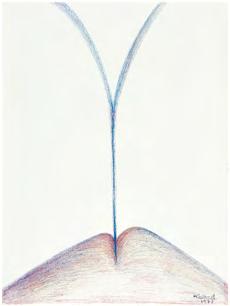
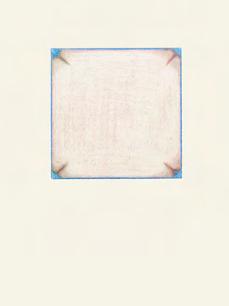
Fig. 4: Untitled, 1973
Fig. 5: Bribes de corps, 1973
23 Melanie Klein and D. W. Winnicott were British psychoanalytic theorists known for their related, albeit different, accounts of infancy, mother-child attachment, and their impacts on future selves.
Rachel Haidu
Over time sedimentary layers get compressed and twisted; great upheavals scramble acres of desire and frustration and loneliness until they become so mixed up even the most expert geologists abandon the possibility of untangling dates and seismic events. Rocks like Jenny have great waves inside of them, like the ocean, only slower. 24
—Callum Angus
The writer Callum Angus is here describing a body that has not merely transitioned between genders but between substances—flesh to tree to rock to mountain. As the title character of his story “Rock Jenny” transitions between substances, she becomes less concerned with daily, earthbound desires, and tunes in to another frequency. Caland works similarly, adopting her shapes to a broader affective range than desire and its satisfactions and frustrations. Her shapes, moving outward until they extend past the canvas, enable us to see new sorts of weightedness, new modes of sinking and falling, new tensions and motions that, in addition to taking place purely on the canvas, introduce temporalities that are unfamiliar. Stretching an ass into a four-way bilateral symmetry, as she does in that fuchsia inverted quatrefoil from 1973 makes it static, but the colored-pencil drawing that she did the same year, with its four corners in blue, makes the ass cracks vibrate slightly (fig. 5). The boulders en grisaille already described are similarly unmoving, but their yellow counterparts (Bribes de corps, 1973; p. 114) shimmer. Such shimmering is motion, albeit of a not-quite-human variety.
These new possibilities opened to the figural shape take us outside the individuating object of the archive and toward new means of mapping. Symmetry leaves the face or even the body to become a pair of yellow hillocks against a bright aqua background; two rounded drops barely part across a white center (p. 109). Shapes are mere stand-ins, here: they are not parts, let alone parts of a body. Instead, and throughout the Bribes, we find that Caland has replaced the outlining line that is so sharp and abundant in her drawings with
24 Callum Angus, A Natural History of Transition: Stories (Montreal: Metonymy Press, 2021), 25. The story “Rock Jenny” was first published in The Seventh Wave, March 2019.
the impulse to move, in painting, toward qualities. Toward what is hard and what is soft in the body: toward the weights of limbs pressing against each other, the spread of a flesh entitled to its space. Toward a self-sufficient body, in which these qualities are simply part of the body itself, not part of how bodies come together. Where color-expanse meets drawing, where what is immobilizing or static meets what is fluid or full of possibility, we find another ground for erotics. Here, chroma takes what appears “natural”—the ass crack, the urethral opening—out of this world and into another. That “other” world would be one in which, as Adnan points out, volumes are not seen from without. Caland has painted a way out of the realm where lexical systems reign, where systems of nomenclature and the taxonomies and archives that sustain them give meaning. Hers has become a world in which volumes are “seen from the inside.” There, areas are freed to flatten wherever and whenever they please, as far and wide as they will. There, “self- discovery” takes place in order to reimagine space—whether it is, as in Huguette’s practice, on paper and board and canvas, or indeed, between words on a page, between points on a map.
100
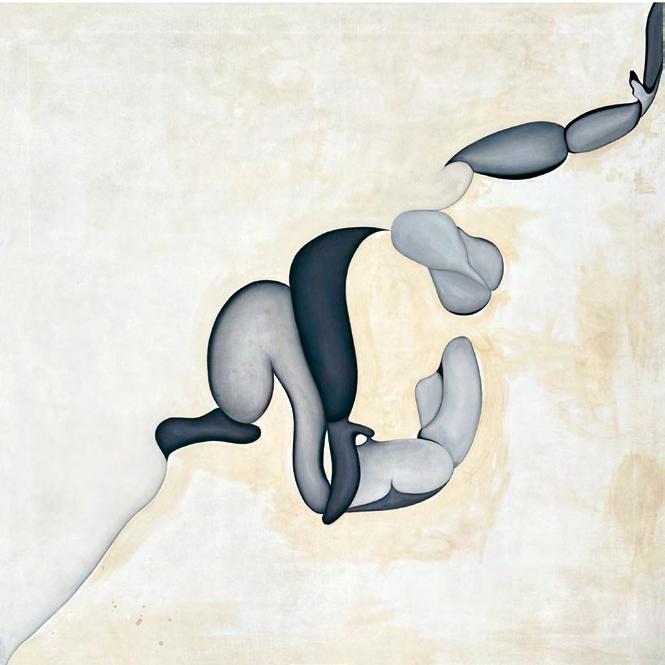
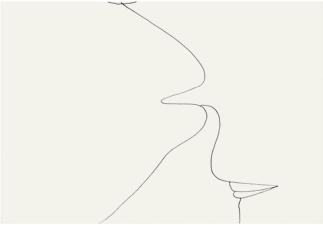
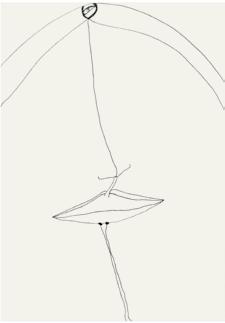
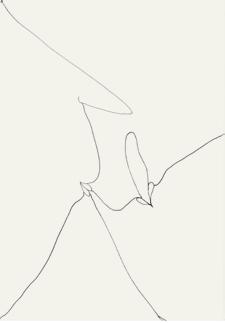
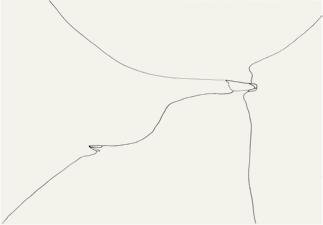
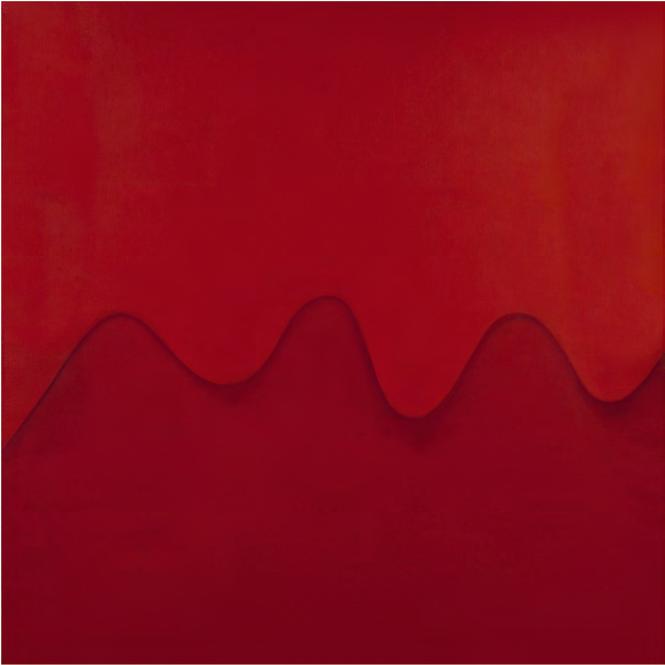
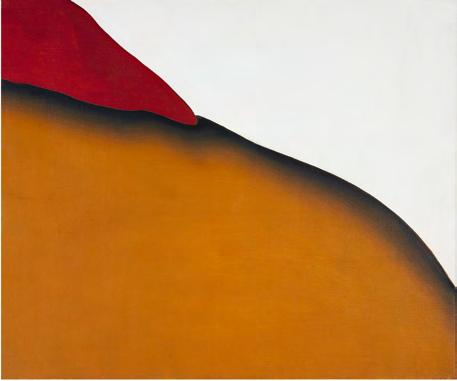
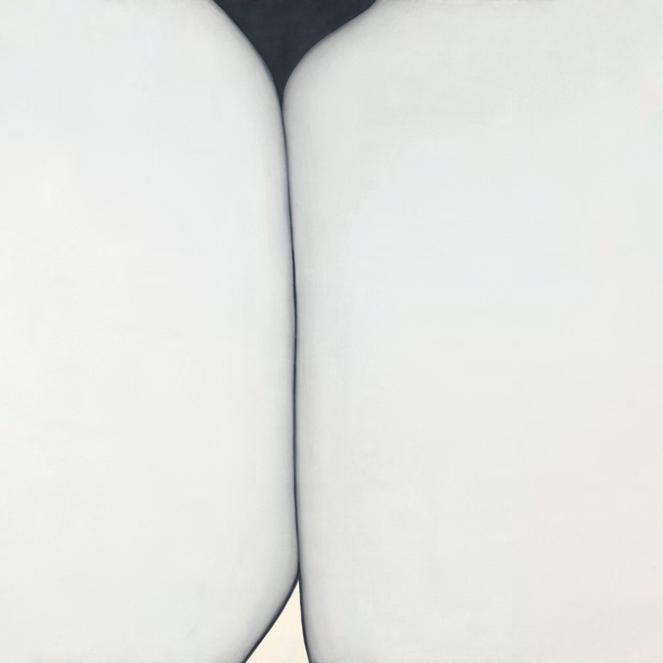
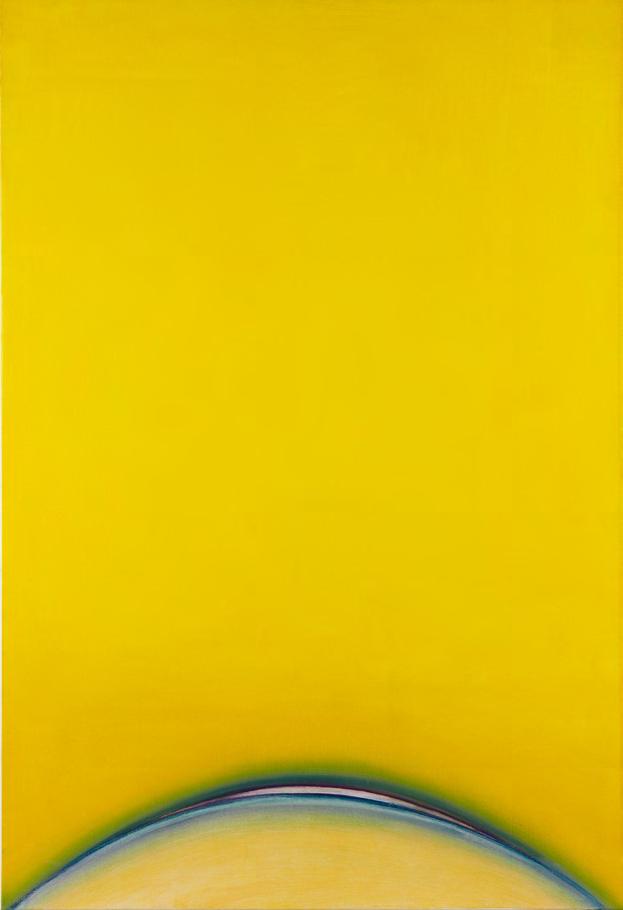
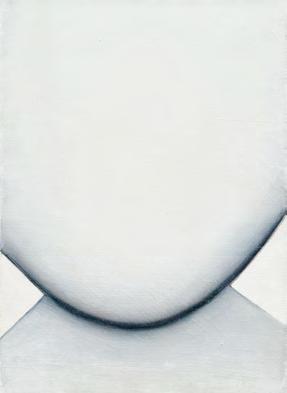
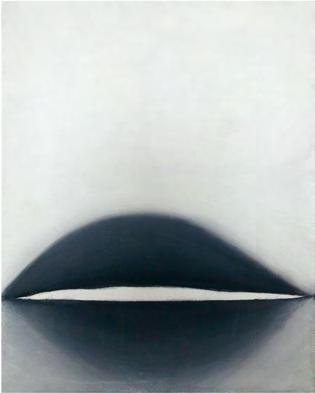
Untitled (Bribes de corps), 1973
Bribes de corps, 1973
Bribes de corps, 1973
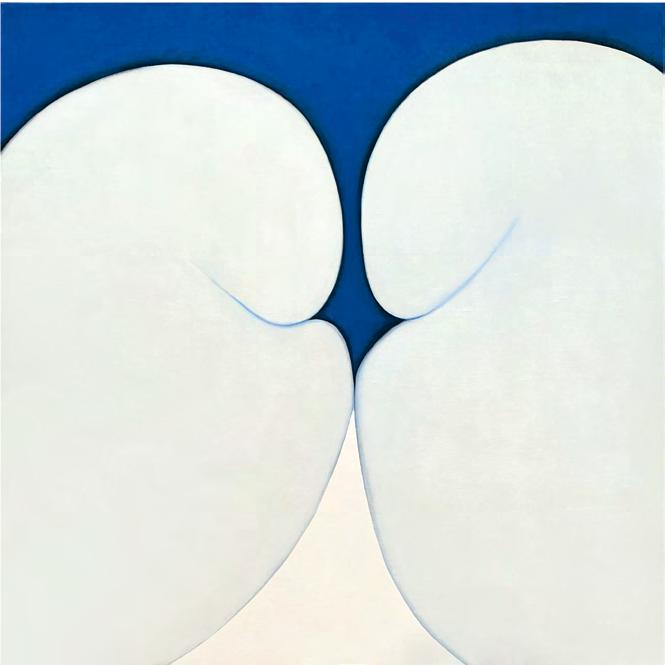
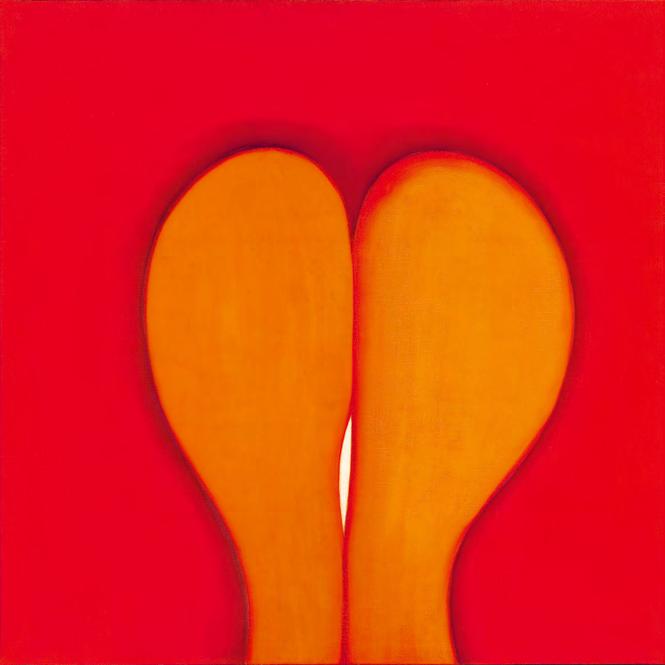
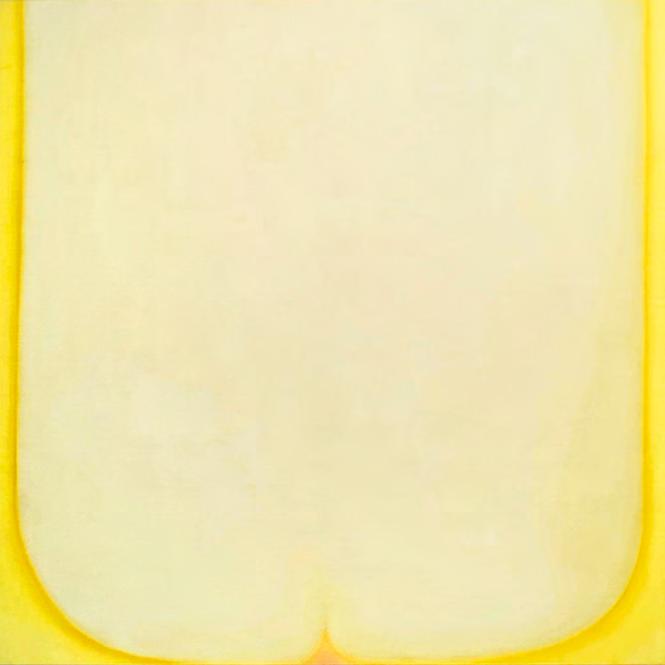
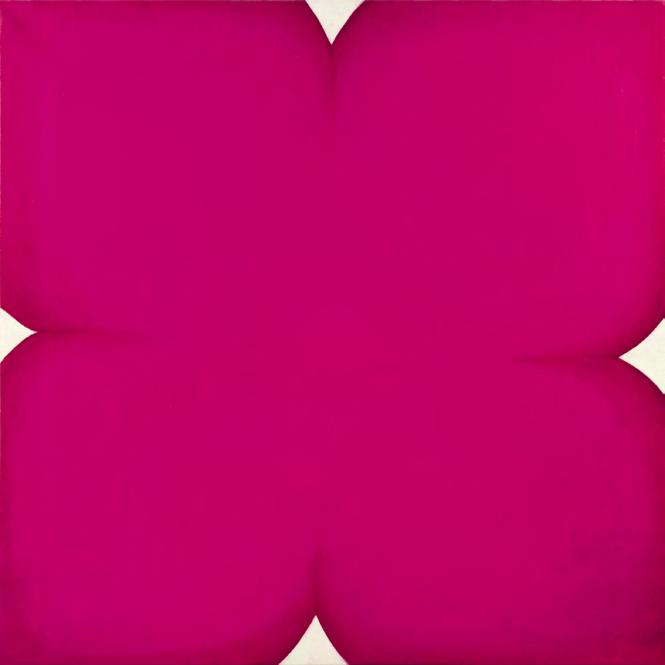
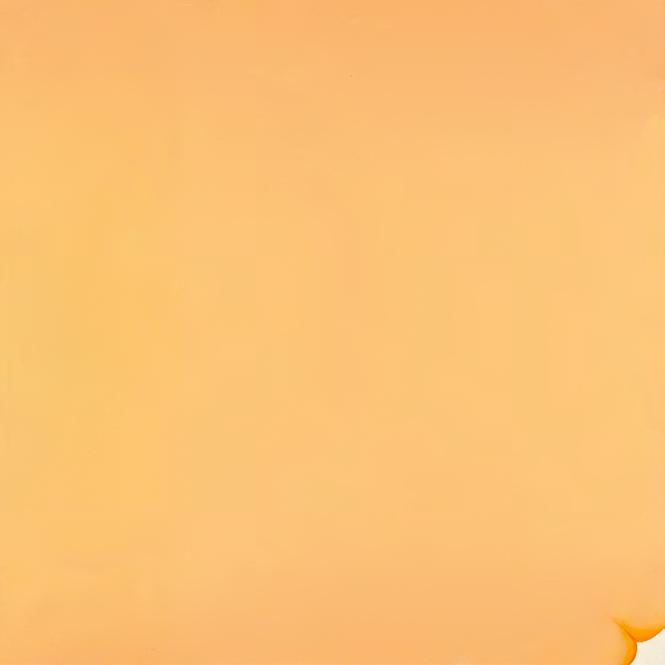
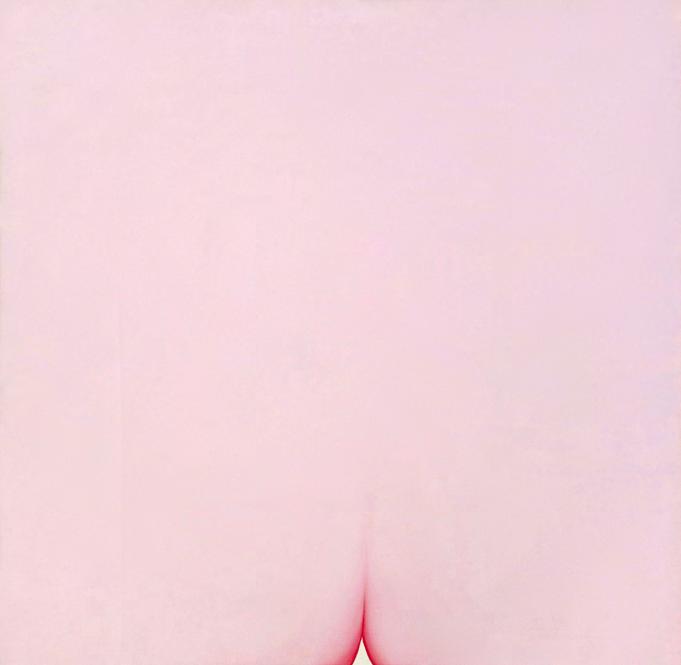
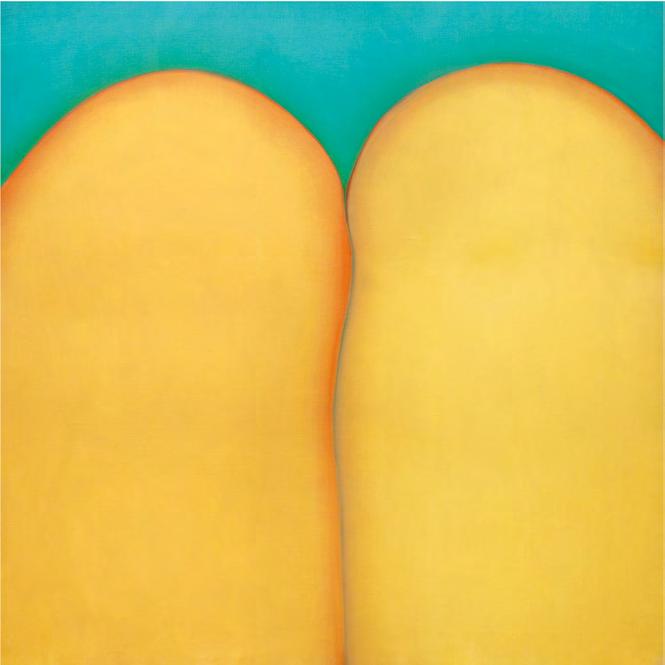
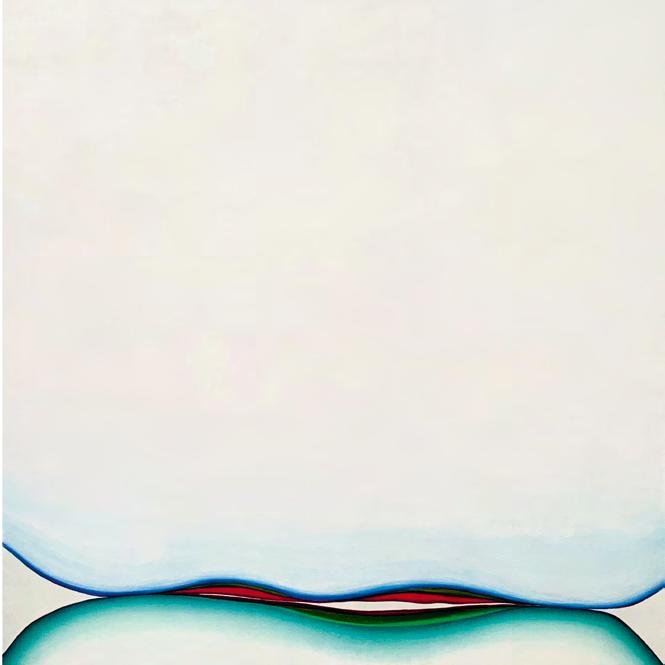
Check Point (Bribes de corps) / Sourire interrompu par le départ,
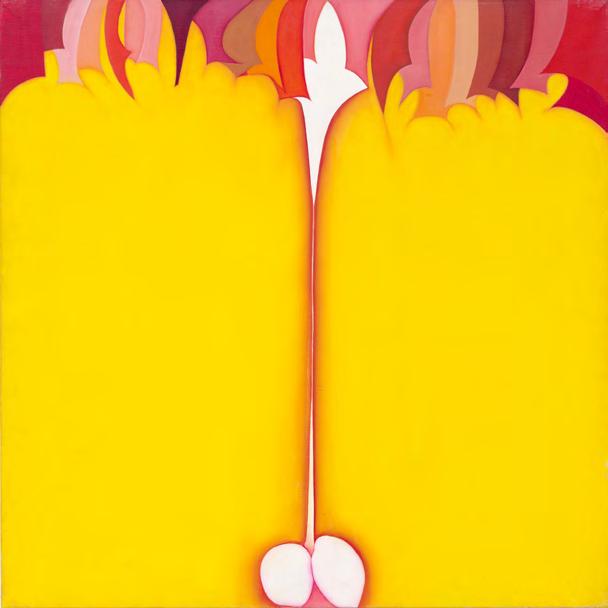
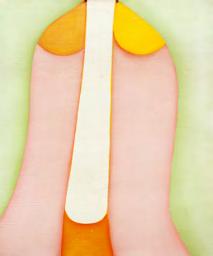
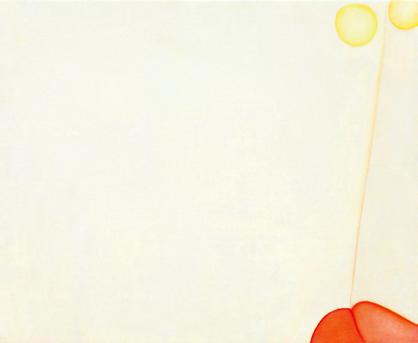
Elle et lui, 1978
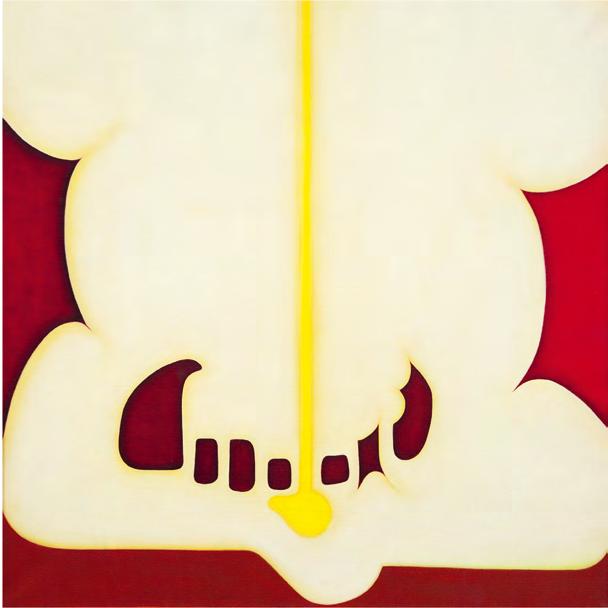
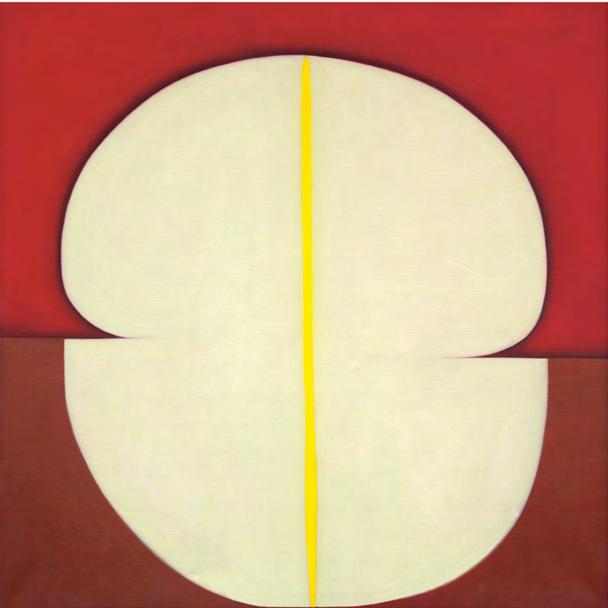
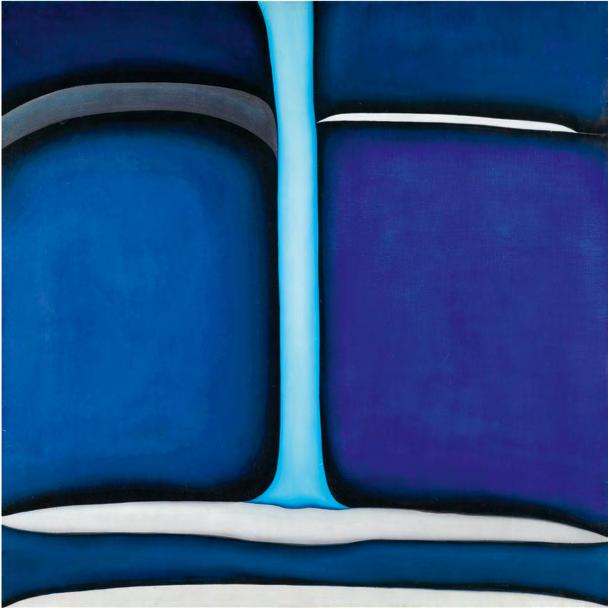
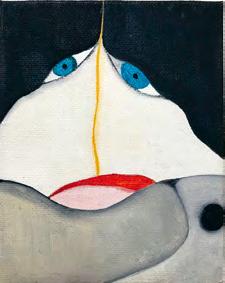
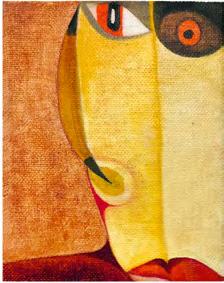
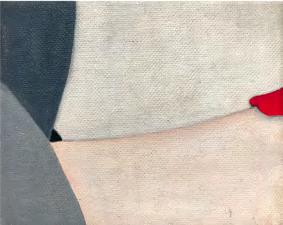
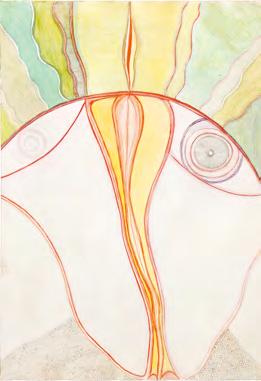
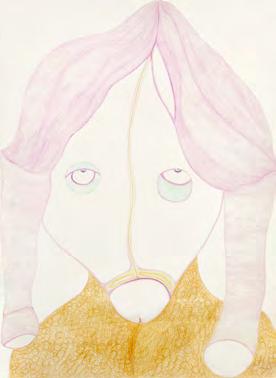
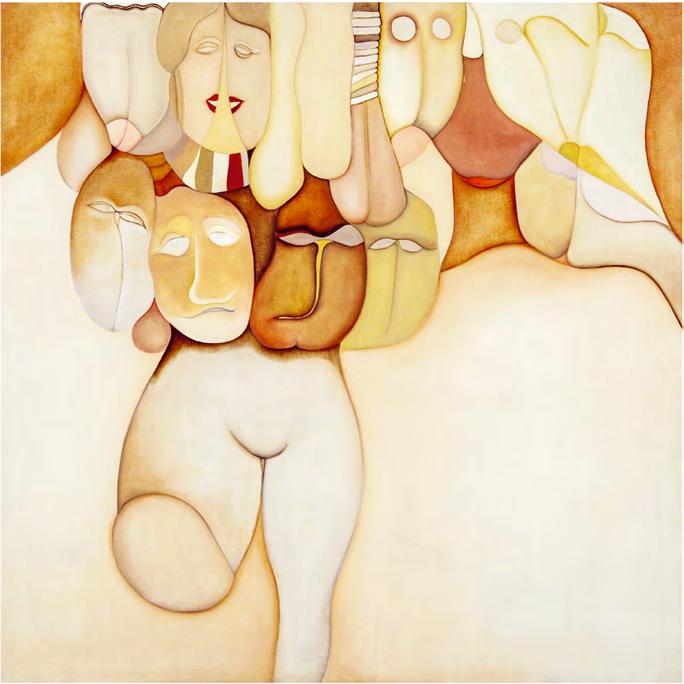
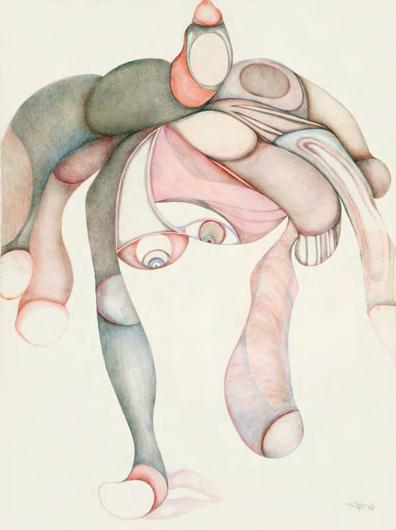
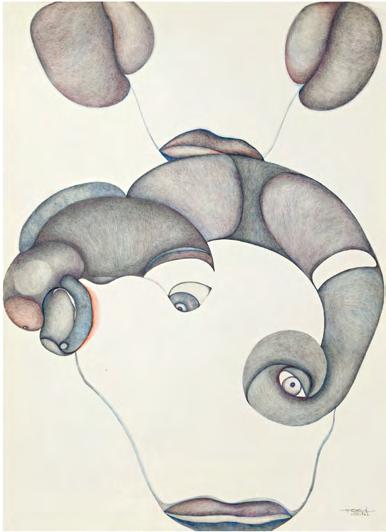
Untitled, 1985
Untitled, 1985
Créature de rêve, 1978
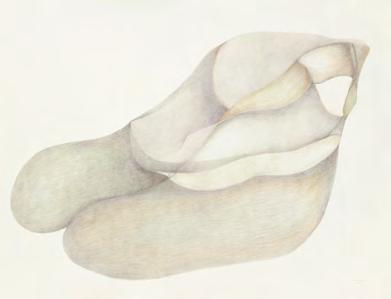
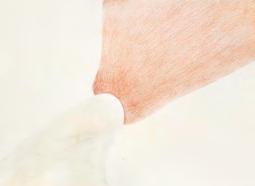
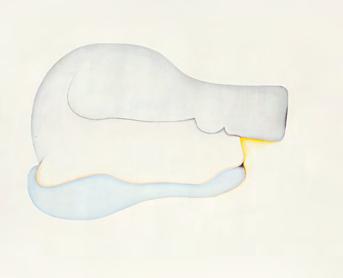
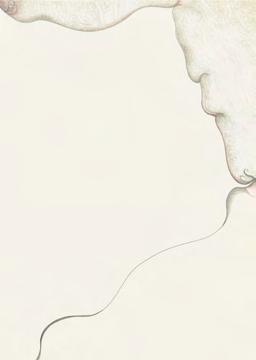
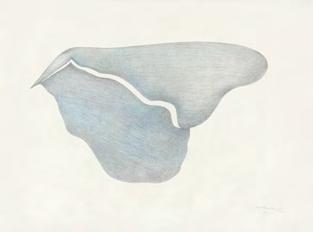
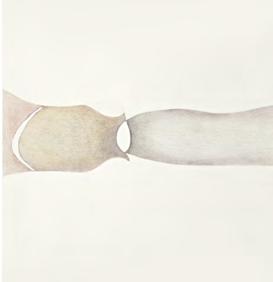
Untitled, 1983 Untitled, 1984 Untitled, 1985
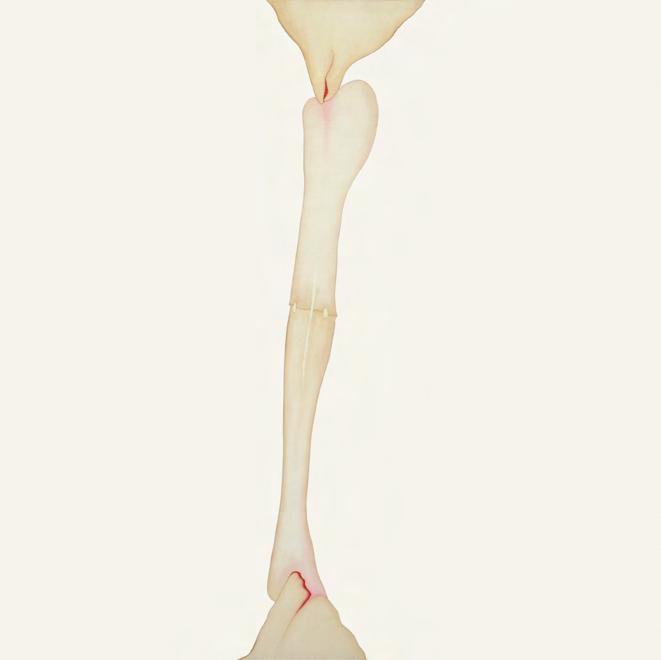
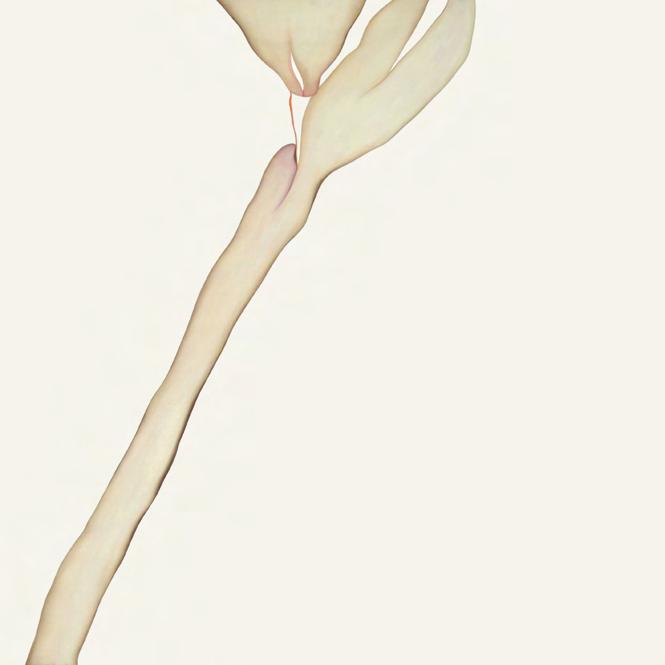
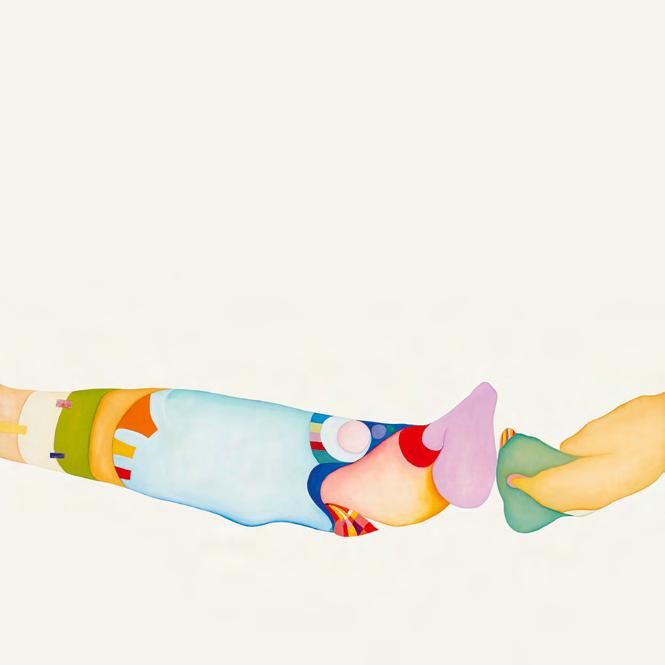
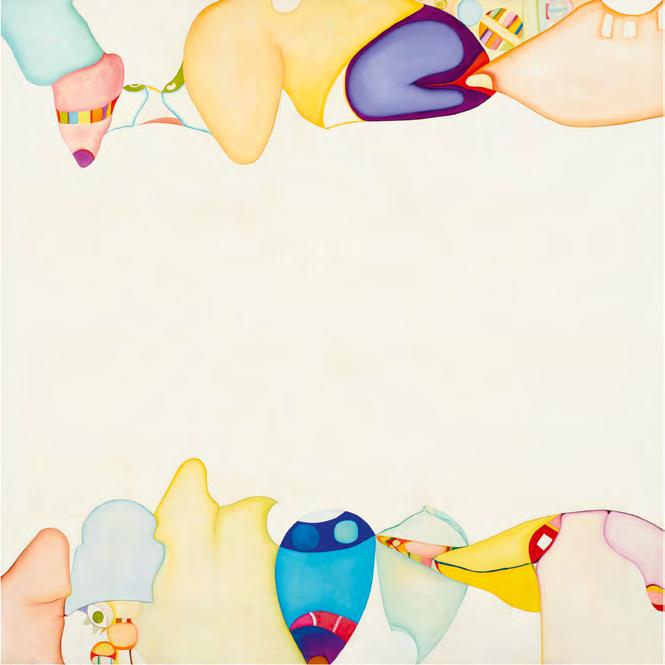
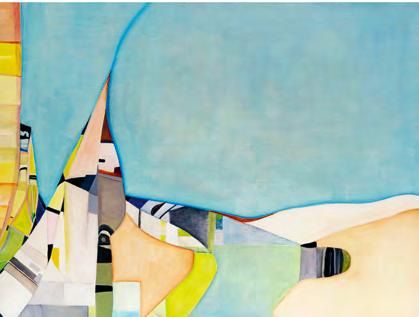
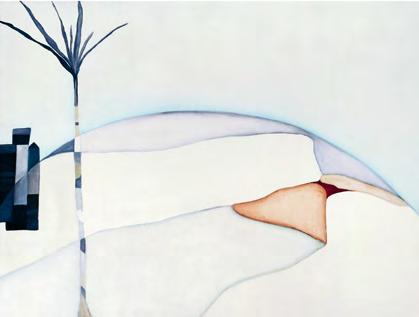
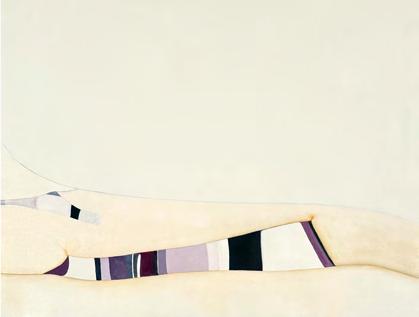
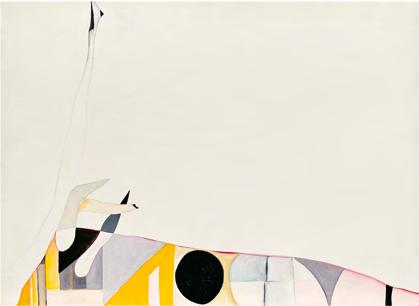
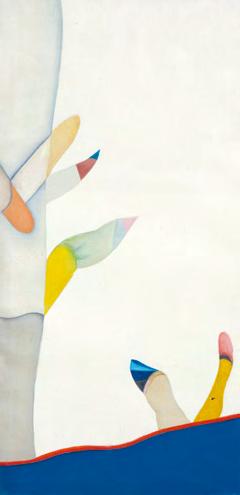
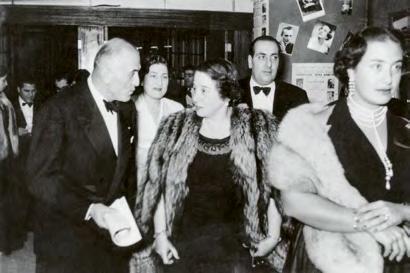
ca.
Fig. 1: Unknown, Huguette Caland and her mother, Laure El Khoury, attending a theater performance in Beirut,
1952
Fashioning Freedom: From the Artist’s Studio to the Paris Atelier
Alex Aubry
There is an image of Huguette Caland attending a theater performance with her mother in the early 1950s. Slightly blurred and cropped, Huguette appears squeezed into a couture gown complete with pearls and a fur stole (fig. 1).1 It is a rare portrait of the artist, revealing a young woman who has yet to break with convention and fully pursue her creative impulses. As the only daughter of Lebanon’s first postindependence president, Huguette’s place among the Lebanese elite came with its own set of expectations. Navigating social codes in an outwardly cosmopolitan, yet inwardly conservative, Lebanese society, meant playing the role of the dutiful daughter, wife, and mother through the clothes she wore.
Her mother, Laure El Khoury (née Chiha), hailed from a prominent banking family and served as an early role model. Women of her class projected a modern and sophisticated image through the fashions they wore, ordered during trips abroad or from local dressmakers licensed to replicate Paris models. Huguette would have been familiar with the ritual of couture fittings, having accompanied her mother to Paris by steamship from the age of fifteen. 2 Yet cracks of sartorial independence would begin to surface after her 1952 marriage to Paul Caland, who also preferred to see his wife dressed in Paris couture. 3 Having struggled with her weight
1 To preserve the proximity that fashion affords us with distant figures, I have chosen to write about the artist using her first name.
2 Brigitte Caland, interview by the author, January 8, 2020.
3 Anne-Marie O’Connor, “Her Magical World,” Los Angeles Times, June 19, 2003, F1.
from an early age meant Huguette also struggled to conform to the fashions of the era, which molded the female form into an idealized hourglass, buttressed by girdles and corsetry.
By 1972, a contrasting photograph of Huguette finds her firmly centered in the image wearing an abaya, a traditional cloak worn in parts of North Africa, the Levant, and the Arabian Peninsula (p. 58). It is elegantly perched on her shoulders over one of her early kaftan designs, aptly titled The First (Dress 1) (fig. 2). In this photo taken during the opening of a group exhibition of Lebanese artists in Rome, Huguette stands poised and confident surrounded by women in fur coats and formfitting dresses. 4 The earlier and later images could serve as bookends to a transformative period in Huguette’s life, when the artist set about crafting a new persona through the clothes she wore, while still navigating patriarchal expectations of gender and appearance.
1964 would prove to be a year of reinvention for Huguette following her father’s death that year, not long after her mother passed away in 1960. Shortly after the required three days of mourning, she emptied her closets of her Dior couture gowns and gave them away. 5 As a step toward independence and self- acceptance, she immediately took to wearing abayas and kaftans, much to the consternation of her husband. Hers was a statement of liberation after years of conforming to rigid beauty standards, one that demanded fitting into restrictive couture garments, even after giving birth to three children. “The big drama was when I changed my look. It was almost a cause for divorce. My clothes changed my life. I could really enjoy my life,” noted the artist in an interview for the Los Angeles Times. 6
Huguette’s adoption of the kaftan should not be seen as an anti-fashion statement, as she was deeply interested in dress as a mode of expression. Nor should it be interpreted exclusively as a proud assertion of the beauty and value of her Arab heritage, given that the artist’s choice of dress also served the double purpose of
4 My thanks to Hannah Feldman for this information as this photo is often misattributed to the artist’s 1970 exhibition at Dar el Fan.
5 Caland, interview.
6 O’Connor, “Her Magical World,” F1.
138
Alex Aubry
giving her the freedom to grow and shrink in size unnoticed beneath its folds. By 1965, she was attending classes at the Art Department of the American University of Beirut. As a thirty-three-year-old student on her way to campus, her voluptuous frame, clad in a protective abaya, raised eyebrows and unsolicited comments about her appearance from passersby. Once inside the safety of the Art Department, however, she found acceptance and friendship among a “misfit” group of students and teachers (fig. 3).7
The artist’s early experience of navigating public space in her clothing of choice points to the cultural dichotomies at play in Beirut during this period, revealing what Rachel Dedman describes as a “conditional cosmopolitanism” that was contained for the most part within elite spaces, where those of social standing could explore relative freedoms and modes of expression. As Dedman explains, outside those privileged circles, entrenched distinctions of class and ethnicity remained. 8 Despite these dual realities, Huguette was
7 Hanan al-Shaykh, “Hanan al-Shaykh in Conversation with Huguette Caland,” in Huguette Caland: Everything Takes the Shape of a Person, 1970–78, ed. Aram Moshayedi (Milan: Skira, 2017), 181.
8 Rachel Dedman, “In Detail: At the Still Point of the Turning World, There Is the Dance,” in Helen Khal: Gallery One and Beirut in the 1960s, ed. Carla Chammas et al. (London: Sternberg Press, 2023), 67.
139
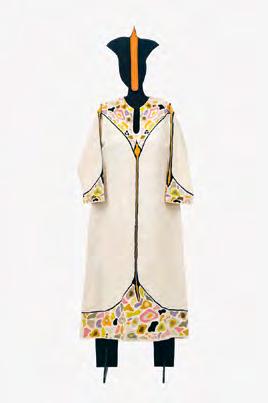
not a complete anomaly in her choice of dress among Beirut’s social circles, which also included well-heeled expatriates and a diplomatic community. In the early 1960s, a group of enterprising women from prominent Lebanese families opened boutiques specializing in local textile crafts teetering on the verge of extinction. Credited with the revival of the traditional abaya, their creations appeared at Beirut’s theaters and receptions, worn as chic evening jackets and opera coats over Paris couture gowns (fig. 3). 9
Among these individuals was Madame Rene Moua’wad and her line for Artisanat Zghorta, Madame George Asseily, who founded the Domestic Textile Center on rue Hamra, Mesdames Al Khazen and El Khoury, who opened Artisans in a seaside cellar, as well as Madame Pierre Eddé’s L’Artisanat Libanais, whose artisans worked on sixteenth-century handlooms in the village of Zouk Mikael.10 Huguette would have been familiar with many of these individuals and their designs, whose influence stretched beyond Lebanon’s borders. After women in Arab diplomatic circles began wearing their creations, orders soon came from European and American customers. In addition to the abaya, this group of socially connected women set out to reinvent the kaftan as an
9 Paul Hoye, “High Fashion from the Arab World,” Aramco World Magazine, September–October 1968, 7.
10 Hoye, “High Fashion,” 7.
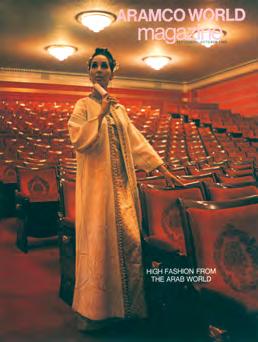
World Magazine, September–October 1968 issue (cover: Lebanese
Andrée
Fig. 3: Aramco
model
Acouri photographed by Burnett H. Moody at Beirut’s Piccadilly Theater, wearing an evening gown paired with an elegant abaya by Artisanat Zghorta)
Alex Aubry
alternative to the hostess dress, thus influencing Western designers who created versions featured in publications such as Vogue and Harper’s Bazaar. 11
While most women in Huguette’s social class wore formfitting interpretations of traditional garments or combined abayas with Western-style gowns, the artist stood out for frequently wearing easy flowing versions of these traditional garments, and for doing so in both public and private. From 1970 to 1975 she created a series of silk kaftans, hand embroidered with her own designs. While these were worn when she went out or entertained at home, the artist also had plain kaftans tailored for her as practical smocks to wear while painting. These too became works of art, albeit some unintended, as she scribbled notes, wrote down phone numbers, and wiped paintbrushes on them (p. 158).
During this period, Huguette’s paintings, especially of nude body parts that challenged conventional notions of beauty and desire, spilled from the canvas onto one of her kaftan designs, which she named Miroir (Mirror, 1974; p. 153). Like her paintings, Miroir was considered unsettling to some in Beiruti society. Perceived as risqué, it even shocked members of the local art scene who questioned her morality, recalls her daughter, Brigitte.12 Considered within this context, there is something both subversive and courageous about the artist’s ability to navigate taboos and social ostracization. Her dedication to her art, or the freedom such an unorthodox existence entailed, gave her the fortitude to shrug off attempts at shaming her. Even after Huguette moved away from Lebanon, her daughter recalls that she insisted on frequenting her Muslim tailor, who blushed when asked to embroider drawings of the female anatomy that her kaftans were meant to conceal.13
While the artist’s paintings, such as the Bribes de corps (Body Bits; pp. 101–121), reflect a uniquely feminine perspective on the body, her daughter suggests that Huguette likely conceived these works with both the male and female gazes in mind.14
11 Hoye, “High Fashion,” 7.
12 Caland, interview.
13 Caland, interview.
14 Caland, interview.
Shortly after her first solo exhibition at the Dar el Fan gallery in 1970, Huguette announced her plans to relocate to Paris at the age of thirty-nine. While London attracted individuals from its former British colonies, by the 1970s, Paris had become the unofficial Arab capital of the Francophone world. Far from living in social isolation, Huguette found herself in a familiar city that was home to noted intellectuals, artists, and writers from across North Africa and the Middle East. In this community she found support, but also freedom and anonymity. Once in Paris, she continued to maintain an open-door policy at home, where she reconnected with individuals she had befriended in Beirut. They included the poets Adonis, Andrée Chedid, and Salah Stétié, as well as artists such as Chafic Abboud and Helen Khal, who spent a month living and working with Huguette at her Paris studio in 1974 (fig. 4).15
As in Beirut, Huguette was not a complete anomaly in her choice of dress in Paris, during a decade when Parisian galleries were exhibiting the work of a number of female artists from the Middle East. Among these were the Iranian artist Monir Shahroudy Farmanfarmaian, who wore an embroidered abaya and Turkoman jewelry to her exhibition opening at Galerie Denise René in 1977,16 as well as Egypt’s former queen, Farida Zulficar, who was photographed in 1978 at her Paris apartment in an embroidered kaftan surrounded by her paintings. Seeing their portraits today reminds us of a period when donning a kaftan was considered a mark of sophistication in international circles. It was within this environment that Huguette continued to dress in her billowing robes for dinner at a restaurant or a night at the theater. Ironically it was these very garments, symbolizing her rejection of couture’s constrictive tailoring, that would bring her back into its fold—however briefly on her own terms as an artist.
During a heated argument with her husband over her choice of dress, Huguette once prophesized that a designer would one day be interested in her kaftans.17 That day came in 1978, when
15 Dedman, “In Detail,” 66.
16 Monir Farmanfarmaian and Zara Housmand, A Mirror Garden: A Memoir (New York: Anchor, 2018), 264.
17 Caland, interview.
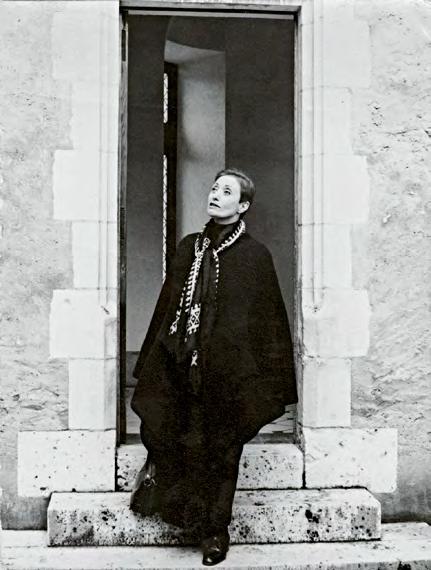
Fig. 4: Moustafa Ariss, Huguette Caland in Stone Doorway, France, 1970
she entered Pierre Cardin’s boutique at 118 rue du Faubourg SaintHonoré, in search of a necktie for her husband. Above the store’s marbled green facade were four floors of offices, design studios, and workrooms, which served as Cardin’s headquarters. When not traveling, the French couturier spent his days visiting various departments in his building, and he happened to be in the store the day Huguette came in. “I love what you’re wearing,” Cardin told the Lebanese artist, to which she cheekily replied, “So do I.” 18 While the prevailing narrative is that the designer promptly suggested they work together, according to her daughter, Brigitte, it was Huguette who sent him a letter shortly after their chance encounter, proposing they collaborate on a line of custom kaftans and homewares.19
Although Cardin launched his couture house in 1950, by 1977 it was an entirely different enterprise, encompassing 350 licensees that brought in $395 million in sales that year. The Cardin empire included some three hundred factories, employing nearly 140,000 people in forty countries, while his designs were sold in five hundred boutiques around the world. His was an immersive universe, where he envisioned customers living with Cardin clothes, accessories, furniture, cars, chocolates, and cutlery. 20 As one of the wealthiest designers of his day, Cardin was above all a shrewd businessman who did not take partnerships or collaborations lightly. In Huguette, he may have seen an opportunity to tap into an emerging market.
By 1970, the haute couture industry was experiencing an identity crisis. With the growing influence of ready-to-wear, the once lucrative business of selling couture samples to New York’s Seventh Avenue manufacturers and retailers was on the decline. Believing four shows a year was excessive, Cardin announced he would only present one couture collection annually, while Yves Saint Laurent briefly considered combining his haute couture and ready-to-wear
18 Caland, interview.
19 Caland, interview.
20 J. A. Trachtenberg, “Cardin Will Visit China Soon to Settle Advisory Pact,” Women’s Wear Daily, February 27, 1979, 14.
Alex Aubry
While the haute couture did experience a resurgence within a few years, Balmain failed to foresee that its new customer base would come from the very countries that benefited from the oil embargo. With over $60 billion in surplus revenue to invest abroad, by 1974 an influx of oil wealth was felt in London and Paris, where choice real estate was being acquired by wealthy investors from Iran and the Arab Gulf States. 24 Cardin was aware of this, as his collections—numbering over 250 styles—were often conceived with an international clientele in mind. “You can’t make just one look. You have to think of all the different types of women you are dressing and the different types of lives they lead,” he explained in 1971. 25 For Cardin, the idea of creating a collection of haute couture kaftans for a Middle Eastern clientele was likely no different than the line of kimonos he introduced to the Japanese market in 1973. 26
Cardin’s exposure to North Africa and the Middle East can be traced back to the mid-1950s, when he presented his first fashion show in Egypt. 27 By 1974, he had already visited Lebanon to open his store in Beirut and was showing his collections in Kuwait, where they were carried at the Saeed and Daulat department
21 G. Y. Dryansky, “March Show Only, Cardin Declares,” Women’s Wear Daily, September 4, 1970, 14.
22 Dryansky, “March Show,” 14.
23 Patricia McColl, “Paris Pre-Couture: French Win Fashion Battle at Versailles,” Women’s Wear Daily, January 3, 1974, 16.
24 G. Y. Dryansky, “Paris’ Goldex Ghetto,” Women’s Wear Daily, May 30, 1974, 4.
25 June Wier, “Cardin: YSL’s Prophetic Shape,” Women’s Wear Daily, July 27, 1971, 4.
26 Bernadine Morris, “For Today’s Designers, Fashion Isn’t Enough,” New York Times, October 26, 1973, 48.
27 Jean-Pascal Hesse and Pierre Pelegry, Pierre Cardin: Making Fashion Modern (Paris: Editions Flammarion, 2022), 98.
145 shows together. 21 The American and European clients who had long supported the couture houses were also dwindling in number, a trend that was further exacerbated in the wake of the 1973 oil embargo. 22 “I think the present energy crisis will bring back the couture,” noted the designer Pierre Balmain to Women’s Wear Daily, further explaining, “it’s about the only industry in the world today that doesn’t depend on Arab oil.” 23
store, as well as Le Ruban Bleu, a fashionable boutique. 28 The year Huguette met Cardin, the couturier had also traveled to Iran to participate in a fashion show celebrating the opening of a luxury resort and casino on Kish Island. Invited by Iran’s shahbanu, Farah Diba, the event included other prominent couture houses such as Christian Dior, Nina Ricci, Guy Laroche, Jean-Louis Scherrer, and Pierre Balmain. 29 By the time Huguette went to work for Cardin, the client books at these Paris couture establishments were increasingly dominated by the names of prominent royals and merchant families from Iran, Saudi Arabia, Kuwait, Qatar, and the United Arab Emirates. Although they largely avoided the shows, preferring to make their selections in the privacy of the couture salons or their hotel suites, the presence of these Middle Eastern women in Paris certainly influenced larger fashion trends. 30
For its March/April 1977 issue, Aramco World Magazine published a story titled “Couture Arabesque,” which reported on Middle Eastern influences permeating the collections of houses such as Dior and Yves Saint Laurent in the form of billowing djellabas and clinging kaftans (fig. 5). Many of the designers featured had traveled throughout North Africa and the Middle East, including Marc Bohan of Dior, who had spent his holidays sailing down the Nile
28 Patricia McColl, “Kuwait: Where Money Flows like Oil,” Women’s Wear Daily, March 22, 1974, 5.
29 Martine Valluy, “Kish Symbole de L’Iran Moderne,” Vogue Paris, February 1978, 302
30 Patrick McCarthy, “Paris Couture: Extravagant Elitism,” Women’s Wear Daily, July 23, 1979, 6.
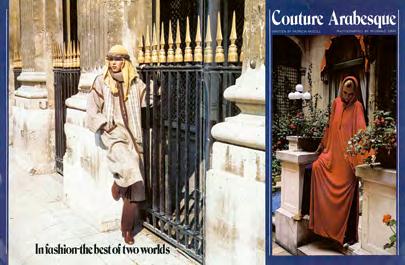
5: Aramco World Magazine, March/ April 1977 issue (inside pages: reporting on Middle Eastern influences on the Paris couture collections by Patricia McColl; photographs by Reginald Gray)
Fig.
Alex Aubry
that year. “I adore Arab things and the way Arab women dress,” said Bohan as early as 1970, in an interview with Women’s Wear Daily. 31 In London, boutiques had also emerged to cater to the trend of Middle Eastern–inspired fashions. They included Arabesque in Belgravia, founded by Princess Dina Abdul-Hamid of Jordan, the former wife of King Hussein, as well as the designer Thea Porter, who also opened a Paris boutique in 1976. Known for her stylish kaftans cut from fabrics sourced in Turkey, Syria, Morocco, and Lebanon, the Jerusalem-born British designer had grown up in Damascus and lived in Beirut while working at the British embassy. 32
This was the Paris fashion world that Huguette stepped into in 1978, one which was momentarily in sync with her own aesthetic sensibilities. According to her daughter, she spent a year at Cardin, where she was given a space in his design studio, together with an assistant and unlimited resources to create over a hundred elegant couture kaftans and abayas. Although little information exists today about her time at Cardin, Huguette may have become acquainted with members of the couturier’s team, which included Andre Oliver, his right hand and assistant designer; Yoshi Takata, his photographer and collaborator; Cardin’s business manager Jean Manusardi; the house’s commercial director, Daniel Fallot; as well as Maryse Gaspard, Cardin’s former model and muse who became the director of his couture department. 33 How much of a role these individuals may have played in shaping Huguette’s collection is unknown, but the level of independence she was given at the house may also point to Cardin’s affinity for her as an artist and designer.
“Art should be lived and also experienced,” stated Cardin in a 1971 interview, a mantra that also reflects Huguette’s approach to creating wearable art. 34 Intrigued by the relationship of geometry to the human body, Cardin’s op art–inspired garments often featured nude cutouts, triangles for bodices, fanned pleating, and circles for
31 June Wier, “Dior . . . the Longest Day,” Women’s Wear Daily, January 29, 1970, 5.
32 Patricia McColl, “Couture Arabesque,” Aramco World Magazine, March/ April 1977, 32.
33 Hesse and Pelegry, Pierre Cardin , 12–13.
34 Francoise Sciaky, “Traveling Trio,” Women’s Wear Daily, September 29, 1971, 8.
sleeves—mirroring the Lebanese artist’s own experimentations with line and form. Despite this, little evidence exists in the fashion press of Huguette’s collaboration with Cardin. Christened Nour, or light in Arabic, her collection of designs may have been presented during the January 1979 couture showings, when fashion editors and buyers traveled to Paris. One of the few mentions of the collection appears in a feature on Cardin by André Leon Talley for Women’s Wear Daily ’s November 29, 1978, issue. While he did not mention Huguette as a collaborator, Talley reported that “Cardin was talking about his special collection of kaftans and special designs to be shown for Arab countries in Espace Cardin.” 35
According to Brigitte Caland, the French couturier offered to extend Huguette’s contract to design for the house on a commercial scale. Although her tenure at Cardin had been a positive experience, Huguette took her time to consider his offer. According to her daughter, what had originally attracted Huguette to the House of Cardin was the prospect of creating unique wearable pieces as an extension of her art practice. 36 While most of the garments she created for the couturier were never reproduced, Huguette’s archives reveal that her creative contributions to the house extended beyond fashion. Stored away in folders are precise renderings of ornamental plates as well as decorative borders for napkins and tablecloths (p. 155). Featuring stylized interpretations of Islamic script, they are a curious departure from the artist’s visual language, perhaps highlighting her ability as a designer to create objects with a specific audience in mind.
Together with her kaftan designs, the presence of these quotidian or utilitarian works in her archives raises more questions than it provides answers, adding a layer of complexity to Huguette’s legacy as a creative who moved freely between mediums and disciplines. It is unclear whether she intended for her kaftans, like Miroir, to be displayed within gallery walls when she originally created them. It was, after all, quite a few years after conceiving them
35 André Leon Talley, “Maxim-ized Dressing,” Women’s Wear Daily, November 29, 1978, 6.
36 Caland, interview.
Alex Aubry
before Huguette began exhibiting her kaftans together with her paintings, drawings, and sculptures. Sometimes displayed on static wooden mannequins she designed in the 1980s, her kaftans raise a provocative idea behind their inclusion in a gallery or museum. Once garments enter these settings, they effectively become objects of study in the domain of art history, rather than tools for navigating the world.
Although some of the kaftans she created for herself from 1970 to 1975 exhibit the timeless appeal of art, more challenging perhaps is the desire to attach substantive readings to the artist’s designs for Cardin. Few examples of her work for the couture house survive today apart from a handful of garments in her archive. With the exception of a formal silver-greige kaftan (p. 157), hand painted with her abstracted patterns derived from her paintings, other existing designs for Cardin from the period appear plain in comparison. The kaftans she created for him were often part of an ensemble that included a matching abaya and mantle draped over the shoulders. Cut from fine wool tartans and ginghams, they are meticulously finished in the tradition of couture garments. Yet absent are traces of the organic, playful, and erotic line drawings that appeared in her earlier kaftans such as Foule (Crowd, 1970; p. 152), Tête à tête (Face to Face, 1971; p. 151), and Miroir. Huguette eventually declined Cardin’s offer, confiding to her daughter, Brigitte, that she had no desire to become a commercial designer at the expense of maintaining her creative independence as an artist. 37 Yet long after their collaboration had ended, she may have continued to maintain connections with some of the individuals she worked with at his couture house. Among the more intriguing items in Huguette’s archives are two finely tailored plain kaftans sporting labels with the artist’s name on them. Based on comments by Maryse Ebely, the garments may have been sewn by Madame Marsant, a première or head of Cardin’s couture atelier. 38 Whether they were a personal commission intended to be
37 Caland, interview.
38 My thanks to Hannah Feldman for sharing this information from her interview with Maryse Ebely.
worn by the artist, or possible prototypes for a collection under her own name is uncertain, yet the existence of these kaftans points to Huguette’s sustained interest in fashion as a mode of expression. 39 Huguette’s brief time at Cardin would be the only period in her life when she worked for someone else. “You never ask for freedom; you just take it. And she did. She took her freedom and just lived it,” said Brigitte, recalling a comment her mother made. 40 Those same words come to mind when considering Huguette’s determination to craft her image on her own terms, through the kaftans and abayas she wore and created. Focusing on her relationship to clothing within the context of her evolving environment may further expand our understanding of how Huguette’s sartorial choices were as much a reflection of herself as the paintings she created, informed by the artist’s strong desire to live without restrictions, even in her wardrobe.
39 In Huguette Caland’s 1990 sketchbook, which recounts the years she spent in her Paris studio and is now part of the artist’s studio archives, she also mentions fondly her friendship with Pierret Balare, another première in Cardin’s couture atelier. She graciously credits Balare for making her clothing beautiful.
40 Caland, interview.
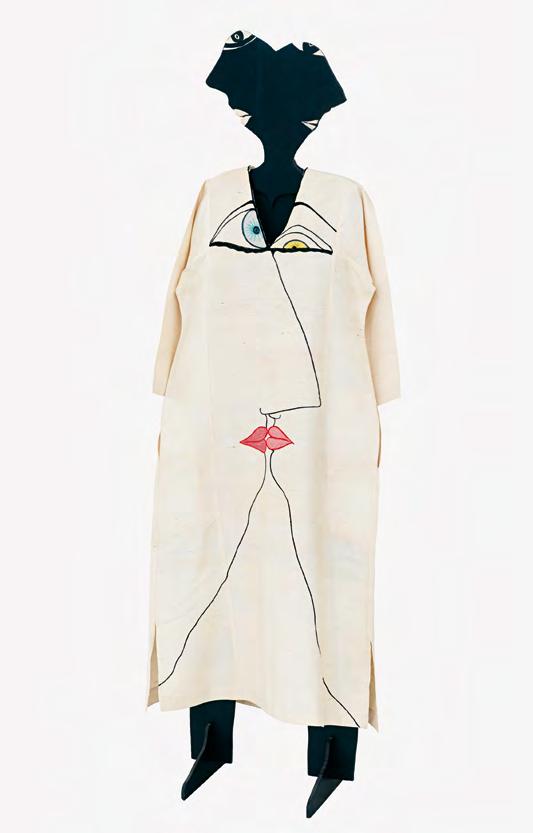
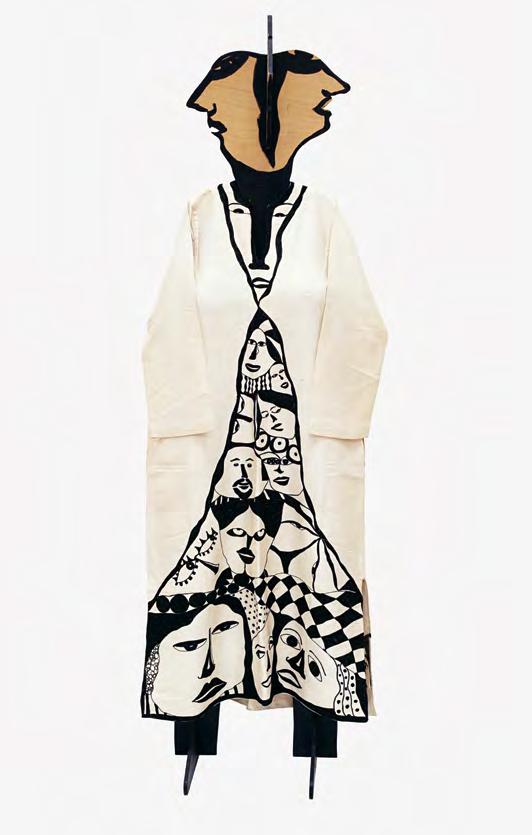
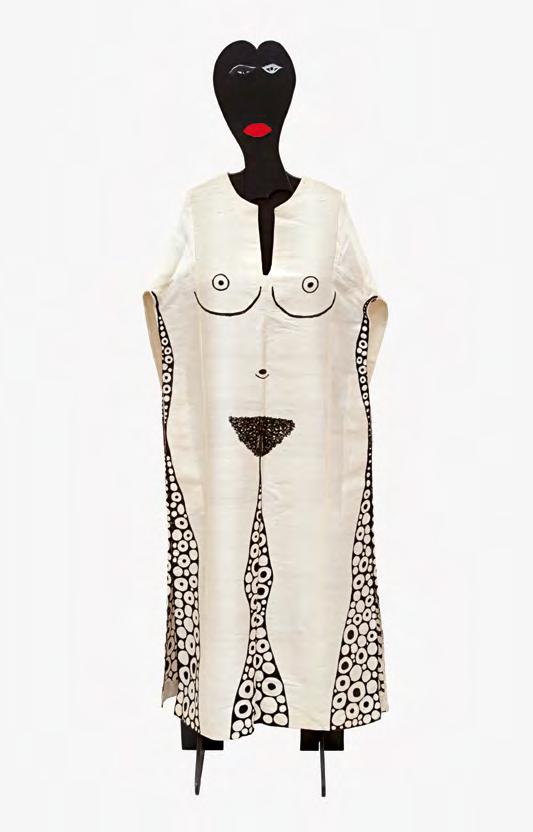
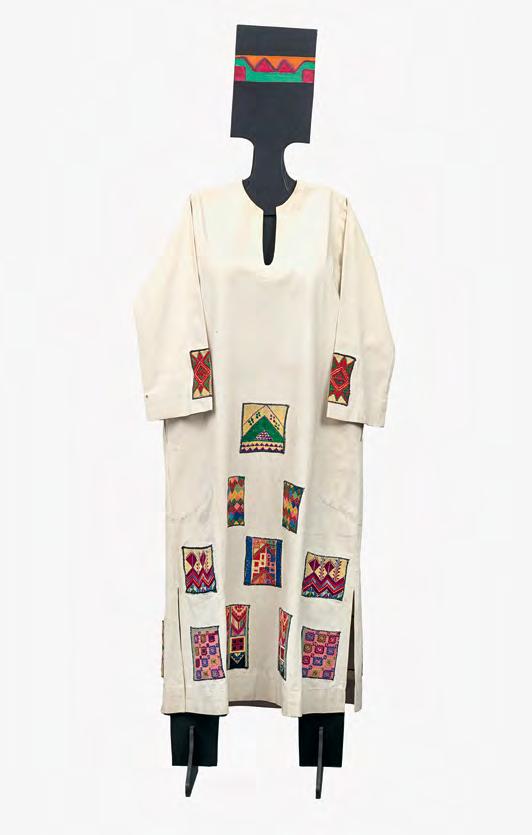
Huguette Caland and unknown technician, designs for plates, 1979
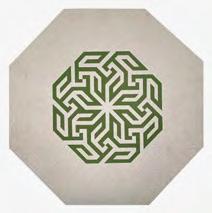
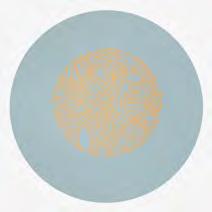
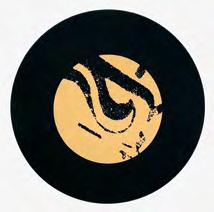
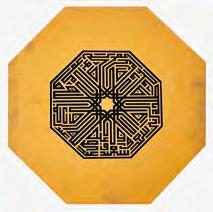
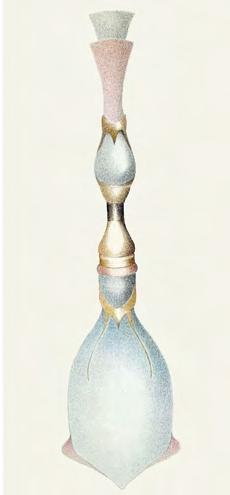
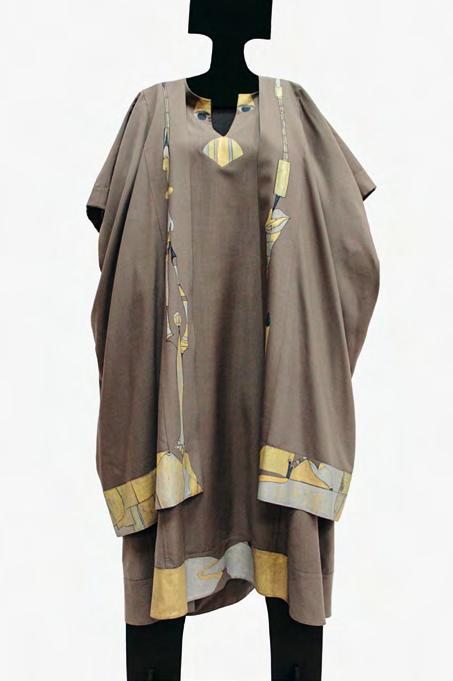
1
Dress
(designed for the Nour collection along with Pierre Cardin), 1979
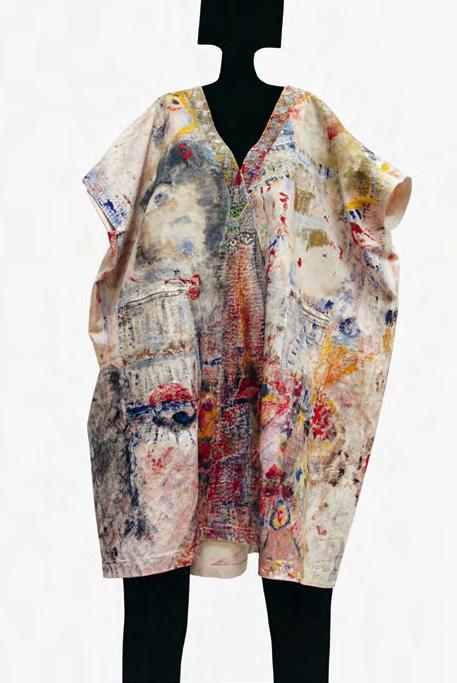
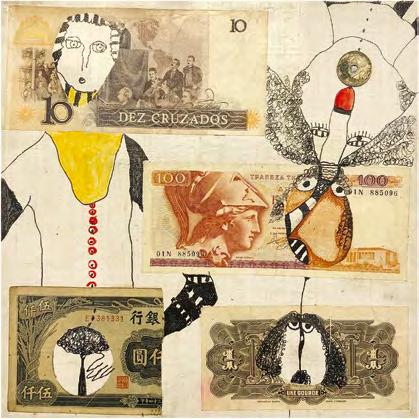
L’argent ne fait pas le bonheur, mais il y contribue largement : Il est possible de s’amuser avec l’argent, 1994
Silence Is Golden: Huguette Caland’s L’argent ne fait pas le bonheur, mais il y contribue largement Exhausts a Subject and Frees the Artist from It
Kaelen Wilson-Goldie
As an artist who took both pleasure and solace in her work, Huguette Caland was known to be naughty and playful and serious and strongwilled. For ideas, forms, and the flexibilities of language, her curiosity seemed irrepressible. She imagined the line of her drawings to exist on a plane of pure consciousness, universal and shared, there to be taken, experimented with, but ultimately returned. She often used that same line to still the agitations of her mind, to allay what she described as her innumerable fears, and to find some measure of respite in silence.1
1 From interview footage with Huguette Caland featured in Fouad Elkoury’s forty-nine-minute film, Lettres à Huguette (2021), and in Elkoury’s earlier, forty-three-minute film, Lettres à Francine (2002), which also featured Caland, on screen and in voice-over, among several other artists, writers, musicians, and filmmakers, including Danielle Arbid, Yto Barrada, Dominique Eddé, and Yasmine Hamdan. From Lettres à Huguette: “I’ll tell you,” Caland says. “I feel there is a single line going through the universe. It’s been my great fantasy. I always thought that there was one single line that wandered in space. Each one of us takes it. You can catch it on the fly somewhere, bring it down, make a letter out of it, a flower, a drawing, a word, but it’s the same line, and then you release it back into space. It’s that same line that each one of us catches and uses. It’s a line that is elastic and totally imaginary. For me, it exists. Every time we sketch something, we catch the line, then release it. Have you ever thought of it this way?” From Lettres à Francine : “In order to silence myself I draw lines,” Caland says. “Yes, that might seem ridiculous. But to draw a line
Caland applied the tremendous dexterity of her hands to an almost endless list of media—painting, drawing, sculpture, fashion design, the interior architecture of her homes and studios, the performative rituals of her dress and daily life. In each of these, and to her own apparent delight, Caland triumphed. She worked in many different modes—abstract, academic, erotic, nostalgic—and with many different materials. These efforts produced vast and ambitious bodies of work that are as powerful and internally coherent as they are radically dissimilar from one another. Caland’s series differ not only in terms of their style, form, texture, and sense of humor. They also differ in their place on a spectrum between uproarious minimalism (using a few spare lines to convey everything from a kiss to various sex acts in the 1972 drawing series Flirt; p. 102) and obsessive maximalism (deploying an allover pattern of dots, stripes, grids, checkers, paint splatters, stems, and peonies in the mixed media on canvas Hope, 2009; p. 228).
Best known for her large-scale biomorphic abstractions titled Bribes de corps (Body Bits ; pp. 101–121), Caland was especially fond of painting flesh, mounds of it, and making her viewers laugh. Two of her most winning linens on canvas from the Bribes de corps series, each dated 1973, are nearly monochromatic, allover washes of petal pink and sherbet orange, with the simple curves of a woman’s derriere tucked along the bottom edge and in the lower right corner, respectively. From an artist who was famously overweight as a child and repeatedly described her own adolescent body as monstrous, each is titled Self-Portrait, affectionately transforming a negative self-image into a subtle but undeniably sexy gesture (pp. 112 and 113). 2 Throughout the 1970s and 1980s, Caland painted belly buttons, large pendular breasts, cracks and slits and crevices, knees and thighs pressed together, gaping blue eyes, and parted lips. Her sinewy, mischievous line drawings crammed multiple
is a way to contain one’s emotion, one’s anger, one’s anguish. When one has a desire to hurt others, one draws a line.”
2 Elkoury, Lettres à Huguette; Helen Khal, The Woman Artist in Lebanon (Beirut: Institute for Women’s Studies in the Arab World, 1987), 128; and “Hanan al-Shaykh in Conversation with Huguette Caland,” in Huguette Caland: Everything Takes the Shape of a Person, 1970–78, ed. Aram Moshayedi (Milan: Skira, 2017), 180.
Kaelen Wilson-Goldie
bodies together in shallow compositional spaces, as in Parenthèse II (Parenthesis II, 1971; p. 82) or stretched them elegantly along diagonal axes, as in Couchée sur la colline (Lying on the Hill, 1972) or Alpinisme (Mountaineering, 1973; p. 80).
Later in life—after she had left her family in Lebanon, moved to France, and settled in the United States, in 1987, building a notable dwelling in Venice Beach, California, and returning every so often to Paris and to Beirut—Caland, starting in the 1990s, began to create mural-sized canvases filled with intricate markings. 3 These are less boisterous, less social, more solitary, and more meditative than her earlier work. Some, such as Silent Letters (2003; see some examples on pp. 195–204), feature various and seemingly modular stacks of careful horizontal lines fading Zen-like into bliss or oblivion. Others, such as Tarik el Sham (Road to Damascus, 2010; p. 227) and Silent Memories (2007), evoke landscapes and the art of tatreez, or Palestinian embroidery. Large, scroll-like, and produced through a process of folding and unfolding to work on a succession of small parts, they manage to suggest all at once the look of tapestries and patchwork quilts. Works such as Le grand bleu (The Great Blue, 2012; pp. 238–239) and Maison de Freige (The Home of the Freige Family, 2010; p. 229) are covered with boats, flower blossoms, faces, and thousands of tiny x -shaped marks in ink, which Caland referred to as cross-stitches. 4
3 Designed by the architect Neil Kaufman and realized in collaboration with the contractor Paule Michel Nahas, Caland’s house, which includes her studio, features a large, windowless wall facing the street, a moat that doubled as a swimming pool, and virtually no doors on any of the interior rooms, except, as a concession, for one small guest bathroom. For more on the verve of Caland’s home, see Anne-Marie O’Connor, “Her Magical World,” Los Angeles Times, June 19, 2003, F1.
4 From interview footage with Huguette Caland featured in her granddaughter L’Or Iman Puymartin’s twenty-seven-minute film Huguette Caland: Outside the Lines (2019), which shows Caland using a pen to make these marks on a folded work in progress. The cross-stitch, where needle and thread make an x -shaped stitch on fabric, is the basic building block of Palestinian embroidery, adorning home textiles, such as pillowcases and tablecloths, as well as women’s clothing, including shawls, coats, and abayas. Such traditional embroidery played a significant role in Caland’s life and art. According to the artist John Carswell, one of her teachers and mentors at the American University of Beirut (AUB), Caland grew up watching her mother create fantastical embroideries at home. See John Carswell, “Huguette,” in Huguette Caland: Works, 1964–2012,
Among these and other series—her early nudes, her studies of particular models, her aerial maplike paintings and cityscapes, her portraits of the horse (Rocinante) in Miguel de Cervantes’s Don Quixote —one body of work stands out as unlike anything else in Caland’s oeuvre. Its distinction comes from its high number of component parts and the intensity of its sustained engagement with a single subject. It shows Caland taking the eroticism of her line drawings and her bold, graphic, highly finished approach to painting in more diaristic, hastily sketched directions, almost to the point of political commentary and caricature. And it reconfigures our understanding of Caland’s relationship to Lebanon, its political intrigues as well as its economic troubles.
L’argent ne fait pas le bonheur, mais il y contribue largement (Money Doesn’t Buy Happiness, but It Contributes Greatly to It) consists of 366 small pieces on squares measuring twenty-five by twenty-five centimeters. It represents a full year’s worth of paintings, drawings, collages, and mixed-media assemblages, plus one to accommodate for a leap year. The series was produced, according to the writer and critic Diala Gemayel, during a concentrated period of four months, straddling the end of 1994 and the beginning of 1995. 5
ed. John Carswell (Beirut: Solidere, 2012), 13. In 1969, the year after she finished her studies at AUB, Caland established Inaash, a Beirut-based association for women’s economic empowerment. Inaash provides women living as refugees in Lebanon’s network of Palestinian camps with employment and early education for their children, allowing female artisans to earn an independent income, acquire and transfer skills, and preserve cultural heritage through the work of traditional embroidery. Although Caland is honored as the founder, Inaash was never a one-woman show. The organization benefits from a substantial board structure and staff. In addition to producing functional, affordable textiles, Inaash has collaborated with contemporary artists and designers such as Nada Debs, Samia Halaby, Mona Hatoum, and Rabih Kayrouz. On Caland’s involvement with Inaash, see Pat McDonnell Twair, “Regrets Too Few to Mention,” Middle East, no. 373 (December 2006): 62–63. The curator Claire Gilman has also noted the importance of Palestinian embroidery as a source of inspiration in Caland’s art. See Claire Gilman, “Huguette Caland: Everywhere Is a Corner That Could Be Anywhere Else,” in Huguette Caland: Tête-àTête (Drawing Papers 145), ed. Joanna Ahlberg (New York: The Drawing Center, 2021), 28.
5 Diala Gemayel, “Portrait d’artiste — Huguette Caland présente L’argent à la galerie Janine Rubeiz : Delestée du superflu,” L’Orient-Le Jour, January 19, 2000, 6. The painter and critic Helen Khal, one of Caland’s teachers at
Kaelen Wilson-Goldie
In one way or another, every work in L’argent is about money. Some are made, in the most literal sense, from hard currency. L’argent ne fait pas le bonheur, mais il y contribue largement : Danse du ventre (Belly Dance, 1994; p. 177), for example, portrays a delicately drawn belly dancer with terrific gold-accented breasts, her body set against a daubed blue background, with a wide swath of dimes, pennies, and quarters taking the place of bells on her hip scarf. Coins appear as wide eyes in L’argent ne fait pas le bonheur, mais il y contribue largement : Money Contributes to Happiness (1994–1995; p. 178) and a pinched mouth in L’argent ne fait pas le bonheur, mais il y contribue largement : A Penny for Your Thoughts (1994; p. 176), a portrait of face loosely painted in what seem to have been quick, gestural stokes of blue and black paint on a gold expanse.
Throughout the series, banknotes in various denominations and from around the world appear cut, sliced, crumpled, torn, and pasted onto small pieces of canvas, paper, and cardboard to form borders, decorative patterns, facial features, and elements in a landscape. US dollars, French francs, and British pounds dominate but also comingle with Brazilian cruzados, Iranian rials, Emirati dirhams, Russian rubles, kyats from Myanmar, and gourds from Haiti. What emerges from this assortment of money is a winding reflection on the iconography of national aspirations.
Coins and banknotes make certain propositions about what is pictured on them—that the leader is dignified, for example, the currency stable, or the country modern and pristine. At the same time, they offer an argument about what is valued, not just financially but also culturally, in who or what is chosen to represent the nation on money. In several pieces for L’argent , Caland plays around with kings and queens, Gulf monarchs, the shah of Iran, Haitian president François Duvalier (known as Papa Doc), and the Burmese freedom fighter Aung San (father of Myanmar’s Aung San
AUB and a close friend with whom Caland shared a studio, also described the series as being produced in a matter of months. See Helen Khal, “Time Is Money in Caland’s Art,” The Daily Star, n.d. Caland’s daughter, Brigitte, similarly confirmed the months-long gestation of the series, in conversation with the author, July 29, 2024.
Suu Kyi). She incorporates faces and symbols cut from banknotes into textures, as in L’argent ne fait pas le bonheur, mais il y contribue largement : Commonwealth , (1994; p. 176), or adds them to collages to form other faces, as in L’argent ne fait pas le bonheur, mais il y contribue largement : Portraits (divers papiers monnaie) (Portraits, Various Paper Money, 1994; p. 177). She draws on mythical figures such as the effigy of the republic, pictured on Brazil’s discontinued cruzeiro, as well as the composer Giuseppe Verdi and the physicist Alessandro Volta, inventor of the electric battery, both featured on Italian banknotes until the introduction of the euro.
L’argent ne fait pas le bonheur, mais il y contribue largement : In Memoriam (1994–1995; p. 179) takes a more intimate turn, honoring Caland’s late lover, the Romanian artist George Apostu. His name appears at the heart of the composition, which is constructed of delicate folds in metallic paper that give the piece the physical depth of an inlaid box. Arranged on either side of the box are portraits of the sculptor Constantin Brancusi cut from Romania’s five-hundred-lei note, as if to say that whatever its problems, here is a country that honors artists, not autocrats, and here is Apostu, front and center, as the face on the imagined currency of Caland’s own personal republic.
Expansive and exhaustive, L’argent stems from a time in Caland’s life when she was staying in Paris, awaiting the birth of her granddaughter L’Or Iman, who is the daughter of her daughter, Brigitte. One can imagine Caland’s readiness, at this moment in 1994, for a project that might stay her anxiety or quiet her mind. As it happened, Caland was living in her son Pierre’s apartment, near Place de l’Alma in the eighth arrondissement. Facing their building was a branch of Edmond Safra’s Republic National Bank of New York.6 Someone from the bank expressed an interest in showing Caland’s work there.7 According to the painter and critic Helen Khal, Caland’s response, through an immediate process of associative thinking, was to propose a new series about money. 8 Because money
6 These details come from the recollections of Brigitte Caland, in conversation with the author, July 12, 2024.
7 Gemayel, “Portrait d’artiste”; Khal, “Time Is Money.”
8 Khal, “Time Is Money.”
Kaelen Wilson-Goldie
is something that one must think about every day and because of “its pervasive, indispensable presence in our lives,” the series would have to be relentless, overwhelming, equal to a year. 9 “C’est presque simultanément que m’est venue l’idée de l’argent et, en y réfléchissant, j’ai mesuré son importance capitale dans la vie quotidienne: il fallait donc créer une toile pour chaque jour” (The idea of money came to me almost immediately and, as I thought about it, I realized how essential a part it is of everyday life: so I had to create a canvas for each day), Caland later recalled. “Et quand bien même vous ne vivez qu’avec le strict minimum, vous ouvrez le robinet pour boire : vous êtes en train de dépenser” (And even if you live on the bare minimum, when you turn on the tap to drink, you are spending).10
Caland was initially unsure whether she could pull off a series requiring such labor and intensity. According to Khal, “she said to herself no, it’s too much. I can’t do it.”11 Her daughter, Brigitte, convinced her that she could.12 From there, it became a challenge.13 Caland gathered material from friends who were living in Paris or passing through to pay her a visit. She collected the currencies detailed above as well as trinkets, donations, and gifts related in one way or another to money. Some of the pieces in L’argent are threedimensional in their protrusions. There are jewels, baubles, a perfume bottle, several mirrors, a syringe, tiny figurines of a horse and a cow, and a set of gold handcuffs stuck to various small squares.
To form the bridge in L’argent ne fait pas le bonheur, mais il y contribue largement : Un pont en or ( A Golden Bridge, 1994; p. 175), Caland arranged a handful of matchsticks and painted them gold. She tore up the lease for an old apartment on Avenue de Wagram and brushed a dull brown paint over it in L’argent ne fait pas le bonheur, mais il y contribue largement : Mon loyer à Paris (My Rent in Paris, 1994–1995; p. 179). Elsewhere, she used invoices,
9 Khal, “Time Is Money.”
10 Gemayel, “Portrait d’artiste.”
11 Khal, “Time Is Money.”
12 Gemayel, “Portrait d’artiste”; Khal, “Time Is Money”; and Brigitte Caland, in conversation with the author on June 25, 2024.
13 Gemayel, “Portrait d’artiste”; Khal, “Time Is Money”; and Huguette Caland, in the text she wrote for the exhibition brochure “Huguette Caland : L’argent,” Galerie Janine Rubeiz, Beirut, January 19–February 10, 2000.
tax documents, checks, and, in L’argent ne fait pas le bonheur, mais il y contribue largement : Jeux de hasard (Games of Chance, 1994–1995; p. 179), a smattering of gambling chips, playing cards, and dice, all strewn across what looks like a copy of a Byzantine painting of men seated at a large table with religious icons on the wall behind them. The implication, in Jeux de hasard , is that men of power and learning have long gambled with the lives of their subjects, who are less fortunate, have no place at that table, and yet have much to lose.
In a way, L’argent serves as an index to the many different phases of Caland’s career. The series includes portraits familiar from other bodies of work, as well as landscapes and formal abstractions, though it is overall less painterly, with surfaces less finished, than her early or late work. The sexy line drawings from the 1970s persist, but here Caland pushes them into the realm of commentary and critique.14 L’argent ne fait pas le bonheur, mais il y contribue largement : Franc léger (Light Franc, 1994; p. 179), for example, takes the eroticism of Caland’s line and tethers it literally to fascism, extending from the mouth of a beautiful woman, delicately drawn with big blonde curls and full red lips, diagonally upward to a coin minted in 1943 with the slogan of France’s right-wing Vichy regime: Travail, Famille, Patrie (Work, Family, Homeland ). Franc léger has further layers of complexity in its dedication to the conservative French economist Jacques Rueff, for example, who was dismissed for being Jewish from his post at the Bank of France by the Vichy government. Other squares in L’argent take on the oil economy in the Gulf, regime change in Iran, corruption, money laundering, and the vast economic inequalities of the world.
Despite the sheer volume of the series and its diversity of materials, L’argent divides easily into subsets and clusters, by titles as well as by formal strategies and conceptual turns. There are many squares titled L’argent ne fait pas le bonheur, mais il
14 The writer and curator Aram Moshayedi has argued that Caland’s early work established a framework for the concerns and strategies that she pursued for the rest of her career, over five decades of often very different work. See Aram Moshayedi, introduction to Huguette Caland: Everything Takes the Shape of a Person, 1970–78, ed. Aram Moshayedi (Milan: Skira, 2017), 6.
Kaelen Wilson-Goldie
y contribue largement : Paysage monétaire (Monetary Landscape) and L’argent ne fait pas le bonheur, mais il y contribue largement : Portrait monétaire (Monetary Portrait). The character of a generalized “stockholder” recurs throughout, usually as a portrait of a man with simplified features, frowning or expressing alarm over graphs illustrating the performance of market indices that are pasted onto his face. One whole series within the series is called L’argent ne fait pas le bonheur, mais il y contribue largement : Écritures (Writings, 1994; p. 175) and includes a letter to Caland’s children as well as writings that concern remembered conversations or the artist’s own internal monologues about money, by turns argumentative and reassuring, as in “l’argent est un sujet sérieux” (money is a serious subject) and “réhabilitons les valeurs” (let’s rehabilitate values) and “bien sûr, il n’y a pas de honte à parler d’argent, à aimer d’argent, à faire d’argent” (of course, there is no shame in talking about money, in liking money, in making money).
Some of the most memorable squares in the series, however, are those that enact sayings, expressions, and financial operations. A group of painted and stapled rectangles show the closing of an account, in L’argent ne fait pas le bonheur, mais il y contribue largement : Fermeture de compte (Closure of Account , 1994). Newspaper clippings pasted like debris onto a painting of blue waves represent floating interesting rates, in L’argent ne fait pas le bonheur, mais il y contribue largement : Floating Rates (1994; p. 178). Lighthearted approaches to wordplay include drips of silver paint acting out liquid assets, or l’argent liquide, and a shoelace arranged in an incomplete circle to express the failure to make ends meet for L’argent ne fait pas le bonheur, mais il y contribue largement : Elle n’arrive pas à joindre les deux bouts (She Can’t Make Ends Meet , 1994). And there are reflections on money-centric phrases in English, French, and Arabic, such as “time is money,” “rags to riches,” “tightening one’s belt,” “pauvreté n’est pas un vice” (poverty is not a vice), “l’argent ouvre bien des portes” (money opens many doors), and “alf lira wa lira,” a play on the great medieval story collection. A Thousand and One Nights (Alf laylah wa laylah), with Lebanon’s national currency, the lira (also referred to as the livre, or pound), taking the place of the nights.
A second level of interpretation applies to many of the works in L’argent that are based on language, which adds to a larger argument about how money burdens, shapes, deforms, and determines lives. The belly dancer in Danse du ventre, for example, not only wears her coins but performs for money. The woman who tightens her belt becomes thin, a moral good. The woman who cannot make ends meet, however, will trip over her untied shoelaces and fall on her face.
L’argent ne fait pas le bonheur, mais il y contribue largement : Les mille et une livres libanaises (The Thousand and One Lebanese Pounds, 1994; p. 175) also functions on several levels. “Alf lira wa lira” is written in Arabic script across a woman’s gloved and bejeweled hand, reminiscent of the hand of Fatima, reaching toward a blue eye, both symbols of protection against envy. The background is painted a smooth deep green, surrounded by jagged black borders, also painted. The blue eye is open expressively wide.
The piece can be read as criticism of superstition but also as commentary on the instability of the lira, which experienced its first major devaluation during Lebanon’s fifteen-year civil war. When the conflict began, in 1975, one US dollar was worth two Lebanese lira. In 1980, it was worth four. In 1986, it was worth nearly fifty. And in 1989, it was worth nearly one thousand. It shot as high as 2,500 before it was pegged at 1,500. When Caland was producing L’argent , the existence of a one-thousand-lira banknote, and the logic of the currency being valued at one thousand to one, was still new—and quite shocking for generations of Lebanese who had lost their life savings.
Les mille et une livres libanaises is one of at least a dozen squares in L’argent that deal directly with Lebanon. In L’argent ne fait pas le bonheur, mais il y contribue largement : Tire-Lire (literally To Pull-To Read , but phonetically Pull the Lira or Pull the Pound, 1994; p. 178), the country’s tumultuous currency appears again, with a lira coin acting as the pin on a round silver grenade. Pull it, the title suggests, and the pretty green background will explode. Torn one-thousand-lira banknotes feature as collage elements in works subtitled Loubnan (Lebanon), Bye-Bye Money, and Portrait : Un libanais génial ( A Great Lebanese), all from 1994.
Kaelen Wilson-Goldie
In addition to Lebanon’s rocky economic prospects, L’argent details the country’s unrelenting ability to inspire longing and nostalgia. L’argent ne fait pas le bonheur, mais il y contribue largement : Une chaumière, deux cœurs et tout de même un peu d’argent (A Cottage, Two Hearts, and Still a Little Money, 1994) shows a traditional Lebanese house with a red-tiled roof, white smoke shooting from its chimney. With brushstrokes of red and orange, the house may well double as a rocket preparing to launch.
It is worth noting that in 1994, when Caland was working on L’argent, Lebanon’s civil war was finally, definitely over. The economics of the reconstruction era were ugly, with ballooning public debt, rampant real-estate speculation, and the conversion of land for shares in the rebuilding of downtown Beirut. But for the first time in fifteen years, it became possible, and no longer foolish, for Lebanese living elsewhere to return. Caland had been abroad for more than two decades, since before the war began. L’argent, in a sense, is the work that doubles back to the country where she was born, changes her relationship to it, and perhaps frees her from the last of its entanglements, its taboos about money.
The 366 works in L’argent were presented together in public exactly once. After she had spent four months working on them, they were, in fact, too much and too large for the branch of Edmond Safra’s bank across the street in Paris.15 The series was never exhibited there, nor was any of Caland’s other work. Five years passed, and then L’argent was packed up and shipped to Beirut. Galerie Janine Rubeiz opened an exhibition of the full series on January 19, 2000. Two more works from the subseries about Lebanon were used to advertise the show. One, subtitled Portrait monétaire libanais (Lebanese Monetary Portrait), has “Loubnan” written in Arabic three times over patterns in thick gold paint. On the other, feathers and gold rocks crowd out a banknote. The subtitle is Ils ont tué la poule des œufs d’or (They Killed the Goose That Laid the Golden Eggs, with the question of who did the killing left open to interpretation). The show ran for a month and was well received in the local press. The French-language newspaper L’Orient-Le Jour
15 Gemayel, “Portrait d’artiste.”
ran several articles, including a review by the critic Joseph Tarrab, who compared Caland’s project to Hokusai’s nineteenth-century woodblock print series Thirty-Six Views of Mount Fuji . 16
L’argent was by no means the first work of modern or contemporary art in Lebanon to have a curious (if tenuous) connection to a local bank. Saliba Douaihy, the great painter of geometric abstractions that doubled as landscapes and tripled as religious art, had wedged one of his canvases into the permanent collection of New York’s Museum of Modern Art by convincing Youssef Beidas, the founder of Intra Bank, to present it as a gift. Originally from Jerusalem, Beidas was a banking maverick who launched a global financial empire from Beirut but, according to the historian Hicham Safieddine, never broke into the social milieu of Lebanon’s old-monied merchant class, a fatal error.17 Beidas made his donation of a Douaihy painting to MoMA in 1966, the year of Intra’s spectacular collapse, when a run on the bank nearly crashed Lebanon’s economy. Edmond Safra was as colorful and tragic a character. The scion of a banking dynasty with origins in the Jewish community of Aleppo, Safra was born in Lebanon, made his own personal fortune as a teenager, and established a network of financial houses in Italy, Brazil, and Switzerland. Such links between Lebanon’s rambunctious artists and rarefied bankers trace a world of ambitions and aspirations long extinguished by the region’s political misfortune. Caland, who passed away in 2019, would have some difficulty opening an account with a Lebanese bank today. In terms of compliance, she was, and would never have escaped the fact that she was, a “PEP,” a politically exposed person. Her father, Bechara El Khoury, was Lebanon’s first postindependence president. In public statuary and educational curricula, he is still treated as a nationalist hero. But he was fiercely criticized from the moment he entered public life, and the legacy of his administration is mixed.18
16 Joseph Tarrab, “Regard — Huguette Caland : L’argent, techniques mixtes sur toile, intérêts touches, capital intact,” L’Orient-Le Jour , February 4, 2000, 6.
17 Hicham Safieddine, Banking on the State: The Financial Foundations of Lebanon (Stanford: Stanford University Press, 2019), 143.
18 For a clear-sighted appraisal of Bechara El Khoury’s political career, see Fawwaz Traboulsi, A History of Modern Lebanon (London: Pluto Press, 2007).
Kaelen Wilson-Goldie
He guaranteed Lebanese sovereignty and cleared a path for MuslimChristian cooperation, but his presidency crippled the country with a sectarian system of government and with his administration largely enriching itself.19 “The history of the Middle East was made, shaped, while I was growing up,” Caland once said in an interview. 20 Her life has always been ensnared in Lebanon’s political history. But it is equally tangled up in the country’s economic history.
Caland’s mother came from a family of bankers, and in fact, the title L’argent ne fait pas le bonheur, mais il y contribue largement comes from a conversation between Caland, who said the first line, and her mother, who said the second. 21 Caland began painting in 1964, the year her father died, but also the year Lebanon’s central bank was created. Her brother Michel El Khoury was Lebanon’s central bank governor in the period before the first devaluation of the lira, from 1986 through 1992. Caland began working on L’argent soon after Riad Salameh assumed the position—Salameh remained central bank governor for thirty years and is now regarded as the Death Star of Lebanon’s current economic collapse . By the time Caland finished L’argent, the Lebanese lira was notoriously pegged to the dollar at a fixed rate of 1,500 to one, which created a period of relative stability, until 2019.
After the exhibition at Galerie Janine Rubeiz, L’argent essentially disappeared. It is one of Caland’s least known, least studied bodies of work (though to be fair, she has many such underexposed series, including her one hundred portraits of the Los Angeles artist Ed Moses; see an example, p. 195). The series was only recently revived, in 2023, with a few representative squares featured in an exhibition celebrating the anniversary of Galerie Janine Rubeiz. That said, L’argent resurfaced at an interesting time, on the other side of Lebanon’s second and most disastrous currency devaluation, which began when the lira slipped from its peg in 2019,
19 Kamal Dib, Warlords and Merchants: The Lebanese Business and Political Establishment (Reading, UK: Ithaca Press, 2004), 81.
20 From interview footage with Caland featured in her granddaughter L’Or Iman Puymartin’s twenty-seven-minute film, Huguette Caland: Outside the Lines (2019).
21 Caland, “Huguette Caland : L’argent.”
sending the economy into free fall. 22 Caland’s connections to Lebanon’s politics are well known, but she and this series have an almost primordial connection to Lebanon’s financial woes. “Les problèmes d’argent sont presque toujours des problèmes de manque d’argent” (Money problems are almost always problems of lack of money), she wrote in 1999. 23 In this sense, L’argent is symptomatic of how Lebanon’s economy dwarfs its political system, just as the capital Beirut is often mistaken for the entire country.
One last square of interest is a smiley face on an abstracted mountain of mauve and purple, streaked with gold. The subtitle is Le silence est d’or (Silence Is Golden). Viewed in relation to Lebanon’s financial conditions, L’argent could be Caland’s own declaration of independence. In the end, it may be that the series is less obsessed with money than it is committed to quietude and to forms of exchange, of which money is one, but paintings are another, and so too are letters, correspondence, donations of materials, and random requests that are magically transformed into gifts.
22 For one of the best analyses of the conditions leading to Lebanon’s current economic collapse, published two years before it happened, see Rosalie Berthier’s “Abracada . . . Broke Lebanon’s Banking on Magic,” Synaps, May 2, 2017, https://www.synaps.network/en/post/lebanon-economy-crisis. 23 Caland, “Huguette Caland : L’argent.”
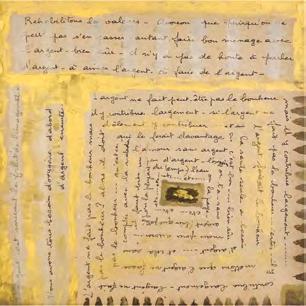
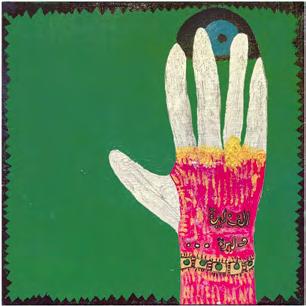
L’argent ne fait pas le bonheur, mais il y contribue largement : Écritures, 1994; Les mille et une livres libanaises, 1994; Sans titre (Stockholder), 1994; Un pont en or, 1994
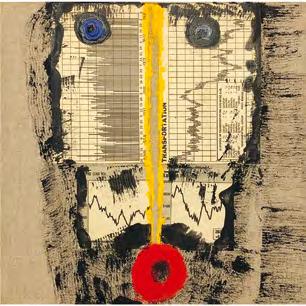
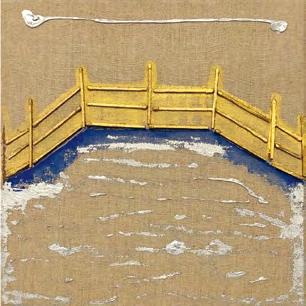
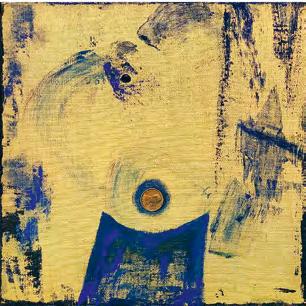
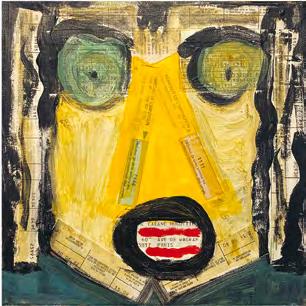
L’argent ne fait pas le bonheur, mais il y contribue largement : A Penny for Your Thoughts, 1994; Taxes . . . Taxes . . . Taxes . . . , 1994–1995; Papa Doc, 1994–1995; Commonwealth, 1994
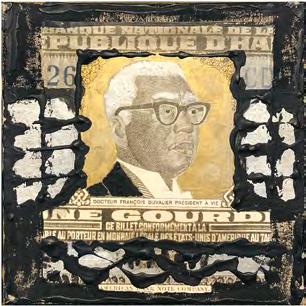
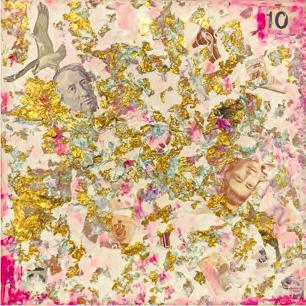
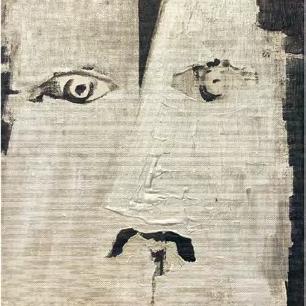
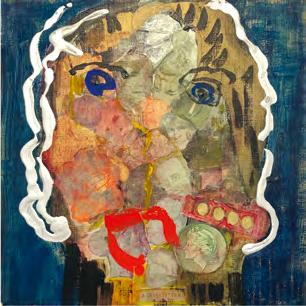
L’argent ne fait pas le bonheur, mais il y contribue largement : Mariage d’argent, 1994; Portrait (divers papiers monnaie), 1994; Danse du ventre, 1994; From Riches to Rags, 1994–1995
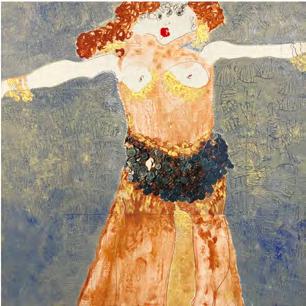
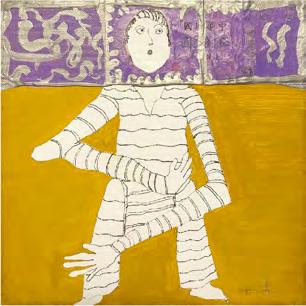
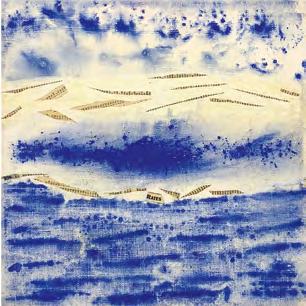
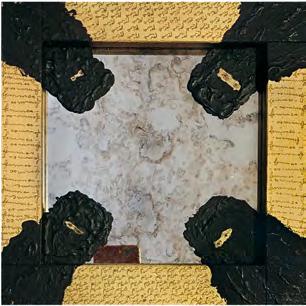
L’argent ne fait pas le bonheur, mais il y contribue largement : Floating Rates, 1994; Harem, 1994–1995; Tire-Lire, 1994; Money Contributes to Happiness, 1994–1995
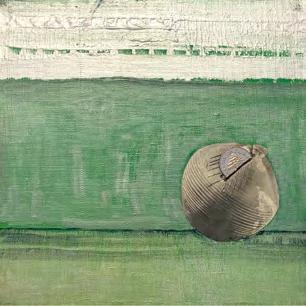
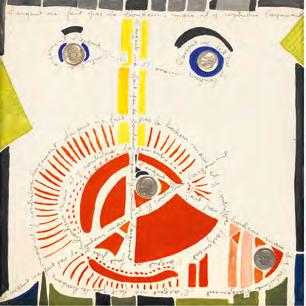
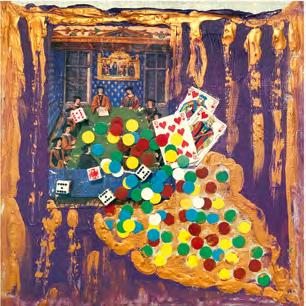
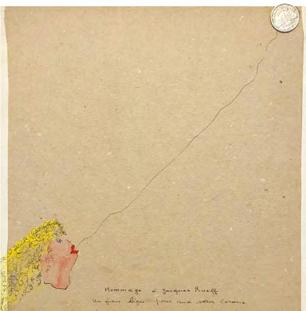
L’argent ne fait pas le bonheur, mais il y contribue largement : Jeux de hasard, 1994; Franc léger, 1994; Mon loyer à Paris, 1994–1995; In Memoriam, 1994–1995
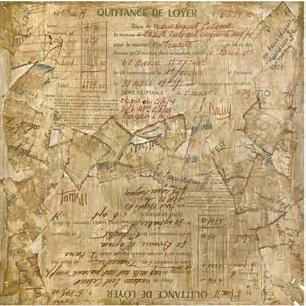
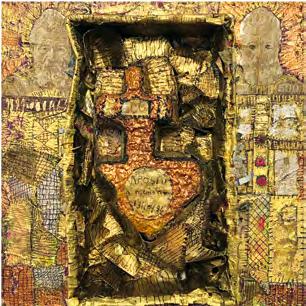
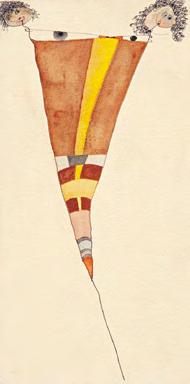
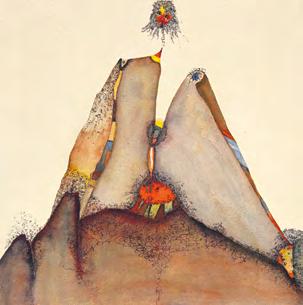
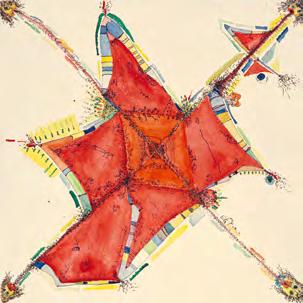
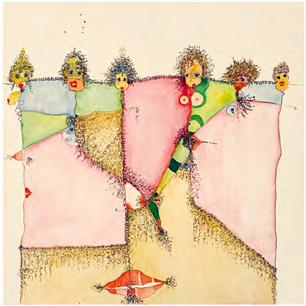
Homage to Pubic Hair, 1992
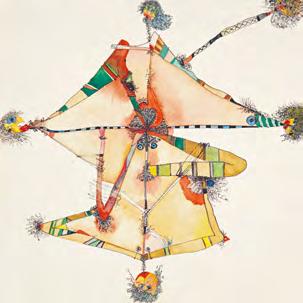
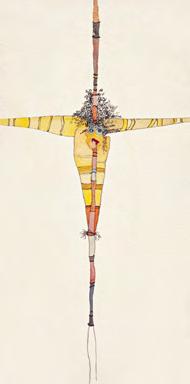
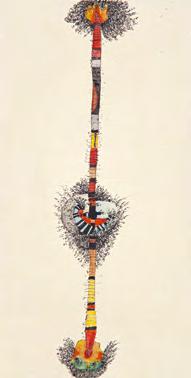
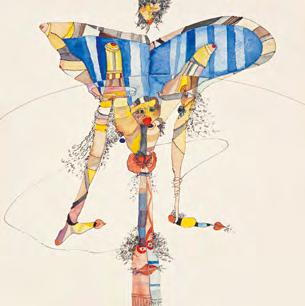
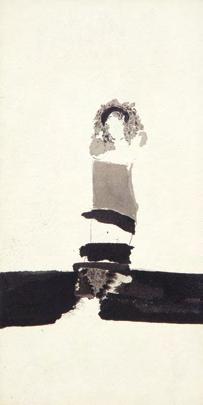
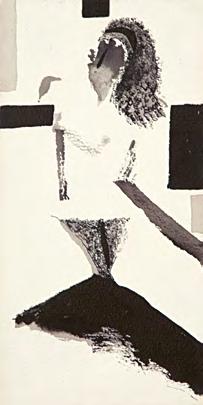
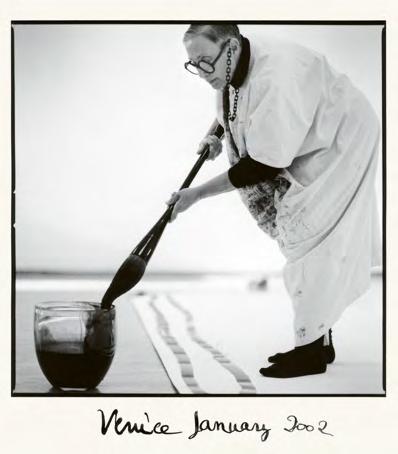
Veronique Vial, Huguette Caland painting the Silent Letters series, Venice, California, January 2002
Caland in California, Eat the Peel
Aram Moshayedi
She often recounted that she liked the way California sounded, that the words California land resembled her own name, Caland. When she moved from Paris to Venice, California, in 1987, Huguette Caland had few assurances the artistic life she sought in the Golden State would come to fruition. Determined to make it on her own in an art context that was as competitive as it was aloof, Caland followed her instincts nevertheless. The scene of mostly white men that awaited her had its own agenda, and Caland found it difficult to find outlets for her work. The 1980s are not typically regarded as a defining moment in the history of art in Los Angeles; the hangover of a generation that established the city’s artistic identity in the preceding decades had likely clouded the vision of the galleries and institutions that upheld their legacy. Artists associated with the city’s “early years”—Larry Bell, Ed Moses, and Billy Al Bengston among them—tended to dominate in the period Caland began establishing her new life. Caland relocated after struggling to maintain a career abroad, and the provincial town she now called home cared very little about artistic lineages of which its more renowned artists were not a part.
“I suffer fear, but that makes me feel alive,” she told a journalist in 1992 when her exhibition Memoirs of a Past Life opened in Santa Monica at Gallery 5; it was one of a handful of presentations she was afforded on the West Coast before her return to Lebanon in 2013.1 In the years Caland lived in Venice, she became a social
1 Huguette Caland, quoted in Alexander Eliot, “Put Caland on Your Calendar,” Los Angeles Reader, March 6, 1992.
fixture among the aforementioned artists who lived and worked in relative proximity to the home and studio she completed after an initial design by architect Neil Kaufman. By most accounts, Caland was fulfilled by her life in Venice. “I love Venice. I love every minute of my life,” she proclaimed in 2003. “I squeeze it like an orange and I eat the peel, because I don’t want to miss a thing.” 2 The life Caland imagined for herself was of her own making; the context she created for her work was a response to the lack of recognition she received from her peers as well as the galleries and institutions she initially looked to for support. Lacking sizable acclaim during her years in California, Caland’s work has finally come to occupy the place of value it had been denied during her lifetime.
Anecdotes from students of the late John Baldessari— another resident of Venice—corroborate how isolated the context was likely to have been at the time of Caland’s arrival. While teaching at the nearby California Institute of the Arts in Valencia, California, throughout the 1970s and 1980s, Baldessari was known to return from his European travels with suitcases full of books and catalogues. Artists attending his classes would pore over the pages and access a world of art that would otherwise have been foreign to them. In the years that established Los Angeles as an “art capital,” few other artists seemed to imagine a world beyond the city’s borders. Allen Ruppersberg, Douglas Huebler, and William Leavitt come to mind as early aberrations, having established relationships to Europe in the 1960s through the Amsterdam gallery Art & Project and its bulletins, as well as their connection to the Dutch artist Bas Jan Ader and other proponents of conceptual art’s portability. The artist Martin Kippenberger moved to Los Angeles in 1989 for a brief stint, assuming partial ownership of the Venice restaurant Capri shortly thereafter, and eventually concretizing the city’s relationship to Cologne. As few and sporadic as they are, examples such as these show signs of an international perspective, confined as it may have been almost exclusively to Western Europe. Any other geographic relationships to Los Angeles are only now
2 Huguette Caland, quoted in Anne-Marie O’Connor, “Her Magical World,” Los Angeles Times, June 19, 2003.
Aram Moshayedi
coming to the fore, with enough critical distance to acknowledge the role that non-European practitioners have had in shaping the city’s artistic identity over time. 3
When Caland arrived in Venice she brought more than a sensibility that had been cultivated in Paris, where she had lived from 1970 to 1987. A creative and romantic partnership with the Romanian sculptor George Apostu appears to have had a significant impact on Caland’s conception of herself as an artist; it was his untimely death that initiated her relocation. Now in Southern California, Caland was considered by her artist peers upon her arrival as being “from different intellectual roots” and occupying “a different point of view” that may have even been “a little bourgeoise,” and her Lebanese origins were likely to have been something of an anomaly in the art context she sought to adopt as her own. 4 In November 1992, Caland’s inclusion in a presentation organized by the International Council for Women in the Arts situated the artist in the context of other Arab American women artists, such as painters Ghada Jamal and Seta Manoukian, living in Los Angeles. A related touring exhibition titled Forces of Change: Artists of the Arab World was organized by educator Salwa Mikdadi, but these instances are among only a handful of occasions when her presence in the city was offered curatorial context or framing. 5 Caland was able to fulfill the role of Arab artist in exhibitions such as these, though she was denied the pleasure of being an artist without an identity modifier alongside artists and others who she considered contemporaries and close personal friends.
3 The launch, in 2011, of the Getty Foundation’s ongoing Pacific Standard Time initiative has helped to support research into the broader history of art in Los Angeles since 1945.
4 “Sandy Lajer, Ed Moses, and Robert Wilhite in Conversation with Aram Moshayedi,” in Made in LA 2016: a, the, though, only, ed. Aram Moshayedi and Hamza Walker (Los Angeles: Hammer Museum; New York: DelMonico Books Prestel, 2016), 42–53.
5 This exhibition was organized by the International Council for Women in the Arts and the National Museum of Women in the Arts and toured four US cities between 1993 and 1995. See Salwa Mikdadi Nashashibi et al., Forces of Change: Artists of the Arab World (Lafayette, CA: International Council for Women in the Arts; Washington DC: National Museum of Women in the Arts, 1994).
187
At the time of her arrival, few if any artists from West Asia had made their mark on the art worlds of Los Angeles. Brash, outgoing, and sexually direct—one can imagine how incongruous this woman must have been with the West Coast slacker vibes and cool conceptual aesthetics that laid claim to the city’s artistic identity. Sifting through the slight, barely perceptible traces of Caland’s exhibition history in Venice (and Los Angeles, more broadly), it seems as if her persona and experiences of the world were detrimental to her pursuit of recognition. One wonders what kind of threat her difference posed to local sensibilities, to artists who were friends and acquaintances more than they ever allowed themselves to be her artist equals. 6 Her sexual attitudes and the bodily nature of her work may have exposed the repressed desires of those around her.
Caland’s career ambitions—really the longing for her art to be seen—were fortunately sustained during this period elsewhere in places like Lebanon, where Janine Rubeiz provided an outlet for exhibitions every three or so years beginning in 1997. Many of the paintings, drawings, and sculptures produced by Caland in the years after her move, however, were unexhibited in her lifetime. She remained committed despite the few opportunities available to her. The studio practice she maintained was largely an outlet for her pursuit of an interior dimension, an inward turn toward quietness, meditative repetition, and silent contemplation. Caland was outgoing and social—a consummate host of elaborate parties and dinners for friends and out-of-town guests alike—but her life in the studio was somewhat solitary by comparison. The work she made in Paris and Beirut prior to her move was exuberant and loaded with sexual energies and orgiastic pleasures; but in Los Angeles there is a discernable shift in the work of someone much more isolated from the temperaments of their desire, from the whims of their body, and from the erotic world they once inhabited without inhibition.
6 Ed Moses later recounted, “She didn’t have the connections to show her paintings in Los Angeles. The only people who knew about her at the time were those like me and Bob [Wilhite], who hung out at her place. It was kind private—it was well-kept secret, let’s put it that way.” “Sandy Lajer, Ed Moses,” 47.
Aram Moshayedi
Of the many self-portraits completed in her lifetime, Self-Portrait in Smock (1992; p. 20) privileges an absence of identifying information. In the abundant paintings and drawings of herself as subject, Caland typically exhibits a tendency to exaggerate, elongate, and pervert her facial features and other parts of the body. The Bribes de corps series initiated in the 1970s imagines fragments of the artist’s body as minimal topographies, as sexualized landscapes for fantastical projection. The series discloses Caland’s fixation with her physical size and proportion in a manner that is playful and defiant. Large, soft expanses of color give way to barely perceptible fleshy backs of knees, cavernous folds of skin, and butt-crack canyons. As she continued to evolve the body bits or parts of the 1970s, subsequent paintings and drawings rendered in her likeness emphasize agape mouths, phallic noses, and other signifiers of Caland’s desirous preoccupations. There are few moments in Caland’s prolific output when she is not rendered without some variety of sexual innuendo or compromise.
Self-Portrait in Smock offers an earnest antidote to the more sexually suggestive depictions that surround it in Caland’s oeuvre. The painting depicts the artist’s identity as she may have imagined it—faceless, devoid of any distinguishing features, without physical attributes other than a ribbon of neatly parted gray hair that outlines the shape of her head. Caland’s painter’s smock, which she began wearing in the studio twelve years earlier, in 1980, is the painting’s more discernable subject (p. 20). Unlike the expressionless, featureless face that sits atop an elongated neck, Caland’s attire suggests an index of painterly marks and gestures. It offers a character study of creative expression and painterly process. In the expanse of white that occupies the painting’s center, Caland not only mimics the fabric of her daily uniform, but she also creates a painting within the painting, a world of expressive freedom divorced from the realities of her pursuits elsewhere for recognition. Above all, the painting puts Caland on display as an artist, not necessarily bracketed by other markers of identity such as woman or Arab.
As an artifact, the smock contains within it proof of Caland’s labor; it is the result of her time in the studio and the accumulation of her life in art. It is evidence that she is an artist.
Self-Portrait in Smock monumentalizes her practice as a ritual activity; it is a portrait of the artist unburdened by the self, as told through the tools, the clothes really, of the trade. Each daub of paint represents an accrual of meaning that mimics what would have otherwise been accidents in the studio—an overly saturated paintbrush, a pallet knife caked with oily pigment, a dirtied finger. Self-Portrait in Smock ’s most telling detail resides not in an accurate portrayal of Caland’s likeness but in the deliberateness with which she communicates the haphazard by-products of being an artist. The smock becomes a stand-in for painting as a daily practice, as a pursuit with an indeterminate measure of success and failure. There is also a confrontational defiance to Self-Portrait in Smock that makes it distinct within Caland’s body of work. Even without eyes, nose, or mouth, the face of the artist in the painting is eerily direct. As much as it may be an empty surface where an imagined viewer might project their own fantasies onto Caland, the mute face undermines the relations of power that are inherent to art’s judgment and critique. Rather than answer the question of what it represents, Caland’s blank painted stare seems to quip back in the manner of an Ad Reinhardt cartoon, “What do you represent?” 7 Meanwhile, she reveals the vulnerabilities of being an artist, the malleability with which artistic identities may be formed, and the precarious balance between ego and ambition in the pursuit of acknowledgment. The self-awareness she exhibits in the painting is underscored by both conviction and doubt—contradictory impulses that may have also put her at odds with the overconfident, celebratory art establishment to which she was proximate at the time. Though similar ambivalences are common enough among artists, they seem to be rarely advertised as thoroughly and bitingly as in Self-Portrait in Smock.
In the years that followed, Caland’s Silent Letters series continued to evade recognition (see some examples on pp. 195–204).
7 Editor’s note: In the cartoon, a spectator comments before an abstract painting: “Ha Ha What Does This Represent?,” to which the painting angrily replies: “What do you represent? ” The cartoon is part of a satirical series on abstract art that Ad Reinhardt did between 1943 and 1947 for the New York tabloid PM (emphasis mine).
Aram Moshayedi
Initiated in the early 2000s and mostly executed on various papers and fabrics, the works in this series subscribe to a visual vocabulary that is reductive by nature. Their basis is the repetitive mark of a brush as it encounters the surface of a substrate. Excreting its quantity of acrylic paint, the brush is dragged in a single direction, in a sequence of imperfectly repeated straight lines. The effect produces a soft gradation of pigment in horizontal and vertical geometric patterns. Though it’s unlikely Caland would have been aware of the affinities between them, the material qualities of this gesture call to mind Lee Ufan and other South Korean Dansaekhwa artists whose works are characterized by the idea of “monochrome painting.” Caland’s Silent Letters bear similarity to German Italian artist Irma Blank’s decades-long practice of “drawing language.” Like Blank’s drawings that mimic text formatted to a printed page, or even Hanne Darboven’s handwritten tabulations, Caland’s Silent Letters are destined to remain unread and withholding of their content. The works in this series seem to communicate the very idea of communication through a gesture that on its own says very little.
Caland’s untitled work (2011; fig. 1) offers a reservoir of blank expression. The large rectangular expanse of paper is divided into four relatively equal parts. The brush marks are rendered in oil paint. There is a quality to the repeated gesture that warps the overall image and gives the impression of lines that optically bend the paper. Though there is a deliberate wordplay relating to the illegibility or inaudibility of the letters on a page or letters of an epistolary nature, Untitled, as part of the Silent Letters, is the by-product of a formal exercise. Like in other works in the series, Caland appears to test the limits of material experimentation, revealing how much variability and versatility resides in a single gesture. The process by which this work came to be may have been as precise as it was laborious, but the result provides enough visual seduction and pleasure to satiate the eye that feeds upon it.
In the context of Caland’s more overtly erotic art in the years that preceded her move in 1987, it is worth asking how or why she eventually arrived at such formal severity and conceptual reticence. Though seemingly noncommunicative—by her account they are “silent”—the question remains: What do works of this nature
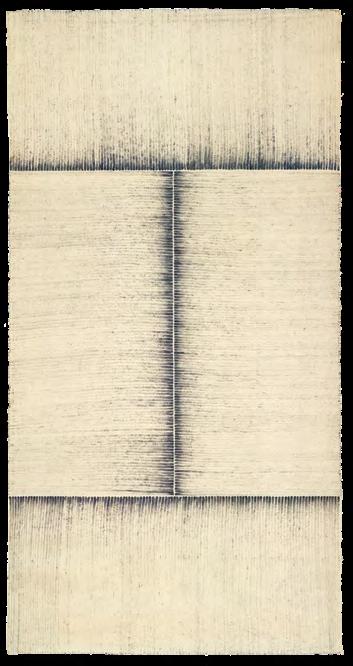
Fig. 1: Untitled, 2011
Aram Moshayedi
say about the artist’s sexual preoccupations that had previously been so important to her and her art? Caland moved looking to extend the progression of her artistic journey and arrived instead in a place of reduction, repetition, and relative sobriety. It is a curious turn, one marked perhaps by the cautiousness and sexual conservativism of the context in which she was then living. In the apparent austerity of Caland’s later work that followed her move to California—as densely woven and maximalist and tapestry-like as it may be—the artist communicates more about the desires of those around her than the desires she once expressed without abandon. Caland’s occlusion by other artists reveals the threat her work posed to their own personal aspirations, not only because she was a woman with a sense of the world beyond the cities she inhabited but because her sexuality would have been an affront to their own.
Postscript
The first time I was made aware of the name Huguette Caland, it was offered to me by the artist Robert Wilhite, who suggested that I meet her in the studio they once shared in Venice. The year was 2011, and Wilhite described a friend whose work was “far-out.” It was a description that did not exactly connect to my interests at the time, so I never followed up for an introduction. A few years later, I stumbled into the booth of Galerie Janine Rubeiz at an art fair in Dubai and came upon an artist who, I was told, had, until very recently, lived in Venice and produced an impressive body of work there. I was immediately amazed that I had stumbled on an artist whose paintings seemed so rich and who, apparently, had a direct connection to the context where I had been living and working as a curator since 2004. At the same time, I was suspicious that I had never heard the name Huguette Caland despite the many conversations I had had over the years with artists like Larry Bell, Billy Al Bengston, John Baldessari, and others who were her contemporaries in Venice. It never occurred to me that this artist was the same that Wilhite once recommended I meet. The name obviously didn’t stick in my memory, and Wilhite’s work, to my mind, had centered around design, applied arts, sound sculptures, and his collaboration
in the 1970s with Guy de Cointet. This seemed very far from the world of Caland that I was then just barely getting to know.
Later that year, I made my way to Caland’s storied studio and residence in Venice, where she lived until her return to Lebanon in 2013. As I toured the collection of artworks by Caland and other artists installed throughout the house, Caland’s daughter, Brigitte, pointed out a small, minimal sculpture affixed to the ceiling that I immediately recognized as a work by Wilhite. I was confused at first. As impressed as I had been with my tour of Caland’s studio, at no point did an association with Wilhite or his words “ far-out” come to mind. But suddenly everything clicked, and I realized I was where I should have been years ago when Wilhite entrusted me with his recommendation.
In the years since that first encounter, I have had to piece together an impression of Caland from the artworks and relationships she left in her absence. Regrettably, I never had the pleasure of meeting her, though the sense of the artist I have gleaned provides delightfully contradictory impressions of the glamour, rigor, and mischievousness she once embodied. Though I did not heed Wilhite’s recommendation in a timely enough manner, I am still ever grateful for his recognition of her contribution and his initial insistence. Where it seems other artists may have been threatened by her success, fearful of the attention she might have received at the expense of their own, Wilhite was the only artist of her circle I encountered courageous enough to recognize the value of her work and the unique perspective it represented.
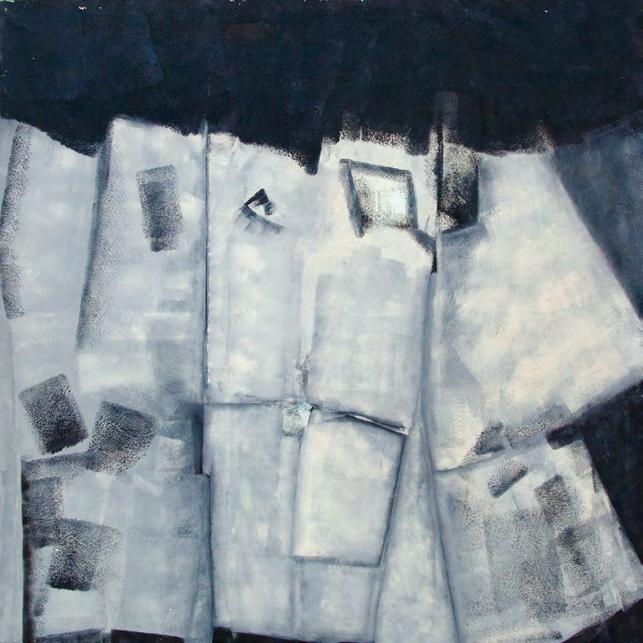
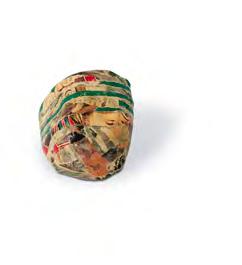
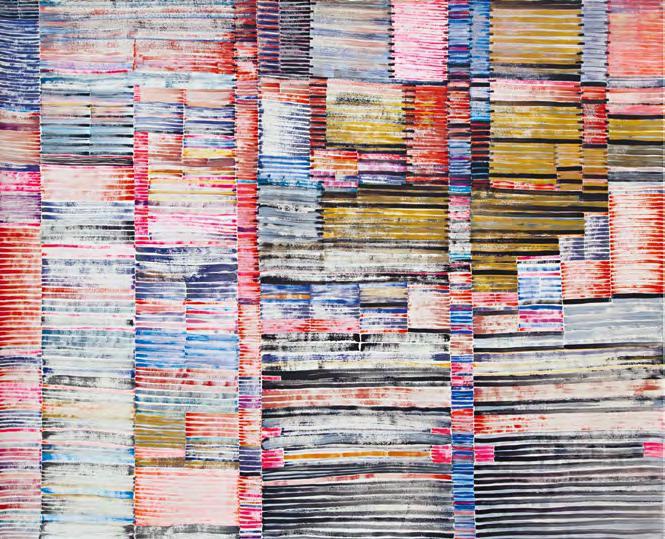
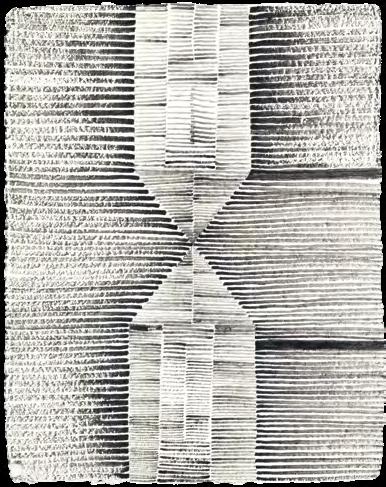
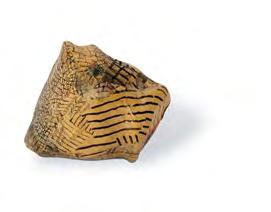
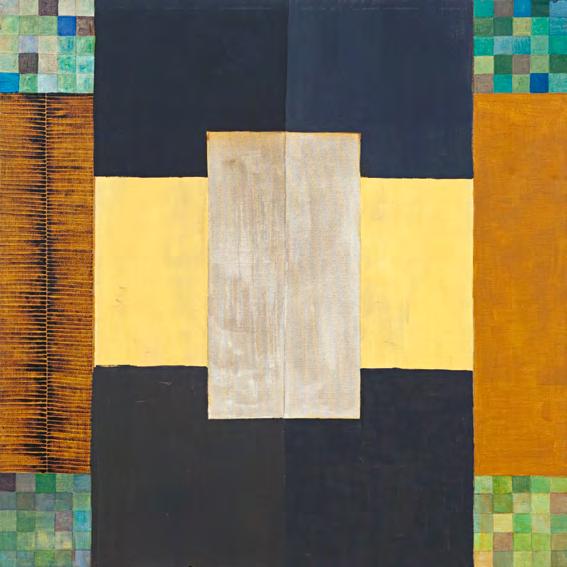
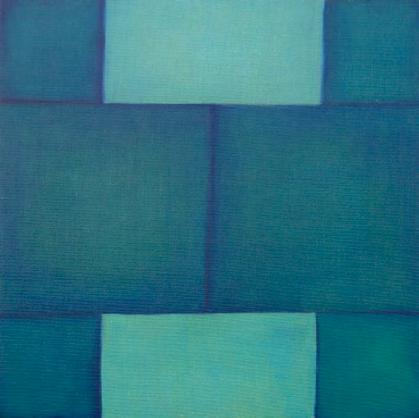



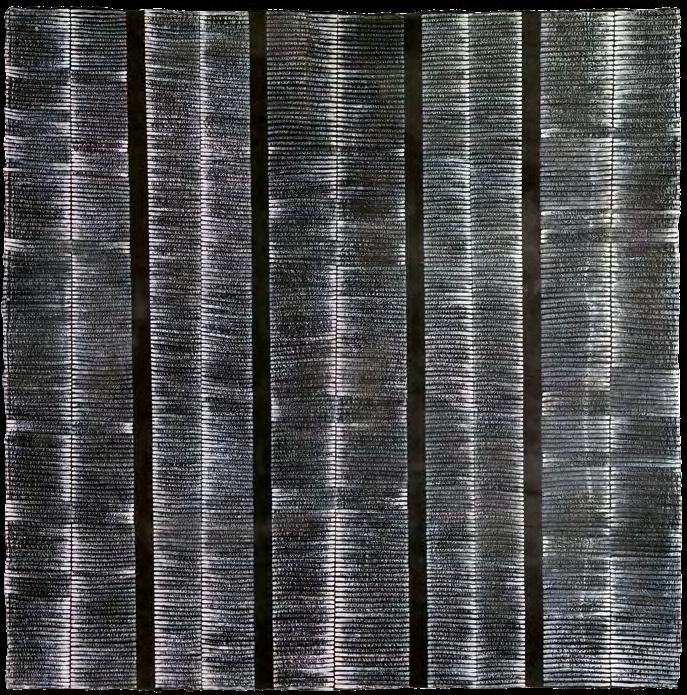
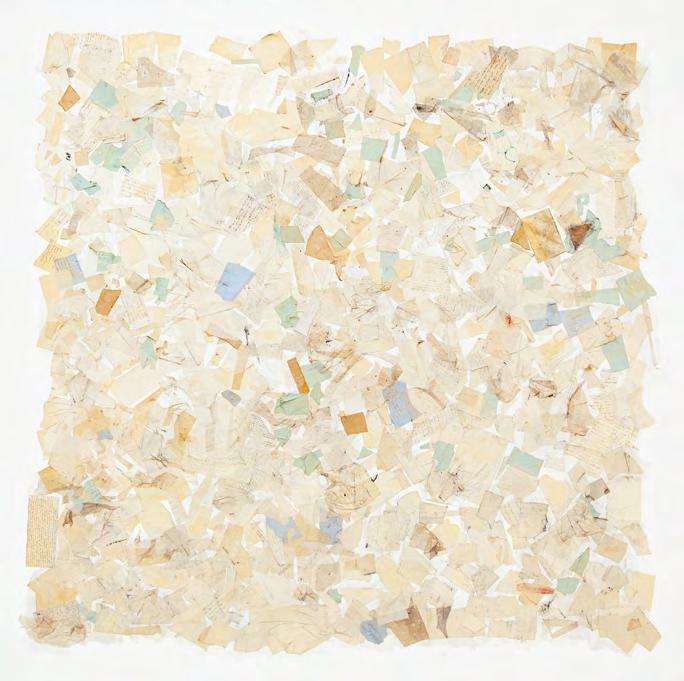
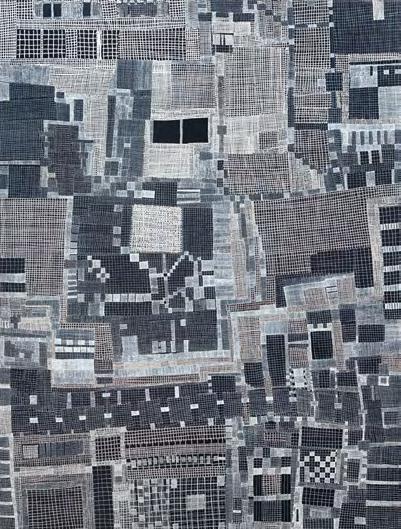
When Anatomy Becomes a Map
Maite Borjabad López-Pastor
The Map Stage Is the First Level of Urban Love
Learning how to relate to a city is always full of friction. It is quite paradoxical, this having to domesticate the city, to make it inhabitable, and finding ways to belong to it when the premise of the urban, the city, is that it is a human-made artifact meant to “facilitate” negotiations necessary for the survival of the human body within changing “natural” environments. In fact, cities are more about regulating bodies—about imposing social and cultural order—than they are about sheltering. Belonging, nesting, and sheltering in a city are processes that the disciplines tasked with planning, urban design, and architecture seem to remember only at times. Designing a city is not the same as “making” a city. Navigating through Huguette Caland’s paintings of the various cities in which she made a home, I feel like a voyeur examining her relationships, guessing how she managed to make each city hers.
In his text “Agoraphilia,” Paul B. Preciado explains “the relationship between happiness and falling in love in the case of cities, as with humans, animals, or even spiritual devices, is not directly proportional. [. . .] It is not being from a city, or how much time is spent there, or living there that determines the possibility of urban infatuation.” 1 Thus, he describes how, despite the years spent there and how formative New York was for him, that city can only be considered an acquaintance of his, whereas it was Paris he
1 Paul B. Preciado, “Agorafilia,” Parole de Queer (blog), December 16, 2015, https://paroledequeer.blogspot.com/2015/12/agorafilia- por-paul- bpreciado.html (all translations mine)
fell in love with, as it became “the prosthetic home he never had.” 2 If Paris was his spouse, Barcelona later became his lover, while at the time he was writing this article, he had already set his eyes on a new crush, Athens.
The truth is, I don’t know if I have ever fallen in love with a city where I have lived. It seems easier to fall in love with one you are passing through, or, more likely, one you contemplate nostalgically from afar, that city where you lived in the past, rather than one you experience through daily habits in the present. I wonder if that was Caland’s relationship with Beirut, loving her from the distance of nostalgia . I don’t know if Caland fell in love with Paris, Los Angeles, or Beirut. I explore versions of those three cities, especially Beirut, through Caland’s paintings and her incessant drawings that recapture the city over and over again. At times I wonder if it is a city that she draws, or her city, or perhaps cities or versions of them that have not yet come into existence. I can’t decipher how much of it is LA or Huguette’s LA. Beirut, her native Beirut or her desired Beirut, imagined and dreamed of from the distance of Los Angeles.
Much has been discussed about Caland’s life, the personal choices that drove her to one city or another, and her partners and lovers, as if they were the most central to her practice. But which city did Caland fall in love with? Which one was perhaps just an acquaintance despite long periods there and formative experiences? Was any of these cities her wife? Which was her lover? Perhaps all? Cities as much as bodies were a constant in her practice, an incessant obsession birthed through unique representations and almost compulsive scribbles.
“The map stage is the first level of urban love: it takes place when you feel that the cartography of the beloved city imposes itself on all others. Falling in love with a city is feeling while strolling through it that the material boundaries between your body and its streets blur, that the map becomes anatomy.” 3 Almost like a spell reversing these words by Preciado, Caland’s anatomy becomes a map through her own work. Her own anatomy will be one of the first
2 Preciado, “Agorafilia.”
3 Preciado, “Agorafilia.”
Maite Borjabad López-Pastor
she maps but not the only one. Bodies of friends, lovers, acquaintances, and strangers also become maps. Joyful maps sometimes, but also claustrophobic maps. In many of her line drawings from 1971–1973, through the incessant exercise of tracing and retracing, bodies are rewritten again and again, aggregated and contorted until they fragment and recompose once again. Of specific nuanced erotism are the line drawings in the series Flirt, which appeal to two radically different scales at the same time—that of the intimacy of the body and that of the vast immeasurability of the landscape. When looking at them without noticing the title, one might imagine them to trace divisions in the landscape, as in Flirt I (1972; p. 102). A line that seems to be dividing two landscapes or maybe two mounds of earth. Stepping back from this view and considering the title, and then looking more closely on a human scale, only then does the landscape transform into a glimpse of two lips, maybe two noses touching, locked together. This lightness in the touch of the fine line is later followed by the colored painting series Bribes de corps where body parts, organs, or fragments of them, knees, asses, lips . . . expand and aggregate to end up also as maps. These will later lead, in some of her latest works, into more abstracted geometries, to allow the body, the urban, the rural, and the land to end up intertwined in unprecedented ways. She will collapse together radically different scales, creating different visual imaginaries that suggest subversive ways we can bring these concepts together. With Caland, it is not only about inscribing bodies in the landscape but really making landscapes and urbanscapes through bodies and body parts. In her 1973 ink-and-oil-on-canvas painting Bribes de corp s (fig. 2), a yellow background articulates what can
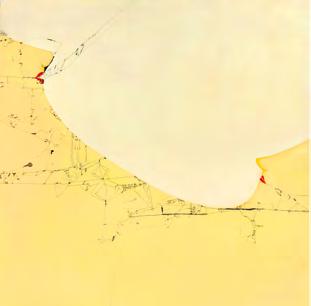
be read immediately from afar as the Saint George Bay in Beirut, bracketed between the two poles that contain it, rendered here as two sets of red lips poised in a kissing gesture. As Hannah Feldman describes it, this is a “bay as body and kiss as urban topography.” Upon looking closer, the fine black lines that seemed to be the hatch marks of urban space seen from a bird’s-eye view start to appear as faces, legs, or stretched-out bodies. As with any urban topography, thicker lines mark a hierarchy in contrast with fine ones, intersections produce thicker black points, and so on. Here, the urban vocabulary is present, producing a rendering of the urban, but instead of black thicker dots like you might see in a “regular” map notation, these black dots might show up as a shoe, a bush, a vagina, or an eye, while legs, torsos, and body parts stretch until they touch the next one to create the continuity of the streets and avenues. Through maps you can learn about a city without having been in her. I have never been to Beirut: What does it mean that two sets of lips facing each other are embracing its bay? One of the sets of kissing lips was the port, and I say was because “on August 4, 2020 large parts of the city built against the Bay of Beirut, which was both safe harbor to the Port of Beirut but also essential to the compositional logic of so many of Caland’s works” were destroyed in an explosion that took the lives of 206 souls, while hundreds of thousands of people were left injured and homeless, and property damage reached into the billions. 4 Those urban hatchings, those fine lines representing streets, urban lots, pathways—which on Caland’s canvas were stretched-out legs, body parts, faces, torsos—were erased. As of the writing of these lines on August 4, 2024, it is impossible to write about Caland’s painting of Beirut without mourning the fourth anniversary of the explosion and the imminent threat of more destruction facing this city in light of Israel attacks perpetrated as part of the continuing genocide in Palestine. Maps are registries of what exists but also of what could be destroyed and won’t exist any longer as such in the physical realm—though it will forever exist on the map. Maps resist erasure. Two sets of kissing lips hold the Bay of Beirut in Caland’s map.
4 Hannah Feldman, “Drawing the Routes and Roots of a Body as a City and a City as It Moves across Space and Time,” in Huguette Caland: Tête-à-Tête, ed. Joanna Ahlberg (New York: The Drawing Center, 2021), 46.
If to live is to leave traces, not necessarily only on the world but also within oneself, as the artist and poet Etel Adnan reflected at the end of her life and made palpable in her last book, Shifting the Silence, then each experience, each encounter, marks us in ways we may not immediately perceive. 5 Or as she writes in The Beauty of Light , “The trace, to leave traces, must be very vital, it must be a very deep-seated need within us.” 6 These marks accumu late, layer upon layer, shaping who we are and how we see the world. We become a palimpsest of memories, desires, and dreams. Escaping the confines of one’s immediate surroundings can be a way to peel back those layers, to discover what lies beneath the surface of our daily lives. “What does it mean to belong to a land? For those of us who live away from our private history, the question never heals,” writes Adnan in her book Sea and Fog, almost as a prayer.7 I wonder if Caland’s incessant acts of drawing bits of a landscape, of a city, of urban surroundings, of the Bay of Beirut, are in themselves desperate acts of belonging, expressions of a desire to hold a city, to craft her own. Crafting your belonging to eventually make the map of it becomes your anatomy. Maybe to leave, to escape, is also to belong, because you carry your land within you, as a book and as a map?
Bodylands
I can’t stop seeing the ways in which many of Caland’s paintings and drawings, much like a soundtrack for a film, might serve as the “maptrack” for feminist theorist Elizabeth Grosz’s critical reflections on the making of urban space in relation to the body, sexuality, and the city. In her seminal essay “Bodies-Cities,” Grosz challenges questions about the mutually defining relationship between the body and the city, articulating urban space as something physical but also
5 Etel Adnan, Shifting the Silence (New York: Nightboat Books, 2020).
6 “If I have done it, it’s because I needed to return to it. Even now that I can’t write, that I can’t read, I can draw. The trace, to leave traces, must be very vital, it must be a very deep-seated need within us. We see it in the rock paintings of the person who drew a cow at Lascaux; she had a particular impulse, a particular need.” Etel Adnan and Laure Adler, The Beau ty of Light , trans. Ethan Mitchell (New York: Nightboat Books, 2023), 92.
7 Etel Adnan, Sea and Fog (New York: Nightboat Books, 2012), 82.
imagined. She explores the ways in which the body is psychically, socially, sexually, and discursively or representationally shaped by the city, and how bodies, in turn, imprint on and express themselves in their sociocultural surroundings. This interaction causes the environment to both shape and reflect the body’s form and interests. This reciprocal relationship of internalization and externalization reveals a complex feedback loop: “The city is made and made over into the simulacrum of the body, and the body, in its turn, is transformed, ‘citified,’ urbanized as a distinctively metropolitan body.” 8 As a maptrack to these thoughts and words, Caland’s pieces testify to a profound yearning for a life enriched by the freedom of sex ual ex pression. She manipulates and celebrates the limits of the body and manipulates and celebrates all types of bodies without judgment. In her text, Grosz critically foregrounds the parallels between the body and social order (which could be identified as the state). There is a notable similarity between the human body and the body politic, which is often codified: the king, or similar leader, is typically seen as the head of the body politic, while the populace represents the body. Laws are compared to nerves, the military to arms, and commerce to legs or the stomach. These correspondences may differ between texts and political regimes, but despite the widespread use of this metaphor of the body politic, the body is rarely assigned a sex. 9 As Grosz proposes, if we push this metaphor a little further, we must ask: “[I]f the state or the structure of the polis/city mirrors the body, what takes on the metaphoric function of the genitals in the body-politic? What kind of genitals are they? In other words, does the body-politic have a sex?” 10 The answer is the implicitly male-centered nature of the body politic. Even though the body politic is supposedly modeled on the human body,
8 Elizabeth Grosz, “Bodies-Cities,” in Sexuality and Space, ed. Beatriz Colomina (New York: Princeton Architectural Press, 1992), 242.
9 “This notion of the parallelism between the body and social order (usually identified with the state) finds its clearest formulations in the seventeenth century, when liberal political philosophers justified their various allegiances (the divine right of kings, for Hobbes; parliamentary representation, for Locke; direct representation, for Rousseau, etc.) through the metaphor of the body-politic. The state parallels the body; artifice mirrors nature.” Grosz, “Bodies-Cities,” 246.
10 Grosz, “Bodies-Cities,” 246.
it uses the cis male body as the standard, thus leading to an abundance of phallocentric metaphors that corporealize cities. As Grosz argues, phallocentrism isn’t just about the dominance of the phallus; it’s about the widespread, often unrecognized use of the cis male or the masculine to represent humanity. The challenge, therefore, is not necessarily only to eliminate this bias but also “to reveal the masculinity inherent in the notion of the universal, the generic human, or the unspecified subject.”11
The abundance of phallocentric morphology, symbolism, or functionality in cities is nothing new but is nonetheless asphyxiating. Also not new is the sexist bias of urban planning and the accompanying “body politics” that becomes the regulation of bodies (all of them). For so long, this problem has been approached on the large scale of the disciplinary tools of urban planning itself, which is a bit of a trap in and of itself as it eliminates the very presence of the body as a matter of scale and representation. Urban planning operates using a bird’s-eye view, where the city, the urban, and the nonurban (the rural) are seen from afar and where bodies are never represented: if you are scaling down kilometers of space, not even a dot would represent a human body on the proper scale. It is almost ironic how much the female body is regulated through the body politics of urbanism but how the body cannot even be represented following urban planning’s own disciplinary rules.
If we understand, as established by Grosz, how constitutive and mutually defining the relationship between corporeality and the metropolis is, we cannot hope but for an overflow of inscriptions of queer and feminist bodies and body parts as a counterweight to the overly phallocentric morphology of this biopolitics. There was and there is a need to keep inscribing (functionally, morphologically, and symbolically) the female body, the queer body into the urban. Here the first radical act, which Caland’s pieces handle with extreme virtuosity, manifests as a break in scale: this allows for a resilient liminal reality where a face and an urban lot, a hand and a building, a breast and a whole city, a lip and a bay, a vagina and a river can be represented together, and thus they can be thought of together on
11 Grosz, “Bodies-Cities,” 247.
the same hierarchical level. And I cannot help but think of Caland as part of the line of artists, architects, and urbanists who literally inscribe their bodies into the map, into the city, into space. The photo capturing the body of Denise Scott Brown in front of Las Vegas desert off the Strip, or the Femme Maison painting series by Louise Bourgeois where the head becomes a house or an institutional building, while the torso, legs, arms, and cis female genitalia remain visible and in human form, sometimes with the building even extending up to the pubis or replacing the stomach. Or renowned Iraqi British architect Zaha Hadid’s only known self-portrait, where the head remains human while her body has become not even a building but a whole topography, “organized” not by grid-like urban fragments but by distorted, deformed lots that represents Hadid’s unique ar chitectural vocabulary. Meanwhile after navigating through many of Caland paintings, specifically her Bribe de corp s paintings and the drawings that preceded them, one naturalizes their new scale, reading “leg, mountain, lip” as if they had always represented the “normal” order of things and the “natural” relational scale. If we view those paintings as topographic or cadastral maps, what would a place that emerges from them look like? How does it feel to navigate across the topography of a leg-mountain-lip? These paintings truly shift the perceptive order by unleashing an array of images that radically inscribe bodies into space, and even bodies into other bodies, challenging and altering all preconceived urban imaginar ies. I wish that the many “groundbreaking” urban hypotheses and proposals of universal urban grandeur, which shaped the modernist past that bleeds into our current urban present, would have taken some of these paintings as their point of departure for their planimetric maps, their topographic organizational systems, and their cadastral layouts.
In her 1971 Self-Portrait (Bribes de corps) (p. 84), Caland draws something like a scribble in which one can intuit a kind of vagina and pubic hair that penetrates into the ground and hosts inside a slender flower—a vagina and its bush that become roots, that become the ground. Her self-portrait allows her to be the terrain, the land. It is here where body politics and political bodies call for new imaginaries to shape the city, which shapes the body,
Maite Borjabad López-Pastor
which shapes the city—with Bourgeois making female heads become buildings, Hadid making her torso become the urban strategy map, and Caland making her sexual organs become the land.
Disorienting to Fall into Place
Urbanscapes, gardens, or imaginary landscapes are recurrent tropes in Caland’s paintings. Some of these representations draw from what can be identified as childish symbolic representations of each element: a house with a peaked roof as the symbol for the urban, flowers with petals for the garden . . . and so on. Others later become more abstract, effecting a representational trick not necessarily through symbolic tropes but planar twists. Breaks in scale become recur rent, a house becomes the size of a flower or sometimes smaller. In fact, Back from Lebanon (2012; fig. 3) or Thank You Annette (2012), houses are planted as flowers are. The canvas is as much a garden of flowers as it is a garden of homes. When analyzing the compositional logic of the former painting, what looks like a floor plan view becomes a kind of elevation or a section view as you advance through the canvas. You see a house, you identify (in the painting) the ground underneath that house, you keep moving your eyes across the canvas, now the house is upside down, forming a new ground, but it actually makes sense. A few other houses are rotated ninety degrees, and it looks like they are hanging or most likely climbing upward. It makes sense. They are not floating, they have their own relational logic of space, they have their own ground. However naive some of these representations might seem, they are all equally irreverent toward all systems for representing space (perspective, axonometric views of all sorts, planar views using plan-section-elevation) and thus toward the political grounds those systems articulate. There is something
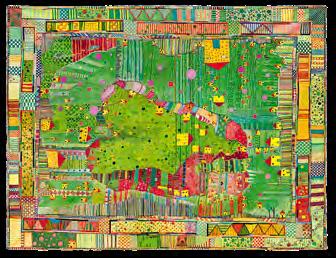
Fig. 3: Back from Lebanon , 2012
politically resilient and liberating (due to the lack of control) in children’s representations of cities. The politics of representation are the politics of vision, of the production of space and time. If we unlearn them all, we might be able to draw and, thus, think through the representations of alternative political systems. Maybe some of these paintings are rehearsals for unlearning representations. Rehearsals of political dreamscapes.
In her text “In Free Fall: A Thought Experiment on Vertical Perspective,” the artist and critical theorist Hito Steyerl describes our current era as characterized by a “prevailing condition of groundlessness.” Without a stable ground there is no reliable base for metaphysical claims or foundational political myths, leaving us with only temporary, contingent, and partial attempts at grounding. Experiencing falling can feel like floating, she writes, and as falling is inherently relational, sometimes you might not even notice you are falling. As one falls, “the horizon quivers in a maze of collapsing lines and you may lose any sense of above and below, of before and after, of yourself and your boundaries. [. . .] Traditional modes of seeing and feeling are shattered. [. . .] New types of visibility arise.”12 This must be the feeling of a character walking through any number of the spaces represented in the Faces and Places series or in some of the later “tapestry” paintings, like Apple Green and Green Tomato (fig. 4). The viewer has to decipher if there is a right order or orientation that sustains a definitive way of viewing and hanging these paintings. It would seem there is not. There is instead another liberation, another move away from seeing the map, and with it the city, as it was intended to be and as it was intended to order and regulate the bodies that live in it.
12 Hito Steyerl, “In Free Fall: A Thought Experiment on Vertical Perspective,” e-flux, no. 24 (April 2011), https://www.e-flux.com/journal/24/67860/ in-free-fall-a-thought-experiment-on-vertical-perspective/
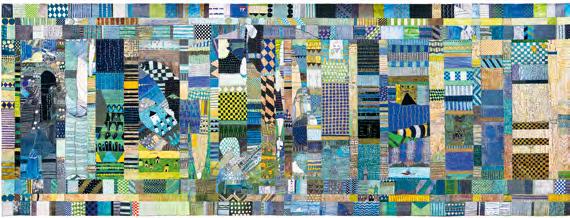
The paradigm of visuality that has long dominated our vision is the linear perspective that counts on a single, stable point of view. This mode of vision relies on the fiction of the horizon, which forms the foundation of modern concepts of time and space as stable and linear. Linear perspective establishes the perspective of a single, hypothetical observer as the standard, presenting this view as natural, scientific, and objective. However, as Steyerl observes, “ linear perspective is based on an abstraction, and does not correspond to any subjective perception. Instead, it computes a mathematical, flattened, infinite, continuous, and homogeneous space, and declares it to be reality. [. . .] This space defined by linear perspective is calculable, navigable, and predictable.”13 And, as a result, we might add: it is controllable and colonizable. The scientific appeal and objective stance of linear perspective established a universal standard for representation, connecting it to a universal truth in a way that undermined specific worldviews and subjectivities. Etel Adnan puts it this way in her book Of Cities and Women: “Although the little maps in our schoolbooks used to transport me to imaginary worlds that kept me from sleeping and practically from living, these masterpieces of cartography, these golds, leave me cold, having lost their power. The problem is that we now know the world; especially, we now know it is known, inventoried, and possessed. No land remains unowned.”14
Linear perspective developed in painterly practices into the nineteenth century. This is the period where an emerging consciousness of the impacts of colonialism and slavery started to arise and it is the moment too when the use of linear perspective starts to crumble. As Steyerl explains, “linear perspective—the central viewpoint, the position of mastery, control, and subjecthood—is abandoned and starts tumbling and tilting, taking with it the idea of space and time as systematic constructions.” 15 Steyerl continues, almost as if she were thinking of Caland, “The question of horizon starts to float.” 16 This mobilization of the horizon indeed expands in the
13 Steyerl, “In Free Fall.”
14 Etel Adnan, Of Cities and Women (Letters to Fawwaz) (Sausalito, CA: The Post-Apollo Press, 1993), 86.
15 Steyerl, “In Free Fall.”
16 Steyerl, “ In Free Fall.”
twentieth century and to our present moment where we witness an overflow of “aerial views, 3D nose-dives, Google Maps, and surveillance panoramas,” none of which portray a stable ground.17 But do not be mistaken: this freeing of the ground and the horizon doesn’t necessarily imply a liberation of the politics of vision. Instead, it articulates a kind of virtual ground that offers what Steyerl, again, describes as a “perspective of overview and surveillance for a distanced, superior spectator safely floating up in the air.”18 However emancipatory this new system of vision and its representational counterpart might seem, it isn’t. “Just as linear perspective established an imaginary stable observer and horizon, so does the perspective from above establish an imaginary floating observer and an imaginary stable ground.”19
One way or the other, the horizon has crumbled and with it, as Steyerl argues, “time is out of joint and we no longer know whether we are objects or subjects as we spiral down in an imperceptible free fall.” 20 However, embracing multiple and nonlinear horizons and perspectives can allow new visual tools to reflect on and potentially transform the contemporary state of disruption and disorientation. These new tools of vision, of orientation, and of representation are tools of imagination that break with the systematic production of space and time as linear, stable, and controllable. The resulting new modes of vision might in turn produce new tools to render different ways of ex isting in time and space. In the Faces and Places paintings as in many of the Cityscapes Caland painted in the early 2000s (fig. 1 and pp. 221–223), new landscapes and cityscapes are represented, without any perspectival order performing a “natural” view; in fact, there are many directions and orientations these paintings respond to.
17 Steyerl, “In Free Fall.”
18 Steyerl, “In Free Fall.”
19 Steyerl, “In Free Fall.”
20 Steyerl, “In Free Fall.”

Maite Borjabad López-Pastor
The logic of looking at them, portrait or landscape, up or down does not even apply, nor do they explain how they might be hung on a wall.
In Faces and Places II (2010; fig. 5), the eye follows the canvas, identifying first an organized set of marks that could be seen as agricultural lands: dots, hatch marks, and fine lines suggest soil being during the harvest . Suddenly some lots are organized, and where you would find flowers or lettuce planted, you instead find houses, drawn as though someone had planted a house in the same manner one could plant lettuce. In the upper half of the painting section, in an area where land plots seem more twisted and less geometrically organized, a finger with a red nail arises as if pulling the plots more tightly together. But then the painting forces you to turn your head ninety degrees to the right. It is the same canvas, the same orientation, but because Caland painted it in sections, folding one against or under the other, you are now on a new horizon. There, you see houses, drawn three times bigger than the ones on the other side next to the red nail. At the end, you see a mountain and on top of it an eye that holds everything together. And, then you are in another area. Here, you see a nose ten times the size of the previous houses and occupying almost the whole width of the canvas. After you traverse the nose, you are in another area where more agricultural lots and houses arise. The same logic applies to Apple Green and Green Tomato, agricultural lots, dots that represent the agricultural hatch, houses, eyes, a few tits, a boat are extirpated from scale and brought together seamlessly. The distortion of planes, viewpoints, perspective, and scale functions so effortlessly that the viewer does not notice that the handwritten words “your body, all your body, your mind” make up the agricultural hatch, planted among lines representing the furrows of harvested ground.
In her 1968 painting Une ville (A City; fig. 6), a kind of skyline is drawn. If it weren’t for its tight, intense verticality, the hatched
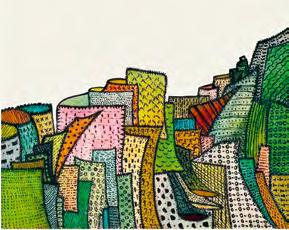
Fig. 5: Faces and Places II, 2010
Fig. 6: Une ville, 1968
and dotted planes of color that fold and twist against each other could just as easily be buildings as they could be land lots. As Feldman writes, these elements that are flattened against each other are “depicted by a diagonal sweep from left to right, evoking the shoreline of Beirut and its northern suburbs.” 21 When analyzing the painting, one feels a sort of perspective, that diagonal pulse feels like you are seeing a skyline of buildings in a 3D representation, but at the end, the flat geometries reveal just planes without any actual focal point as linear perspective would require. This perceptual twist, facilitated by the curving gesture of the buildings (or the land lots) contorting subtly toward the right of the canvas allows her to bring together the shoreline and the skyline, a floor plan and an elevation view that only a perspectival representation would allow to exist together—but even that would be impossible due to the radical difference in scale between a set of a few buildings versus the full Beirut shoreline. In the same way that the geometrical protocols of linear perspective stabilize the ground through a fiction that facilitates control and domination, distortion and disorientation become emancipatory tools of representation, gaze production, and space articulation. The politics embedded in the representational techniques of some of these paintings as well as the ideological possibilities they offer, whether conscious or not, open up to a “world of forces and matter, which lacks any original stability.” 22 Without committing to an established horizon and thus a singular point of view, and working against all geometrical odds and all precepts of scalar relation, Caland manages to find a way to bring the city—be it Beirut, Los Angeles, or a place of her imagining—into a skyline, a shoreline, a land lot, and a dreamscape all at once. To call upon Steyerl one last time: “Falling does not only mean falling apart, it can also mean a new certainty falling into place.” 23
21 Hannah Feldman, “Drawing the Routes and Roots,” 36.
22 Steyerl, “In Free Fall.”
23 Steyerl, “In Free Fall.”

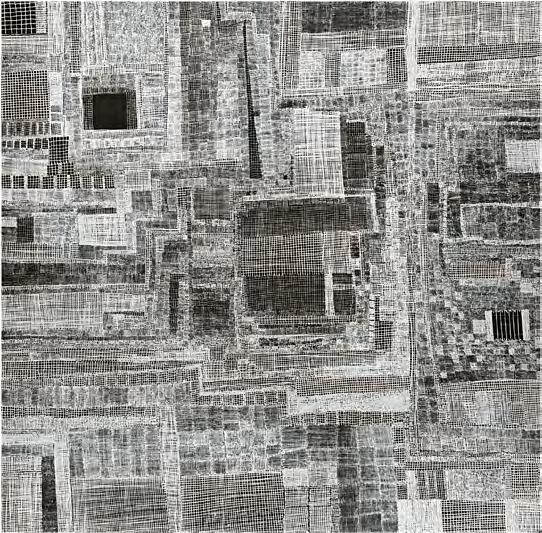
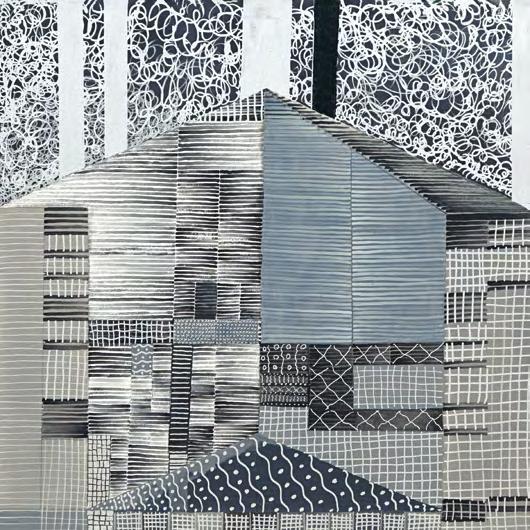
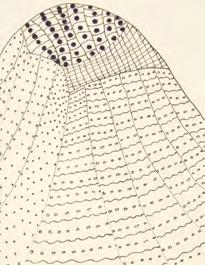
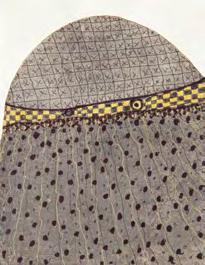
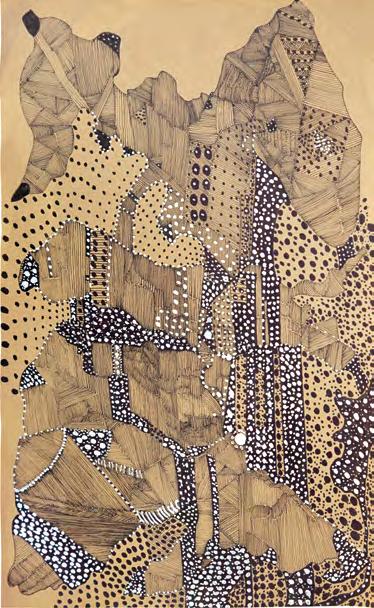
avril 1952, 2010
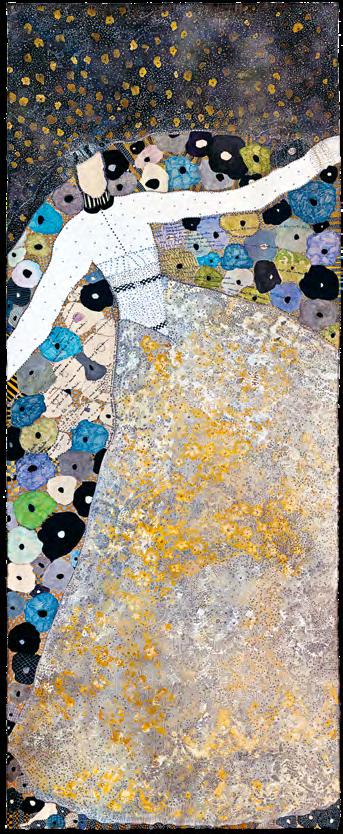
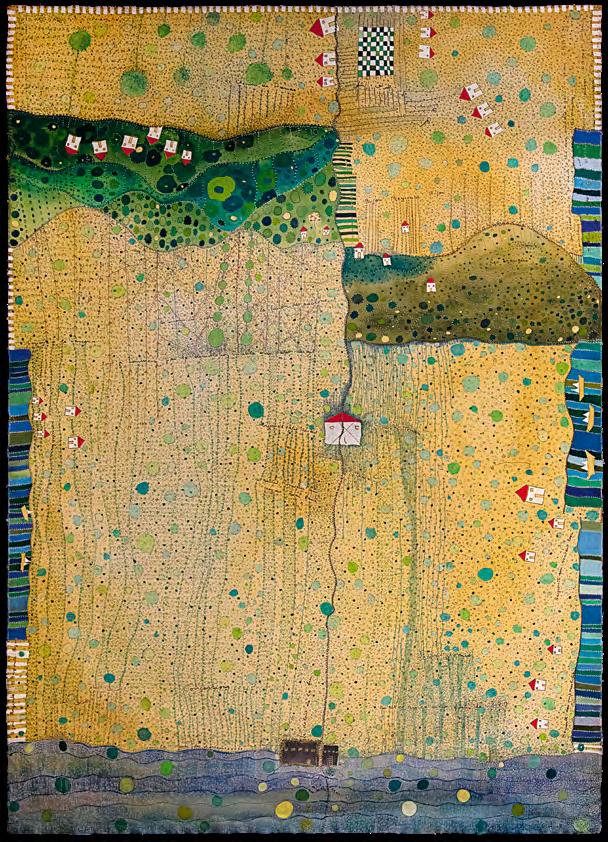
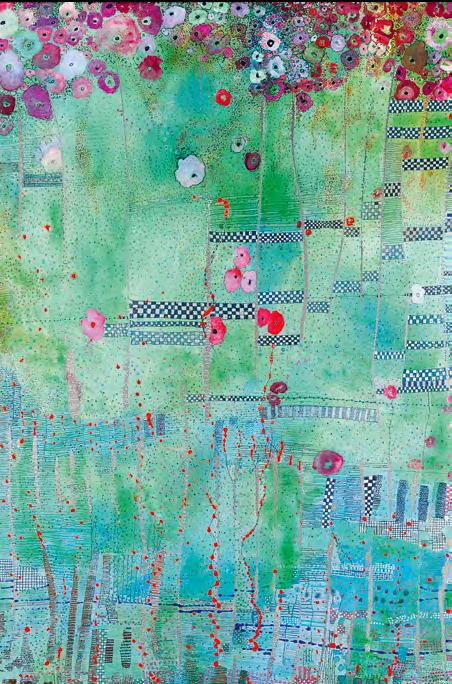
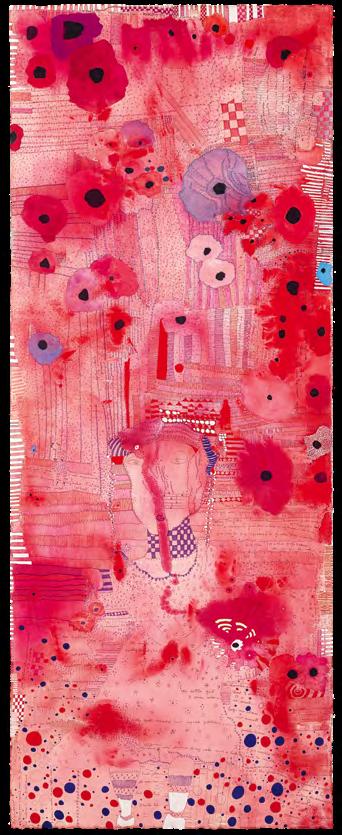
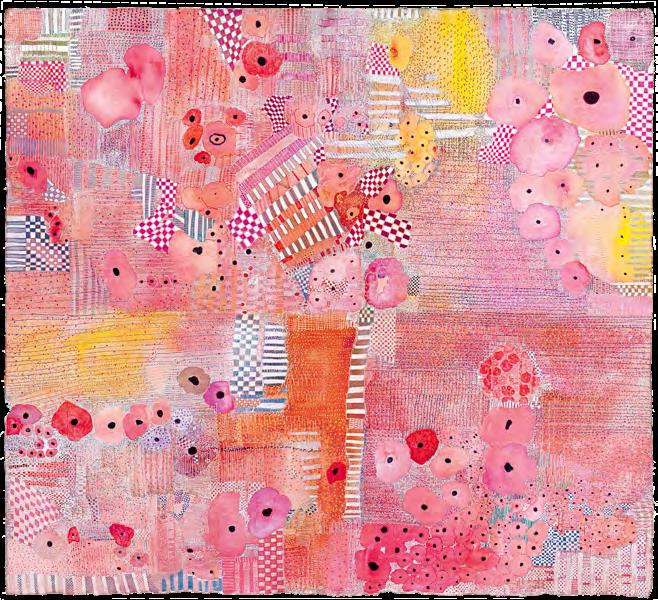
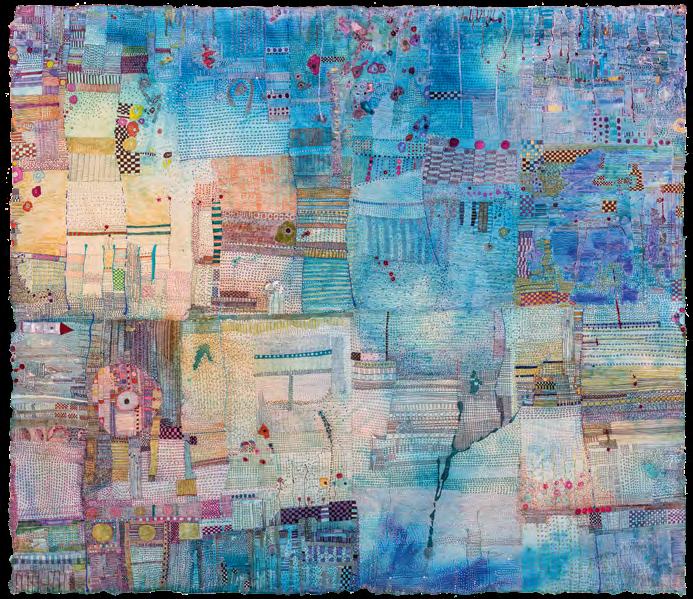
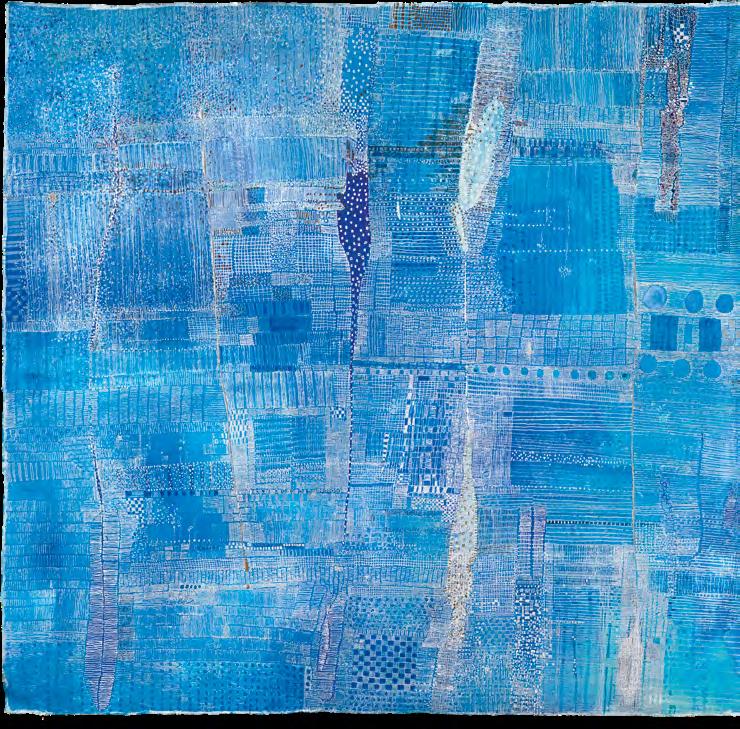
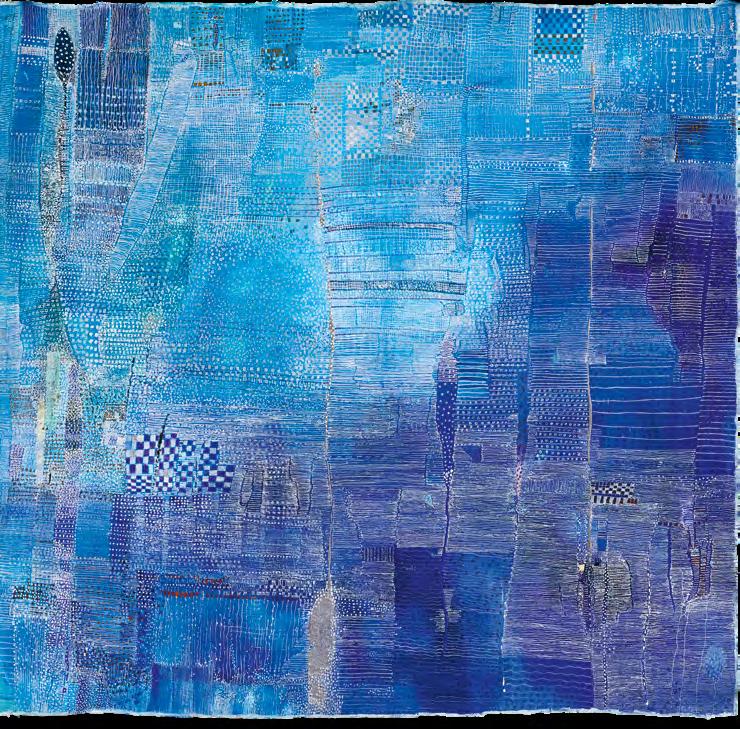
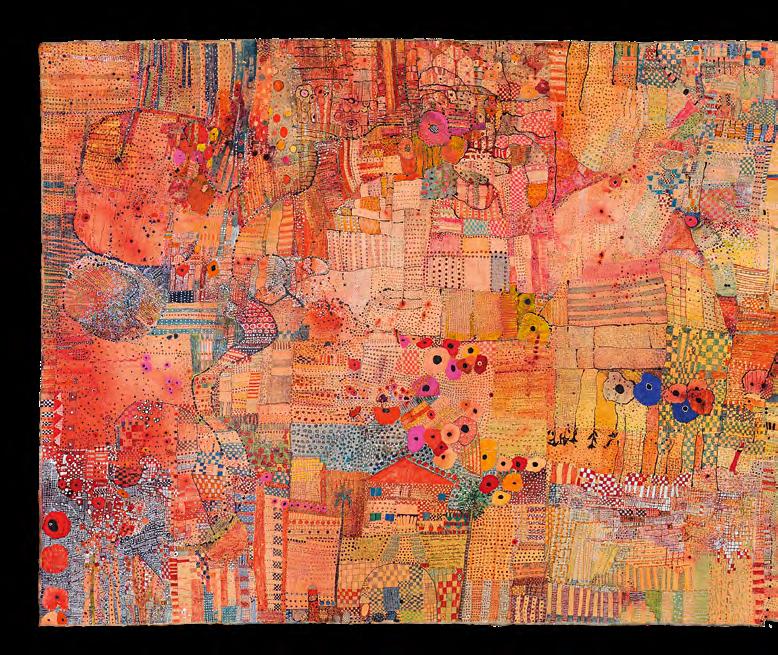
L’indépendance du Liban racontée à L’Or Iman, 2012
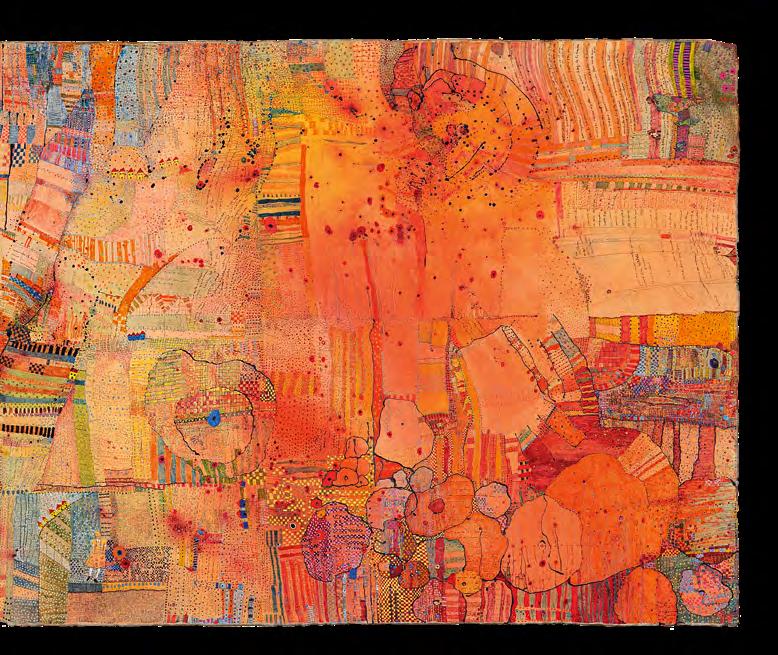
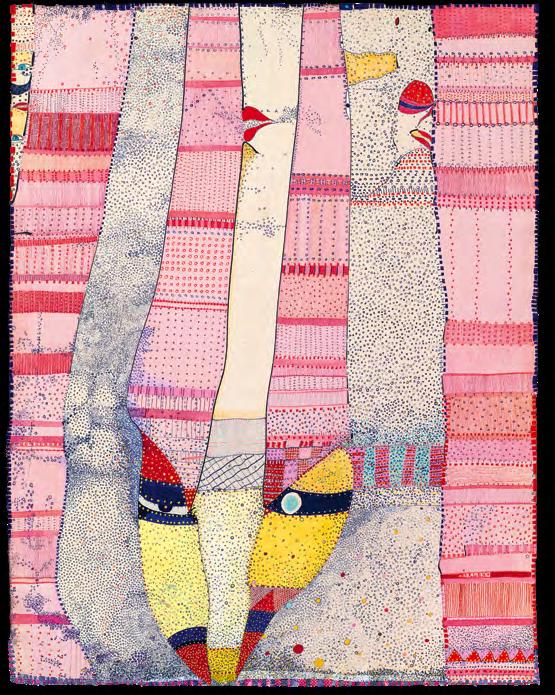
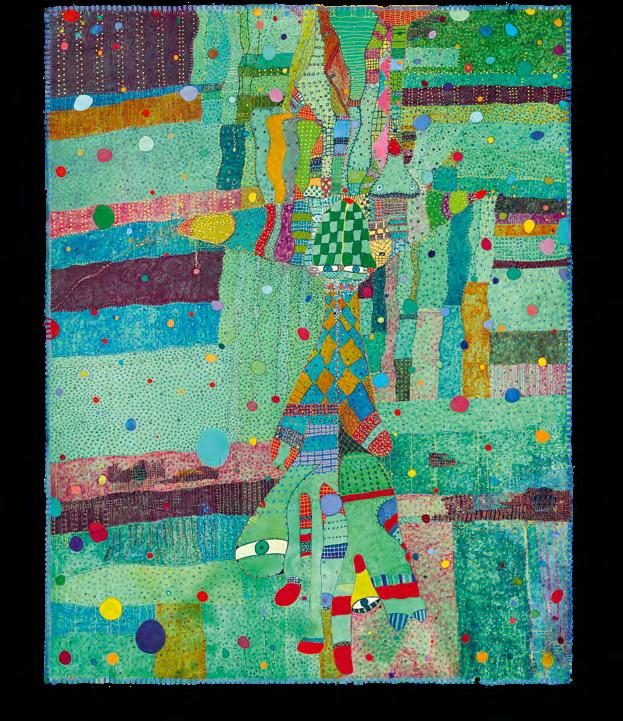
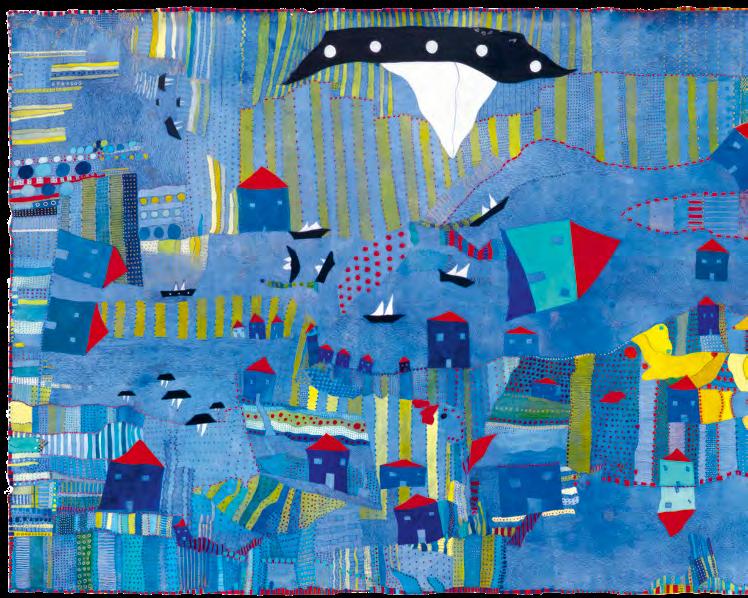
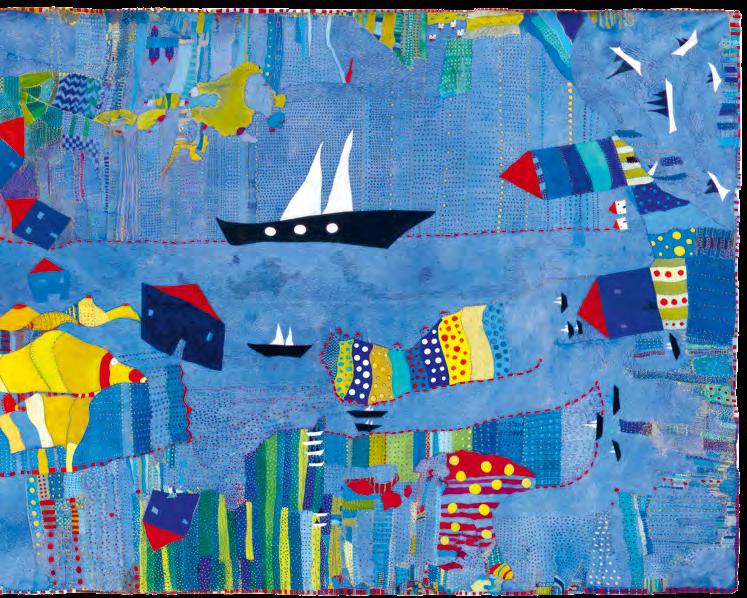
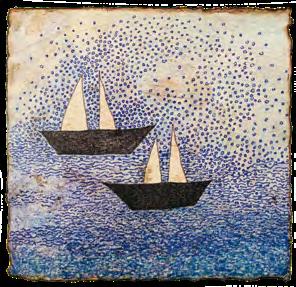
The Role of Writing in Huguette Caland’s Art Practice
Brigitte Caland
Huguette Caland was raised in an environment that helped her discover at a very young age the importance and the power of words; from then on, writing played an important role in her life, and she developed her own style of wittiness, appearing sometimes in an ironic or sarcastic form, in humorous and concise sentences.1 Writing naturally became a central part of her life, and her correspondence with friends such as Dominique Eddé and Helen Khal; the dense, long epistolary relationship she maintained over fifteen years with Moustafa, her lover; Sysphia the script she wrote with Maryse Ebely; the illustrations she did for the poems by Alain Bosquet, Andrée Chedid, and Salah Stétié; and the collaboration with Fouad Elkoury on Utopia City (1999), a sketchbook in which the two imagine a friendly world, are among the many examples. 2 H. Caland, whose sense of humor is also found in some of her titles, admitted: “I could have become a writer,” 3 before adding mischievously that she became a painter “to be incomprehensible,” 4 creating, consciously or unconsciously, a game between the artist and the viewer. This combination of clarity and obscurity intrigues us and spurs our curiosity.
In a 1968 painting, a few Arabic letters appear; they subtly lay claim to her Arab identity, as she sought to distance herself from her Francophone and Francophile bourgeois milieu. But it is only fifteen years later, in 1983, that writing reappeared in her sketchbooks
paving the way for a new practice that associates drawings and texts. In Sketchbook 5 (1986), for instance, she documented the last months spent with George Apostu (an exiled Romanian sculptor and her companion at that time), his work in quarries, and their daily life in the French countryside. The drawings are dated July 1986, but in December of the same year, after the death of Apostu, H. Caland added texts and sketches in which she shared some intimate memories and the void left by his absence; two forms of communication combined to ease her grief.
When H. Caland moved to California in 1987, she held open houses, which helped her to integrate socially, but she did not get the artistic recognition she expected. Writing in Arabic, in French, and in English in her artwork—paintings, drawings, collages, and sketchbooks—evokes a therapeutic process as she transforms ambivalent feelings and revived wounds into artistic matter where words become part of a “chimney sweeping.” 5 In the numerous Self-Portraits (some examples, pp. 33–35) or Nude Letters, collages made of recycled old letters, some torn and some cut with scissors, the artist added in her delicate handwriting new texts that disappear under a layer of glue or paint or under recurrent motifs, creating a game with the viewer/reader whose curiosity remains unsatisfied. 6 In these works, her recycled past transforms into palimpsests with hidden texts, revealing one word, or a few,
sometimes even bits of an enigmatic text. H. Caland’s handling of the said and the unsaid blurs the borders between consciousness and unconsciousness, infusing humor and lightness into them. It plays with the viewer/ reader who struggles to follow an idea when words disappear under a brushstroke, or various signs, or colors, or when the written lines pivot on the paper making it difficult to follow and sometimes even to decipher. An example of this is Une vie en quelques lignes ( A Life in a Few Lines ; transcription and translation, pp. 250–263), a collage that was a sixtysixth birthday gift to Paul, her husband whom she left when she moved to Paris, then to Los Angeles, though the couple never divorced. In this collage, three different sizes of paper are glued symmetrically one on top of the other; the pink on the central page, which is crossed by two black bands that evoke dark clouds and a mourning color, gives the piece a softness that allows H. Caland, with her fine, round handwriting, to review moments of her married life, to mention the importance of family, to share memories from the past and to narrate daily stories from her life in Venice, California, to bring up whimsically the importance of sexuality and pleasure in her life. The presence of a hand and an eye protects against evil spirits; the horizontal, vertical, and diagonal lines that turn and overlap on several levels make the text legible in places but barely readable in others and sometimes even impossible to decipher. This playful manipulation of clarity and obscurity allows the artist to entrust the paper with important events and to preserve a sense of mystery. But Paul, the story of her life, becomes in the early 1990s a recurrent theme in the artist’s drawings, collages, and later in a series of tapestries/paintings Mes jeunes années (My Younger Years). In Kantari, la mariée, avril 1952 (Kantari, the Bride, April 1952, 2010; p. 216) the artist shares with the viewer her thoughts in an intimate text revealed by the outstretched arms of the young
bride who seems to levitate, as if expressing these stories alleviates the burden carried by her body; another example is L’indépendance du Liban racontée à L’Or Iman (The Independence of Lebanon as Told to L’Or Iman; pp. 234–235) in which bits and pieces of personal anecdotes are merged into the national history of Lebanon. Elsewhere, as in Apple Green and Green Tomato (p. 216), the artist who plays on words remains light even when the subject is difficult; here, she subtly evokes, in French, Arabic, and English, human rights and women’s rights in the Middle East, to which she adds personal references.
In 1993 Nadine Begdache offered H. Caland a show in her newly opened gallery in Beirut. The artist accepted enthusiastically and returned to her birthplace after fourteen years of absence. During her first visit, H. Caland discovered a city destroyed by the civil war and created a series of five drawings in which poetic texts in French archive the moment; written in black ink over a gray wash, the content takes over the form of the drawing. In these poems, she pays tribute to the beauty and courage of the women of her country and expresses her feelings toward a city she claims to belong to, even though she chose to live elsewhere (for example, pp. 264–265). During the same decade, the various notes, phone numbers, and appointments she wrote on her smocks in Arabic, French, and English document her life on different continents. Smock 31, for instance, is a dress she wore during a visit to Asilah, Morocco, where she was invited in 1994 to attend the Cultural Moussem of Asilah (p. 158). On this smock she candidly shares, in paintings and words, her frustrations and joys including details concerning her American artist friends who were traveling along with her.
The success H. Caland encountered in Lebanon at her second exhibition in 1997, and later, compensated for the difficulties she faced integrating into the artistic community
in California, and, when words were no longer enough, or when she wished to repress them, she created a process of dissimulation and pushed it toward abstraction. This process emerged in Sketchbook 2 where she expressed her frustrations about the “amicable” relationship she had with her neighbor, the artist Ed Moses. H. Caland confided: “In order to silence myself I draw lines. [. . .] Yes, that might seem ridiculous. But to draw a line is a way to contain one’s emotion, one’s anger, one’s anguish. When one has a desire to hurt others, one draws a line,” then adds: “My lines tell the story of my life, of people encountered along the path, people I loved, and found and even lost.” 7
Thus, from this game of dissimulation and from the need to free herself from repressed tensions, emerged simultaneously a new style of expression, a new “writing”; the artist invented a personal symbolic and aesthetic language, composed by lines whose deep meaning escapes us. The fluid lines that characterized her work until now continued to appear alongside more rigid or fragmented lines of various length that transform into lozenge shapes, squares, or checkerboards creating partitioned surfaces that suggest abstract aerial topographies (in the series Cityscapes ; for example, pp. 221–223) or a weaving of colors in which the artist added other recurrent signs and motifs such as crossstiches, small circles that evoke the bubbles rising in a glass of champagne, houses with pointed red roofs, flowering vines and flowers of different sizes, more or less abstract, more or less defined, palm trees, sailing boats, human figures, and veiled women . . . 8 These repetitive lines, these mysterious signs and motifs, as well as the spaces that separate them, become in her last series, Mes jeunes années and Rossinante, a silent language that the artist perfected. In one of the Rossinante paintings (p. 236)—a title alluding Don Quixote’s aging horse—loaded with the unsaid, two words, a tear, written upside down
in her tiny handwriting, lost on a pink and yellow bright canvas create a subtle and surprising contrast. They express the uneasiness of living (malaise de vivre) in an aging body; elsewhere, in the series Mes jeunes années, childhood and teenage memories appear in a more or less visible way. 9
Thus, throughout her career, the writing inserted in Huguette Caland’s body of work enabled her to overcome with lightness and discretion the tensions that crossed her life, and to turn elegantly the page.
1 Her father had a perfect command of Arabic language, and he used it in a very poetical way; her governess for several years, Irène Volski, a Polish princess, instilled in her a love of literature. (Editor’s note: As mentioned in other essays in this publication, Caland’s father was the politician Bechara El Khoury, Lebanon’s first president after independence.)
2 A collaboration in the context of Peintres et Poètes en Sologne, created between 1979 and 1984, Aubigny-sur-Nère, France.
3 Huguette Caland, “ Warae elwoujouh (Behind the Faces): Interview with Huguette Caland,” interview with Ricardo Karam, 2006, posted July 7, 2014, by Ricardo Karam, YouTube, https:// www.youtube.com/wat ch? v=Tx8ll3WZV3s .
4 H. Caland in L’éléphant et le coquelicot , by Dominique Eddé, published in Huguette Caland (Beirut: Solidere, 2012), 16.
5 Sigmund Freud, Cinq leçons sur la psychanalyse (Paris: Payot, 2004), 14, quoting the words of Anna O. (Editor’s note: In English in the original.)
6 All the correspondence with Moustafa, her longstanding lover, was entrusted to a friend who kept the letters for decades and returned them to her during a visit to California.
7 Huguette Caland in Lettres à Francine, directed by Fouad Elkoury (2002). (Quote translated by Carolyn Wooding.)
8 The cross-stitching evokes the work of embroiderers at Inaash (the organization she founded with a few Lebanese friends in 1968, to enable Palestinian women in the refugee camps to earn a living) and thus a form of exile, suffering, and hard labor.
9 Rossinante and Mes jeunes années are the two last series of H. Caland’s career.
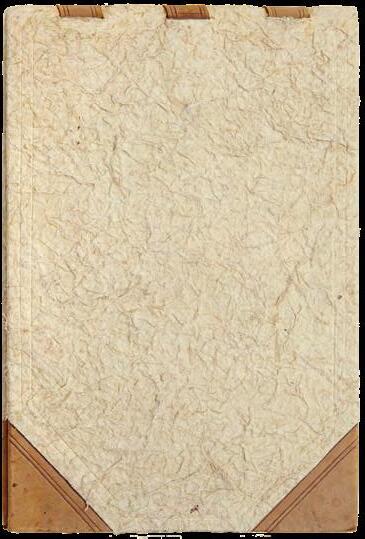
Texts by Huguette Caland
The texts reproduced below are translations of three manuscript poems by Huguette Caland, originally written in French, with some fragments in English and Arabic, whose transcription has been a complex exercise due to the characteristics of Caland’s writing mentioned in Brigitte Caland’s essay in this publication, pp. 242–244. The author’s original punctuation, graphic layout, and spelling have been respected as much as possible.
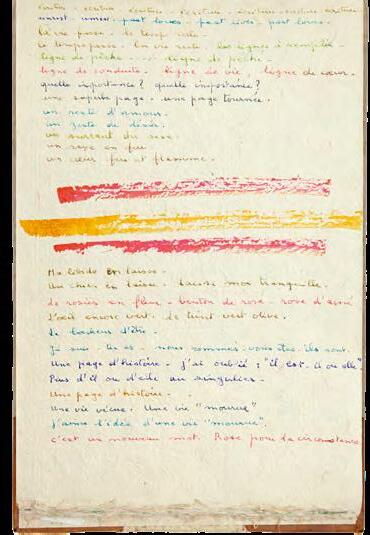
Sketchbook 8, 1992 (page 3). Previous page: cover
From Sketchbook 8 1
writing - writing - writing - writing - writing - writing - writingunrest - unrest. past loves - past lives - past loves. life passes. time remains. time passes. life remains. lines to be filledfishing line - - - - - fishing line guideline. lifeline, heart line. what does it matter? what does it matter? a magnificent page - a page turned. a remnant of lovea spark of desire. a burst of sex. a penis on fire. a heart of fire and flame.
* * *
My libido on a leash -
A dog on a lead - leave me alone. 2 of flowering rose tree - rosebud - acme pink The eye still green. with an olive-green tinge. The joy of being -
I am - you are - we are - you are - they are. A page of history - I have forgotten: “he is - he or she.” No more he or she in the singularA page of historyA life lived. A life “died”
1 Editor’s note: Translation and transcription of an untitled poem from Sketchbook 8, 1992, written in French and English (unless otherwise indicated, verses marked with italics are in English in the original version).
2 Translator’s note: The original French text is an untranslatable play on the similarity between the words lasse (“tired” or “weary”) laisse (“lead”), and laisse (the imperative second-person singular of “leave”).
I like the idea of a life “died.” it’s a new word. Pink for the occasion
ajax blue - water pink - pepper sepiablack pepper - white pepper - grey pepperfrozen vegetables - red wine - white wine - alcohols. rubbing alcohol - methylated spirit - Milk - salt
Heartburn - useless words you speak of gold . . . . . you have beautiful handwriting. I was very fat. today I live in a volumein more than a volumein more than a volume. My body - my studio - my spaceVenice?
Milk - salt - bread and saltthe salt of the earth -
* * * yes Leila my Leila
Gelson’s 3 is the only one that accepts credit cards only our Gelson’s . . . . .
* * *
To the market with Leila
To the market with Pierre’s credit card
* * *
One day at Gelson’s . . . . .
3 Editor’s note: Gelson’s is a Southern California supermarket chain.
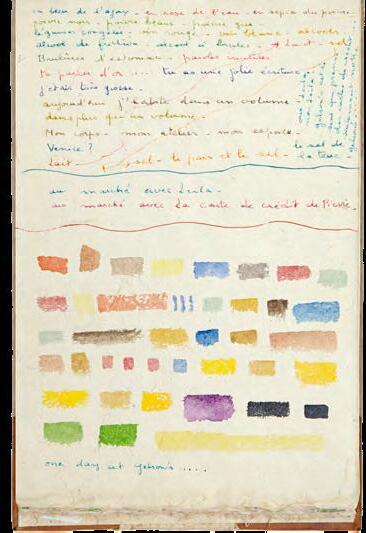
Sketchbook #8, 1992 (page 4)
A Life in a Few Lines 1
A life in a few lines - the absence of a whole lifetime in color and in a few lines a life in a few lines - the summary of a great love
* *
The essence in colors the essential in a few lines the essence of a life in a few lines the essence of a life in a few lines
* *
A life on record - a few flashbacks - a few images *
Nothing more to say - nothing more to add
Dear, dear, dearest June, Venice California
. . .
66 - 22 = 44 when I left Lebanon 44 years ago Paul was 44 years old when I left him to the women who fought over him forcefully and miserably I did not like them - I could not stand up to them . . . Paul and I were married for life we have three children and I neither wanted nor was able to fight for me the fighting for all of us was over [?] I had had my share [?] - the best . . . our children and our adolescence I was leaving .
1 Editor’s note: Translation and transcription of the writing-drawing Une vie en queques lignes, 1992, written in French, English, and Arabic. (Unless otherwise indicated, verses marked with italics are in English in the original version.)
to fight for what had ceased to be my main preoccupation From 43 to 52 had been Paul from 52 to today that had been my life . . . paul is still a part of it - how and why exclude you from it . . . It has never been conceivable for [?] to of . . . . . . him the children . . . and I would always have to form this sort of cell where each of us can at every . . . . return to recharge . . . the batteries . . . we exist in space and the most important thing is to be in orbit to avoid plummeting I cannot give a logical explanation of how all this holds up, but it holds up and maybe this is a miracle - what are miracles if not the intangible and the inexplicable . . . other than by an ability to love and to feel . . each addition [. . .]
A few years and an addition which adds itself to us all and from which we also feed ourselves in that way space and time are abolished I catalyze emotions and store them up to feed my [. . .] long after my life . . . . A long time after my death a red rose on my terrace climbs a pink rose in a vase at my window fades the Californian sun makes great efforts to overcome the mist - it will succeed soon - the bodybuilders at Gold gym that I ran into this morning during my daily fitness session are part of the familiar landscape of Venice - a couple kissed tenderly their abnormally enlarged muscles were no obstacle to gentleness the aroma of the bread that was baked at the “ pioneer bakery ” reaches my home during the night and in the early hours of dawn my mother died on the 29th of June 1960 that was nearly 35 years ago the perfume of my mother comes back to me as a whiff - I like the smell of my mother I like the smell of bread baking - my mother also liked smells - my table will be empty of its perfumes - in memories of my mother
Paul’s mother was an angel even her name was Angel . . . Also died in June one year before my mother. She was so light on this earth
she never weighed on anybody. I really have such tenderness for her we had
Paul & gambling in common - that was something - her weakness for roulette
she & Georges Chehadé at a table of roulette - where was it? In Sofar . . . So far.
Paul this page is my birthday present for your 66th birthday - it’s a I hope that more . . . . After . . . . That life will be good until the end that it will be more comfortable that our future satisfactions will cover up the past dissatisfactions that smiles [?] [or troubles?] will funny and happy will replace the contained anxiety . and to tell you the importance that you have always had will remain in both of our lives - there is no such thing as distance for love - which crosses without difficulty and without shortness of breath the kms . . .
yapapouna yapapouna yapapouna yapapouna yapapouna 2
June 06/27/1992 * *
Smell smell smell smell
smell smell smell smell
smell smell smell smell
smell smell smell smell
* *
Sex sex sex
sex sex sex
sex sex sex
sex sex sex
2 Editor’s note: Huguette Caland sometimes referred to her husband, Paul, by this nickname.
[?] and those who are no longer young and have flesh that is no longer smooth and firm and the older people’s sex and the old people? the difficult and problematic erection
Sex is research for my inner life - my inner self - sex is pure - sex is lovable
* *
They could have taken a vow of chastity it would be so much more harmonious than to hold on to obsessions
Sex is sex - sex is beautiful only when you are healthy and genuine I cannot imagine the couple M and S
* *
Unfulfilled desires - exploration [?] should be replaced by with them is impure and disgusting - amahl might like sex and proclaim it’s good
* *
Exploration of the tenderness that makes one accept failures - and miseries
loud and clear - sex suits them - poor human beings dependent upon a body that often serves them poorly: I love sex, says she with a radiant smile, sex is a purification - I love sex says she innocently - I love sex
* *
It is my father that I felt I was the other men in my life - I will talk about them one day - you should hear eventually - the years as they add up have made us friends
. . .
nothing to my life
the baccalaureates - the escapes - yours - mine [?] or theirs and so many other things it is me that has [taught] you to drive
if it was even in my car that you passed your driving test - I did not like to stay at home without the [?] at the beginning of our marriage so that you could go to the stable - my mother suffered because of it - I covered up for you by saying that I had nothing to do outside of the house
When in 1970 I left Kaslik - before I was forced to - I knew that my decision - as difficult as it was - was essential for me . . . . * *
My real protection was my mother -
The languorous eyes and the petrol blue suits - God how I wanted you your [?] black hair and the visible ribs - hollow cheeks and the triangle of the face . . . . . . . * *
Who, moreover, would be satisfied with moderation . . . . . . . . and . . . . . . . . . I was preparing myself I never knew what you wanted maybe you never knew yourself . . . - I loved you I thought it was enough*
Good pedigree to begin with . . . . I still touch all the wood on earth and your champions were there - swimming pools have replaced the stables Jean Derdérian and Duchemin have replaced Said georges ashamé - the chlorine
the hookahs - the gossip of the Bassouls the rumors of the races . .
the five in the eyes of the devil the devil in the eyes of the five
the five in the eyes of the devil 3
You don’t need to Worry
Paul no doubt [?] my ability to love him - probably believed that it would transform me into an obedient victim of my love - never doing anything by myself and being content as his wife [?] (two words) just as he could not anticipate that very soon spurred by my instinct of self-preservation - I withdrew from the race . . . . A long time before I left in 1970. To preserve the memory of this dazzling childish love - it should not turn into bitterness at the first confrontations ---- I would have today the memory of that love blesses a thousand times - I would have hated it to be otherwise . . . .
3 Editor’s note: This stanza and the preceding one, both marked in italics, are in Arabic in the original version. Translated by Brigitte Caland.
Reserve of water reserve of oxygen - reserveflowers grow on my terrace and tomatoes too - parsley and mint rosemary and basil - I am waiting for some big sunflowers which will dominate the situation and go looking for their sun above the balustrade - Paul never looked after plants . . . maybe in his old age he will like - plants and his grandchildren . . .
writing is the silence of words - not the silence of the mind - to write - to line up words
A pretty round word talismans from an unknow faith - talismans from no particular rite - the beauty written
The visual pleasure of seeing the space busy with these little signs that are nothing but hieroglyphs of another time - to be deciphered in 10,000 years’ time .
Immoderate love . . . . and also and especially this love for you which is like each 1st has made me today - what I am - my sorrows - my disappointmentsthe impression that the secret will be preserved - that nobody will ever decipher this fine and compact writing in which I confide all that which has
My first copulation - a summer day after sunbathing for a long time - on the floor - in your bedroom
I remember the red of the sunset - did your balcony communicate with the office that office that for a long time was our bachelor flat for the siesta - siesta snatched behind the back of my governess - of my family - how did I find ways to be at your house so oftenwhen there were so many obstacles - barricades of impossibility left me with practically no freedom - and how also for many years did you manage to come so often to my house - without ever running into my parents the most married . . . . . . to make it supportable without […] sage was amputated from my motherat that time Kaslik swarmed with life - with amorous intrigues
The 29th of June 1960 - feast of Saints Peter and Paul - my mother was dying in Kaslik - we all had the mumps - I had been able to speak to her around 10 in the evening
The last sentence I said to her was: the most important thing is that you have a good night - it was the worst night of her life
The wildest desires were
In the air - but life throbbed in everyone - confusedly - 4 years hours that separated the death of my mother from that of my father
Years filled with life
Filled with death -----
Four years during which the experience of life was rich in experiences . . . .
Acute pulmonary edema - the final stopping of her heart - Godel who was called urgently to her bedside upon leaving her expressed the wish that she should not survive the memory of what she [had to] endure - she did not survive - I have been an orphan ever since -----
* *
In 1952 his cheeks had filled out - the languorous eyes now controlled their languor faced with my presence - the petrol blue suits had become more subduedthe black hair still took up a lot of time -------bodybuilding too bravo Yapapouna
* *
I felt that the most important things had been transmitted to the children that until death they would know what my answers to their questions would have been
Love also should cross distances - it was strong * *
Enough to do so - I
Stocked up on love set my priorities - to know the difficult paths that I was choosing - to evaluate the risks
* *
I think that it is a problem […] [of] communicability - need we say that it was one of the great virtues of the eraeverything was too much everything had to be [read?]and it is in this way that harmony was supposed to be established between the piano and the violin thus my life was drawn between the linesalso when my father died on the 11th of January 1964 - I had interior time and space . . .
* *
I no longer - remember the make of Michel Haddad’s car - the one in which we shared so much - the first kiss on a stormy night after being cleaned out at the races
Today the earth trembled in Venice - the movement was peculiaras if the earth were pleasuring her lover --- it was the movement of a woman making love -
The past soon made way for the present - and the normal concerns of earthquakes in California - took priority over the love of gambling and of the women of an adoles cent that I evoked yesterday
Today for me - it remains to be seen whether I will have a green card and if I am destined to have just enough to en sure my material independence - yes of course - if I am going to find myself in a much more comfortable situation - of course not -----
To make one’s way through this ---what an adventure especially --especially when one is not yet a woman and never a gamble -----
a ready-made family - made to measure - that is what Paul foundhow funny life is - the hoped-for otherwise the expected happens
* *
never forget anything again neither mâcon nor barcelona and the airports - and the motorways - and the tensions
talismans talismans talismans
talisman talisman talisman
* *
Michel and Paul called
me - because the earth trembled yesterday
By the bedside of my mother who died 32 years ago --I felt closest to Michel - as close as possible - that day nina Helou rescued us from a multitude of intrudersand provides us with a short respite ----before confronting the others
My mother was there only for us 32 years later it is the 29th of June 1992 * *
To speak about you to a sheet of paper to trust life is an act of great courage I have to my instinct* *
For you the for your bed
Calculations in installments of life and in economy it is important that pleasure be calculated in relation to the economy of medications of doctors - of psychoanalysts - and in relation to the cost of a nervous breakdown ------------------------------------
* *
The long walks in the Bekaa accom panying you to Joseph Skaf’s house and rather than learn ing civil law you got to know Hilmet - the beautiful prostitute on someone else expenses ----------
The words studied carefully according to the recommendations of saïd the jockey - or of Georges Ashamé ---- this justified passing one third of the day in the stables - and two thirds talking passionately about the races - the only true passion that I witnessed - the racesraces and more races the rivalry between gambling and women is the only true one
* *
Khalil called me - the advantage of earthquakes is that people that you have get in touch with you to saylook ---- we’re thinking of you -
Aïda called - Vicky too - and Maryse without knowing that the earth had trembled Ghislaine not yet nor Marie-Claire - Helen from Washington yesterday - who else is there in Lebanon? Paul and Michel and Milad trapped in the blue? […] because I think about himhis eyes------
The economy between the price of things and the appetite for life often always [on?]
Sun that burned our skin - which ignited our desires - which made us precociously mature - the long hours - in the sun - our provisions [?] for life
How to be [?] but [?] the abundance of meals the rooms full of provisionsthe cold-rooms of my childhood----Abou the beloved cook the refrigerators overflowing with
If my mother had not sent me with the chauffeur to buy sweets - I would probably never have had Paul - it’s good - green is hope I [became disillusioned?] to cut a long story short
It was to Amahl that I said I [have just?] of me my [?] skeletal that I had never seen all the apparants [sic] Bones even the bones of the buttocks --- the body that I would surely never have if I grow old and die of anemia but I would never be again I would have [been a] beautiful skeleton covered in transparent skin with veins close to the surface and bones like drills precious and protective protective and precious
The Eyes of the Women of My City 1
The eyes of the women of my city are messengers of love - Survival that recounts experiences with acceptation - simplicitywithout emphasis - murmuring rather than the reverse/opposite - a nod of the heada tear that appears in the corner of the eye - moving womenBearers of tragedy and hope. Rounded by love and tenderness - Perfidious women of Beirut - reservoirs of sensuality . . . neither occupations nor preoccupations have made you lose that visionthat unforgettable vision of life --of death - of childhood - Women of Beirut how I love you - all of youteethless old women - young women full of breasts and buttocks - of grace or of problems ---
1 Editor’s note: Translation and transcription of the poem-drawing Les yeux des femmes de ma ville, 1993, written in French.
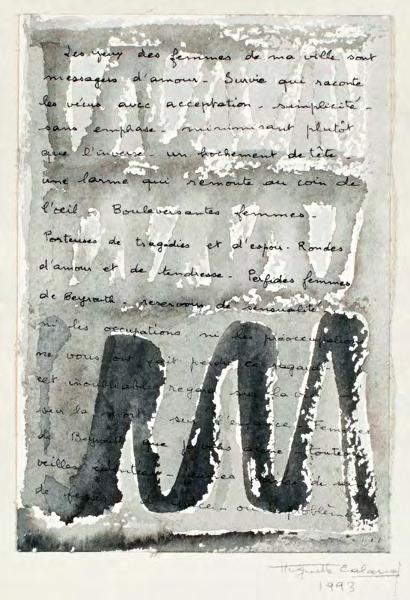
Les yeux des femmes de ma ville, 1993
LIST OF WORKS*
Except as noted, all works are by Huguette Caland.
Alain Bosquet and Huguette Caland Corps (with Bosquet) [Body (with Bosquet)], 1978
Graphite and colored pencils on paper and manuscript poem
72.4 × 66 cm
Huguette Caland Estate 249
Alain Bosquet and Huguette Caland Corps (with Bosquet) [Body (with Bosquet)], 1978
Graphite and colored pencils on paper and manuscript poem
48.3 × 34.3 cm
Huguette Caland Estate 254
Soleil rouge / Cancer [Red Sun or Cancer], 1964
Oil on canvas
129.5 × 195.6 cm (framed: 133.6 × 199.2 cm)
Private collection Id321 p. 66
Cobra 1967
Oil on canvas
81.3 × 100.3 cm
(framed: 84.5 × 103.2 × 3.8 cm)
Huguette Caland Estate 163 p. 71
Helen 1967
Oil on canvas
Framed: 74 × 93 cm
Huguette Caland Estate 96 p. 49
Untitled 1968
Oil on canvas
99.7 × 99.7 cm (framed: 104.1 × 104.1 × 5.7 cm)
Huguette Caland Estate
75 p. 72
* As of January 7, 2025.
Untitled 1968–1970
Oil on linen
80 × 99.7 cm
Huguette Caland Estate
ID2641
Exit 1970
Oil on canvas
118.7 × 119 cm (framed: 122.9 × 123.4 × 5.4 cm)
Huguette Caland Estate
158 p. 77
Moi, Moustafa et Paul [Me, Moustafa, and Paul], 1970
Oil on canvas
52.86 × 103.35 × 5.08 cm
Los Angeles County Museum of Art: Purchased with funds provided by Contemporary Friends, 2015
M.2015.24 p. 78 (top)
Moustafa, poids et halt è res [Moustafa, Weights, and Dumbbells], 1970
Ink on paper
31.7 × 24.1 cm (framed: 42.6 × 35 cm)
Huguette Caland Estate
464 p. 79 (left)
Untitled 1970
Oil on linen
78.7 × 99.1 cm
Huguette Caland Estate 44
Untitled 1970
Oil on linen
98.6 × 88.5 cm
Huguette Caland Estate 094
Untitled (Bribes de corps) [Untitled (Body Bits)], ca. 1970
Oil on canvas on panel
12.7 × 17.8 cm Private collection ID2622
Baiser volé [Stolen Kiss], 1971 Ink on paper
24.1 × 33 cm (framed: 35 × 43.8 × 2.5 cm)
Huguette Caland Estate 481
Compression [Compression], 1971
Ink on paper
Framed: 35 × 43.8 × 2.5 cm
Huguette Caland Estate
482 p. 82 (top)
Corde raide [Tightrope], 1971
Ink on paper
Framed: 37.5 × 45.7 × 2.5 cm
Huguette Caland Estate 461
Enlève ton doigt [Remove Your Finger], 1971
Oil on canvas
38.1 × 76.2 cm (framed: 40.4 × 78.7 cm)
Huguette Caland Estate
109 p. 78 (bottom)
Il se passe des choses [Things Are Happening], 1971
Ink on paper
50.2 × 64.8 cm
Huguette Caland Estate
602 p. 81
Moustafa acrobate [Moustafa as an Acrobat], 1971
Ink on paper
Framed: 35 × 42.5 × 2.5 cm
Huguette Caland Estate 462
Moustafá déchiré [Mustafa torn apart], 1971
Ink on paper
50.2 × 64.8 cm
Huguette Caland Estate 468
Parenthèse II [Parenthesis II], 1971
Ink on paper
24.1 × 33 cm (framed: 34.9 × 43.8 × 2.5 cm)
Huguette Caland Estate 556 p. 82 (bottom)
Partie carr é e [Foursome], 1971
Ink on paper
27 × 35 cm (framed: 40 × 48.9 cm)
Huguette Caland Estate 465 p. 83 (bottom)
Paul 1971
Ink on paper
35 × 27 cm (framed: 46.4 × 38 cm)
Huguette Caland Estate
468 p. 80 (top left)
Self-Portrait (Bribes de corps)
[Self-Portrait (Body Bits)], 1971
Ink on paper
35.1 × 25.1 cm
(framed: 46.4 × 36.2 cm)
Huguette Caland Estate 1011 p. 84
Sur la musique de François Bayle [To the Music of François Bayle], 1971
Ink on paper
Framed: 47.6 × 37.5 cm
Huguette Caland Estate
564 p. 79 (right)
Tête á tête
[Face to Face], 1971
Embroidery on fabric and wooden and foam dummy
187.7 × 55.0 × 31.6 cm
Tate: Purchased with funds provided by Middle East North Africa Acquisitions Committee, 2019
T15259 p. 151
Flirt I
1972
Ink on paper
12 × 17 cm (framed: 23.3 × 28.4 × 2.5 cm)
Tate: Presented by the artist, 2017
T15164 p. 102 (top left)
Flirt II
1972
Ink on paper
17 × 12 cm (framed: 28.4 × 23.3 × 2.5 cm)
Tate: Presented by the artist, 2017
T15165 p. 102 (top right)
Flirt III
1972
Ink on paper
17 × 12 cm (framed: 28.4 × 23.3 × 2.5 cm)
Tate: Presented by the artist, 2017
T15166 p. 102 (bottom left)
Flirt IV
1972
Ink on paper
12 × 17 cm (framed: 28.4 × 23.3 × 2.5 cm)
Tate: Presented by the artist, 2017 T15167
Flirt V
1972
Ink on paper
17 × 12 cm
(framed: 28.4 × 23.3 × 2.5 cm)
Tate: Presented by the artist, 2017 T15168 p. 102 (bottom right)
Flirt VI
1972
Ink on paper
12 × 17 cm
(framed: 28.4 × 23.3 × 2.5 cm)
Tate: Presented by the artist, 2017 T15169
Flirt VII
1972
Ink on paper
12 × 17 cm
(framed: 28.4 × 23.3 × 2.5 cm)
Tate: Presented by the artist, 2017 T15170
Flirt VIII
1972
Ink on paper
12 × 17 cm
(framed: 28.4 × 23.3 × 2.5 cm)
Tate: Presented by the artist, 2017 T15171
Flirt IX
1972
Ink on paper
12 × 17 cm
(framed: 28.4 × 23.3 × 2.5 cm)
Tate: Presented by the artist, 2017 T15172
Flirt X
1972
Ink on paper
17 × 12 cm
(framed: 28.4 × 23.3 × 2.5 cm)
Tate: Presented by the artist, 2017 T15173
Self-Portrait
1972
Oil on canvas
149.9 × 45.7 cm
Private collection 1333
Alpinisme [Mountaineering], 1973
Ink on paper
25.2 × 35.2 cm
Huguette Caland Estate
552 p. 80 (bottom)
Bribes de corps [Body Bits], 1973
Oil on linen
46 × 54.6 cm
(framed: 58.42 × 67.31 cm)
Collection of Maggie Kayne CALANDH.2101MK p. 104
Bribes de corps [Body Bits], 1973 Oil on linen
146 × 149.8 cm
Huguette Caland Estate 083 p. 110
Bribes de corps [Body Bits], 1973
Oil on linen
60 × 60.2 cm
Huguette Caland Estate 273
Bribes de corps [Body Bits], 1973
Oil on canvas
48.3 × 34.9 cm
Huguette Caland Estate 036
Bribes de corps [Body Bits], 1973
Oil on linen
29.8 × 24 cm (framed: 33 × 26.7 cm)
Huguette Caland Estate
28 p. 107 (right)
Bribes de corps [Body Bits], 1973 Oil and tea on linen
126.5 × 126.5 cm
(framed: 130.8 × 130.8 × 7 cm)
Huguette Caland Estate 86 p. 101
Bribes de corps [Body Bits], 1973
Colored pencils on paper
Framed: 40.5 × 34.5 cm
Huguette Caland Estate 449 p. 98 (right)
Bribes de corps [Body Bits], 1973
Oil on linen
Framed: 154.9 × 155.5 cm
Private collection 2152 p. 108
Bribes de corps [Body Bits], 1973
Oil on linen
120.2 × 120.2 cm
(framed: 124.6 × 124.3 × 5.7 cm)
Tate: Purchased with funds provided by the Middle East North Africa Acquisitions Committee, 2019 T15207 p. 105
Bribes de corps [Body Bits], 1973
Oil on linen
152.4 × 152.4 cm
(framed: 152.9 × 152.9 × 4.4 cm)
Private collection
297 p. 114
Hi! 1973
Ink on paper
24.1 × 31.8 cm
(framed: 34.9 × 42.5 × 2.5 cm)
Huguette Caland Estate
475
Self-Portrait (Bribes de corps)
[Self-Portrait (Body Bits)], 1973
Oil on canvas
89.5 × 69.9 cm
Hammer Museum, Los Angeles: Gift of Erika J. Glazer p. 36
Self-Portrait (Bribes de corps) [Self-Portrait (Body Bits)], 1973
Oil on canvas
119.4 × 120 cm
(framed: 125 × 124.2 cm) Private collection
1973
cover (detail) and p. 113
Untitled 1973
Oil on canvas
120 × 120 cm
Collection of Maggie Kayne CALANDH.1901MK
Untitled, 1973
India ink on paper
Framed: 35.8 × 46 × 2.5 cm
Huguette Caland Estate
477
Untitled (Bribes de corps) [Untitled (Body Bits)], 1973
Oil on canvas
129.5 × 88.9 cm
(framed: 133 × 92 cm)
Ramzi & Dalia Rishani p. 106
1er dessin, encre de Chine, hiver [1st Drawing, Chinese Ink, Winter], 1973
India ink on paper
Framed: 42.5 × 35 cm
Huguette Caland Estate
551 p. 80 (top right)
Bribes de corps #296 [Body Bits #296], 1973–1974
Oil on canvas
152.4 × 152.4 cm
(framed: 152.9 × 152.9 × 4.4 cm)
Lent by The Metropolitan Museum of Art, Art Jameel Fund, 2020 2020.319 p. 109
Foule [Crowd], 1974
Embroidery on fabric
137.1 × 48.2 × 30.5 cm
Hammer Museum, Los Angeles: Purchased through the Board of Overseers Acquisition Fund p. 152
Miroir [Mirror], 1974
Embroidery on fabric
137.1 × 48.2 × 30.5 cm
Hammer Museum, Los Angeles: Purchased through the Board of Overseers Acquisition Fund p. 153
Check Point (Bribes de corps) / Sourire interrompu par ledépart [Check Point (Body Bits) / Smile Interrupted by Departure], 1974
Oil on linen
149.2 × 149.2 cm
(framed: 154.9 × 154.9 cm)
Private collection
79 p. 115
Dress 7, Innash 1975
Embroidery on silk
137.1 × 48.2 × 30.5 cm
Huguette Caland Estate 1372 p. 154
Father 1975
Colored pencils on paper
Framed: 92 × 72.4 × 4.4 cm
Huguette Caland Estate 924 p. 122 (right)
Bribes de corps [Body Bits], 1976
Oil on linen
59.7 × 72.4 cm
Private collection p. 117 (bottom)
Untitled 1977
Colored pencils on paper
76.2 × 56.5 cm (framed: 92.7 × 73 cm)
Huguette Caland Estate
229 p. 124
Corps (Andrée Chedid)
[Body (Andrée Chedid)], 1978
Graphite and colored pencils on paper and manuscript poem
47.9 × 45.7 cm
Huguette Caland Estate 246
Corps (Sala Stetié) [Body (Sala Stetié)], 1978
Graphite and colored pencils on paper and manuscript poem
45.4 × 59.7 cm
Huguette Caland Estate 251
Créature de rêve [Dream Creature], 1978
Colored pencils on paper
49.5 × 59.7 cm
(framed: 53.3 × 64.8 × 6.4 cm)
Huguette Caland Estate 20 p. 126 (bottom right)
Elle et lui (Bribes de corps)
[She and He (Body Bits)], 1978
Oil on linen
26.7 × 22.2 cm (framed: 30.5 × 24.9 × 3.6 cm)
Huguette Caland Estate Id142 p. 117 (top)
Mes parents [My Parents], 1978
Oil on linen
33 × 46.2 cm (framed: 39 × 51.7 cm)
Huguette Caland Estate p. 27
Untitled (Bribes de corps)
[Untitled (Body Bits)], 1978
Oil on linen
50 × 50 cm
(framed: 56.4 × 64 × 7.4 cm)
Huguette Caland Estate
30
Untitled (Bribes de corps)
[Untitled (Body Bits)], 1978
Oil on canvas on panel
7.6 × 12.7 cm
Huguette Caland Estate
674
Untitled (Bribes de corps)
[Untitled (Body Bits)], 1978
Oil on canvas on panel
7.6 × 12.7 cm
Huguette Caland Estate
675
Untitled (Bribes de corps)
[Untitled (Body Bits)], 1978
Oil on canvas on panel
7.6 × 12.7 cm
Huguette Caland Estate
676
Untitled (Bribes de corps)
[Untitled (Body Bits)], 1978
Oil on canvas on panel
7.6 × 12.7 cm
Huguette Caland Estate
677
Untitled (Bribes de corps)
[Untitled (Body Bits)], 1978
Oil on canvas on panel
7.6 × 12.7 cm
Huguette Caland Estate
678
Untitled (Bribes de corps)
[Untitled (Body Bits)], 1978
Oil on canvas on panel
7.6 × 12.7 cm
Huguette Caland Estate
679
Untitled (Bribes de corps)
[Untitled (Body Bits)], 1978
Oil on canvas on panel
7.6 × 12.7 cm
Huguette Caland Estate
680
Label sketches for Nour 1979
Collage and acrylic on paper
Variable dimensions:
7.6 × 2.5 cm; 8.3 × 4.1 cm
Huguette Caland Estate
Final label design for Nour 1979
Print on paper
29.5 × 20.6 cm
Huguette Caland Estate
Design for Nour 1979
Colored pencils on paper
34 × 16 cm
Huguette Caland Estate
ID 2818 p. 156
Dress 1 (Designed for Nour Collection, Pierre Cardin) 1979
Mixed media on canvas
127 × 43.2 × 50.8 cm
Huguette Caland Estate 1781 p. 157
Dress 5: Dress, Nour Collection for Pierre Cardin ca. 1979
Embroidery on fabric
127 × 40 × 47 (sleeve length) cm
Huguette Caland Estate
dress_5
Dress, Atelier Haute Couture
Pierre Cardin
1979
Embroidery on fabric Length: 127 cm
Huguette Caland Estate
Dress_26
Dress, Atelier Haute Couture
Pierre Cardin
1979
Red satin cape Length: 109.2 cm
Huguette Caland Estate
Dress_25
Untitled 1979
Ink on paper
26.7 × 20.9 cm
Huguette Caland Estate
Untitled 1979
Mixed media on paper
30.5 × 22.9 cm
Huguette Caland Estate
NI-98
Untitled (lamp design for Nour) 1979
Printing on tracing paper
22.2 × 13 cm
Huguette Caland Estate
Untitled (watch design for Nour) 1979
Silk-screen printing 15.9 × 12.1 cm (each)
Huguette Caland Estate
Untitled (Bribes de corps) [Untitled (Body Bits)], 1979
Oil on canvas on panel 12.7 × 10.1 cm
Huguette Caland Estate
683 p. 121 (left)
Untitled (Bribes de corps) [Untitled (Body Bits)], 1979
Oil on canvas on panel
12.7 × 10.1 cm
Huguette Caland Estate
684
Untitled (Bribes de corps) [Untitled (Body Bits)], 1979 Oil on canvas on panel
12.7 × 10.1 cm
Huguette Caland Estate
685 p. 121 (right, top)
Untitled (Bribes de corps) [Untitled (Body Bits)], 1979
Oil on canvas on panel 12.7 × 10.2 cm
Huguette Caland Estate
686 p. 121 (right, bottom)
Untitled (Bribes de corps) [Untitled (Body Bits)], 1979
Oil on canvas on panel
12.7 × 10.1 cm
Huguette Caland Estate 687
Visages [Faces], 1979
Oil on canvas
80 × 80 cm
The Museum of Modern Art, New York: Gift of Sandra and Tony Tamer, Anonymous, Xin Zhang, Lonti Ebers, and the Modern Women’s Fund, 2021 529.2021 p. 116
Madame [Madam], 1980
Oil on linen
Framed: 102.6 × 102.6 × 4.4 cm
Collection Pierre Caland
280 p. 119
Monsieur [Sir], 1980
Oil on linen
Framed: 102.6 × 102.6 × 4.4 cm
Collection Pierre Caland
43 p. 118
Portrait 1980
Oil on linen
Framed: 31.75 × 26.67 × 7 cm
Charles Arnoldi 1128
Untitled 1980
Ink on paper
32 × 23.8 cm
Huguette Caland Estate
NI137B/RS 470
Untitled 1980
Pastel on cardboard
100 × 100 cm
Collection of the Ministry of Culture, Saudi Arabia, MOC 2023.39.18 p. 120
Smock 31
1980–2012
Mixed media on fabric
111.5 × 91.4 cm
Huguette Caland Estate
Smock_31 p. 158
Guerre incivile [Uncivil War], 1981
Oil on linen
155 × 155 (framed: 161.3 × 161.3 cm)
Private collection
446 p. 123
Funambule [Tightrope Walker], 1982
Oil on linen
Framed: 45.7 × 25.4 cm
Huguette Caland Estate
393
Sketchbook 9
1982–1983
Ink on paper
9.7 × 13.75 cm
Huguette Caland Estate
ID 2457
Sketchbook 14
1982–1983
Ink on paper
12.1 × 9 cm (each page)
Huguette Caland Estate
2825
Untitled 1983
Colored pencils on paper
Framed: 59 × 45 cm
Huguette Caland Estate
668 p. 127 (top left)
Espace blanc I
[White Space I], 1984
Oil on linen
200 × 200 cm
Collection Pierre Caland 2150 p. 130
Espace blanc II
[White Space II], 1984
Oil on linen
200 × 200 cm
Collection Pierre Caland 2151 p. 131
La mille et unième nuit de Shehrazade [The One Thousand and First Night of Scheherazade], 1984
Ink on paper
32 × 24 cm
Huguette Caland Estate
Landscape (Limousin) 1984
Oil on linen
49.5 × 64.8 cm
Huguette Caland Estate
16 p. 133 (top)
L andscape (Limousin) 1984
Oil on linen
49.5 × 64.8 cm
Huguette Caland Estate 17
Ligament (Tête à tête) [Ligament (Face to Face)], 1984
Oil on linen
200.7 × 200.7 (framed: 203.8 × 203.5 × 6.8 cm)
Huguette Caland Estate 444 p. 128
Ligament (Tête à tête) [Ligament (Face to Face)], 1984
Oil on linen
200.7 × 200.7 (framed: 203.8 × 203.5 × 6.8 cm)
Huguette Caland Estate 445 p. 129
Untitled 1984
Oil on linen
45.7 × 54.6 cm
(framed: 48.9 × 57.1 × 3.2 cm)
Collection of Beth Rudin DeWoody 21
Untitled 1984
Oil on linen
59.7 × 80.6 cm
Huguette Caland Estate 42 p. 132 (top)
Untitled 1984
Colored pencils on paper
Framed: 92 × 71.1 × 3.2 cm
Huguette Caland Estate 635 p. 125
Untitled 1984
Colored pencils on paper
43.2 × 49.5 cm
(framed: 42.9 × 50.5 cm)
Huguette Caland Estate
897 p. 127 (top right)
Untitled 1984
Colored pencils on paper
38 × 46 cm
Cheikh Bechara K EL KHOURY
Collection TK
Limousin 1985
Oil on canvas
100.3 × 100.3 cm
(framed: 104.1 × 104.1 cm)
Huguette Caland Estate 288
Mannequin 2 1985
Acrylic paint on wood and foam
185.4 × 48.3 × 30.5 cm
Hammer Museum, Los Angeles: Purchased through the Board of Overseers Acquisition Fund
Mannequin 3 1985
Acrylic paint on wood and foam
185.4 × 48.3 × 30.5 cm
Tate: Purchased with funds provided by Middle East North Africa Acquisitions Committee, 2019 T15259
Mannequin 4 1985
Acrylic paint on wood and foam
185.4 × 48.3 × 30.5 cm
Hammer Museum, Los Angeles: Purchased through the Board of Overseers Acquisition Fund
Mannequin 7 1985
Acrylic paint and foam on wood
185.4 × 48 × 30.5 cm
Huguette Caland Estate 1391
Poor Little Hugie Had a Nightmare 1985
Colored pencils on paper
Framed: 100 × 80.3 cm
Huguette Caland Estate 628
Untitled 1985
Colored pencils on paper
50.2 × 47 cm (framed: 61 × 57.8 cm)
Huguette Caland Estate 629 p. 127 (bottom)
Untitled 1985
Colored pencils on paper
Framed: 61 × 57.8 cm
Huguette Caland Estate 1086
Untitled 1985
Oil on linen
63.5 × 91.4 cm
Collection of Marguerite Steed Hoffman 38
Untitled 1985
Colored pencils on paper
Framed: 35 × 43.8 cm
Huguette Caland Estate 1087 p. 126 (bottom left)
Untitled 1985
Ink on paper
50.2 × 64.8 cm
(framed: 64.8 × 80.3 cm)
Huguette Caland Estate 632 p. 126 (top)
Venice I 1985
Oil on linen
20 × 40 cm
Private Collection of Susan Welsh and Jim Beaubien 391 p. 134
Venice II 1985
Oil on linen
20 × 39.8 cm
Private Collection of Susan Welsh and Jim Beaubien 392
Assurbanipal 1986
Oil on canvas
60.3 × 73 cm
Huguette Caland Estate 262
Untitled 1986
Oil on canvas
45.1 × 60.3 cm
Huguette Caland Estate
41 p. 132 (bottom)
Untitled (Limousin) 1986
Oil on canvas 54 × 73 cm
Huguette Caland Estate
259 p. 133 (bottom)
Untitled (Noël matin à Wagram) [Untitled (Christmas Morning at Wagram)], 1986
Silver marker on paper 21 × 29.8 cm
Huguette Caland Estate 644
Untitled (Noël matin à Wagram) [Untitled (Christmas Morning at Wagram)], 1986
Silver marker on paper 21 × 29.8 cm
Huguette Caland Estate 646
Untitled (Noël matin à Wagram) [Untitled (Christmas Morning at Wagram)], 1986
Silver marker on paper 21 × 29.8 cm
Huguette Caland Estate 653
Untitled (Réminiscences d’amour) [Untitled (Recollections of Love)], 1986
Silver marker on paper 21 × 29.8 cm
Huguette Caland Estate 654
Sketchbook 2
1990–1991 Ink on paper
27.9 × 35.5 cm
Huguette Caland Estate
Sketchbook 6 1990–1991 Ink on paper
15.8 × 46 cm
Huguette Caland Estate
Nude Letters 1991
Mixed media on canvas
208.3 × 210.9 cm
(framed: 212.7 × 214 × 5.7 cm)
Huguette Caland Estate 435 p. 204
Untitled 1991
Mixed media on paper
45.7 × 61 cm
(framed: 61.5 × 75.7 cm)
Huguette Caland Estate
129
Untitled 1991
Mixed media on paper
30.5 × 22.9 cm
Huguette Caland Estate NI-99
Untitled 1991
Mixed media on paper with text (French and Arabic)
30.5 × 22.9 cm
Huguette Caland Estate NI-116
Untitled 1991
Mixed media on paper
45.7 × 61 cm
Huguette Caland Estate 240
Untitled 1991
Mixed media on paper
23.5 × 29 cm
(framed: 59.7 × 73.6 cm) Private collection 261
Untitled 1991
Collage
50.8 × 43.18 cm Private collection
Souvenirs [Memories], 1991
Mixed media on paper
49.5 × 64.8 cm
(framed: 58.4 × 74.9 cm)
Huguette Caland Estate 336
The Legs of My Aunts Seen from under the Table 1991
Acrylic on wood
51.4 × 102.9 cm
Huguette Caland Estate 1095 p. 41
Untitled (Self-Portrait) 1991
Mixed media on canvas
Framed: 61.5 × 75.5 cm
Huguette Caland Estate
121
Untitled (Self-Portrait) 1991
Mixed media on canvas
45.7 × 61 cm
(framed: 61.6 × 75.6 cm)
Private collection 128
Untitled (Self-Portrait) 1991
Mixed media on canvas
Framed: 64.1 × 54 cm
Huguette Caland Estate 2169
Untitled (Self-Portrait) 1991
Mixed media and collage on paper
48 × 63 cm
Collection Pierre Caland
Untitled (Self-Portrait) 1992
Mixed media and collage on paper
Framed: 61 × 46 cm
Private collection
133 p. 33
Christine 1992
Mixed media on paper mounted on panel
25.4 × 12.7 cm
Huguette Caland Estate
167 p. 182 (left)
Christine 1992
Mixed media on paper mounted on panel
25.4 × 12.7 cm
Huguette Caland Estate
168
Christine 1992
Mixed media on paper mounted on panel
25.4 × 12.7 cm
Huguette Caland Estate 171
Christine 1992
Mixed media on paper mounted on panel
25.4 × 12.7 cm
Huguette Caland Estate 172 p. 182 (right)
Homage to Pubic Hair 1992
Mixed media on paper mounted on panel
25.4 × 12.7 cm
Huguette Caland Estate 173
Homage to Pubic Hair 1992
Mixed media on paper mounted on panel
25.4 × 12.7 cm
Huguette Caland Estate 174 p. 181 (bottom left)
Homage to Pubic Hair 1992
Mixed media on paper mounted on panel
25.4 × 12.7 cm
Huguette Caland Estate 180 p. 180 (top left)
Homage to Pubic Hair 1992
Mixed media on paper mounted on panel
25.4 × 12.7 cm
Huguette Caland Estate 181 p. 181 (top right)
Homage to Pubic Hair 1992
Mixed media on paper mounted on panel
25.4 × 25.4 cm
Private collection 185 p. 180 (bottom right)
Homage to Pubic Hair 1992
Mixed media on paper mounted on panel
25.4 × 25.4 cm
Huguette Caland Estate 186 p. 180 (bottom left)
Homage to Pubic Hair 1992
Mixed media on paper mounted on panel
25.4 × 25.4 cm
Huguette Caland Estate
187 p. 180 (top right)
Homage to Pubic Hair 1992
Mixed media on paper mounted on panel
25.4 × 25.4 cm
Huguette Caland Estate 415 p. 181 (top left)
Homage to Pubic Hair 1992
Mixed media on paper mounted on panel
25.4 × 25.4 cm
Huguette Caland Estate
416 p. 181 (bottom right)
Homage to Pubic Hair 1992
Mixed media on paper mounted on panel
50.8 × 25.4 cm
Huguette Caland Estate
419
Homage to Pubic Hair (Sarcasm) 1992
Mixed media on paper mounted on panel
25.4 × 25.4 cm
Huguette Caland Estate 417
Homage to Pubic Hair 1992
Mixed media on paper mounted on panel
12.7 × 25.4 cm
Huguette Caland Estate 176
Homage to Pubic Hair 1992
Mixed media on paper mounted on panel
12.7 × 25.4 cm
Huguette Caland Estate 179
Homage to Pubic Hair 1992
Mixed media on paper mounted on panel
50.8 × 12.7 cm
Huguette Caland Estate 422
Homage to Pubic Hair 1 1992
Mixed media on paper mounted on panel
50.8 × 12.7 cm
Huguette Caland Estate 421
Self-Portrait 1992
Mixed media on paper
Framed: 76.2 × 60.3 cm
Huguette Caland Estate
132 p. 35
Self-Portrait in Smock 1992
Oil on canvas
76.2 × 76.2 cm
(framed: 80 × 80 cm)
Private collection
213 p. 20
Sketchbook 8 1992
Mixed media on paper
30.5 × 20.6 cm
Huguette Caland Estate ID 2458 pp. 245, 246, and 249 (details)
Untitled 1992
Mixed media on canvas
50.8 × 50.8 cm (framed: 54 × 54 cm)
Private collection 1113
(Untitled) Self-Portrait 1992
Mixed media on canvas
Framed: 84 × 62.5 cm
Cheikh Bechara K EL KHOURY Collection
Untitled (Self-Portrait) 1992
Mixed media and collage on paper
Framed: 46 × 56 cm
Collection Pierre Caland
Untitled (Self-Portrait) 1992
Mixed media and collage on paper
46 × 56 cm
Collection Pierre Caland
Untitled (Self-Portrait) 1992
Mixed media and collage on paper
Framed: 73 × 57 cm
Collection Pierre Caland
Untitled (Self-Portrait) 1992
Mixed media on paper
Framed: 84.5 × 69 × 3.8 cm
Huguette Caland Estate
625 p. 34
Untitled (Self-Portrait) 1992
Mixed media on paper
Framed: 84.3 × 67.3 cm
Private collection Id 2173
Ed 1 (Ed Moses Series) ca. 1994
Mixed media on paper mounted on panel (part of a diptych)
200.7 × 200.7 cm
Private collection 441 p. 195
L’argent ne fait pas le bonheur, mais il y contribue largement : A Penny for Your Thoughts [Money Doesn’t Buy Happiness, but It Contributes Greatly to It: A Penny for Your Thoughts], 1994
Mixed media
Framed: 25 × 25 cm
Huguette Caland Estate 2196 p. 176 (top left)
L’argent ne fait pas le bonheur, mais il y contribue largement : Commonwealth [Money Doesn’t Buy Happiness, but It Contributes Greatly to It: Commonwealth], 1994
Mixed media
Framed: 25 × 25 cm
Huguette Caland Estate 2379 p. 176 (bottom right)
L’argent ne fait pas le bonheur, mais il y contribue largement : Danse du ventre
[Money Doesn’t Buy Happiness, but It Contributes Greatly to It: Belly Dance], 1994
Mixed media
Framed: 25 × 25 cm
Huguette Caland Estate ID2226
p. 177 (bottom left)
L’argent ne fait pas le bonheur, mais il y contribue largement : Écritures
[Money Doesn’t Buy Happiness, but It Contributes Greatly to It: Writings], 1994
Mixed media
Framed: 25 × 25 cm
Huguette Caland Estate 2335
p. 175 (top, left)
L’argent ne fait pas le bonheur, mais il y contribue largement : Floating Rates
[Money Doesn’t Buy Happiness, but It Contributes Greatly to It: Floating Rates], 1994
Mixed media
Framed: 25 × 25 cm
Huguette Caland Estate ID2392
p. 178 (top, left)
L’argent ne fait pas le bonheur, mais il y contribue largement : Franc léger
[Money Doesn’t Buy Happiness, but It Contributes Greatly to It: Light Franc], 1994
Mixed media
Framed: 25 × 25 cm
Huguette Caland Estate 2292
p. 179 (top right)
L’argent ne fait pas le bonheur, mais il y contribue largement : Il est possible de s’amuser avec l’argent
[Money Doesn’t Buy Happiness, but It Contributes Greatly to It: It Is Possible to Have Fun with Money], 1994
Mixed media
Framed: 25 × 25 cm
Huguette Caland Estate 2302
L’argent ne fait pas le bonheur, mais il y contribue largement : Jeux de hasard
[Money Doesn’t Buy Happiness, but It Contributes Greatly to It: Games of Chance], 1994
Mixed media
Framed: 25 × 25 cm
Huguette Caland Estate
2246 p. 179 (top left)
L’argent ne fait pas le bonheur, mais il y contribue largement : Les mille et une livres libanaises
[Money Doesn’t Buy Happiness, but It Contributes Greatly to It: The Thousand and One Lebanese Pounds], 1994
Mixed media
Framed: 25 × 25 cm
Huguette Caland Estate
2339 p. 175 (top right)
L’argent ne fait pas le bonheur, mais il y contribue largement : Mariage d’argent
[Money Doesn’t Buy Happiness, but It Contributes Greatly to It: Money Match], 1994
Mixed media
Framed: 25 × 25 cm
Huguette Caland Estate
2346 p. 177 (top left)
L’argent ne fait pas le bonheur, mais il y contribue largement : Money Is a Serious Subject [Money Doesn’t Buy Happiness, but It Contributes Greatly to It: Money Is a Serious Subject], 1994
Mixed media
Framed: 25 × 25 cm
Huguette Caland Estate
2245
L’argent ne fait pas le bonheur, mais il y contribue largement : On ne jette pas l’argent par la fenêtre
[Money Doesn’t Buy Happiness, but It Contributes Greatly to It: Don’t Throw Money down the Drain], 1994
Mixed media
Framed: 25 × 25 cm
Huguette Caland Estate 2241
L’argent ne fait pas le bonheur, mais il y contribue largement : Portrait (divers papiers monnaie)
[Money Doesn’t Buy Happiness, but It Contributes Greatly to It: Portrait (Various Paper Monies), 1994
Mixed media
Framed: 25 × 25 cm
Huguette Caland Estate 2366
p. 177 (top right)
L’argent ne fait pas le bonheur, mais il y contribue largement : Sans titre (Stockholder)
[Money Doesn’t Buy Happiness, but It Contributes Greatly to It: Untitled (Stockholder)], 1994
Mixed media
Framed: 25 × 25 cm
Huguette Caland Estate 2395
p. 175 (bottom left)
L’argent ne fait pas le bonheur, mais il y contribue largement : Tire-Lire
[Money Doesn’t Buy Happiness, but It Contributes Greatly to It: Money Box], 1994
Mixed media
Framed: 25 × 25 cm
Huguette Caland Estate 2192
p. 178 (bottom left)
L’argent ne fait pas le bonheur, mais il y contribue largement : Un pont en or [Money Doesn’t Buy Happiness, but It Contributes Greatly to It: A Golden Bridge], 1994
Mixed media
Framed: 25 × 25 cm
Huguette Caland Estate 2409
p. 175 (bottom right)
L’argent ne fait pas le bonheur, mais il y contribue largement : Ancestor
[Money Doesn’t Buy Happiness, but It Contributes Greatly to It: Ancestor], 1994–1995
Mixed media
Framed: 25 × 25 cm
Huguette Caland Estate
2268
L’argent ne fait pas le bonheur, mais il y contribue largement :
Black Jack
[Money Doesn’t Buy Happiness, but It Contributes Greatly to It: Blackjack], 1994–1995
Mixed media
Framed: 25 × 25 cm
Huguette Caland Estate 2288
L’argent ne fait pas le bonheur, mais il y contribue largement : Chah et après Chah [Money Doesn’t Buy Happiness, but It Contributes Greatly to It: Shah and Post-Shah], 1994–1995
Mixed media
Framed: 25 × 25 cm
Huguette Caland Estate ID2777
L’argent ne fait pas le bonheur, mais il y contribue largement : Elle croule sous l’argent [Money Doesn’t Buy Happiness, but It Contributes Greatly to It: She Is Overwhelmed with Money], 1994–1995
Mixed media
Framed: 25 × 25 cm
Huguette Caland Estate AS.222
L’argent ne fait pas le bonheur, mais il y contribue largement : From Riches to Rags [Money Doesn’t Buy Happiness, but It Contributes Greatly to It: From Riches to Rags], 1994–1995
Mixed media
Framed: 25 × 25 cm
Huguette Caland Estate ID2345
p. 177 (bottom right)
L’argent ne fait pas le bonheur, mais il y contribue largement :
Grinning for Money
[Money Doesn’t Buy Happiness, but It Contributes Greatly to It: Grinning for Money], 1994–1995
Mixed media
Framed: 25 × 25 cm
Huguette Caland Estate 2201
L’argent ne fait pas le bonheur, mais il y contribue largement : Harem
[Money Doesn’t Buy Happiness, but It Contributes Greatly to It: Harem], 1994–1995
Mixed media
Framed: 25 × 25 cm
Huguette Caland Estate
2191
p. 178 (top right)
L’argent ne fait pas le bonheur, mais il y contribue largement : Il est possible de s’amuser avec l’argent
[Money Doesn’t Buy Happiness, but It Contributes Greatly to It: It Is Possible to Have Fun with Money], 1994–1995
Mixed media
Framed: 25 × 25 cm
Huguette Caland Estate 2413
p. 160
L’argent ne fait pas le bonheur, mais il y contribue largement : In Memoriam
[Money Doesn’t Buy Happiness, but It Contributes Greatly to It: In Memoriam], 1994–1995
Mixed media
Framed: 25 × 25 cm
Huguette Caland Estate 2319
p. 179 (bottom right)
L’argent ne fait pas le bonheur, mais il y contribue largement : Lettre à mes enfants
[Money Doesn’t Buy Happiness, but It Contributes Greatly to It: Letter to My Children], 1994–1995
Mixed media
Framed: 25 × 25 cm
Huguette Caland Estate 2393
L’argent ne fait pas le bonheur, mais il y contribue largement : Millions Under Cover Général, vous nous couvrez de votre mansuétude
[Money Doesn’t Buy Happiness, but It Contributes Greatly to It: Millions Under Cover General, You Cover Us with Your Indulgence], 1994–1995
Mixed media
Framed: 25 × 25 cm
Huguette Caland Estate 2238
L’argent ne fait pas le bonheur, mais il y contribue largement : Mon loyer à Paris
[Money Doesn’t Buy Happiness, but It Contributes Greatly to It: My Parisian Rent], 1994–1995
Mixed media
Framed: 25 × 25 cm
Huguette Caland Estate
2300 p. 179 (bottom left)
L’argent ne fait pas le bonheur, mais il y contribue largement : Money Contributes to Happiness [Money Doesn’t Buy Happiness, but It Contributes Greatly to It: Money Contributes to Happiness], 1994–1995
Mixed media
Framed: 25 × 25 cm
Huguette Caland Estate 2242
p. 178 (bottom right)
L’argent ne fait pas le bonheur, mais il y contribue largement : Papa Doc
[Money Doesn’t Buy Happiness, but It Contributes Greatly to It: Papa Doc], 1994–1995
Mixed media
Framed: 25 × 25 cm
Huguette Caland Estate
2304
p. 176 (bottom left)
L’argent ne fait pas le bonheur, mais il y contribue largement : Premier et dernier emploi (seul emploi)
[Money Doesn’t Buy Happiness, but It Contributes Greatly to It: First and Last Job (Only Job)], 1994–1995
Mixed media
Framed: 25 × 25 cm
Huguette Caland Estate 2232
L’argent ne fait pas le bonheur, mais il y contribue largement : Taxes…Taxes…Taxes…
[Money Doesn’t Buy Happiness, but It Contributes Greatly to It: Taxes . . . Taxes . . . Taxes . . .], 1994–1995
Mixed media
Framed: 25 × 25 cm
Huguette Caland Estate 2301
p. 176 (top right)
From Faces and Places
1997
Mixed media on wood
Framed: 25.1 × 25.1 cm
Private collection ID2623
Cityscape 1998
Marker pen on panel
60.3 × 79.4 cm
Huguette Caland Estate 219
Untitled 1998
Papier-mâché
8.9 × 11.4 × 7.6 cm
Huguette Caland Estate 1242
Untitled 1998
Papier-mâché
8.9 × 7.5 × 6.4 cm
Huguette Caland Estate 1243 p. 196
Untitled 1998
Papier-mâché
7.6 × 6.4 × 6.4 cm
Huguette Caland Estate 1245 p. 199
Untitled 1998
Papier-mâché and ink
27.9 × 20.3 × 17.8 cm
Huguette Caland Estate 1280
Untitled 1998
Papier-mâché and ink
11.4 × 8.9 × 6.4 cm
Huguette Caland Estate 1289
Untitled 1998
Papier-mâché and ink
6.4 × 6.4 × 6.4 cm
Huguette Caland Estate 1290
Untitled 1998
Papier-mâché and ink
12.7 × 6.4 × 5.1 cm
Huguette Caland Estate 1292
Untitled 1998
Mixed media on canvas
76.2 × 76.2 cm
Huguette Caland Estate 216 p. 223
Untitled (Girl Skipping Rope) 1998–2000
Acrylic and metallic markers on board
243 × 121.9 cm
Private collection.
Courtesy Stephen Friedman Gallery, London and New York
Cityscape 1999
Marker pen on panel
78.7 × 59.7 cm
(framed: 83.8 × 64.7 cm)
Huguette Caland Estate
915 p. 206
Cityscape 1999
Marker pen on panel
76.2 × 76.2 cm
(framed: 84.1 × 84.1 cm)
Huguette Caland Estate
914 p. 222
Cityscape 1999
Marker pen on panel
74.9 × 20.3 cm (framed: 80 × 25.4 cm)
Huguette Caland Estate
919 p. 221
Untitled (Silent Letters) 1999
Acrylic on linen
53 × 40 cm
Huguette Caland Estate 206
Untitled 1999
Acrylic on linen
76.2 × 76.2 cm (framed: 81.2 × 81.2 cm)
Huguette Caland Estate 214 p. 200
Untitled 1999
Acrylic on paper
129.5 × 160 cm (framed: 146 × 176.5 cm)
Huguette Caland Estate 1136 p. 197
Untitled (Silent Letter) 1999
Ink on paper
188 × 96.5 cm
Huguette Caland Estate 1143
Untitled 2000
Ink on paper
143.4 × 32.1 cm
(framed: 150.5 × 38.7 cm)
Huguette Caland Estate 746
Untitled 2000
Ink on paper
133.1 × 32.4 cm
(framed: 149.9 × 38.1 cm)
Huguette Caland Estate
737 p. 202 (left)
Untitled 2000
Oil on canvas
50.8 × 50.8 cm
Private collection 146 p. 201
Untitled 2000
Oil on canvas
50.8 × 50.8 cm
Huguette Caland Estate 149
Untitled 2000
Mixed media on paper
Framed: 49.5 × 65.2 cm
Private collection id2652
Untitled 2000
Mixed media on paper
Framed: 49.5 × 64.8 cm
Private collection id2653
Untitled 2001
Mixed media on canvas
Framed: 45 × 36.1 cm
Huguette Caland Estate 712 p. 224 (right)
Untitled 2000
Mixed media on Japanese paper
148.6 × 294.6 cm
Huguette Caland Estate 2000-003
Untitled 2000
Ink on paper
144 × 32.4 cm
Huguette Caland Estate 744 p. 202 (center)
Untitled 2001
Ink on paper
Framed: 45 × 36.1 cm
Huguette Caland Estate 714 p. 224 (left)
Silent Letters 2003
Acrylic on paper 33 × 25 cm
The Trustees of the British Museum
2014,6044.2
Purchased from: Galerie Janine Rubeiz
Funded by: Contemporary and Modern Middle Eastern Art acquisition group (CaMMEA)
Silent Letters 2003
Acrylic on paper 33 × 25 cm
The Trustees of the British Museum
2014,6044.1
Purchased from: Galerie Janine Rubeiz
Funded by: Contemporary and Modern Middle Eastern Art acquisition group (CaMMEA) p. 198
Silent Letters 2004
Acrylic on Japanese paper
Framed: 221.3 × 220.7 × 6 cm
Huguette Caland Estate 433 p. 203
Untitled (Silent Letter) 2005
Acrylic on fabric
Framed: 73.7 × 81.3 cm
Private collection 2654
Untitled (Silent Letter) 2005
Acrylic on linen
139.7 × 157.5 cm
Private collection 1152
Bodrum 2008
Mixed media on canvas
182 × 221 cm
Huguette Caland Estate 1454 p. 231
Untitled ca. 2008
Acrylic on fabric 102 × 282 cm
Collection Pierre Caland
Appleton I 2009
Mixed media on canvas
183 × 183 cm
Huguette Caland Estate 1205 p. 230
French Kiss Under Cover 2009
Mixed media on canvas
287 × 85 cm
Mercedes Zobel Urquijo 1231
French Kiss 2011
Mixed media on canvas
287 × 85 cm
Collection of Mercedes Zobel Urquijo 1232
Yellow, Purple and Red Lines 2011
Mixed media on canvas
193 × 147.3 cm
Huguette Caland Estate 2011-077
Isphahan 2009
Mixed media on linen
246 × 90 cm
Frederick R. Weisman Art Foundation, Los Angeles 1223
Bleu I [Blue I], 2010
Mixed media on canvas
106.7 × 238.8 cm
Huguette Caland Estate 1190
One Boat
2011
Mixed media on canvas
Framed: 27.9 × 30.5 cm
Private collection
2011-065
Rossinante
2011
Mixed media on canvas
45.1 × 27.9 cm
(framed: 55.6 × 38.9 × 2.5 cm)
Huguette Caland Estate ID 711 p. 225
Rossinante Under Cover VI
2011
Mixed media on canvas
132.1 × 104.1 cm
Collection of Marguerite Steed
Hoffman p. 236
Rossinante Under Cover VII (Dragonfly)
2011
Mixed media on paper 104 × 132 cm
Huguette Caland Estate 2011-055
Two Boats
2011
Mixed media on canvas
27.9 × 30.5 cm (framed: 31.2 × 32.5 cm)
Private collection
2011-064 p. 240
Le grand bleu [The Great Blue], 2012
Mixed media on canvas
163.8 × 408.9 cm
Private collection 2012-007 pp. 238-239
Huguette Caland and unknown technician
Design for plate
1979
Gold ink and marker
23.5 × 23.5 cm
Huguette Caland Estate
Huguette Caland and unknown technician
Design for plate
1979
Silk-screen printing
24.1 × 23.7 cm
Huguette Caland Estate p. 155 (bottom right)
Huguette Caland and unknown technician
Design for plate 1979
Silk-screen printing
23.7 × 23.7 cm
Huguette Caland Estate
Huguette Caland and unknown technician
Design for plate 1979
Silk-screen printing
23.7 × 23.7 cm
Huguette Caland Estate p. 155 (top left)
Huguette Caland and unknown technician
Design for plate 1979
Silk-screen printing
23.7 × 23.7 cm
Huguette Caland Estate
Huguette Caland and unknown technician
Design for plate 1979
Silk-screen printing
23.7 × 23.7 cm
Huguette Caland Estate p. 155 (bottom left)
Huguette Caland and unknown technician
Design for plate 1979
Silk-screen printing
23.7 × 23.7 cm
Huguette Caland Estate p. 155 (top right)
Maryse Ebely and Huguette Caland Hubert Glotte
1981
8 mm film (digitalized), color, sound
8 min., 41 sec.
Maryse Ebely
Fouad Elkoury and Huguette Caland
Utopia City Book 1999
Pen on paper
47.2 × 37.9 cm
Huguette Caland Estate
Other works reproduced in the publication
Mustafa Ariss
Huguette Caland in Stone Doorway
1970
Photography
11.7 × 8.9 cm
Huguette Caland Estate p. 143
Self-Portrait
1967
Oil on linen
109.2 × 88.9 cm
Private collection p. 43
Kaslik
1968
Oil on canvas
100 × 100 cm (framed: 102 × 102 cm)
Courtesy of Saradar Collection p. 73
Self-Portrait
1968
Oil on linen
91.4 × 73 cm
Huguette Caland Estate p. 69
Une ville [A City], 1968
Oil on canvas
80 × 100 cm
Huguette Caland Estate p. 219
Untitled 1968
Oil on canvas
49.5 × 64.3 cm
Private collection Beirut p. 47
Untitled 1968
Oil on canvas
99.7 × 99.7 cm (framed:
104.1 × 104.1 × 5.7 cm)
Huguette Caland Estate
75 p. 72
Untitled 1968–1970
Oil on canvas
Framed: 120.5 × 120.5 cm
Private collection, Lebanon p. 76
Dar el Fan / Hiroshima 1970
Oil on canvas
Framed: 77.5 × 59.7 cm
Nadine Begdache Collection, Beirut p. 74
The First (Dress 1)
1970
Fabric, thread, wood, and paint
137.1 × 48.2 × 30.5 cm
Huguette Caland Estate p. 139
Visages sans bouche, bouches sans visage [Faces without Mouth, Mouths without Face], 1970–1971
Acrylic on canvas
203 × 964 cm
Huguette Caland Estate p. 42
Abstract Flying Carpet
1971
Oil on canvas
99 × 78.5 cm
Saleh Barakat Gallery p. 75
Untitled 1972
Pastel on cardboard
100 × 75 cm
Private collection p. 194 (left)
Bribes de corps [Body Bits], 1973
Oil on linen
119 × 119 cm
Huguette Caland Estate p. 93
Bribes de corps [Body Bits], 1973
Oil on linen
49 × 35 cm
Huguette Caland Estate 26 p. 107 (left)
Bribes de corps [Body Bits], 1973
Acrylic on paper
23.8 × 32.6 cm
Huguette Caland Estate p. 93
Bribes de corps [Body Bits], 1973
Ink and oil on linen
129.5 × 130 cm
Huguette Caland Estate p. 209
Bribes de corps [Body Bits], 1973
Oil on linen
150 × 150 cm
Huguette Caland Estate p. 103
Self-Portrait
1973
Oil on canvas
120 × 120 cm
Courtesy of Saradar Collection p. 112
Untitled 1973
Colored pencils on paper
Framed: 26.5 × 17.5 cm
Jean and Rania Abouhamad Collection p. 98 (left)
Untitled 1973
Colored pencils on paper
Framed: 26.5 × 17.5 cm
Jean and Rania Abouhamad Collection p. 95
Red II
1974
Acrylic on linen
79.5 × 79.5 cm
Sharjah Art Foundation Collection p. 86
Apostu 1986
Oil on linen
55.2 × 69.8 cm
Collection of Maggie Kayne p. 28
Les yeux des femmes de ma ville [The Eyes of the Women of My City], 1993
Mixed media on paper
Framed: 25 × 33 cm
Private collection p. 265
Untitled 2000
Ink on paper
144.1 × 32.4 cm
Huguette Caland Estate 746 p. 202 (right)
La mer III
[The Sea III], 2008
Mixed media on canvas
104 × 215 cm
Jabre Collection pp. 232–233
Hope
2009
Mixed media on canvas
144 × 95 cm
(framed: 149 × 100 cm)
Lebanon, Beirut
Courtesy of Saradar Collection p. 228
Tarik el Sham (Road to Damascus), 2010
Mixed media on canvas
211 × 151 cm
Private collection p. 227
Apple Green and Green Tomato 2010
160 × 433 cm
Mixed media on linen
Private collection p. 216
Faces and Places II 2010
Mixed media on canvas
90.8 × 288.3 cm
Pierre Caland Collection p. 218
Kantari, la mariée, avril 1952
[Kantari, the Bride, April 1952], 2010
Mixed media on canvas (tapestry)
252 × 98 cm
Collection Pierre Caland p. 226
Maison de Freige
[The Home of the Freige Family], 2010
Mixed media on canvas (tapestry)
252.7 × 97.8 cm
Courtesy of Ramzi and Saeda
Dalloul Art Foundation (DAF), Beirut p. 229
Back from Lebanon
2011
Mixed media on canvas
148 ×193 cm
Tammy and Georges Makhoul C ollection p. 215
Rossinante Under Cover II
2011
Mixed media on canvas
132.1 × 104.1 cm
Courtesy of Ramzi and Saeda
Dalloul Art Foundation (DAF), Beirut p. 237
Untitled 2011
Oil on paper
189 × 95 cm
Jabre Collection p. 192
L’indépendance du Liban racontée à L’Or Iman [The I ndependence of Lebanon as Told to L’Or Iman], 2012
Mixed media on canvas
160 × 410 cm
Courtesy of Saradar Collection pp. 234–235
Veronique Vial
Huguette Caland painting the Silent Letters series
2002
Photography p. 184
Other documentation reproduced in the publication
Aramco World Magazine
September–October 1968 issue
Private copy p. 140 (cover)
Aramco World Magazine
March–April 1977 issue
Private copy p. 146 (inside pages)
Unknown
Huguette Caland and her mother, Laure El Khoury, attending a theater performance in Beirut, ca. 1952
Photography
Huguette Caland Archives p. 136
Unknown
Huguette Caland at the opening of Sixteen Lebanese Painters, Delta Gallery, Rome, Italy
1972
Photography
23.9 × 18 cm
Huguette Caland Archives p. 58
CHAIRMAN OF MUSEO NACIONAL CENTRO DE ARTE REINA SOFÍA
Minister of Culture
Ernest Urtasun Domènech
DIRECTOR OF THE MUSEUM
Manuel Segade
ROYAL BOARD OF TRUSTEES
Honorary Presidency
Their Majesties the King and Queen of Spain
President Ángeles González-Sinde Reig
Vice President
Beatriz Corredor Sierra
Ex Officio Trustees
Jordi Martí Grau
(Secretary of State for Culture)
María del Carmen Páez Soria (Undersecretary for Culture)
María José Gualda Romero (State Secretary for Budgets and Expenditure)
María Ángeles Albert de León (Director General of Cultural Heritage and Fine Arts)
Manuel Segade (Museum Director)
Julián González Cid (Museum Deputy Managing Director)
Tomasa Hernández Martín (Regional Minister of Presidency, Home Affairs, and Culture of the Government of Aragón)
Carmen Teresa Olmedo Pedroche (Regional Deputy Minister of Culture and Sports of the Government of Castilla-La Mancha)
Horacio Umpierrez Sánchez (Regional Deputy Minister of Culture and Cultural Heritage of the Government of the Canary Islands)
Pilar Lladó Arburúa (President of Fundación Amigos del Museo Nacional Centro de Arte Reina Sofía)
Elective Trustees
Pedro Argüelles Salaverría
Ignacio Garralda Ruiz de Velasco (Fundación Mutua Madrileña)
Juan-Miguel Hernández León
Antonio Huertas Mejías (FUNDACIÓN MAPFRE)
Carlos Lamela de Vargas
Rafael Mateu de Ros
Marta Ortega Pérez (Inditex)
Suhanya Raffel
María Eugenia Rodríguez Palop
Joan Subirats Humet
Ana María Pilar Vallés Blasco
Honorary Trustees
Pilar Citoler Carilla
Guillermo de la Dehesa
Óscar Fanjul Martín
Carmen Giménez Martín
Ricardo Martí Fluxá
Claude Ruiz Picasso †
Carlos Solchaga Catalán
Secretary
Rocío Ruiz Vara
ADVISORY COMMITTEE
María de Corral
João Fernandes
Inés Katzenstein
Chus Martínez
Gloria Moure
Vicente Todolí
ARCHITECTURE
ADVISORY COMMITTEE
Juan Herreros
Andrés Jaque
Marina Otero Verzier
MUSEO NACIONAL CENTRO DE ARTE REINA SOFÍA
Director
Manuel Segade
Deputy Artistic Director
Amanda de la Garza
Head of Exhibitions
Teresa Velázquez
General Coordinator of Exhibitions
Beatriz Velázquez
Head of Collections
Rosario Peiró
Head of the Office of the Registrar
Maria Aranzazu Borraz de Pedro
Head of Restoration
Jorge García
Head of Editorial Activities
Alicia Pinteño Granado
Head of Cultural Activities and Audiovisual Program
Chema González
Head of the Library and Documentation Centre
Isabel Bordes
Head of Education
Fran MM Cabeza de Vaca
Director of Institutional Cabinet
Carlos Urroz
Head of Protocol
Diego Escámez
Director of Communication
Diana Lara
Head of Digital Projects
Olga Sevillano Pintado
Director of Studies
Julia Morandeira Arrizabalaga
Deputy Managing Director
Julián González Cid
Acting Deputy Director of Management
Sara Horganero
Technical Adviser
Ángel J. Moreno Prieto
Head of Area of Support to the Managing Office
Rocío Ruiz Vara
Head of Human Resources
María Paloma Herrero
Head of the Economic Department
Beatriz Guijarro
Head of the Revenue Service and Statistical Management
Azucena López
Head of Public Activity Policy
Francisca Gámez
Head of Architecture, Sustainable Development and General Services
Francisco Holguín Aguilera
Head of Security
Juan Manuel Mouriz Llanes
Head of IT Department
Mónica Asunción Rodríguez Escribano
This book is published on the occasion of the exhibition Huguette Caland: A Life in a Few Lines, organized by Museo Nacional Centro de Arte Reina Sofía, Madrid, in collaboration with Deichtorhallen, Hamburg.
Museo Reina Sofía:
February 19 – August 25, 2025
Deichtorhallen:
October 24, 2025 – April 26, 2026
EXHIBITION
MUSEO REINA SOFÍA
Curator
Hannah Feldman
Project Director
Teresa Velázquez
Coordination
María del Castillo Cabeza
Camino Prieto Cadenas
Management
Natalia Guaza
Administrative Support
Nieves Fernández
Registrar
Iliana Naranjo Rodríguez
Restoration
Silvia Montero (Head of Restoration)
Irene García
Begoña Juárez
Mikel Rotaeche
Virginia Uriarte
Installation Coordination
Beatriz Velázquez
Nieves Sánchez
Design
Gonzalo Macías Carcedo
Installation
Rehabilitaciones REES, S.L.
Shipping
SIT Grupo Empresarial S.L.
Insurance
HOWDEN IBERIA, S.A.U.
Lighting
Toni Rueda
Urbia Services
EXHIBITION
DEICHTORHALLEN HAMBURG
Curator
Hannah Feldman
General Director
Dirk Luckow
Commercial Director
Bert Antonius Kaufmann
Exhibition Manager
Annette Sievert
Registrar
Lydia Jung
Assistant
Vilja Gunzelmann
Technical Director
Henning Best
Exhibition Design
Jutta Wasser
PUBLICATION
Publication edited by the Editorial Activities Department of Museo Reina Sofía
Editorial Direction
Hannah Feldman
Head of Editorial Activities
Alicia Pinteño Granado
Editorial Coordination
Marta Alonso-Buenaposada del Hoyo
Graphic Design
Hermanos Berenguer
Translations
Spanish–English: Philip Sutton, pp. 4–8
French–English: Carolyn Wooding, pp. 242–264
Copyediting and Proofreading
Tess C. Rankin
Production Management
Julio López
Administrative Support
Victoria Wizner de Alva
Plates
Museoteca
Printing and Binding
Willing Press
Of this edition,
© Museo Nacional Centro de Arte Reina Sofía, 2025
Of the essays, BY-NC-ND 4.0 International
We are committed to respecting the intellectual property rights of others. While all reasonable efforts have been made to state copyright holders of material used in this work, any oversight will be corrected in future editions, provided the Editor has been duly informed.
Published by:
Museo Reina Sofía
ISBN: 978-84-8026-667-3
NIPO: 194-24-021-1
D. L.: M-28234-2024
Catalogue of Official Publications
https://cpage.mpr.gob.es
DISTANZ Verlag GmbH, Berlin
www.distanz.de
ISBN: 978-3-95476-743-4
This book was printed on GF Smith Colorplan 270 g (cover) and Munken Print
White 1.5, 115 g (inside)
205 × 260 mm
288 pp.
Of the translations, © their authors
Of the works by Huguette Caland, © Courtesy of Huguette Caland Estate
Of the photograph by Veronique Vial, © Veronique Vial
Of Aramco World Magazine, © Aramco World Magazine
Of the images, © their authors
Photographic credits
© 2025 Digital Image Museum Associates/LACMA/Art Resource NY/Scala, Florence, p. 78 (top)
© 2025 Image copyright The Metropolitan Museum of Art/Art Resource/Scala, Florence, p. 109
© 2025 Digital image, The Museum of Modern Art, New York/Scala, Florence, p. 116
Aramco World Magazine, pp. 140, 146
Archives Mennour, p. 139
© Courtesy of Huguette Caland Estate, pp. 20, 27, 28, 33–35, 41–43, 49, 58, 66, 60, 71, 72, 77, 78 (bottom), 79–84, 86, 93, 98 (right), 101, 103, 106, 107, 108, 110, 111, 113–115, 117–119, 121, 122 (right), 123–133, 136, 143, 154–158, 160, 175–182, 184, 195–197, 199–204, 206, 209, 216, 218, 219, 221–228, 230, 231, 234–240, 245, 246, 249, 265
Courtesy of Ramzi and Saeda Dalloul Art Foundation (DAF), Beirut, pp. 229, 237
Courtesy of Saleh Barakat Gallery, p. 75
Courtesy of Saradar Collection, pp. 73, 112, 228, 234–235
Courtesy of Ministry of Culture, Saudi Arabia, p. 120
From the private collection of Susan Welsh and James Beaubien, p. 134
Hammer Museum, Los Angeles. Gift of Erika J. Glazer., p. 36
Hammer Museum, Los Angeles. Purchased through the Board of Advisors Acquisition Fund, pp. 152–153
Jabre Collection, p. 192
Jean and Rania Abouhamad Collection, pp. 95, 98 (left)
Nadine Majdalani Begdache Collection.
Photo by Christopher Baaklini, courtesy of Galerie Janine Rubeiz, p. 74
Photo: Archives Mennour, pp. 232–233
Photo by Mansour Dib. Courtesy of Galerie Janine Rubeiz, p. 215
Photo: Elon Schoenholz, p. 104
Photo: Ramia Obaid, pp. 47, 236
Private collection, p. 122 (left)
Private collection, p. 227
Private collection, p. 265
Private collection, Lebanon, p. 76
© Tate, pp. 102, 105, 151
© The Trustees of the British Museum. Shared under a Creative Commons Attribution-NonCommercialShareAlike 4.0 International (CC BY-NC-SA 4.0) license, p. 198
ACKNOWLEDGMENTS
The Museo Reina Sofía would like to thank Hannah Feldman, curator of the exhibition, as well as the Estate of Huguette Caland for their dedication and support for this project. Many thanks also to the following institutions and individuals who have contributed with the loan of works. The Museo would especially like to thank the lenders based in Lebanon for their willingness and support during the most difficult moments of the process.
Abraham Karabajakian Collection
Alexandre Bideau Collection
Bechara El Khoury Collection
Beth Rudin DeWoody Collection
Charles Arnoldi Collection
Dalia Salaam Rishani Collection
Jean Abouhamad and Rania Metar Collection
Maggie Kayne Collection
Mercedes Zobel Urquijo Collection
Nadine Begdache Collection
Pierre Caland and Amira Al Solh Collection
Rebecca Johnson and Nadim Audi Collection
Stephen Friedman Collection
Susan Welsh and Jim Beaubien Collection
Viveca Paulin-Ferrell and Will Ferrell Collection
Weissman Collection
Dalloul Art Foundation
Hammer Museum
Los Angeles County Museum of Art (LACMA)
Maryse Ebely Collection
Museum of Modern Art (MoMA)
Philippe and Zaza Jabre
Richard Haykel and Chirine Habbous
Saleh Barakat Gallery
Saradar Collection
Saudi Arabia Museum of Contemporary Art (SAMoCA)
Tate Modern
The British Museum
The Metropolitan Museum of Art
Zeina Raphael
Thanks also to those who prefer to remain anonymous.
Likewise, the Museo would like to thank to Alessandra Amin, Alex Aubry, Maite Borjabad
López-Pastor, Brigitte Caland, Rachel Haidu, Aram Moshayedi, and Kaelen Wilson-Goldie for their invaluable collaboration on this book.
Curator’s Acknowledgments
Huguette Caland found me, or her work did, when I needed it most. My first glance upon the delirious pink swell of buttocks (or is that cleavage?) in her 1973 Self-Portrait (Bribes de corps) (Self-Portrait [Body Bits]; cover and p. 113) released me simultaneously from the boredom that so much contemporary art had brought me to and from the conceptual art hangover that had taught me that art should be an exclusively intellectual pursuit, not one of delight and beauty. The painting made me swoon; it made me laugh, and it made me want to ask questions, thereby undoing the binary of pleasure and intellect all in one fell swoop. My first debt of gratitude is therefore to Huguette, to the life she lived— as she wanted it, despite all odds and, sometimes, all costs—and to the vast body of work she made to bring others into it, at least, to the degree and in the terms she wished. She painted, drew, sketched, wrote, sculpted, and designed every single day without pause. Hers was a determined output, with a purpose and in search of a viewer. I hope this exhibition will bring the gift she gave me to the many others, art aficionados and otherwise, who need it, and who need it now, especially, in a world that has lost sight of its responsibility to our shared humanity and collective, universal human rights.
An exhibition as large as this, and one that took as long to develop as this one has, depends upon the shared labor, generosity, intelligences, and dedication of many. As curator, I wish to thank a number of individuals and institutions that helped bring Huguette Caland: A Life in a Few Lines together. My thanks, first of all, to Manuel Borja-Villel, the former director of the Museo Reina Sofía, who had the wisdom to bring Caland to Spain, and to Walid Raad, who suggested to him that I accompany her there. To the entire team at the Museo Reina Sofía: Manuel Segade, the current director, who guaranteed the continued life of the show and made several important interventions; Teresa Velázquez Cortés, director of exhibitions, whose wisdom and grace stand unrivaled; María del Castillo Cabeza, the curatorial conduit who held my hand (and laughed at my excess) throughout the whole of the show’s planning; Camino Prieto Cadenas, who stepped in to help when we needed her; Gonzalo Macías Carcedo, the architect and exhibition designer who found a place—and always the right place—for the works to go; the brilliant women, Marta Alonso-Buenaposada del Hoyo and Alicia Pinteño Granado, who graciously oversaw and chaperoned to completion this catalogue; and to Tess C. Rankin, who edited every essay to make it better;
I offer you my deepest gratitude. I offer the same of course to the brilliant writers who wrote for this catalogue; their contributions to the Caland scholarship are immeasurable.
I wish also to thank the fantastic team at Huguette Caland’s studio in Venice, California, where Brigitte Caland, Malado Francine Baldwin, Ric Flaata, Karim Fazulzianov, and, when we were lucky enough to have him, Ron Griffin made research there the greatest intellectual pleasure I have ever known. Without their friendship and their wisdom and keen intuitions, the show would never have materialized as it has. In Beirut, I wish also to thank Lana Maksoud, who asked all the right questions as she helped unroll tapestry painting after tapestry painting, and who was always available to help. Finally, thanks to Dirk Luckow and Annette Sievert, as well as to Omar Kholeif, who introduced me to them, and to their team at the Deichtorhallen in Hamburg, where the exhibition travels after Spain to take new form and greet new audiences. In the weeks before this catalogue drew to a close, Sylvie Patry and Léo Rivaud Chevaillier of Mennour gallery shared valuable research insights and enthusiasms for which I am also grateful.
In recent literature about Huguette Caland, including many obituaries, the fact that Caland left her adolescent children in Beirut when she went to Paris to deepen her artistic practice often takes center stage in framing the artist’s ambitions and, inversely, in highlighting the limitations of Lebanese culture vis-à-vis the dynamism of such a decided woman. Little is done to underscore that this did not mean Huguette stopped being a mother, or that motherhood and professional life are not mutually exclusive. Indeed, Caland’s children (and eventually their children) were, and remained until her death, of the deepest importance to her. Relationships with them figure in her work and in her archive—in ways immediately visible and others less so—as prominently as do the relationships with her lovers that critics have been far more likely to turn to. As all relationships are, Caland’s with her children were complicated, but they were also full of love and laughter. The generosity and commitment of Huguette’s children—Brigitte, who directs her mother’s studio with brilliance and grace, Pierre, and Philippe— is unmatched. It stands as a testimony both to their mother’s character and to the strength of their familial bond. In early interviews, Huguette names her children and their friends as her first critics, so they are also to be credited for their having nurtured and guided her career, even as it might have cost them some, too. These three adult children of Huguette’s,
and Pierre’s partner, Amira Solh, and Philippe’s wife, Betsy Clark, made work on this project not only possible but deeply enjoyable and all the richer intellectually. I am forever grateful to them for their hospitality, warmth, and honesty, and for trusting me with their stories as they offered me friendship and allegiance. Northwestern University also provided me with some of the funds necessary to go to Beirut, Paris, Barcelona, and Los Angeles, on multiple occasions, and should be thanked as well. The brilliant scholars who contributed their research to this catalogue also merit my thanks, and, moreover, my admiration for their work. My thanks as well to staff and colleagues at Galerie Janine Rubeiz, Modern and Contemporary Art Museum (Lebanon), Sursock Museum, and the American University of Beirut’s Jafet Library.
I offer special thanks to those institutions in Beirut and to those collectors there who shared their resources and their time, and who agreed to lend to the exhibition before such loans became impossible. Of these, special thanks to Zeina Raphael, Leena Saidi, and Richard Haykel and Chirine Habbous for giving so generously and greeting me so warmly.
The thing about a person as extraordinary as Huguette is that almost everyone she encountered had a story (or stories!) to tell about said encounters, and I would like to single out, in addition to those named above, a few of the many who shared them with me, including: Nadine Begdache (Beirut), who, it should be noted, was Caland’s first gallerist as well as a true friend, Dominique Eddé (Beirut), Afaf Zurayk (Beirut), Saleh Barakat (Beirut), also a onetime gallerist, Fouad Elkoury (Beirut), Fadia Antar (Beirut/Riyadh), Rania Stephan (Beirut), Tarek El-Ariss (Beirut), Sheikh Bechara K El Khoury (Paris), Maryse Ebely (Paris), Mme. Gusti (Paris), Simone Fattal (Paris), Verònica Toub (Barcelona), Taymour Faris, in assisting his father, Waddah Faris (Barcelona), Mayssa Fattouh (Barcelona), Nicole Nagel (Los Angeles), Kour Pour (Los Angeles), and Bob Wilhite (Los Angeles).
In other spheres, I wish to thank a handful of people who supported me in this endeavor and those whose conversations with me about Caland’s work have helped me develop the view I present here: Claire Gilman, Rachel Haidu, Kaelen WilsonGoldie, Omar Kholeif, Kirsten Scheid, Rebecca Johnson, Hamza Walker, Linda Lowell, Claude Audi, Marie Muracciole, Alex Aubry, Todd Szwajkowski, Carla Chammas, Joumana Asseily, Janine Mileaf, Christine Tohmé, Lamia Joreige, Krista Thompson, Amy Mooney, and Jonathan Singer. I stand grateful to be in your community.
